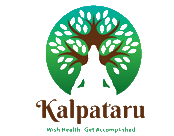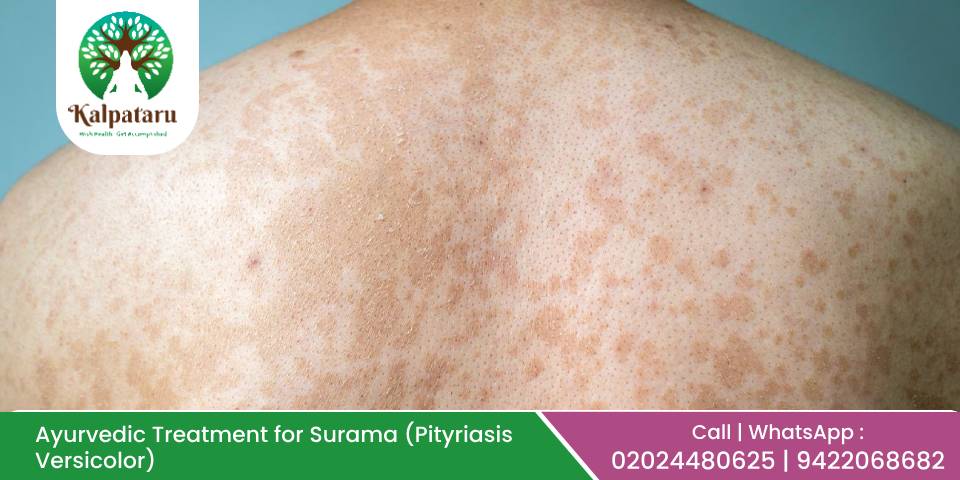
30May
Ayurvedic Treatment for Surama (Pityriasis Versicolor): Causes, Symptoms & Natural Remedies
Surama, known in modern medicine as Pityriasis Versicolor, is a common superficial fungal skin infection caused by the Malassezia yeast. It presents as discolored patches on the skin—typically on the trunk, neck, and upper arms—which may appear lighter or darker than the surrounding skin. In Ayurveda, Surama is explained as a skin disorder that appears due to the imbalance of doshas, primarily Pitta and Kapha, along with Rakta Dusti (vitiation of blood) and weakened immunity. This blog will help you understand the condition from an Ayurvedic perspective and explore natural, holistic remedies to manage it effectively. What is Surama (Pityriasis Versicolor)? Pityriasis Versicolor is a superficial fungal infection induced by the overgrowth of Malassezia yeast, which is naturally present on the skin. When the yeast grows excessively due to heat, humidity, oily skin, or a weakened immune system, it leads to scaly patches that are lighter or darker than the surrounding skin. These patches typically arise on the back, chest, neck, and upper arms. In Ayurveda, Surama is classified under Kushtha Roga (skin diseases), more specifically Kshudra Kushtha, as it is a minor skin condition. Surama is mostly a result of the Kapha-Pitta dosha imbalance in the body and the accumulation of toxins (Ama) in the skin. Causes of Surama in Ayurveda: According to Ayurvedic principles, skin disorders are the result of internal imbalances rather than just external factors. The primary causes of Surama are: Viruddha Ahara (incompatible food combinations) Excessive intake of oily, spicy, and junk foods Excessive exposure to heat and humidity Lack of skin hygiene Stress and irregular sleep Weak digestion and accumulation of Ama (toxins) Low immunity (Ojakshaya) When the digestive fire (Agni) weakens, it leads to the formation of Ama, which combines with vitiated Kapha and Pitta doshas to manifest as skin discoloration and scaling — characteristic features of Surama. Symptoms of Surama (Pityriasis Versicolor): Discolored patches that may be lighter or darker than the surrounding skin Mild itching, specifically when the body is sweaty Scaling or flaking of skin Typically seen on the upper chest, back, neck, and arms Recurrence during summer or after sweating Cosmetic concern due to visible patches Recurrence is common without proper management Ayurvedic Management of Surama: Ayurveda emphasizes a holistic, natural treatment for skin conditions. The goal is to purify the body, balance the doshas, and strengthen the immune system to prevent recurrence. 1. Shodhana Chikitsa (Detoxification): To eliminate the root cause (toxins and doshic imbalance), Ayurvedic cleansing therapies are recommended: Vamana (Therapeutic Emesis): Particularly useful when Kapha dosha is dominant. Helps in removing accumulated toxins from the upper digestive tract. Virechana (Therapeutic Purgation): Helps in pacifying Pitta dosha and cleansing the liver and intestines. Raktamokshana (Bloodletting): Removes impure blood and reduces skin-related ailments. Abhyanga (Herbal oil massage) followed by Swedana (steam therapy) helps improve circulation and cleanse the skin pores. 2. Shamana Chikitsa (Pacifying Therapy): This includes internal herbal medications and topical applications to balance the doshas and restore skin health. Internal Medications: Arogyavardhini Vati: Detoxifies the liver and enhances skin health. Gandhak Rasayana: Purifies blood and has antifungal properties. Khadirarishta: A classical formulation for various skin diseases. Manjishtha (Rubia cordifolia): A potent blood purifier and skin rejuvenator. Kaishor Guggulu – Works well in chronic skin infections by purifying blood and removing toxins. Neem (Azadirachta indica): A powerful antimicrobial and anti-inflammatory herb. Haridra (Turmeric): Balances all three doshas and prevents skin infections. External Applications: Triphala decoction wash: Cleanses the affected area. Neem oil , mahamarichyadi oil,karanj oil, Nalpamaradi oil: Applied externally to reduce fungal activity and nourish the skin. Lepa (herbal paste): A paste of turmeric, sandalwood, and manjishtha applied to impacted areas aids decrease discoloration and itching. 3. Local Applications (Bahya Chikitsa): Ayurveda recommends natural, antifungal external applications to reduce fungal colonization and support skin healing. Herbal Pastes and Oils: Neem Paste: Antifungal and antibacterial; reduces itching and discoloration. Khadira Churna Paste: Useful in fungal and allergic skin conditions. Jatyadi Taila: Heals injured skin and controls further fungal growth. Durvadi Taila: Soothe inflamed skin patches and promote tissue repair. Home Remedies: Turmeric + Coconut Oil: Make a paste and apply to affected areas. Turmeric is a natural antifungal agent, and coconut oil soothes and moisturizes the skin. Multani Mitti + Neem Powder: A cooling and antifungal face/body pack. Apple Cider Vinegar (Diluted): Used externally, helps in balancing skin pH and controlling yeast growth. Diet and Lifestyle Recommendations: Ayurveda places significant importance on Ahara (diet) and Vihara (lifestyle) to maintain skin health and control the recurrence of Surama. Dietary Guidelines: Avoid oily, spicy, and junk food. Stay away from dairy and sugary foods that increase Kapha. Include bitter vegetables like neem, bitter gourd, and fenugreek. Drink warm water infused with turmeric or cumin to aid digestion. Avoid curd, particularly at night. Lifestyle Modifications: Bathe regularly and keep skin dry, especially in humid weather. Wear breathable, cotton clothing. Avoid excessive sweating and sun exposure. Practice stress-reducing techniques like yoga and meditation. Maintain a regular sleep schedule to keep the body's rhythms balanced. Seasonal Detox: Undergo seasonal Panchakarma detox once or twice a year to cleanse accumulated doshas, especially before summer or monsoon. Preventive Measures in Ayurveda: Dinacharya (daily routine): Includes regular oil massage and proper bathing habits to sustain skin health. Ritucharya (seasonal regimen): Modify food and lifestyle according to the seasons to avoid aggravation of doshas. Boost immunity with regular use of Rasayana herbs like Guduchi, Amalaki, and Ashwagandha. When to Consult an Ayurvedic Practitioner? While mild cases of Surama may be controlled with home remedies and herbal support, you should consult an Ayurvedic expert if: The infection is recurring despite treatment. It spreads to large areas of the body. You have other associated conditions like diabetes or obesity. Itching or discomfort is intense. Conclusion: Surama (Pityriasis Versicolor) may seem like a superficial skin problem, but its root lies deep within the body's internal imbalances. Ayurveda offers a time-tested, natural approach to treating this condition — not just by clearing the skin but by rejuvenating the whole body. Through a blend of detox therapies, herbal medicines, dietary corrections, and lifestyle practices, Ayurveda ensures a long-lasting cure and prevents recurrence. If you are suffering from Surama or any chronic skin condition, consult with the best Ayurvedic Doctor in Pune. At Kalpataru Ayurvediya Chikitsalaya™, Dr. Manoj Deshpande provides personalized Ayurvedic treatments for skin diseases, ensuring a holistic path to healing and well-being. Book your consultation today and experience the power of Ayurveda in healing from within.
Read More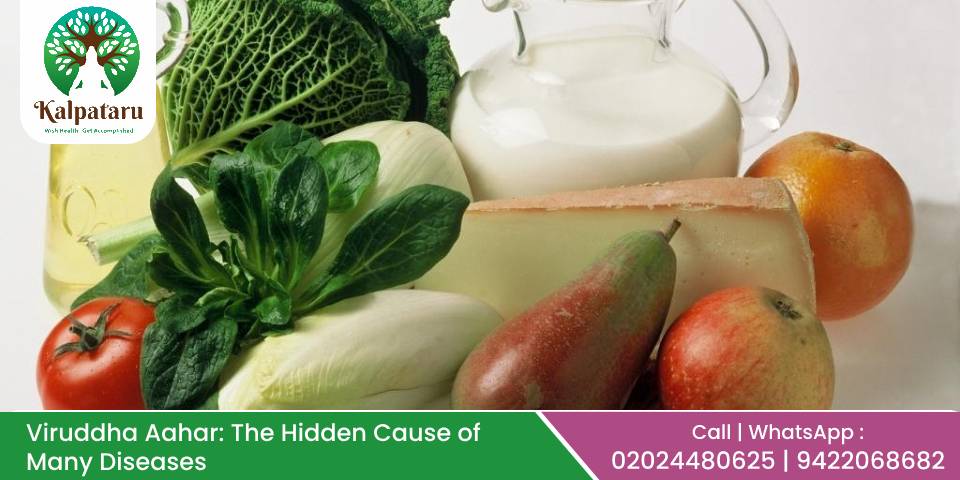
19May
Viruddha Aahar: The Hidden Cause of Many Diseases
In the fast-paced modern world, dietary habits have drastically shifted from standard practices to convenience-driven choices. This transformation has brought with it a surge in lifestyle-related disorders like obesity, diabetes, acidity, autoimmune diseases, and digestive problems. One of the lesser-known but crucial concepts from Ayurveda that explains this phenomenon is "Viruddha Aahar" – a term that refers to incompatible food combinations. While the modern diet may look harmless on the surface, combining certain foods can silently lead to the formation of toxins (ama) and chronic illnesses. Let's explore the concept of Viruddha Aahar, its examples, scientific basis, and its role in modern diseases. What is Viruddha Aahar? Viruddha Aahar is a unique Ayurvedic term referring to food combinations that are contradictory in nature and Viruddha Aahar refers to food combinations that may seem healthy individually but, when eaten together, can become harmful. These incompatible combinations can disturb the balance of doshas (Vata, Pitta, Kapha), impair agni (digestive fire), and produce ama (toxins) in the body. These toxins accumulate over time, weaken immunity, and become the root cause of various diseases. The concept of Viruddha Aahar emphasizes not only what we eat but how, when, and with what we eat. Common Examples of Viruddha Aahar: Milk + Fruits (especially sour fruits like bananas or oranges): Milk is cooling and heavy, while fruits are light and sometimes acidic. This combination can curdle milk in the stomach, leading to indigestion, bloating, and skin problems. Milk + Salt: This is a classic Viruddha Aahar. Salt can disturb the cooling and soothing nature of milk. Long-term consumption can result in skin conditions and digestion issues. Yogurt + Fruits: Yogurt is sour and heating, and fruits are generally sweet and cooling. This opposing nature can lead to metabolic imbalances, acne, and respiratory allergies. Fish + Milk: Fish is heating, while milk is cooling. This can cause toxin formation in the body. It may lead to skin disorders like vitiligo (Shwitra), eczema, and allergies. Ghee + Honey in equal quantity: Though both are individually healthy, consuming them in equal proportions can produce toxins and become fatal over time. It can lead to disturbances in digestion and metabolic disorders. Heating Honey: Honey should never be cooked or added to hot beverages or foods. Heated honey evolves toxic and sticky, leading to ama and blockage of channels (srotas). Tea or Coffee After Meals: This hinders iron absorption and disrupts digestion. Fruits With or After Meals: Fruits digest quickly, but when eaten with heavy meals, they ferment in the gut causing bloating and toxin formation. Modern-Day Relevance of Viruddha Aahar: In today's lifestyle, people unknowingly indulge in Viruddha Aahar due to lack of awareness: Fruit smoothies with milk or yogurt Cereal with cold milk and fruits Grilled fish with cream-based sauces Pizza (mixing dairy, meat, yeast, and processed toppings) Desserts after a heavy non-vegetarian meal Cold drinks with spicy food Over time, these seemingly delicious food combinations disrupt our digestion, create toxin build-up, and lead to diseases that modern medicine often struggles to explain completely. Diseases Caused by Long-Term Use of Viruddha Aahar: According to Ayurveda and supported by modern research, long-term consumption of incompatible foods can lead to: Skin Disorders – eczema, psoriasis, acne, pigmentation Digestive Issues – acidity, bloating, irritable bowel syndrome (IBS), constipation Metabolic Disorders – obesity, Type 2 diabetes Respiratory Problems – asthma, allergic rhinitis Autoimmune Diseases – vitiligo, rheumatoid arthritis Mental Health Issues – mood swings, depression, anxiety due to ama build-up affecting gut-brain axis Chronic Fatigue Syndrome – due to poor nutrient absorption and toxin accumulation Psychological disorders such as anxiety, depression Hormonal imbalance, infertility, PCOD Scientific Correlation and Explanation: Though Viruddha Aahar is an ancient concept, modern science is slowly catching up. For instance: Milk + Citrus fruits: The citric acid causes milk to curdle, leading to poor digestion and nutrient malabsorption. High protein + High carbohydrate meals: These need different digestive environments (acidic vs. alkaline), confusing the digestive system and leading to indigestion. Processed food combinations: Often combine incompatible fats, preservatives, and refined sugars, mimicking Viruddha Aahar effects. Modern research in gut health, microbiome imbalance, and food sensitivities aligns with the Ayurvedic understanding of improper food combinations causing inflammation and disease. Modern Research and Views on Viruddha Aahar (Incompatible Food Combinations): Ayurveda has talked about Viruddha Aahar (wrong food combinations) since ancient times. Now, even modern science is slowly starting to understand why some food combinations may not be good for health. Here are some simple reasons that explain this: Chemical Reactions in the Stomach: Some food combinations can react with each other inside the stomach and create harmful substances. These can disturb digestion or reduce the absorption of nutrients. For example, eating milk with fish or sour fruits can upset the stomach. Blocking Digestive Enzymes: Some foods, when eaten together, can stop the enzymes in our body from working properly. This leads to poor digestion and may cause gas, heaviness, or indigestion. Harm to Gut Bacteria: Our stomach has good bacteria that help in digestion. Wrong food combinations can harm these bacteria and create imbalance, which may lead to health problems. Allergic Reactions: Certain food combinations can cause the body to release histamine (a chemical), which may result in allergies, rashes, or swelling in some people. Importance of Personalized Diet: Ayurveda emphasizes Ahara Vidhi—rules of eating based on individual constitution (Prakriti), digestive power (Agni), age, season, and region. What may be beneficial for one person can be harmful to another. Thus, personalized dietary advice is crucial to prevent Viruddha Aahar effects. Ayurvedic Perspective on Detoxifying Viruddha Aahar Effects: If one has been consuming Viruddha Aahar unknowingly for years, there is still hope. Ayurveda offers a range of detoxification and recovery methods: Langhana: Fasting or light diet to rekindle Agni Pachana: Herbal formulations to digest Ama Shodhana: Panchakarma therapies to eliminate deep-seated toxins Rasayana: Rejuvenation therapy to rebuild tissue health Along with these, lifestyle changes like proper meal timings, mindful eating, and yoga play a supportive role. Practical Tips to Avoid Viruddha Aahar: Know Your Food Combinations: Learn what goes well with what. Stick to simple, digestible combinations. Eat Seasonal, Fresh, and Local Food: It aligns with your body's natural rhythm and is easier to digest. Mindful Eating: Eat slowly, chew well, and eat in a calm state. Mental stress while eating can also cause food to act as Viruddha Aahar. Do Not Mix Dairy With: Fish, meat, citrus fruits, sour items, salt, or fermented foods. Avoid Reheated and Stale Food: Reheating especially ghee or oils creates harmful free radicals. Follow Proper Food Timing: Give enough gap between meals. Do not eat incompatible snacks immediately after meals. Consult an Ayurvedic Expert: Particularly if suffering from chronic disorders, an Ayurvedic doctor can help identify hidden dietary causes like Viruddha Aahar. Conclusion: Viruddha Aahar may seem like a small detail, but it has profound implications for our health. As chronic diseases become more common, returning to Ayurvedic principles like consistent eating can restore balance, improve digestion, and promote overall well-being. By honoring the wisdom of Ayurveda, we can take a step toward preventive health and natural healing. At Kalpataru Ayurvediya Chikitsalaya™, under the expert guidance of the best Ayurvedic Doctor in Pune, Dr. Manoj Deshpande, we focus on restoring gut health and preventing lifestyle disorders through Ayurvedic diet principles. If you're experiencing unexplained symptoms like skin issues, digestive discomfort, fatigue, or hormonal imbalances, it could be time to consider your diet through the lens of Viruddha Aahar.
Read More
14May
Ingrown Toenail (चिप्प): Effective Nonsurgical Management with Ayurvedic Remedies
An ingrown toenail, medically known as onychocryptosis and traditionally referred to as चिप्प (Chippa) in Ayurveda, is a common but painful condition where the edge of the toenail grows into the surrounding skin. It typically affects the big toe and can lead to swelling, redness, infection, and even pus formation if left untreated. While conventional treatments may recommend surgical intervention in severe cases, Ayurveda offers a range of nonsurgical, holistic solutions to manage and heal ingrown toenails naturally by balancing the body's doshas and supporting the body's innate healing process. In this blog, we'll explore the Ayurvedic understanding of चिप्प, its causes, symptoms, and the nonsurgical treatment approach offered by Ayurveda. What is an Ingrown Toenail (Chippa)? An ingrown toenail occurs when the nail margin hits the skin, causing pain, redness, swelling, and occasionally infection. In Ayurveda, this condition is closely related to Dushta Vrana (infected wound) and is caused due to Kapha and Pitta imbalance leading to localized inflammation. Common Causes of Ingrown Toenails: Improper nail trimming (too short or curved edges) Wearing tight footwear Injury to the toenail Excessive sweating or poor foot hygiene Genetic predisposition Poor immunity and chronic skin conditions Symptoms of Ingrown Toenail (चिप्प): Pain and tenderness along the sides of the nail Redness and swelling Hardening or thickening of the skin around the nail Pus or fluid discharge in case of infection Difficulty walking or wearing shoes Ayurvedic Approach to Nonsurgical Management of Ingrown Toenail: Ayurveda emphasizes root-cause treatment, which involves balancing the doshas, reducing inflammation, promoting natural nail growth, and preventing recurrence. External Therapies: Herbal Oil Application (Taila Abhyanga): The application of medicated oils like Jatyadi Taila, Nirgundi Taila, or Neem Oil benefits reduces inflammation, fights infection, and softens the nail and surrounding tissue. Warm Water Soak (Swedana): Soaking the affected toe in warm water infused with Triphala decoction, rock salt, or Turmeric (Haridra) aids in pain relief, decreases swelling, and promotes drainage of pus if present. Lepa (Herbal Paste): Applying anti-inflammatory and antibacterial pastes made from Neem, Turmeric, Manjistha, and Aloe Vera helps control infection and aids healing. Upanaha (Poultice Therapy): A warm poultice from herbs like Nimpatra, Eranda (castor), Triphala Churna, and Turmeric is applied over the affected area. This therapy helps reduce pain, swelling, and stiffness while promoting softening of the nail bed and easing nail growth. Upanaha is especially useful in chronic and painful cases with localized inflammation at the initial level. Internal Medications: To reduce infection, inflammation, and correct doshic imbalance, Ayurvedic physicians may recommend: Guggulu preparations (like Kaishor Guggulu) Haridra Khanda (for inflammation) Triphala churna (to detoxify the system) Manjisthadi Kashayam (to purify Rakta dhatu – blood) Lifestyle & Foot Care Tips: Always cut nails straight across to prevent inward growth Avoid tight or ill-fitting footwear Keep foot hygiene – wash and dry your feet properly Use antiseptic powders like trifala or neempatra churna to control fungal infections in moist areas Include anti-inflammatory foods such as turmeric, ginger, and leafy greens in your diet Leech Therapy (Jalaukavacharana) – For Severe Cases: In chronic cases with persistent pain and infection, leech therapy may be recommended. It helps by: Reducing local congestion and inflammation Purifying blood from the affected area Promoting natural healing without invasive procedures Benefits of Ayurvedic Management for Ingrown Toenail: Completely nonsurgical and natural No side effects Addresses underlying dosha imbalances Promotes long-term healing Prevents recurrence through holistic lifestyle management Preventive Tips According to Ayurveda: Trim nails straight across, not in a curved shape. Keep feet clean and dry, especially in humid conditions. Avoid tight or ill-fitting shoes. Soak your feet in warm herbal water once a week for maintenance. Manage Pitta and Kapha – Follow a dosha-balancing diet and lifestyle to prevent inflammation and excessive nail growth. When to Seek Ayurvedic Consultation? While mild to moderate cases of चिप्प can be effectively managed at home with Ayurvedic treatments, it's important to consult an experienced Ayurvedic physician in Pune if: The condition persists beyond a week There's pus formation or excessive swelling You have diabetes or poor circulation You experience frequent recurrences Conclusion: Ingrown toenail or चिप्प may seem like a minor issue, but if not managed timely, it can lead to significant discomfort and complications. Fortunately, Ayurveda offers a safe, effective, and nonsurgical approach to managing this condition through herbal medicines, external therapies, and lifestyle corrections. If you're struggling with a painful ingrown toenail, Ayurveda may offer the relief you've been looking for — naturally and holistically.
Read More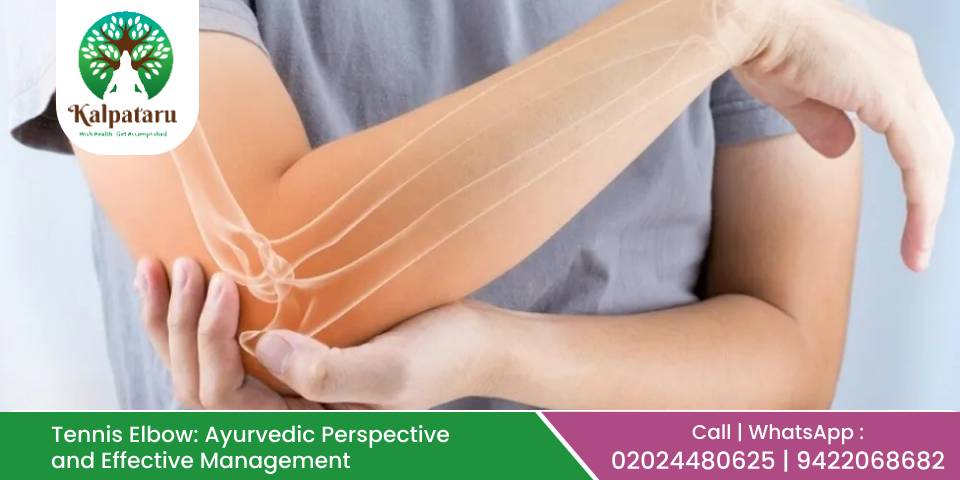
08May
Tennis Elbow: Ayurvedic Perspective and Effective Management
Tennis Elbow or Lateral Epicondylitis is a painful condition that results from overuse of the elbow joint, especially the tendons attached to the lateral epicondyle of the humerus (outer part of the elbow). Despite its name, this condition is not limited to tennis players—it affects people who perform repetitive wrist and arm movements, such as painters, carpenters, office workers, and homemakers. It is commonly caused by overuse of the forearm muscles and tendons around the elbow joint. In Ayurveda, this condition is often referred to as Snayugata Vata at the Kurpara Sandhi (elbow joint). Certain professions and activities increase the risk of developing tennis elbow due to repetitive stress or heavy use of the elbow joint, such as: Athletes: especially those involved in sports like tennis, badminton, or javelin throw. Gym-goers: particularly those who lift heavy weights. Cooks: due to frequent and repetitive hand and arm movements. Manual laborers: who are required to lift or carry heavy loads regularly. In all these cases, the repeated strain leads to microscopic tears in the tendons, resulting in pain, stiffness, and reduced mobility. In modern medicine, treatment usually involves rest, physiotherapy, painkillers, or corticosteroid injections. However, Ayurveda offers a more sustainable and holistic approach to healing this condition without side effects. At Kalpataru Ayurvediya Chikitsalaya™, under the guidance of Dr. Manoj and Dr Aparna Deshpande, the treatment of Tennis Elbow is personalized, root-cause-oriented, and aimed at long-term relief and joint health restoration. Let's explore the Ayurvedic understanding of Tennis Elbow and how it is effectively managed at Kalpataru. Understanding Tennis Elbow Through the Lens of Ayurveda: In Ayurveda, Tennis Elbow can be correlated with a condition known as Snayugata Vata—a condition where the aggravated Vata dosha affects the ligaments (snayu), tendons, and joints, leading to pain, stiffness, and restricted movement. Vata Dosha is responsible for all kinds of movement and neuromuscular movements in the body. When Vata gets irritated due to factors such as overuse of the joint, improper postures, repetitive motions, poor dietary habits, or exposure to cold and dry environments, it settles in the elbow joint and causes pain and dysfunction. Symptoms of Snayugata Vata (Tennis Elbow) in Ayurveda include: Localized pain over the outer part of the elbow Stiffness and tightness in forearm muscles Pain aggravated by wrist and elbow movement Weak grip strength The sensation of dryness and cracking in the joint Causes and Aggravating Factors According to Ayurveda: Ayurveda believes that lifestyle and diet play a crucial role in the imbalance of doshas. Some common factors that aggravate Vata and contribute to conditions like Tennis Elbow include: Overuse of the arm through repetitive tasks (e.g., typing, lifting, playing instruments) Poor dietary habits like excessive intake of dry, cold, or stale food Insufficient rest and irregular sleeping patterns Excessive exposure to cold wind or water Emotional stress and anxiety Kalpataru Ayurvediya Chikitsalaya™ Approach: A Holistic and Natural Way to Heal: Dr. Manoj Deshpande and his team at Kalpataru Ayurvediya Chikitsalaya™ approach Tennis Elbow holistically. The treatment is individualized based on the patient's prakriti (body constitution), the severity of the condition, and the root cause. The focus is on reducing pain, restoring joint function, and controlling recurrence. Internal Medications (Aushadhi Chikitsa): Herbal Formulations: Ayurvedic medicines such as Rasnadi Guggulu, Yogaraj Guggulu, Dashmoolarishta, and Mahayograj Guggulu are prescribed to balance Vata, decrease inflammation, and nourish the tissues. Anti-inflammatory Herbs: Shallaki (Boswellia serrata), Guggulu, and Ashwagandha help reduce pain and swelling while strengthening muscles and tendons. Ama Pachana: In chronic cases with Ama accumulation, herbs like Trikatu, Guduchi, and Chitrak are used to digest and eliminate toxins. Panchakarma Therapies (Detoxification & Rejuvenation): Panchakarma plays a vital role in purifying the body and rebalancing doshas. At Kalpataru Ayurvediya Chikitsalaya™, specific therapies are employed for Tennis Elbow: Abhyanga (Therapeutic Oil Massage): This is one of the first steps in addressing Vata disorders. Medicated oils like Mahanarayan Taila, Bala Taila, or Dhanwantaram Taila are used to pacify Vata dosha, lubricate the joints, and improve circulation. Benefits: Reduces pain and stiffness Relieves muscle spasms Promotes better blood flow and healing Swedana (Herbal Steam Therapy): After Abhyanga, Nadi Sweda or localized steam therapy is applied to the affected area. This helps in reducing stiffness, improving mobility, and flushing out toxins. Benefits: Softens the tendons and ligaments Reduces inflammation Alleviates Vata-induced pain Lepa (Medicated Herbal Pastes): The application of warm herbal pastes like Dashmool Lepa or Eranda Mooladi or kottamchukyadi Lepa directly over the elbow helps relieve localized inflammation and pain. Basti Therapy (Medicated Enema): Vata mostly resides in the colon, and Basti is considered the most effective treatment for Vata-related diseases. Depending on the condition, Matra Basti (oil enema) or Kashaya Basti (decoction enema) is administered. Benefits: Balances systemic Vata Provides nourishment to joints and nerves Long-lasting relief in chronic cases Agnikarma (Therapeutic Cauterization): Agnikarma (therapeutic heat application) is an important and effective Ayurvedic treatment for chronic pain conditions like tennis elbow. Probable Mode of Action of Agnikarma Treatment: Many patients wonder how simply applying heat or a cautery tool can relieve such pain. Here's how Agnikarma works: Reduction of Inflammation and Pain Chemicals: In chronic pain, certain chemicals responsible for inflammation and pain accumulate at the affected site. When therapeutic heat is applied during Agnikarma, these chemicals are dispersed and flushed into the main circulation. This reduces local pain and swelling. Disruption of Pain Conduction Pathway: Another theory suggests that the heat from Agnikarma temporarily disrupts the nerve pathways that carry pain signals to the brain. As a result, the perception of pain decreases, and mobility improves. Gradually, as the pain subsides and movement becomes easier, the overall healing of the affected joint or muscle is facilitated. Internal Herbal Medication: Along with external therapies, internal medications are prescribed to reduce inflammation, nourish the joints, and balance Vata dosha. Some commonly used formulations include: Yogaraj Guggul: for joint stiffness and inflammation Dashmoolarishta: for generalized Vata disorders Eranda Sneha: for internal oleation Ashwagandha Churna: for strengthening muscles and nerves All medications are carefully selected and monitored by Dr. Manoj Deshpande for maximum efficacy and safety. Diet and Lifestyle Modifications: In Ayurveda, food is medicine. A Vata-pacifying diet is recommended: Foods to include: Warm, freshly cooked meals Ghee, sesame oil, and other healthy fats Cooked vegetables like pumpkin, bottle gourd, carrots Herbal teas made with ginger, ashwagandha, or fennel Foods to avoid: Dry, cold, stale, or refrigerated food Excessive caffeine or aerated drinks Raw vegetables and salads Refined sugar and maida-based foods Lifestyle Tips: Avoid cold exposure to joints Perform gentle joint exercises and stretches Maintain proper posture while working Ensure sufficient rest and sleep Practice stress-relieving techniques like Pranayama and meditation Conclusion: Tennis Elbow can significantly impact your daily activities and quality of life if left untreated or only addressed symptomatically. Ayurveda offers a time-tested, natural, and holistic path to healing this painful condition by managing the root cause—Vata imbalance. Under the expert care of Dr. Manoj Deshpande at Kalpataru Ayurvediya Chikitsalaya™, patients can experience safe, effective, and sustainable recovery from Tennis Elbow. If you or someone you know is struggling with elbow pain or stiffness, consider booking a consultation with Dr. Deshpande and rediscover the power of Ayurveda for joint health and pain-free living. Visit Kalpataru Ayurvediya Chikitsalaya™ today and take the first step towards pain-free living — the Ayurvedic way.
Read More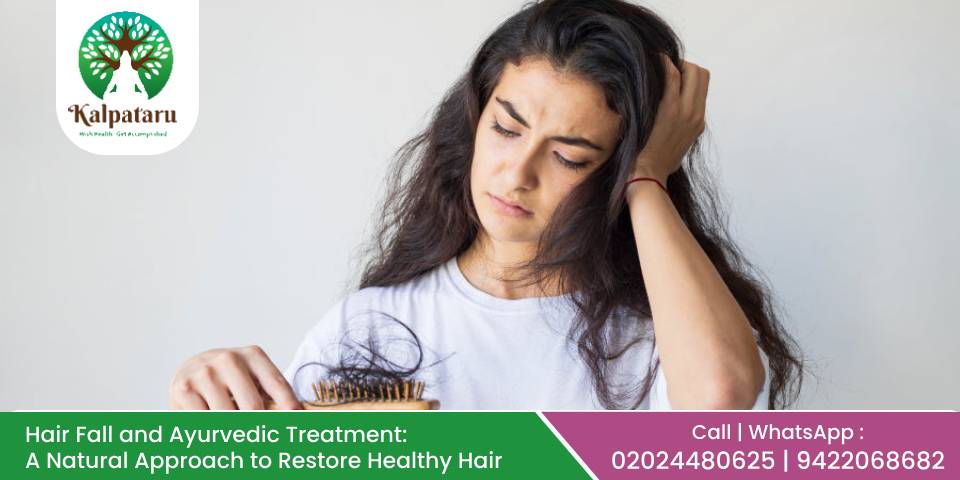
23Apr
Hair Fall and Ayurvedic Treatment: A Natural Approach to Restore Healthy Hair
Hair fall is a common problem for people across all age groups, affecting both men and women. While it's normal to lose 50–100 strands of hair per day, excessive hair fall can be distressing and is often a symptom of underlying health issues, nutritional deficiencies, stress, or hormonal imbalances. Modern treatments usually focus on quick fixes, but Ayurveda offers a holistic approach that not only targets the symptoms but also manages the root cause of hair fall. In this blog, we explore the Ayurvedic perspective on hair fall, the underlying causes according to Ayurveda, and effective natural treatments to restore hair health. Understanding Hair Fall in Ayurveda: Ayurveda, the ancient Indian system of medicine, believes that hair health is a reflection of your overall health and is closely linked to the balance of your doshas — Vata, Pitta, and Kapha. According to Ayurveda: Vata imbalance can lead to dryness and brittle hair, resulting in hair breakage and split ends. Pitta imbalance is one of the main causes of hair thinning and premature graying, as it affects the metabolic functions in the scalp and hair follicles. Kapha imbalance causes excess oiliness, clogging the hair follicles and leading to scalp infections or dandruff. Ayurveda recognizes hair fall as a result of imbalances in these doshas, especially an aggravated Pitta dosha, which leads to inflammation in the hair roots and weakens them, causing the hair to fall out. Types of Hair Loss: There are two main patterns of hair loss: localized hair loss (known as Indralupta or Alopecia Areata) and generalized hair fall, which affects the entire scalp. These two have different causes and thus require different treatment approaches. Proper diagnosis and differentiation between these two types are essential before planning any treatment protocol. Common Causes of Hair Fall According to Ayurveda: Unhealthy Diet – Improper nutrition, and regular consumption of junk food, spicy and oily food can disturb Pitta dosha and reduce nourishment to the scalp. Stress and Anxiety – Emotional stress increases Vata dosha, which results in weakened hair roots and hair shedding. Poor Lifestyle Habits – Irregular sleep patterns, excessive screen time, lack of physical activity, and overuse of chemical-based hair products lead to dosha imbalances. Seasonal Changes – Ayurveda links certain seasons like autumn (Sharad Ritu) with increased hair fall due to aggravated Pitta. Chronic Illness or Hormonal Imbalance – Conditions like thyroid disorders, PCOD/PCOS, and other metabolic issues are also linked with aggravated doshas and hair loss. Genetics: Hereditary hair loss is a major cause of thinning hair and baldness, especially in men. Male-pattern baldness and female-pattern hair loss are both conditions that are influenced by genetics. Environmental Factors: Exposure to pollutants, harsh chemicals in hair care products, and extreme weather conditions can damage hair and lead to increased shedding. Age: As we age, hair growth slows down, and hair follicles become weaker, which leads to thinning and shedding. Scalp infections are a common yet often overlooked reason for hair fall. Conditions such as fungal infections, eczema, psoriasis, or even lice infestations can affect the scalp's health. Unless these issues are treated first, any hair regrowth treatments may not give desired results. Therefore, it's essential to clear these scalp infections or allergies before starting any therapy to boost hair growth. Hair loss can sometimes be a sign of internal health imbalances, particularly anemia, where the body has low levels of hemoglobin. In such cases, performing some basic medical tests becomes necessary. These include checking thyroid function, hemoglobin levels, and looking for vitamin deficiencies. Addressing these underlying health issues is crucial to achieving lasting improvement in hair health. Link Between Bone Strength and Hair Health: According to Ayurvedic principles, hair is considered a byproduct (mala) of bone tissue (Asthi Dhatu). If bone tissue is weak, it directly affects hair strength and quality. To improve this, herbs and minerals like Padmak, Khair, and Mandur Bhasma are used. These ingredients help improve bone density and indirectly enhance hair health by strengthening the body's foundational tissues. Choosing the Right Shampoo: The type of shampoo you use plays an important role in hair health. Shampoos with strong fragrances and heavy foaming agents can strip the scalp of its natural oils and damage hair. At Kalpataru Ayurvediya Chikitsalaya™, patients are prescribed mild Ayurvedic shampoos that don't foam excessively but still clean the scalp effectively and provide nourishment to the hair. Ayurvedic Remedies for Hair Fall: Ayurveda aims not just to treat the symptoms but to fix the root cause. Treatment involves internal purification (Shodhana), herbal remedies, dietary changes, and external applications. Here are some effective Ayurvedic treatments and remedies for hair fall: Shirodhara: Shirodhara is a classical Ayurvedic therapy where medicated oil or decoction is poured steadily over the forehead. It calms the mind, relieves stress, and balances Vata and Pitta doshas. This therapy improves blood circulation to the scalp and helps in hair regrowth. Nasya (Nasal Administration of Herbs): Nasya therapy is the process of administering herbal oils through the nostrils. This technique is especially effective in managing hair fall due to hormonal imbalance, sinus issues, or excessive stress. Herbal Hair Oils: Ayurvedic oils like Bhringraj oil, Brahmi oil, and Neeli oil are renowned for their hair-strengthening properties. Frequent scalp massage with these oils improves circulation, strengthens hair roots, and prevents hair fall. Ayurvedic Herbs and Formulations: In Ayurveda, several herbs and natural substances are known for their role in improving hair health. Among them, Bhringraj and Maka are widely recognized. Alongside these, Laksha (commonly referred to as Laccife lakka) is another powerful medicine used for various therapeutic purposes, including hair care. Mandur Bhasma, an iron-based formulation, and Lohakalpa, which is rich in iron, are also used to strengthen the body from within and enhance hair growth. Adaptogenic herbs like Shatavari, Ashwagandha, and Giloy (Guduchi) contribute to improved immunity, stress reduction, and hormonal balance, all of which play a role in reducing hair fall. Bhringraj (Eclipta alba) – Known as the "King of Herbs" for hair, it promotes hair growth and reverses baldness. Amla (Indian Gooseberry) – Rich in Vitamin C and antioxidants, it nourishes hair, prevents greying, and strengthens roots. Ashwagandha – An adaptogen that helps decrease cortisol (stress hormone), it plays a key role in controlling hair fall related to stress. Brahmi – Improves memory and reduces anxiety, contributing to healthier hair. Triphala – A combination of three fruits that detoxifies the body and supports overall health, including hair health. These herbs are often consumed in powdered form or as part of Ayurvedic supplements, under the guidance of an Ayurvedic practitioner. Diet and Lifestyle Modification: For hair to grow strong and healthy, the body must receive the right balance of nutrients. Micronutrients such as calcium, vitamin D3, zinc, iron, protein, and biotin are essential for hair growth. Deficiencies in any of these can lead to thinning hair, breakage, or excessive hair fall. Hence, a well-balanced and wholesome diet is more beneficial than just taking external supplements, as nutrients from food are more bioavailable and effectively absorbed by the body. A healthy diet is important for maintaining strong and healthy hair. Include: Green leafy vegetables, fresh fruits, nuts (especially almonds and walnuts), seeds (like flaxseed and sesame), whole grains, and protein-rich foods. Avoid: Excessively spicy, oily, and processed foods. Drink adequate water and herbal teas like cumin-coriander-fennel tea for detoxification. Ensure sound sleep and manage stress through yoga, meditation, and breathing exercises like Anulom Vilom and Bhramari. Ayurvedic Dietary Remedy from Kalpataru Ayurvediya Chikitsalaya™: At Kalpataru Ayurvediya Chikitsalaya™, a unique and effective dietary mix is recommended to patients suffering from hair fall. This includes a combination of coconut, black raisins, rock sugar (khadisakhar), dry dates (kharek), and poppy seeds (khuskhus). All these ingredients are ground together and given in the dose of one spoon in the morning and evening daily. Along with this, the diet should also include milk, paneer, leafy greens, and pulses, which are natural sources of essential nutrients for hair. While supplements can help, a nutritious diet has a longer-lasting impact on overall health and hair quality. Harmful Hair Habits to Avoid: Several lifestyle habits can negatively impact hair health. These include: Tightly tying or pulling hair Frequently touching or twisting hair Overusing heat styling tools Combing hair excessively Spending long hours in air-conditioned environments Avoiding these habits can help reduce unnecessary stress on hair and prevent further damage. Panchakarma Detox Treatments: Ayurveda emphasizes Panchakarma treatments to balance the body's internal environment. One important therapy is Virechan (purgation), which helps regulate digestion and reduce internal heat. Mild laxatives like Triphala Churna are used for regular bowel movements. Proper sleep and reducing acidity are also crucial aspects of this treatment. If a person is not sleeping well, it may increase stress and indirectly lead to more hair fall, so ensuring sound sleep is an important part of hair fall management. Basti Therapy for Hair Fall: A special Panchakarma procedure called Basti involves administering medicated ghee and herbs through the rectal route. A form of this treatment known as Tikta Kshir Basti, which uses bitter herbs boiled in milk, is particularly beneficial for treating conditions like hair fall and baldness (Khalitya and Palitya). This therapy has been highly praised in classical Ayurvedic texts and is found to be very effective in improving hair health. Conclusion: Hair fall is not just a cosmetic issue but a symptom of internal imbalance. The Ayurvedic approach to hair fall is unique because it doesn't merely mask the signs — it heals the root cause. By focusing on personalized treatment, a balanced diet, natural herbs, and lifestyle regulation, Ayurveda offers a long-term solution for hair fall and promotes the growth of strong, healthy, and lustrous hair. If you're struggling with hair loss, consult a qualified Ayurvedic practitioner like Dr. Manoj Deshpande at Kalpataru Ayurvediya Chikitsalaya™ clinic, who can assess your dosha type and suggest a treatment plan tailored specifically to your needs. With patience and consistency, Ayurvedic treatment can help you restore your crowning glory — naturally and holistically.
Read More
17Apr
Understanding Sperm Abnormalities and Effective Ayurvedic Treatment
Male infertility is a growing problem in today's fast-paced lifestyle, and one of the major contributors is sperm abnormalities. Problems such as low sperm count, poor motility, and abnormal morphology significantly lower the chances of conception. These conditions not only affect physical health but also cause emotional stress in couples trying to conceive. Fortunately, Ayurveda – India's ancient holistic medical system – offers safe, effective, and natural solutions to these problems. Dr. Manoj Deshpande, a highly experienced Ayurvedic Doctor in Pune at Kalpataru Ayurvediya Chikitsalaya™, has helped many couples overcome male infertility through personalized Ayurvedic treatments, lifestyle modifications, and holistic counseling. What Are Sperm Abnormalities? Sperm health is typically evaluated using three major parameters: Sperm Count – This refers to the number of sperm present in one milliliter of semen. A healthy sperm count is normally considered to be more than 15 million sperm per ml. Sperm Motility – This is the capability of sperm to move efficiently. Progressive motility (forward movement) is necessary for the sperm to travel through the female reproductive tract and fertilize the egg. Sperm Morphology – Morphology refers to the shape and structure of sperm. Normal-shaped sperm have oval heads and long tails. Abnormal morphology can hinder the sperm's ability to penetrate the egg. Types of Sperm-Related Disorders: Oligospermia: Low sperm count Asthenospermia: Low sperm motility (Regular intake of Amla juice is beneficial as it rejuvenates the reproductive system and improves motility.) Azoospermia: Absence of sperm in the semen When any of these three parameters are below normal, it leads to male factor infertility. This can result from various causes like stress, hormonal imbalance, poor diet, sedentary lifestyle, excessive heat exposure, smoking, alcohol, infections and certain medicines. Common Causes of Sperm Abnormalities: Sperm quality can decline due to several factors, including: Stress and anxiety Poor diet and lack of nutrients Smoking, alcohol, and substance abuse Excessive heat exposure (laptops on lap, hot tubs, tight clothing, professions near furnace and fire) Exposure to environmental toxins Sedentary lifestyle and obesity Hormonal imbalance Varicocele (enlarged veins in the scrotum) Chronic illnesses or infections Overuse of antibiotics or steroids Modern medicine often treats these issues with hormonal therapy or surgical intervention. However, these approaches may not work for everyone and can come with side effects. Ayurveda offers a more natural and holistic path. Ayurvedic Perspective on Sperm Health: In Ayurveda, male infertility is referred to as "Shukra Dushti", which means the vitiation of the Shukra Dhatu (reproductive tissue). According to Ayurvedic texts, Shukra is the seventh and most refined tissue formed in the body and is responsible for reproductive capability. Sperm abnormalities happen when Agni (digestive fire) is weak, leading to improper nourishment of Shukra Dhatu. Imbalances in doshas (Vata, Pitta, and Kapha), accumulation of toxins (Ama), and lifestyle disorders are considered key causes. What Causes Shukra Dushti? Several factors can lead to Shukra Dushti. The most common ones include: Incompatible Diet and Lifestyle (Viruddha Aahar-Vihar) Consuming incompatible food combinations regularly Following irregular eating and sleeping patterns Suppression of Natural Urges (Vega Avarodha) Not responding to natural urges like hunger, thirst, or urination at the right time leads to accumulation of toxins (Ama), affecting the Shukra Dhatu. Addictions and Unhealthy Food Habits Alcohol, tobacco, excessively spicy, salty, or junk food intake can disturb the balance of body tissues and degrade sperm quality. Dhatu Chain Disruption In Ayurveda, the seven dhatus (tissues) are nourished sequentially. If the first tissue (Rasa Dhatu ) is compromised, it affects the successive tissues, eventually weakening the Shukra Dhatu. At Kalpataru Ayurvediya Chikitsalaya™, Dr. Manoj Deshpande uses a comprehensive Ayurvedic approach to: Balance the doshas Strengthen Agni Detoxify the body Rejuvenate Shukra Dhatu Improve mental and emotional well-being The Ayurvedic Approach to Treating Sperm Abnormalities: At Kalpataru Ayurvediya Chikitsalaya™, Dr. Manoj Deshpande adopts a comprehensive Ayurvedic treatment plan that includes: Personalized Consultation & Prakriti Analysis Each person's body (Prakriti) and imbalance (vikriti) are unique. Dr. Deshpande conducts a detailed Ayurvedic assessment to understand the root causes and design a tailored treatment protocol. Detoxification (Shodhana Therapy) Panchakarma therapies like Virechana and Basti are used to remove toxins (Ama) from the body and balance doshas, particularly Apana Vayu– which governs the reproductive organs. Rejuvenation (Rasayana Therapy) This therapy involves the use of specialized Rasayana herbs to regenerate Shukra Dhatu and improve overall vitality. Herbal Remedies for Sperm Health Some of the time-tested Ayurvedic herbs used by Dr. Deshpande include: Ashwagandha (Withania somnifera) – Improves sperm count and motility, and reduces stress. Shatavari (Asparagus racemosus) – Nourishes reproductive tissue and balances hormones. Gokshura (Tribulus terrestris) – Enhances libido and testosterone levels. Kapikacchu (Mucuna pruriens) – Boosts sperm count, motility, and morphology. Safed Musli (Chlorophytum borivilianum) – Acts as a natural aphrodisiac and strength enhancer. Excessive coagulation or viscosity in semen can impair sperm movement, herbs like Kokilaksha and Palash Kshar (alkaline preparations from plants) help maintain the ideal consistency of semen, thus improving motility. Several herbs play a vital role in enhancing sperm count, motility, and morphology. However, choosing the right herb requires a Vaidya's (Ayurvedic doctor's) guidance as the root cause may vary in each case. Common Herbs Used: Kapikacchu (Mucuna pruriens) Dashamoola (Group of 10 roots) Garlic (Rason) Varahikand (Wild Yam) Kokilaksha Amla (Indian Gooseberry) Licorice (Jyeshthamadh) Long Pepper (Pippali) Diet and Lifestyle Guidance A vital component of Ayurvedic treatment is Ahara (diet) and Vihara (lifestyle). Dr. Deshpande provides personalized advice, which may include: Including ghee, almonds, dates, milk, and seasonal fruits Avoiding spicy, oily, and processed foods Encouraging regular yoga and Pranayama Limiting alcohol, smoking, and caffeine Getting adequate sleep and avoiding excessive screen time The following foods are known to enhance the strength and quality of Shukra Dhatu and improve sperm count: Garlic (Lashuna): Known to boost reproductive strength Pumpkin Seeds: Rich in zinc and other nutrients essential for sperm health Black Gram (Urad Dal) Dairy Products: Milk and ghee are especially nourishing Cumin Seeds (Jeera) Coconut Stress Management: Stress has a direct impact on male fertility by disrupting hormonal balance and sexual performance. Ayurveda addresses this through: Abhyanga (medicated oil massage) Shirodhara (oil stream therapy) Meditation and breathing techniques Natural nervine tonics and adaptogens Ayurvedic herbs that support mental well-being include: Jatamansi Brahmi Ashwagandha Ayurvedic Rasakalpas (Herbo-mineral Preparations) Some classical herbo-mineral formulations are used to strengthen Shukra Dhatu: Rasasindoor Vang Bhasma Trivang Bhasma Pushpadhanwaras Suvarna Bhasma (Gold Ash) Suvarna Bhasma, made from purified gold, plays a unique role in Rasayana (rejuvenation) and Vajikarana (aphrodisiac therapy). It enhances Ojas and Shukra Dhatu significantly, showing quick and potent results. Key formulations include: Makardhwaj Poornachandrodaya Ras Why Choose Ayurveda for Male Infertility? Natural and Safe – No synthetic hormones or invasive procedures. Root Cause Treatment – Targets the underlying cause, not just the symptoms. Holistic Healing – Focuses on physical, mental, and emotional balance. Personalized Plans – Tailored therapies as per individual constitution. Conclusion: Sperm abnormalities may seem like an overwhelming challenge, but they can be effectively addressed through the time-tested wisdom of Ayurveda. With the right guidance and care, conception is very much possible. Dr. Manoj Deshpande at Kalpataru Ayurvediya Chikitsalaya™ offers a beacon of hope to couples seeking natural solutions for male infertility. If you or someone you know is struggling with sperm-related issues, take the first step toward healing. Consult Dr. Deshpande and experience the power of Ayurveda – gentle, holistic, and profoundly transformative. To book appointment call us today.
Read More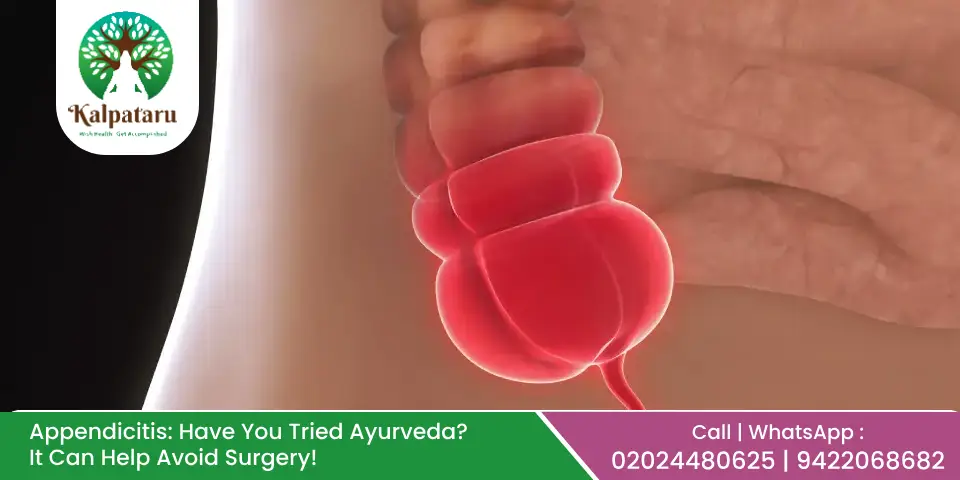
09Apr
Appendicitis: Have You Tried Ayurveda? It Can Help Avoid Surgery!
Appendicitis is a common yet serious medical condition that needs immediate attention. It occurs when the appendix, a small pouch connected to the large intestine, becomes inflamed due to obstruction or infection. Conventionally, the treatment for appendicitis often involves surgical removal of the appendix (appendectomy). However, Ayurveda, an ancient system of natural healing, offers alternative solutions that may help manage early-stage appendicitis and even prevent surgery. In this blog, we will explore how Ayurvedic remedies, lifestyle changes, and dietary adjustments can be effective in treating appendicitis naturally. What is Appendicitis? Appendicitis is the inflammation of the appendix, which may be caused by blockage due to stool, infections, or other underlying digestive problems. If left untreated, the appendix can burst, leading to life-threatening difficulties. Modern medical treatment usually involves surgical removal (appendectomy), but Ayurveda suggests that in many cases, natural treatments can help decrease inflammation and restore digestive balance. Apart from acute appendicitis where there's severe pain and tenderness, often requiring surgical advice there are some emergency cases where Ayurveda can help reverse the condition. However, in many patients, the infection isn't completely resolved, and over time, due to dietary mistakes or improper eating habits, the infection re-emerges. In such chronic appendicitis conditions, Ayurveda proves to be extremely effective. Since surgery is not always recommended for chronic cases, Ayurveda helps significantly in improving the patient's quality of life, preventing absenteeism from school in children, ensuring proper diet, strengthening immunity, and maintaining a healthy weight. Hence, Ayurveda is capable of completely curing appendicitis, especially in its chronic form. Symptoms of Appendicitis: Identifying the symptoms of appendicitis is crucial for timely intervention. Common symptoms include: Severe pain in the lower right abdomen Nausea and vomiting Loss of appetite Fever Abdominal bloating Constipation or diarrhea Difficulty passing gas If you experience these signs, it is important to seek medical attention. However, in the early stages, Ayurvedic treatments can help manage inflammation and prevent the condition from worsening. Causes of Appendicitis: The exact cause of appendicitis varies, but it is primarily linked to: Blockage in the Appendix: Hard stool, lymphoid hyperplasia, or foreign bodies may cause obstruction. Infections: Bacterial or viral infections in the gastrointestinal tract can trigger inflammation. Dietary Factors: Low-fiber diets, excessive consumption of processed foods, and unhealthy eating habits can improve the risk. How Ayurveda Helps in Appendicitis Treatment: Ayurveda approaches appendicitis as an imbalance in the Pitta Dosha and Vata Dosha, leading to inflammation, pain, and digestive disorders. By restoring balance through natural remedies, Ayurveda can help relieve symptoms and, in some cases, prevent the need for surgery. Herbal Remedies for Appendicitis: Ayurveda suggests various herbs with anti-inflammatory, antibacterial, and digestive properties to manage appendicitis. Some effective herbs include: Haritaki (Terminalia chebula): Helps with digestion and prevents constipation, which can contribute to appendicitis. Turmeric (Curcuma longa): Known for its anti-inflammatory and antibacterial properties, turmeric decreases swelling and prevents infection. Ginger (Zingiber officinale): A powerful digestive aid that relieves pain, relieves nausea, and prevents further complications. Giloy (Tinospora cordifolia): Boosts immunity and fights infections, decreasing inflammation in the appendix. Varun (Crateva religiosa): Known for its anti-inflammatory and detoxifying properties. Punarnava (Boerhavia diffusa): A potent herb that reduces swelling and supports kidney and liver function. Drumstick Tree (Shigru): The inner bark of this plant is highly effective. It can be consumed internally or applied externally as a paste.Drumstick pods can be added to the daily diet, accelerating abscess healing and reducing inflammation. Ayurvedic Diet for Appendicitis: A well-balanced diet plays a crucial role in managing appendicitis naturally. Here are some dietary suggestions: Consume Easily Digestible Foods: Opt for soups, boiled vegetables, and steamed rice to reduce strain on digestion. Increase Fiber Intake: Whole grains, fruits, and vegetables help prevent constipation, reducing the risk of appendix blockage. Stay Hydrated: Drink warm water, herbal teas, and fresh fruit juices to flush out toxins and aid digestion. Avoid Spicy and Fried Foods: Such foods aggravate Pitta Dosha, leading to increased inflammation and pain. Include Probiotics: Buttermilk and fermented foods can support gut health and prevent infections. Lifestyle Changes to Prevent Appendicitis: Ayurveda emphasizes lifestyle modifications to support digestion and overall health. Some key changes include: Practicing yoga and pranayama (breathing exercises) to enhance digestion and reduce stress. Avoiding excessive physical strain, which may worsen symptoms. Maintaining a regular eating schedule to prevent digestive disturbances. Sleeping adequately to stimulate natural healing. Vidradhi and Appendicitis: In the vast wisdom of Ayurveda, inflammatory swellings, abscesses, and pus-forming conditions are collectively described under the term "Vidradhi." This ancient concept closely aligns with modern medical understanding of abscesses, including conditions like appendicitis. Types of Vidradhi According to Ayurveda: Ayurveda classifies Vidradhi into two major categories: Bahya Vidradhi (External Abscess): These are visible swellings or abscesses that occur on the outer surface of the body—like the skin or subcutaneous tissues. They are usually identified by signs such as redness (raga), swelling (shotha), warmth (ushna), pain (vedana), and sometimes pus discharge (puya srava). Treatment for these involves local applications, lepa (herbal pastes), fomentation, and in some cases, surgical procedures like bhedana karma (incision and drainage). Abhyantara or Antar Vidradhi (Internal Abscess): These are deep-seated abscesses that occur within the internal organs or cavities of the body especially in the abdomen (udar). They are not externally visible, making them more complex to diagnose and manage. Signs often include low-grade fever, abdominal pain, indigestion, flatulence, altered bowel habits, and a sense of heaviness or uneasiness in the body. According to Ayurveda, these are formed due to the vitiation of all three doshas Vata, Pitta, and Kapha, and especially when Pitta and Rakta (blood) are aggravated. The imbalance leads to inflammation, pus formation, and swelling within the affected tissues or organs. Ayurvedic Therapies for Appendicitis: Apart from herbal treatments and diet, certain Ayurvedic therapies can help in managing appendicitis symptoms effectively. Panchakarma Therapy: Panchakarma is an Ayurvedic detoxification therapy that helps in eliminating toxins from the body. Some specific therapies useful for appendicitis include: Mild Virechana (Purgation Therapy): Helps in cleansing the intestines and removing accumulated toxins. Basti (Medicated Enema): Useful for improving bowel movement and decreasing inflammation in the appendix. Raktamokshan (Bloodletting): is a procedure to eliminate impure blood and bodily toxins. It helps in reducing Pitta dosha. Sira-mukta Raktamokshan, i.e., bloodletting through veins—especially around 100-150ml from the vein in the right arm—helps reduce the load of toxins in the body. This also helps prevent the inflammatory process in the appendix from progressing. Jalaukavacharan (Leech Therapy): is an extremely important treatment. In this procedure, leeches are applied to the right iliac fossa (RIF), which is the right lower quadrant (RLQ) of the abdomen. There is a specific spot here called McBurney's Point, where there is maximum tenderness. If leeches are applied at this point, the inflammation does not progress, the abscess does not mature, and pus collection and rupture can be avoided. Therefore, appendicitis can be reversed with this approach. When to Seek Medical Attention: While Ayurveda provides effective management of appendicitis in its early stages, it is crucial to recognize when medical intervention is essential. If you experience severe pain, high fever seek immediate medical attention. In such cases, surgery may be the safest option. Can Ayurveda Prevent Appendectomy? Ayurveda focuses on the prevention and early management of diseases. If diagnosed early, following an Ayurvedic regimen can help decrease inflammation and avoid complications that lead to surgery. However, if the condition progresses, it is best to consult an Ayurvedic Doctor in Pune to determine the most appropriate treatment plan. Conclusion: Ayurveda provides a holistic approach to managing appendicitis, focusing on herbal remedies, detoxification, diet, and lifestyle changes. For those looking for natural alternatives, Ayurvedic treatments can be highly beneficial in preventing the worsening of the condition and promoting gut health. However, in severe cases, modern medical treatment, including surgery, remains the best course of action. If you or someone you know is dealing with early-stage appendicitis, consulting an experienced Ayurvedic Doctor in Pune can help determine the best natural treatment plan. With the right approach, Ayurveda can play a significant role in maintaining digestive health and preventing unnecessary surgical procedures.
Read More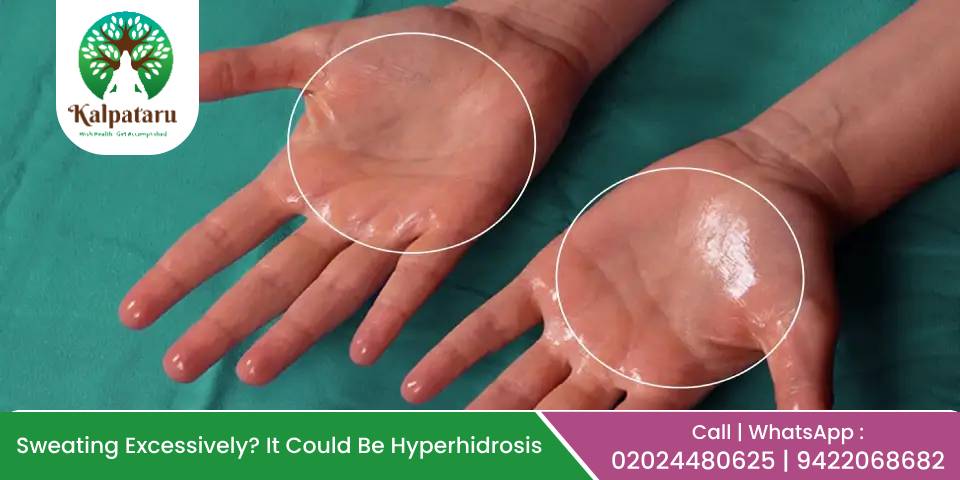
02Apr
Treat excessive sweating (Hyperhidrosis) effectively with Ayurvedic management
Sweating is a natural and essential function of the body that helps regulate temperature and expel toxins. However, some people experience excessive sweating even when they are not in a hot environment or physically active. This condition, known as hyperhidrosis, can significantly impact daily life, making simple tasks like shaking hands, writing, or holding objects uncomfortable and embarrassing. Understanding Hyperhidrosis: Hyperhidrosis is a medical condition characterized by excessive sweating beyond what is necessary for body temperature regulation. It commonly affects areas such as the palms, feet, underarms, and face. It can be classified into primary hyperhidrosis, which has no underlying medical cause and is often hereditary, and secondary hyperhidrosis, which is linked to medical conditions such as diabetes, thyroid disorders, obesity, and infections. Studies show that about 5% of the global population suffers from hyperhidrosis, yet many cases remain undiagnosed and untreated. Additionally, around 30-50% of individuals with hyperhidrosis have a family history of the condition, suggesting a strong genetic component. Causes and Triggers of Hyperhidrosis: Causes of Hyperhidrosis:Hyperhidrosis occurs due to an overactive sympathetic nervous system that overstimulates the sweat glands. The causes can be classified into primary and secondary factors:Primary Hyperhidrosis: This type occurs without any underlying medical condition and is typically hereditary. It usually begins in childhood or adolescence and affects specific areas like the hands, feet, underarms, and face.Secondary Hyperhidrosis: This type is triggered by an underlying medical condition or external factors. It often causes excessive sweating over larger areas of the body and may develop later in life. Common causes include:Hormonal Imbalances: Conditions like hyperthyroidism or menopause can lead to increased sweating.Neurological Disorders: Diseases such as Parkinson's disease and stroke can cause excessive sweating.Infections: Tuberculosis, malaria, and other infections can lead to profuse sweating.Medications: Certain drugs, including antidepressants, pain relievers, and some diabetes medications, can trigger excessive sweating.Obesity: Excess body weight can increase sweating due to higher metabolic activity and heat retention.Anxiety and Stress: Emotional distress can overstimulate sweat glands, leading to excessive sweating episodes. Modern Medical Treatments for Hyperhidrosis: There are several modern treatment options available for managing hyperhidrosis effectively. The choice of treatment depends on the severity of the condition and its impact on daily life. Some commonly used medical treatments include:Antiperspirants: Prescription-strength antiperspirants containing aluminum chloride can help block sweat ducts and reduce excessive sweating, especially in the underarm area.Medications: Oral medications such as anticholinergics can help reduce sweat production by blocking nerve signals to the sweat glands.Botox Injections: FDA-approved botulinum toxin (Botox) injections temporarily block the nerves that stimulate sweat glands, providing relief for several months.Iontophoresis: This treatment uses a mild electrical current to temporarily disable sweat glands, particularly useful for excessive sweating of the hands and feet.Surgical Options: In severe cases, surgical procedures such as endoscopic thoracic sympathectomy (ETS) may be performed to sever nerves responsible for excessive sweating. However, surgery is generally considered a last resort due to potential side effects. Ayurvedic Perspective on Excessive Sweating: Excessive sweating (Atisweda) in Ayurveda is associated with an imbalance of Pitta dosha and the accumulation of Kledha (moisture retention in the body). Factors such as excessive Ama (toxins), increased Medha dhatu (fat tissue), and obesity can contribute to excessive perspiration. When Pitta becomes aggravated due to factors like excessive heat, spicy foods, stress, or hormonal imbalances, it increases internal body heat, leading to excessive sweating. Ayurveda considers hyperhidrosis as Atisweda, a condition that requires balancing the body's heat and internal energy flow. Ayurvedic Remedies for Hyperhidrosis: Ayurveda offers holistic and natural ways to manage hyperhidrosis by cooling the body and restoring balance to the Pitta dosha. Some effective Ayurvedic remedies include:Dietary Modifications: Avoiding spicy, fried, and excessively salty foods can help reduce body heat.Avoid late night food & irregular sleep patterns. Consuming cooling foods such as salads, black raisins, figs, kokum, lemon-based drinks, cucumber, watermelon, buttermilk, and coconut water helps balance Pitta.Herbal Remedies: Ayurvedic herbs like Shatavari, Amla, Ushir, Sariva , Musta,Sandalwood, and Neem have cooling properties that help regulate excessive sweating and detoxify the body. Amapachak medicines Help in digestion and toxin removal. Formulations like Chaturthaka help regulate fat metabolism. Vanga Bhasma is beneficial in controlling excessive sweating. Ayurvedic Siddha-jala (medicated water) prepared with Vala, Pittapapada, Chandan (red sandalwood), and Nagarmotha.Stress Management: Since stress and anxiety can worsen hyperhidrosis, Ayurveda emphasizes yoga, meditation, and Pranayama (breathing exercises) to calm the nervous system and control sweating.Natural Deodorants and Topical Applications: Applying sandalwood powder, rose water, or Multani mitti (Fuller's earth) to the affected areas helps absorb excess sweat and reduce body odor naturally.Panchakarma Detoxification: Shirodhara and Takradhara helps to Calm the nervous system and reduce excessive sweating. Virechana & Abhyanga Therapy Eliminates excess body heat and balances Pitta dosha.Clothing & Lifestyle Changes: Wear breathable cotton clothing to allow proper ventilation and prevent sweat retention. Avoid synthetic fabrics, especially for innerwear like underwear and vests, to reduce discomfort caused by excessive sweating.External Application: Udwarthana (Herbal Powder Massage) Using Triphala, Nagarmotha, and Pittapapada in an Udwarthana (dry powder massage) can open skin pores and allow sweat release, helps to balance Pitta dosha, reducing excessive sweating. In cases of excessive scalp and forehead sweating while eating, applying Lodhra and Vala paste can help regulate overactive sweat glands (Sweda Granthi). Get Ayurvedic Solutions at Kalpataru Ayurvedic Clinic™: If excessive sweating is interfering with your daily life, Ayurveda offers natural and effective treatments to restore balance and well-being. At Kalpataru Ayurvediya Chikitsalaya™ Pune, we provide personalized Ayurvedic solutions tailored to your body's needs. With over 25 years of experience, our expert team helps patients manage hyperhidrosis through holistic therapies, herbal treatments, and lifestyle modifications.Don't let excessive sweating control your life! Book a consultation today and experience the benefits of Ayurveda in managing hyperhidrosis naturally.
Read More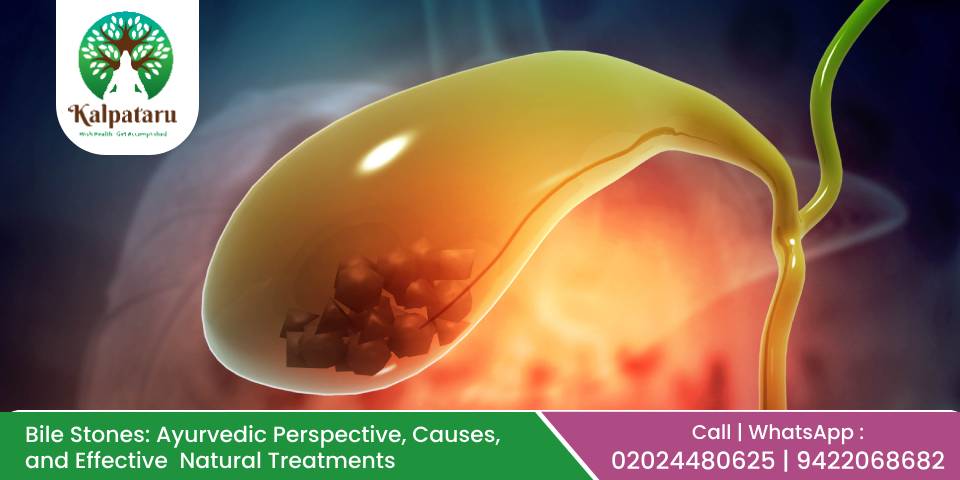
25Mar
Bile Stones: Ayurvedic Perspective, Causes, and Effective Natural Treatments
Bile stones, commonly known as gallstones, are a prevalent digestive condition affecting millions worldwide. These stones form in the gallbladder due to imbalances in bile composition, leading to intense pain, nausea, and digestive disturbances. While modern medicine often recommends surgical removal, Ayurveda provides a holistic approach to treating bile stones naturally. Dr. Manoj Deshpande, a renowned Ayurvedic Doctor in Pune at Kalpataru Ayurvediya Chikitsalaya™ Clinic, specializes in providing effective, natural treatments for bile stones using traditional Ayurvedic therapies, herbal remedies, and lifestyle modifications. Understanding Bile Stones (Gallstones) in Ayurveda: According to Ayurveda, bile stones result from an imbalance in the body's doshas, particularly Pitta and Kapha. Excess Pitta leads to increased bile production, while Kapha causes bile stagnation, leading to stone formation. Over time, undigested toxins (Ama) accumulate, aggravating the condition. Causes of Bile Stones in Ayurveda: Several factors contribute to bile stone formation, including: Poor Digestion (Agnimandya): Weak digestive fire (Agni) leads to incomplete digestion, promoting toxin accumulation. Excessive Pitta Aggravation: Consumption of spicy, oily, and processed foods improves bile concentration, leading to stone formation. High Kapha Levels: A sedentary lifestyle, excessive dairy intake, and heavy meals cause bile stagnation and sludge formation. Stress and Emotional Imbalance: Mental stress disturbs liver function, indirectly affecting bile production and flow. Obesity and Hormonal Changes: Excess body weight and hormonal fluctuations, mainly in women, increase bile cholesterol levels, contributing to stone formation. Unhealthy Eating Habits: Skipping meals, irregular eating patterns, and excessive consumption of junk food promote gallstone development. Sedentary Lifestyle: Lack of physical activity slows metabolism and bile secretion, increasing the risk of bile stones. Symptoms of Bile Stones: The presence of bile stones may not always cause symptoms. However, when they do, common symptoms include: Severe pain in the upper right abdomen Nausea and vomiting Bloating and indigestion Jaundice (yellowing of skin and eyes) Fever and chills (if infection occurs) Burping and acid reflux after meals Ayurvedic Diagnosis of Bile Stones: Ayurveda follows a holistic diagnostic approach based on Prakriti (body constitution), Nadi Pariksha (pulse diagnosis), Udar parikshan ( Abdominal examination), and a detailed history of diet and lifestyle. Dr. Manoj Deshpande at Kalpataru Ayurvediya Chikitsalaya™ conducts thorough assessments to determine the underlying dosha imbalance before prescribing treatments. Ayurvedic Treatment for Bile Stones: Ayurveda offers a range of non-invasive and natural remedies to dissolve bile stones and prevent recurrence. Herbal Remedies Punarnava (Boerhavia diffusa): Acts as a diuretic, helping in bile stone dissolution. Kalonji (Nigella sativa): Known for its liver-cleansing properties, it aids in reducing gallstone formation. Turmeric (Curcuma longa): Possesses anti-inflammatory and bile-regulating properties. Gokshura (Tribulus terrestris): Helps flush out toxins and enhances liver function. Karela (Bitter gourd): Improves bile flow and prevents stone formation. Kutki (Picrorhiza kurroa): Supports liver detoxification and bile secretion. Guggulu (Commiphora wightii): Helps break down cholesterol-based stones. Panchakarma Therapy Panchakarma, an Ayurvedic detoxification process, effectively removes toxins and balances doshas. The following therapies are particularly beneficial for bile stones: Virechana (Therapeutic Purging): Helps eliminate excess Pitta from the liver and gallbladder. Basti (Enema Therapy): Enhances digestion and clears accumulated toxins. Abhyanga (Herbal Oil Massage): Stimulates liver function and improves bile flow. Swedana (Steam Therapy): Helps in detoxification and breaking down stones. Dietary Recommendations A proper diet plays a crucial role in preventing and treating bile stones. Dr. Manoj Deshpande recommends the following dietary modifications: Increase Fiber Intake: Consume fresh fruits, vegetables, and whole grains to aid digestion. Hydration: Drink sufficient quantity of water Avoid Fried and Processed Foods: Reduce Pitta-aggravating foods like spicy, oily, and heavy meals. Use Ayurvedic Spices: Incorporate cumin, coriander, and fennel seeds for better digestion. Healthy Fats: Opt for ghee instead of refined oils to support liver function. Lifestyle Changes Regular Exercise: Engaging in yoga and pranayama enhances digestion and prevents bile stagnation. Stress Management: Meditation and breathing exercises reduce stress, which indirectly benefits liver health. Maintain a Healthy Weight: Avoid obesity, which is a major risk factor for gallstones. Adequate Sleep: Ensure 6-8 hours of quality sleep to support digestive health. Ayurvedic Approach to Dissolving Gallstones: Gallstones are solid deposits that form in the gallbladder due to an imbalance in bile composition. Ayurveda offers effective herbal and mineral treatments to dissolve these stones naturally. Tamra Bhasma: A Powerful Remedy: Tamra Bhasma (calcined copper) is a potent Ayurvedic medicine that helps dissolve bile stones. It must be taken under the supervision of an expert Ayurvedic physician. Lekhana Property: Tamra Bhasma possesses Lekhana (scraping) and disintegration properties, which help break down gallstones into smaller pieces, allowing them to be expelled naturally. Kshara Chikitsa (Alkaline Therapy) for Gallstones: Kshara Chikitsa is an essential Ayurvedic treatment that utilizes alkaline substances derived from medicinal plants. How Ksharas Are Made: Certain plants are burned into ashes and processed to extract their alkaline properties. These Ksharas help dissolve and remove gallstones due to their Lekhana (scraping) and Ksharana (corrosive) properties. Kokilaksha (Asteracantha longifolia) in Gallstone Treatment: Known as Talimkhana in Marathi, this medicinal plant is used to prepare Kokilaksha Kshara, which is beneficial for breaking down bile stones. Ayurvedic Decoctions (Kashayas) for Gallstones: Several Ayurvedic Kashayas (herbal decoctions) are used to manage gallstones effectively. Phalatrikadi Kashaya: This Ayurvedic formulation helps gradually dissolve gallstones and prevent their recurrence. When to Consider Surgery? While Ayurvedic treatment can help dissolve gallstones, certain cases may require surgical intervention. Surgery May Be Needed If: The gallstone causes severe pain and blocks the bile duct. It leads to infection, swelling, or fever that cannot be controlled with medication. Ayurvedic Treatment Is Suitable If: The gallstone is stable and not causing significant discomfort. There are no symptoms of jaundice or severe complications. In such cases, Ayurvedic medicines can help reduce the size of the gallstone and eliminate it naturally over time. Dr. Manoj Deshpande is a renowned Ayurvedic Doctor in Pune with expertise in treating liver and gallbladder disorders. At Kalpataru Ayurvediya Chikitsalaya™, he provides personalized Ayurvedic treatments based on individual Prakriti, ensuring effective and long-term relief from bile stones. Conclusion: Bile stones can be effectively managed through Ayurvedic treatments, lifestyle changes, and dietary modifications. Instead of opting for surgery, Ayurvedic therapies offer a natural and holistic way to dissolve stones, cleanse the liver, and restore digestive balance. If you are struggling with bile stones and looking for a natural, holistic solution, consult Dr. Manoj Deshpande at Kalpataru Ayurvediya Chikitsalaya™ today and embark on your journey to wellness the Ayurvedic way!
Read More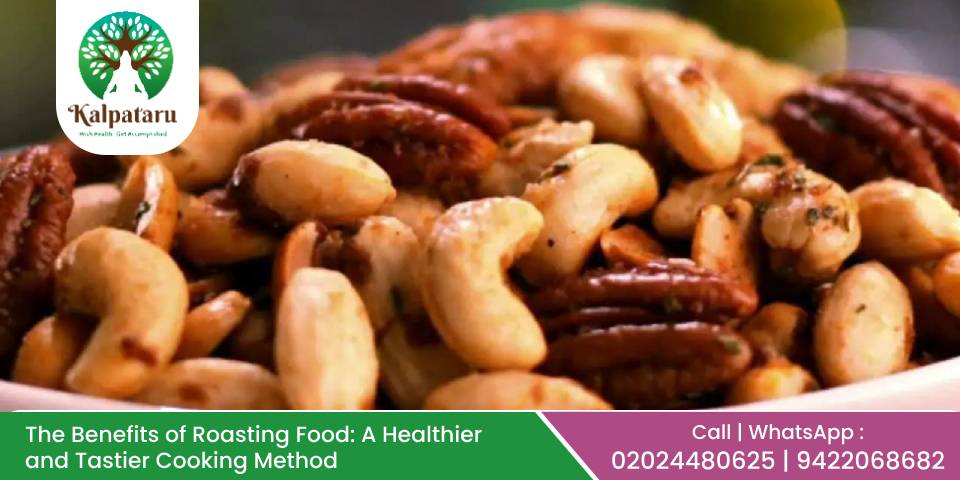
17Mar
The Benefits of Roasting Food: A Healthier and Tastier Cooking Method
Cooking methods significantly impact the nutritional value, taste, and digestibility of food. Among the various cooking techniques, roasting is an excellent method that enhances flavors, preserves nutrients, and aligns with holistic health principles. Roasting involves cooking food with dry heat, either in an oven, over an open flame, or on a hot surface. This method helps to caramelize natural sugars, enrich taste, and bring out the deep, earthy aroma of ingredients. Roasting grains reduces their calorie content and slightly lowers carbohydrates, but it helps retain essential nutrients. That's why roasted grains play an important role in Indian cuisine, especially in Maharashtra. Popular dishes like Thalipeeth and other recipes made from Bhajani flour (roasted multigrain flour) are widely enjoyed. From an Ayurvedic perspective, roasting also plays a crucial role in balancing the three doshas (Vata, Pitta, and Kapha), aiding digestion, and improving overall well-being. Let's explore the detailed benefits of roasting food and how Ayurveda supports this cooking method. Enhances Flavor and Texture: One of the primary reasons people prefer roasting is the transformation it brings to food in terms of taste and texture. Roasting intensifies the natural sweetness of vegetables, enhances the umami flavor in meats, and adds a rich, nutty profile to nuts and grains. How does this happen? The Maillard reaction (a chemical reaction between amino acids and reducing sugars that occurs under heat) is responsible for the deep flavors and crispy textures in roasted foods. Roasting removes excess moisture, concentrating flavors and creating a pleasant crunch or caramelized crust. Meats, when roasted, develop a rich brown color with intensified taste, while vegetables become slightly crisp on the outside and tender inside. Preserves Essential Nutrients: Compared to boiling, which can leach nutrients into water, or frying, which adds unhealthy fats, roasting helps retain the essential vitamins and minerals in food. Nutrient retention in roasted food: Vegetables like carrots, bell peppers, and sweet potatoes maintain their fiber and antioxidant properties when roasted. Roasting tomatoes increases lycopene (a powerful antioxidant beneficial for heart health and immunity). Since roasting requires minimal oil, it prevents the loss of fat-soluble vitamins like A, D, E, and K. Supports Digestive Health (Ayurvedic Perspective): Ayurveda highlights the importance of Agni (digestive fire) in ensuring optimal digestion and absorption of nutrients. Roasting enhances digestibility by making food lighter and reducing excess moisture, which can lead to bloating or indigestion. Roasting and the Doshas: Balances Kapha Dosha: Moist and heavy foods can increase Kapha, leading to sluggish digestion and mucus formation. Roasting helps remove excess moisture and makes food drier, reducing Kapha's heaviness. Pacifies Vata Dosha: Dry foods tend to aggravate Vata. However, when roasting is done with ghee or warm spices (cumin, turmeric, black pepper), it can help balance Vata. Moderation for Pitta Dosha: Since roasting uses dry heat, it can sometimes aggravate Pitta (heat element) if consumed in excess. Pitta individuals should include cooling elements like ghee or yogurt alongside roasted foods. Reduces Antinutrients and Enhances Absorption: Certain foods contain antinutrients that hinder the absorption of essential minerals like iron, calcium, and zinc. Roasting helps break down these compounds, making food more bioavailable. Nuts and seeds contain phytic acid, which can interfere with mineral absorption. Roasting neutralizes phytic acid, making these foods more digestible. Legumes and grains contain lectins and enzyme inhibitors that may cause bloating. Roasting reduces these compounds, improving their nutritional profile and ease of digestion. Requires Minimal Oil and Enhances Satiety: Roasting allows food to be cooked with little or no oil while still enhancing its natural flavors. This makes it a healthier alternative to frying, which adds excess fats and calories. Heart-friendly cooking: Since roasting does not require excessive oil, it helps in maintaining healthy cholesterol levels. Enhances satiety: The crispy texture and rich flavor of roasted foods make meals more fulfilling, preventing overeating. Retains Antioxidants and Boosts Immunity: Certain antioxidants become more bioavailable when foods are roasted, improving their health benefits. Roasting tomatoes increases lycopene, which supports heart health, skin protection, and immunity. Garlic and onions develop higher concentrations of sulfur compounds, known for their anti-inflammatory and immune-boosting properties. Ayurveda-Recommended Roasted Foods: In Ayurveda, specific foods are traditionally roasted to enhance their medicinal properties and digestibility. Common Ayurvedic Roasted Foods: Roasted cumin seeds: Aid digestion, reduce bloating, and detoxify the body. Roasted fennel seeds: Help soothe digestion and reduce bloating. Roasted chickpea flour (sattu): Cooling and nourishing, ideal for summer. Roasted nuts (almonds, walnuts): Provide warmth and sustained energy, especially in colder months. Roasted spices (turmeric, black pepper, coriander): Improve bioavailability and support gut health. Simple Roasting Tips for a Healthier Diet: To maximize the benefits of roasting, it is important to follow some healthy cooking practices: Use healthy oils: If oil is required, choose ghee, coconut oil, or olive oil for added health benefits. Roast at moderate temperatures: Avoid excessive charring to prevent the formation of harmful compounds. Incorporate spices: Ayurvedic spices like cumin, turmeric, and coriander enhance taste, digestion, and health benefits. Pair wisely: Combine roasted nuts with honey or dates to balance Vata, or roast grains with ghee to improve digestibility. Why Choose Roasted Grains for Dinner? When grains are roasted, they lose moisture and become easier to digest. This makes them an excellent choice for dinner, as they are lighter on the stomach. Since our metabolism slows down at night, heavy meals can be hard to digest. Using Bhajani flour or roasted grains in your dinner can help in maintaining good digestion and overall health. The Power of Lahiya (Puffed Grains): Lahiya, a type of puffed grain, is a part of the Bhajani category. Among the different varieties, puffed rice (Tandulachi Lahiya) is commonly used in religious rituals like Lakshmi Puja. However, beyond tradition, lahiya is also a nutrient-rich food that doesn't increase fat or kapha (mucus) in the body. At Kalpataru Ayurvediya Chikitsalaya™, we often recommend including lahiya in weight loss diets. Puffed jowar (sorghum) and rice lahiya are excellent dinner options because they: Satisfy hunger without adding excess calories Are light on digestion and don't put pressure on metabolism Help in fat loss due to their low-calorie content Since our metabolism is naturally slower at night, a light dinner is essential for maintaining a healthy weight. That's why switching to roasted grains or lahiya-based meals can be an excellent choice for better digestion, weight management, and overall well-being! Conclusion: Roasting is more than just a cooking technique—it is a health-enhancing practice that preserves nutrients, enriches flavors, and aligns with Ayurvedic principles of well-being. Whether you enjoy roasted vegetables, nuts, or spices, incorporating this method into your daily meals can improve digestion, boost immunity, and promote overall health. By understanding how different foods interact with your body type (dosha), you can make mindful choices that support holistic wellness. By adopting roasting as a primary cooking method, you can savor delicious meals while maintaining a balanced and healthy lifestyle.
Read More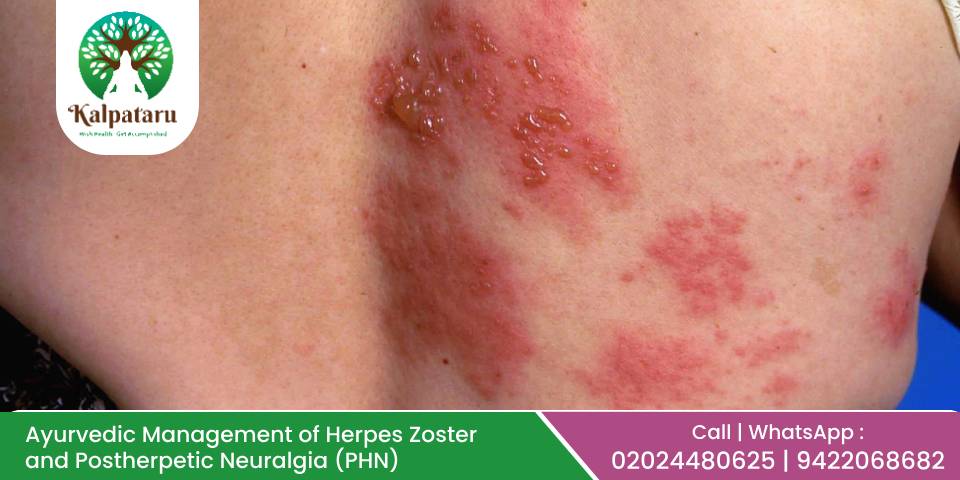
24Feb
Ayurvedic Management of Herpes Zoster and Postherpetic Neuralgia (PHN)
Herpes Zoster, commonly known as shingles, is a painful viral infection that occurs due to the reactivation of the varicella-zoster virus—the same virus responsible for chickenpox. Once a person recovers from chickenpox, the virus lies dormant in the nerve tissues and can reactivate later in life, leading to Herpes Zoster. This condition is characterized by a painful rash with fluid-filled blisters, which usually appears on one side of the body or face, following the pathway of nerves. A common and often debilitating complication of Herpes Zoster is Postherpetic Neuralgia (PHN). PHN is a persistent nerve pain that continues long after the shingles rash has healed. It can last for months or even years, significantly affecting the quality of life for those affected. This blog explores the causes, symptoms, and Ayurvedic management of Herpes Zoster and PHN, emphasizing holistic healing through ancient Ayurvedic principles and practices. Causes and Symptoms of Herpes Zoster: Causes: Reactivation of the Varicella-Zoster Virus: After recovering from chickenpox, the virus remains dormant in the sensory nerve ganglia. Under certain conditions, it can reactivate, causing Herpes Zoster. Weak Immunity: Individuals with weakened immune systems due to age, stress, or underlying health conditions are at higher risk. History of Chickenpox: People who have had chickenpox are susceptible to shingles later in life. Other Contributing Factors: Chronic illnesses like diabetes and cancer. Immunosuppressive medications or chemotherapy. Physical or emotional stress. Symptoms of Herpes Zoster: Painful Rash and Blisters: A painful, red rash with fluid-filled blisters typically appears on one side of the body or face, following a nerve path (dermatome). Burning, Tingling, or Numbness: The affected area may experience tingling, burning, or numbness even before the rash appears. Sensitivity to Touch: The rash area is usually highly sensitive to touch, causing severe discomfort. Fever, Headache, and Fatigue: General symptoms like fever, headache, and fatigue often accompany the rash. Itching and Inflammation: The rash may be itchy and inflamed, adding to the discomfort. Postherpetic Neuralgia (PHN) Symptoms: Postherpetic Neuralgia is the most common complication of Herpes Zoster, occurring when the nerve fibers are damaged during the viral attack. It leads to chronic pain in the affected area, which can be challenging to manage. PHN Symptoms: Intense Nerve Pain: Persistent and severe pain in the area where the shingles rash was present. The pain may be sharp, burning, or throbbing. Sensitivity to Light Touch (Allodynia): Even the lightest touch, such as clothing brushing against the skin, can cause extreme pain. Itching and Numbness: The affected area may feel numb or experience itching sensations. Difficulty in Daily Activities: The chronic pain can significantly interfere with daily activities, affecting sleep, work, and social interactions. Emotional Impact: Chronic pain can lead to anxiety, depression, and a decreased quality of life. Ayurvedic Perspective on Herpes Zoster and PHN: In Ayurveda, Herpes Zoster is compared to Visarpa, a condition caused by an imbalance of Vata, Pitta, and Kapha doshas, with Pitta and Vata being the primary culprits. The condition is characterized by severe pain, inflammation, and blistering. Ayurvedic Pathogenesis: Pitta Dosha Imbalance: The burning sensation, inflammation, and redness are due to aggravated Pitta dosha. Vata Dosha Imbalance: Pain, tingling, and numbness are attributed to aggravated Vata dosha. Kapha Dosha Involvement: Fluid-filled blisters are related to Kapha imbalance, which affects the skin and underlying tissues. Postherpetic Neuralgia (PHN): PHN is linked to Vata dosha aggravation, leading to severe nerve pain and hypersensitivity. Ayurvedic Approach to Herpes Zoster and PHN: Ayurveda adopts a holistic and individualized approach, aiming to balance the doshas, detoxify the body, and provide symptomatic relief while enhancing immunity. Dosha Balancing: Pitta Shamak (Cooling) Treatment: To reduce burning and inflammation using cooling herbs and therapies. Vata Shamak (Nerve-Calming) Treatment: To ease pain, tingling, and nerve sensitivity using grounding and calming herbs. Detoxification (Shodhana): Virechana (Purgation Therapy): Eliminates aggravated Pitta, reducing inflammation and burning sensations. Vasti (Medicated Enema): Balances Vata dosha, alleviating nerve pain and hypersensitivity. External Applications: Lepa (Herbal Paste): Cooling pastes made of Sandalwood, Turmeric, and Neem, licorice, Ushir, Jitsaya , suvarngairik soothe the rash and reduce itching. Taila (Medicated Oils): Using Mahanarayan Taila, chandabalalakshsdi and Ksheerabala Taila for gentle massage relieves nerve pain. Internal Medicines: Guduchi (Tinospora Cordifolia): Boosts immunity and reduces inflammation. Manjistha (Rubia Cordifolia): Blood purifier and anti-inflammatory. Ashwagandha (Withania Somnifera): Calms nerves and reduces pain. Rasayana (Rejuvenating Herbs): Chyawanprash enhances immunity and vitality. Ayurvedic panchkarma therapies such as raktmokshan (Bloodletting) by means of Sirawedh and Jalaukawacharan (leech application) give quick and radical relief in herpez zoster and post herpatic neuralgia also. Vedhan is one another therapy that relieves pain instantly. Virechan and basti therapies are reserved for severe and chronic pains. Lep chikitsa - Herbs having cooling nature such as gairik, yastimadhu, goghrut, camphor, dashang lep are used after mixing them in shatdhaut ghrut. This combination is very soothing for nerves. Diet and Lifestyle Tips in Ayurveda: Dietary Recommendations: Avoid spicy, oily, and acidic foods to reduce Pitta dosha. Include cooling foods like cucumber, coconut water, and leafy greens. Consume easily digestible, light meals to avoid aggravating Kapha dosha. Lifestyle Modifications: Practice Pranayama and Yoga to balance Vata dosha and reduce stress. Maintain hygiene to avoid secondary infections. Get adequate rest to enhance the healing process. Integrating Ayurveda and Modern Medicine. Sometimes a combination of Ayurveda and modern medicine is needed to provide effective management of Herpes Zoster and PHN: Ayurvedic Immunity Boosters: Guduchi ,trifala, nimsal,sariwa Ashwagandha etc support faster recovery. Pain Management: Ayurvedic oils for topical relief. Some herbomineral combinations are used to alleviate pain effectively Lifestyle Modifications: Ayurvedic dietary and stress management techniques enhance overall healing. Conclusion: Ayurveda offers a holistic and natural approach to managing Herpes Zoster and Postherpetic Neuralgia. By focusing on dosha balance, immunity enhancement, and nerve regeneration, Ayurveda addresses the root cause and symptoms effectively. With its emphasis on natural remedies, immunity-boosting herbs, and personalized treatment plans, Ayurveda stands as a reliable and effective choice for managing Herpes Zoster and PHN, minimizing side effects and enhancing overall health. Kalpataru Ayurvediya Chikitsalaya is dedicated to providing effective Ayurvedic solutions for Herpes Zoster and PHN with a personalized and ethical approach. Our combination of traditional Ayurvedic therapies and modern scientific research ensures the best outcomes for our patients. If you or your loved ones are suffering from Herpes Zoster or Postherpetic Neuralgia, visit Kalpataru Ayurvediya Chikitsalaya for reliable and holistic Ayurvedic care. Experience the power of Ayurveda in healing nerve pain and boosting immunity for a healthier, pain-free life.
Read More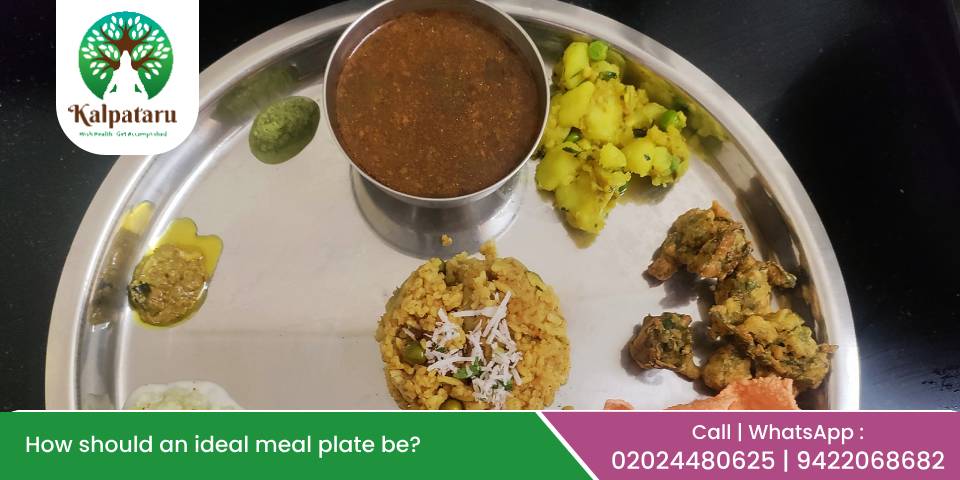
20Feb
How should an ideal meal plate be?
Having balanced diet is one of the best ways to maintain good health. In your meal plate Brown Rice, Khalpi wheat, Pulses and Legumes, Raw foods and proper hydration are very important for optimal wellness. Raw foods are rich in natural nutrients, vitamins, and minerals that are often lost during cooking. When you cook food, high temperatures can destroy these essential components. By consuming raw food, you get the full nutritional value that nature intended. Raw foods are also rich in enzymes that aid digestion and enhance nutrient absorption. When food is heated above 118°F (48°C), these enzymes are destroyed. Eating raw foods ensures that these enzymes remain intact, promoting better digestion and gut health. Why Raw Food For Daily Nutrition is Important? Raw food not only provides essential nutrients but also promotes gut health. It strengthens the colony of friendly bacteria in your intestines, improving digestion and immunity. Research shows that a healthy gut microbiome enhances immunity and protects against diseases. Conversely, an unhealthy gut can lead to issues like heart disease, diabetes, degenerative diseases, and autoimmune disorders. Raw foods are alkaline in nature, helping to balance the body's pH levels. An alkaline diet reduces inflammation, which is linked to chronic diseases like arthritis and cancer. Additionally, raw foods are low in calories and high in fiber, promoting weight loss and better metabolism. Blood Sugar Regulation: Studies suggest that eating raw food before consuming carbohydrates helps regulate blood sugar levels. When you eat raw food first, it slows down the rise in blood sugar. This prevents sudden glucose spikes and helps in the gradual absorption of sugar. This practice can benefit people with diabetes and those looking to maintain steady energy levels. Raw foods have a low glycemic index, meaning they cause a slower rise in blood sugar compared to processed foods. Including salads or raw vegetable snacks before meals can be an effective strategy to manage blood sugar. Antioxidants in Raw Food: Raw foods are rich in antioxidants, which play a vital role in reducing aging and protecting cells from damage. Vegetables like carrots, cucumbers, beets, radishes, onions, raw cabbage, and purple cabbage are excellent sources of antioxidants. Including a variety of these vegetables in your diet can significantly boost your health. Antioxidants neutralize free radicals, preventing cellular damage and reducing the risk of chronic diseases like cancer and heart disease. Berries, citrus fruits, and leafy greens are other excellent sources of antioxidants. Consuming them raw ensures maximum nutrient retention. Power of Pulses and Legumes: Pulses and legumes, such as chickpeas, kidney beans, mung beans, lentils, moth beans, and cowpeas, are rich in protein. They are especially important for vegetarians who may face a risk of protein deficiency. Proteins are the building blocks of the body. They are essential for muscle repair, immunity, and hormonal balance. A lack of protein can accelerate aging, weaken muscles, and compromise immunity. Including a bowl of pulses or legumes in your daily diet can ensure adequate protein intake. Addressing Gas Issues: Some people experience gas after eating legumes. Soaking legumes overnight can help reduce gas formation. Adding a pinch of baking soda while cooking also helps. Regular consumption usually resolves this issue within 10-15 days. Sometimes sprouting legumes is another effective way to enhance nutrient absorption and reduce bloating. Nutrient-Rich Chutneys: Indian diets traditionally include a variety of chutneys, such as flaxseed, coconut, sesame, and niger seed chutneys. These are packed with nutrients and add flavor to meals. For example, flaxseed chutney is rich in omega-3 fatty acids. However, avoid over-roasting flaxseeds as it reduce their nutritional value. Adding garlic can enhance the health benefits even more. Chutneys made from raw ingredients like cilantro, mint, or coconut provide enzymes and phytonutrients. They enhance digestion and add a burst of flavor to meals without unhealthy additives. Importance of Antioxidants: Antioxidants are crucial for slowing down aging. They protect the body from harmful free radicals. Adding lemon juice or a sprinkle of cinnamon powder to salads or dishes can significantly increase the antioxidant content. Though needed in small amounts, antioxidants are vital for maintaining youthful health. Dark chocolate, green tea, and nuts are other potent sources of antioxidants. Consuming them in moderation can improve heart health and enhance cognitive function. Choosing the Right Type of Rice: Rice is a staple food in many cultures, especially in India. However, polished white rice is commonly consumed, which lacks essential nutrients. Opt for hand-pounded rice, but if it's unavailable, brown rice is a great alternative. Brown rice is rich in fiber and nutrients that help prevent diabetes. It also keeps blood sugar levels stable, supporting overall health. Red rice and black rice are even more nutritious options. They contain anthocyanins, powerful antioxidants that improve cardiovascular health. These varieties are also high in fiber, promoting better digestion. Why Choose Khapli Wheat? Wheat is another staple in many diets. Khapli wheat (Emmer wheat) is a more nutritious choice than regular wheat. It has a lower glycemic index, meaning it raises blood sugar slowly. It also contains more fiber and nutrients. The taste is better than conventional wheat, making it an ideal choice for daily meals. Khapli wheat is rich in magnesium, which aids in regulating blood sugar and reducing the risk of type 2 diabetes. It also contains a good amount of protein, supporting muscle health and energy levels. Importance of Hydration: Drinking enough water is essential for good health. It aids digestion, prevents acidity, and reduces bloating. Many people forget to drink water during meals, especially while watching TV. Ayurveda suggests sipping water during meals to aid digestion and prevent overeating. This practice helps you feel fuller, reducing the chances of overeating. Drinking coconut water, buttermilk, and herbal teas also contribute to daily hydration needs. Additional Tips for a Balanced Diet: Include Seasonal Fruits: They are rich in vitamins and minerals. Seasonal fruits provide antioxidants and boost immunity. Nuts and Seeds: Include nuts like almonds and walnuts. They are rich in healthy fats and proteins. Seeds like chia and sunflower seeds are also nutrient-dense. Leafy Greens: Spinach, Fenugreek, Rajgira, and other leafy greens are packed with vitamins and minerals. They also contain fiber, which aids digestion. Spices and Herbs: Turmeric, ginger, and garlic have anti-inflammatory and antioxidant properties. Including them in meals enhances both flavor and health benefits. Mindful Eating: Avoid distractions like TV while eating. Chew food slowly to aid digestion and prevent overeating. Meal Timing: Maintain consistent meal timings. Eating dinner early helps in better digestion and improves sleep quality. Conclusion: Brown Rice, Khalpi wheat, Pulses and Legumes, Raw foods and proper hydration are very important for optimal wellness. Including raw vegetables, legumes, nutrient-rich chutneys, and the right type of grains can significantly improve your diet. Simple practices like eating raw food before carbohydrates and staying hydrated can make a big difference. By choosing the right foods and maintaining good eating habits, you can enhance your health, boost immunity, and slow down aging. Start today—add more raw food to your plate, drink enough water, and make mindful choices. Your body and mind will thank you. Dr. Manoj Deshpande and Dr. Aparna Deshpande at Kalpataru Ayurvediya Chikitsalaya™ Clinic provide the best Ayurvedic Treatment for Psoriasis & various diseases in Pune, Maharashtra. For more information about our comprehensive treatment options, or to requestan appointment with the best Ayurvedic Doctor in Pune, call +919422068682 / +919764837167 / 020-24480625 or Click on Book an Appointment.
Read More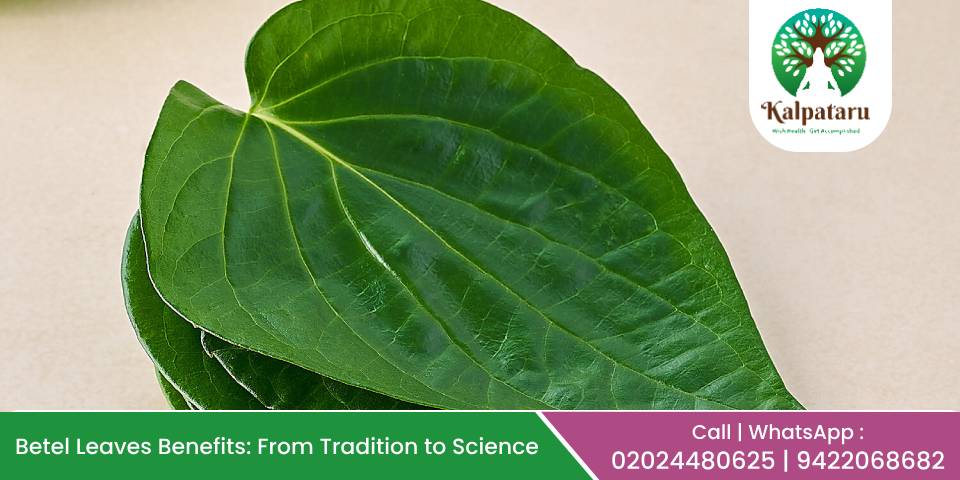
01Feb
Betel Leaves Benefits: From Tradition to Science
Betel leaves, also known as Piper betle, have been an integral part of traditional medicine and cultural rituals for centuries. Revered in Ayurveda and other ancient healing systems, these heart-shaped leaves offer numerous health benefits that modern science is beginning to validate. Recent research suggests that extracts from betel leaves may have beneficial effects in the treatment of certain types of blood cancers. Ayurveda, India's ancient medical system, has long recognized the medicinal properties of betel leaves, known in Sanskrit as "Tambul." Let's explore how betel leaves transition from tradition to scientific validation. Traditional Uses of Betel Leaves: Betel leaves hold a significant place in various cultures, particularly in South and Southeast Asia. Some of the prominent traditional uses include: Ayurvedic Medicine: Used for treating cough, wounds, headaches, and digestive issues. Religious & Social Practices: Offered in prayers and used in betel quid for ceremonial purposes. Folk Remedies: Applied externally for pain relief and consumed for oral hygiene and respiratory health. Ayurvedic Use of Betel Leaves: In Ayurveda, betel leaves are considered a powerhouse of medicinal properties. They are categorized under "Vata-Kapha Shamak" herbs, meaning they help balance Vata (air and space elements) and Kapha (water and earth elements) in the body. Some key Ayurvedic uses include: Digestive Tonic: Betel leaves are used to stimulate digestion and improve gut health by enhancing the secretion of digestive enzymes. Detoxification: They are believed to help cleanse the body of toxins and improve liver function. Oral Health: Traditional Ayurvedic texts recommend chewing betel leaves to strengthen gums, prevent bad breath, and reduce oral infections. Respiratory Relief: Betel leaves are used in Ayurveda to alleviate respiratory issues like cough, asthma, and bronchitis by clearing mucus and acting as a natural bronchodilator. Skin Healing: Due to their antiseptic properties, betel leaves are applied to wounds, cuts, and skin irritations for faster healing. Shwaskuthar: An Ayurvedic medicine that includes betel leaves for treating respiratory ailments. Tambulsavam: A formulation derived from betel leaves, traditionally used in Ayurvedic practices. Scientific Health Benefits of Betel Leaves: Recent scientific research has uncovered multiple health benefits of betel leaves, corroborating traditional claims: Rich in Antioxidants: Betel leaves contain polyphenols and flavonoids, which help neutralize harmful free radicals, reducing oxidative stress and inflammation in the body. Promotes Digestive Health: Chewing betel leaves is known to stimulate saliva production and gastric juices, aiding digestion and relieving bloating, constipation, and acidity. Anti-Microbial Properties: Studies suggest that betel leaves have strong antibacterial and antifungal properties, making them effective against oral infections, bad breath, and even wound healing. Respiratory Benefits: Betel leaves have expectorant properties that help clear mucus, providing relief from cough, cold, and congestion. They are often used in herbal teas and steam inhalation. Pain Relief and Anti-Inflammatory Effects: Traditionally applied as a poultice, betel leaves have been found to possess anti-inflammatory properties that help reduce joint pain, headaches, and muscle soreness. Blood Sugar Regulation: Emerging research indicates that betel leaves may help regulate blood sugar levels, making them beneficial for diabetes management. Cardiovascular Health: The presence of essential phytochemicals in betel leaves can help regulate cholesterol levels and improve heart health. How to Use Betel Leaves? Chewing Fresh Leaves: Can be consumed alone or with natural additives like catechu and supari ( seeds of betel palm) for medicinal benefits. Betel Leaf Tea: Boiling betel leaves in water and drinking the infusion for digestive and respiratory relief. Topical Applications: Crushed leaves applied to wounds, boils, or inflamed areas for healing. Essential Oil Extracts: Used in aromatherapy and as a natural remedy for microbial infections. Additional Uses of Betel Leaves: In addition to the health benefits mentioned earlier, betel leaves have some lesser-known uses: Skin Care: The antimicrobial properties of betel leaves make them effective in treating acne, skin infections, and minor wounds. Weight Management: Some studies suggest that betel leaves may help improve metabolism and support weight loss efforts. Stress Reduction: Betel leaves have a mild calming effect and are used in traditional practices to reduce stress and anxiety. Insect Repellent: The strong aroma of betel leaves acts as a natural insect repellent, keeping mosquitoes and bugs at bay. Hair Health: Betel leaves have been used to promote hair growth and prevent dandruff when applied as a hair mask or infused in oils. Cultural Significance: In Indian culture, consuming betel leaves with areca nut, fennel seeds, clove, cardamom, or guava leaves is a common practice. This traditional preparation is believed to aid digestion and freshen breath. Precautions & Side Effects: While betel leaves offer numerous benefits, excessive or improper use can lead to side effects: Chewing betel quid with tobacco is harmful and increases the risk of oral cancer. Overuse may cause mild irritation in the mouth and throat. Consult a doctor before use, especially for those with pre-existing health conditions. Modern-Day Concerns with Betel Leaf Consumption: However, the contemporary practice of consuming betel leaves, especially those available at roadside stalls, has deviated from its original form. The following issues are often observed: Adulteration with Chemicals: Many stalls use chemical-laden chutneys and flavorings, which can be harmful. Addition of Sweeteners: Ingredients like gulkand (rose petal preserve) and cherry are added for flavor, but these sweeteners can diminish the medicinal properties of betel leaves. While traditional consumption of betel leaves is intended for health benefits, the modern adulterated versions may cause harm. The sweeteners and chemicals can negate the natural benefits of betel leaves and may even pose health risks. Recommendations: Avoid consuming betel leaves from commercial stalls that use artificial additives. Opt for traditional preparations without added sweeteners or chemicals to retain the natural health benefits. Conclusion: Betel leaves are a remarkable gift of nature, bridging ancient wisdom and modern scientific validation. Whether for digestive aid, oral hygiene, or anti-inflammatory benefits, incorporating betel leaves into daily life can be a natural way to enhance well-being. However, mindful and moderate use is key to harnessing their full potential safely. As scientific research progresses, we may uncover even more hidden benefits of betel leaves, further strengthening their position as a valuable natural remedy. Until then, these leaves continue to play a significant role in both traditional and modern wellness practices, proving their enduring importance in holistic health. Dr. Manoj Deshpande and Dr. Aparna Deshpande at Kalpataru Ayurvediya Chikitsalaya™ Clinic provide the best Ayurvedic Treatment for Psoriasis & various diseases in Pune, Maharashtra. For more information about our comprehensive treatment options, or to requestan appointment with the best Ayurvedic Doctor in Pune, call +919422068682 / +919764837167 / 020-24480625 or Click on Book an Appointment.
Read More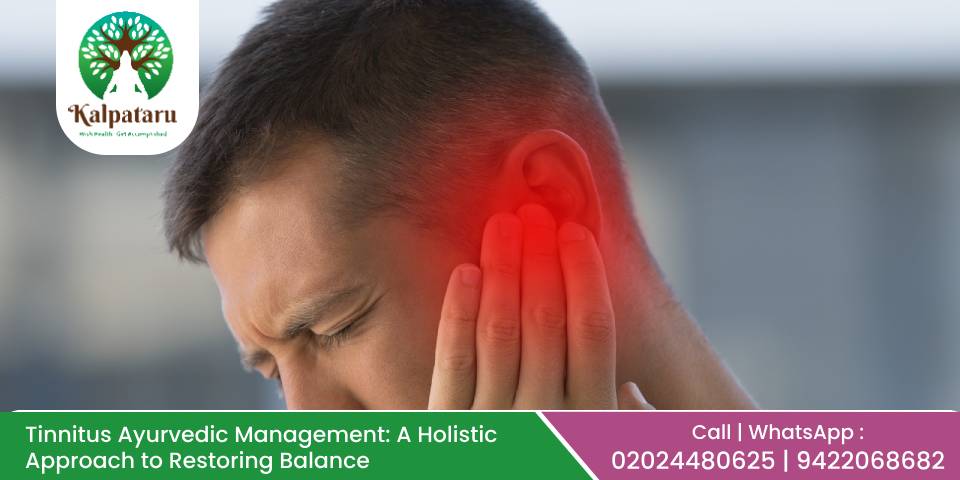
29Jan
Tinnitus Ayurvedic Management: A Holistic Approach to Restoring Balance
Tinnitus, commonly described as a ringing or buzzing in the ears, can significantly impact the quality of life. This persistent condition is often a result of underlying problems such as ear infections, exposure to loud noise, stress, or even neurological disorders. While conventional treatments focus on symptom management, Ayurveda provides a holistic approach to manage the root cause and promote overall well-being. At Kalpataru Ayurvediya Chikitsalaya™, Dr. Manoj Deshpande, a renowned Ayurvedic Doctor in Pune, specializes in the comprehensive treatment of tinnitus. The ears are considered the primary site of Vata dosha according to Ayurveda. Therefore, managing Vata imbalance is crucial when addressing ear-related conditions. Let's explore how Ayurveda can help manage this condition effectively. Common Symptoms of Ear Disorders: Some of the common symptoms related to ear problems include: Tinnitus(referred to as "Karna Nada" or ringing in the ears) Deafness(reduced hearing ability or "Karna Badhirya") Vertigo(dizziness or imbalance) When these three symptoms occur together, it may indicate a condition known as Ménière's Disease. This condition requires a slightly different approach to treatment, so it is important to evaluate if the patient shows these specific symptoms. Understanding Tinnitus in Ayurveda: In Ayurveda, tinnitus is referred to as "Karnanada" or "Karnakshweda," which translates to ear noise. It is primarily caused by an imbalance in the Vata dosha, the energy responsible for movement and communication in the body. Factors like stress, poor lifestyle choices, improper digestion, and exposure to loud noises can aggravate Vata, leading to the manifestation of tinnitus. Ayurveda aims to restore harmony among the doshas, thereby managing the root causes of tinnitus rather than just suppressing its symptoms. Common Causes of Tinnitus: Stress and Anxiety: Increased mental strain can aggravate Vata dosha. Poor Nutrition: Deficiency of vital nutrients can weaken the auditory system. Exposure to Loud Noises: Continuous exposure to high-decibel sounds damages the inner ear. Aging: Natural degeneration can lead to impaired hearing and tinnitus. Vata Imbalance: Dryness and irregularities in the body caused by aggravated Vata can impact auditory functions. Underlying Health Conditions: Conditions such as hypertension or ear infections can contribute to tinnitus. Ayurvedic Diagnosis for Tinnitus: Dr. Manoj Deshpande uses a holistic diagnostic approach, which includes: Prakriti Analysis: Understanding the patient's unique constitution. Dosha Assessment: Identifying the dosha imbalance causing tinnitus. Nidan Pariksha: Investigating potential triggers such as stress, diet, or environmental factors. Dhatukshaya Evaluation: Assessing tissue depletion, particularly of Shukra (reproductive tissue) and Majja (nervous tissue), which may contribute to tinnitus. Ayurvedic Approach to Tinnitus Management: The Ayurvedic approach at Kalpataru Ayurvediya Chikitsalaya™ focuses on managing the root cause of tinnitus. Key treatment modalities include: Herbal Remedies: Ayurvedic herbs play a pivotal role in managing tinnitus. Key herbs include: Ashwagandha: Relieves stress and stabilizes the nervous system. Brahmi: Improves cognitive function and calms the mind. Bilva (Bael): Enhances auditory health and soothes aggravated Vata. Triphala: Promotes detoxification and overall balance. Shankhpushpi: Helps balance Vata and promotes relaxation. Haridra (Turmeric): Acts as an anti-inflammatory and antioxidant to promote healing. Aamalaki, Musta, Guduchi are also very useful to restore normal ear functions and cure tinnitus In Addition, Ayurveda recommends the following medicines to manage conditions like tinnitus and deafness: Sariva Shankha Bhasma Saraswata Arishta In chronic cases of tinnitus, medicines containing Swarna Bhasma (gold preparation) may be used, as they are highly effective in managing long-standing conditions. Panchakarma Therapies: Panchakarma therapies help cleanse the body of toxins (Ama) that may contribute to dosha imbalances. Specific treatments like Karnapoorana: Medicated oils are gently poured into the ears to nourish auditory nerves and pacify Vata. Nasya: Herbal oils are administered through the nasal passages to cleanse toxins and enhance head and neck function. Shirodhara: A steady stream of warm herbal oil poured on the forehead to reduce stress and enhance mental clarity. Agnikarma Therapy: At Kalpataru Ayurvediya Chikitsalaya™, we offer specialized treatments like Agnikarma to support ear health. These therapy have shown remarkable results in improving symptoms like tinnitus and deafness. Agnikarma is particularly effective in managing Karna Nada (tinnitus). Many patients treated at our clinic have experienced significant relief and, in some cases, complete recovery from their symptoms. By combining the right medicines and therapies, Ayurvedic treatment provides holistic and sustainable results for ear-related conditions. Dietary Recommendations: A Vata-pacifying diet is emphasized to maintain balance and reduce symptoms. Foods that are warm, unctuous, and grounding are recommended, while dry, cold, and processed foods are avoided. Specific dietary inclusions may involve: Cooked vegetables like carrots and sweet potatoes Whole grains such as rice and wheat Spices like turmeric, ginger, and cinnamon to enhance digestion Lifestyle Modifications: Adopting a balanced lifestyle is crucial for tinnitus management. Dr. Deshpande advises: Stress Management: Practices like meditation, yoga, and Pranayama (breathing exercises) help calm the mind and reduce stress. Sleep Hygiene: Ensuring adequate and quality sleep to aid recovery. Avoiding Loud Noises: Protecting ears from extreme noise exposure and noise pollution. Rasayana Therapy: Rejuvenating treatments are aimed at strengthening auditory nerves and promoting long-term healing. Yoga and Pranayama: Bhramari Pranayama (Bee Breathing): Creates a humming sound that soothes the auditory system. Shavasana (Corpse Pose): Relieves stress and promotes relaxation. Gentle neck and shoulder stretches improve blood flow to the ears. Benefits of Ayurvedic Management: Holistic Healing: Addresses the root cause of tinnitus, not just the signs. Personalized Treatment: Tailored to the individual constitution (Prakriti) and imbalances (Vikriti). Natural Remedies: Minimizes side effects and supports overall health. Stress Reduction: Incorporates therapies and practices that promote mental tranquility. Conclusion: Tinnitus can be challenging, but with Ayurvedic management, it is possible to experience significant relief and enhanced quality of life. Dr. Manoj Deshpande's holistic approach at Kalpataru Ayurvediya Chikitsalaya™ emphasizes managing the root cause while promoting overall well-being. If you or a loved one is struggling with tinnitus, consider exploring Ayurvedic treatment under the expert guidance of Dr. Deshpande. Take the first step towards a peaceful and harmonious life. Book Your Consultation Today! Contact Kalpataru Ayurvediya Chikitsalaya™ for personalized tinnitus treatment and discover the healing power of Ayurveda.
Read More
23Jan
Preparing at fourties for healthy ageing
When it comes to aging, many of us believe that we can start taking care of our health only after we reach our 60s or 70s. We think, "That's when we'll pursue hobbies, get proper sleep, start exercising, and live a stress-free life." But the truth is, the foundation of healthy ageing begins much earlier—in your 40s. By adopting the right habits early on, you can ensure a long and fulfilling life ahead. Let's explore how you can prepare for healthy aging and include insights from Ayurveda to enhance your journey. Importance of Muscle Health and Ayurveda After 40: As we age, particularly after 40, our muscle tissue, also known as the "Mansa Dhatu" in Ayurveda, begins to deteriorate. Muscles are not just about enhancing physical appearance or body shape; they play a critical role in overall health. Research shows that muscle health is a significant marker of aging. The more muscle mass we lose, the more our health deteriorates. Muscles not only provide strength but also help in maintaining metabolism. They are vital in absorbing excess sugar from the bloodstream, preventing metabolic disorders. Why Start in Your 40s? The 40s are a pivotal decade in life. Your body starts showing subtle signs of aging, such as reduced metabolism, slower recovery, or minor aches and pains. These changes are natural, but how you respond to them can make all the difference in how you age. Here are some key reasons to start focusing on your health in your 40s: Prevention Over Cure: Chronic conditions like diabetes, hypertension, dyslipedimia, obesity, fatty liver, insomnia, anxiety, depression, arthritis etc often begin in middle age. Early intervention helps prevent or manage these conditions effectively. Building Resilience: Your body's ability to recover and regenerate diminishes over time. Establishing healthy routines now strengthens your resilience for the future. Mental Well-being: Stress and mental health issues often peak during this time due to work, family, and financial pressures. Learning stress management techniques now sets the stage for emotional stability later. Healthy Aging Tips: To improve muscle strength, exercises like Surya Namaskar, squats, and weight training at the gym, or using therabands can be effective. Ayurveda also emphasizes the use of herbs such as Ashwagandha, Shatavari, and Safed Musli, which help reduce Vata dosha and maintain muscular health. It is advisable to use these herbs under the guidance of a qualified Ayurvedic practitioner after 40. Here are some practical ways to prepare for healthy aging, with insights from Ayurveda: 1. Prioritize Balanced Nutrition: Focus on a well-balanced diet rich in fresh fruits, vegetables, whole grains, healthy fats, and lean proteins. Reduce processed foods, refined sugars, and unhealthy fats. Diet becomes crucial as metabolism slows down with age. A weaker digestive fire (Agni) reduces the body's capacity to digest food, leading to slower metabolism. Overeating can result in fat accumulation, eventually causing obesity and inviting other health issues. Ayurveda's Perspective: Include foods that balance your doshas (Vata, Pitta, and Kapha) based on your body type. Use herbs and spices like turmeric, ginger, cinnamon and ashwagandha , shatawari to boost immunity and digestion. Eat warm, freshly prepared meals to aid digestion and avoid ama (toxins). It's essential to practice calorie restriction after 40. Adjusting dietary intake and maintaining a balanced, light diet helps prevent lifestyle diseases. 2. Exercise Regularly: Incorporate physical activity into your daily routine. This could be walking, yoga, strength training, or any form of exercise you enjoy. Aim for at least 30 minutes of moderate activity most days of the week. Ayurveda's Perspective: Choose exercises that align with your dosha. For example, calming yoga for Vata types, cooling practices for Pitta types, and energizing workouts for Kapha types. Practice Surya Namaskar (Sun Salutations) for flexibility and vitality. 3. Manage Stress: Chronic stress can accelerate aging and increase the risk of various health problems. Practice stress-relief techniques like meditation, deep breathing, or spending time in nature. Stress is a major cause of illnesses today. Cultivating and nurturing relationships helps alleviate stress and contributes significantly to overall health. Ayurveda's Perspective: Meditate daily to calm the mind and balance Vata dosha, which often increases with age. Use calming essential oils like chandabalalakshsdi tel or sandalwood for aromatherapy. Drink herbal teas made with brahmi or tulsi to reduce stress. 4. Improve Sleep Quality: Good sleep is essential for physical and mental rejuvenation. Aim for 7-8 hours of restful sleep each night. Ayurveda's Perspective: Follow a consistent sleep schedule. Drink warm milk with a pinch of nutmeg or cardamom before bed to promote better sleep. Avoid stimulants like caffeine in the evening. 5. Regular Detoxification: Detoxing your body helps remove toxins and improves overall health. Ayurveda recommends seasonal cleansing routines. Ayurveda's Perspective: Try Panchakarma therapies under expert guidance for deep detoxification according your doshik prakruti constitution. Eat light, easily digestible meals during seasonal transitions. 6. Pursue Hobbies and Stay Socially Active: Engaging in hobbies and maintaining social connections keep your mind sharp and improve emotional well-being. Modern diseases are often linked to reduced social connections. After 40, maintaining strong relationships with friends and family becomes even more important. Regular interactions, sharing thoughts, and spending time with loved ones reduce stress and prevent mental health issues. Ayurveda's Perspective: Pursue activities that bring joy and balance. Creative pursuits help pacify excess Vata energy. Spend time with loved ones to nurture Ojas, the essence of vitality. Small Steps, Big Results Healthy aging doesn't require drastic changes overnight. Start small and gradually incorporate these habits into your daily life. Consistency is the key to reaping long-term benefits. 7. Regular Health Check-Ups: Many diseases creep in silently. Conditions like high blood sugar, high cholesterol, or high blood pressure often go unnoticed until they manifest as severe illnesses like a heart attack or stroke. Regular health screenings at appropriate intervals are crucial to detect and manage these conditions early. Rejuvenation Therapy in Ayurveda: Ayurveda's Rasayana Chikitsa focuses on rejuvenation tailored to an individual's constitution (Prakriti). Each person has a specific bodily system that tends to weaken over time. For some, it might be the digestive system, leading to related disorders. For others, it might be the skeletal system, causing joint issues. Some may experience mental health challenges or issues related to Shukra Dhatu, such as early erectile dysfunction, loss of libido, or reduced testosterone levels. Ayurveda provides specific rejuvenating formulations for each tissue (Rasa, Rakta, Mamsa, Meda, Asthi, Majja, Shukra) to strengthen and revitalize them. Consulting an Ayurvedic expert can help identify the weak system and recommend appropriate therapies. Anti-Aging Through Vajikarana Therapy: The Vajikarana chapter in Ayurveda is not limited to aphrodisiac treatments but also addresses anti-aging. It involves the use of Suvarna Bhasma, Abhrak Bhasma, and herbs from the Jivaniya Gana group to enhance vitality and slow down the aging process. Conclusion: The choices you make in your 40s have a profound impact on how you age. By focusing on balanced nutrition, regular exercise, stress management, quality sleep, and detoxification, you can build a strong foundation for a long and healthy life. Incorporating Ayurvedic principles adds a holistic dimension to your approach, ensuring harmony of body, mind, and spirit. Remember, it's never too early to start taking care of yourself. Begin today and embrace the journey to healthy aging with confidence and positivity.
Read More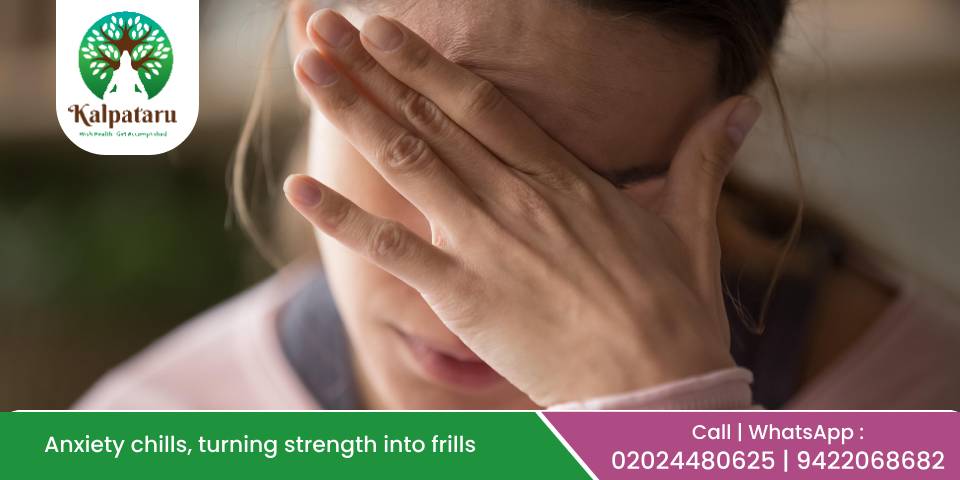
17Jan
Anxiety chills, turning strength into frills
Anxiety, a natural response to stress, can sometimes become an overwhelming and chronic condition, silently wreaking havoc on your physical and mental well-being. Beyond the emotional toll, anxiety profoundly impacts your body, weakening immunity, disrupting metabolism, accelerating aging, and increasing vulnerability to various diseases. Let's delve deeper into how this happens, including insights from Ayurveda, the ancient Indian science of life. Positive Stress (Eustress) and Its Benefits: Stress affects us based on how we perceive or interpret it. When stress is viewed positively—as a driving force for personality development, progress, or success—it becomes a beneficial type of stress known as eustress. This kind of stress does not harm the body and can be essential for achieving goals and personal growth. Therefore, the effects of stress—whether positive or negative—depend on how we respond to and perceive it, rather than its intensity or type. The Physiology of Anxiety: What Happens Inside? When you experience anxiety, your body activates the "fight-or-flight" response. This releases stress hormones like cortisol and adrenaline, preparing your body for immediate action. While this response is crucial in short bursts, chronic anxiety keeps your body in a state of heightened alertness, causing detrimental effects over time. Prolonged stress, or chronic stress, leads to increased levels of cortisol, the stress hormone. Elevated cortisol keeps the immune system in a constant state of alertness. While the immune system needs to remain vigilant during infections caused by bacteria, viruses, or fungi, excessive cortisol sends false signals, making the immune system overactive without a valid reason. This unnecessary over-alertness can exhaust the immune system. As a result, when an actual infection occurs, the immune system underperforms, and the body takes longer to recover. Chronic stress, therefore, weakens the body's natural defenses. The Role of Google and Its Impact on Anxiety: The widespread habit of searching for medical information on Google has become a significant contributor to increased anxiety. Many individuals compare their symptoms with online information, suspect severe illnesses, or question the accuracy of diagnoses and medications prescribed by doctors. While occasional use of Google for general information is acceptable, over-reliance on it can lead to unnecessary worry, misinterpretation of symptoms, and delays in recovery. It is important for patients to trust their doctors, follow their advice, and avoid self-diagnosis or second-guessing prescribed treatments. Impact on Immunity: Weakened Defense Mechanism: Prolonged anxiety suppresses the immune system, making it harder for your body to fight infections. Studies have shown that people with chronic stress are more susceptible to colds, flu, and other infections. Inflammation Overdrive: Anxiety triggers chronic inflammation, a key factor in autoimmune diseases like rheumatoid arthritis and inflammatory bowel disease. Ayurveda's Perspective: In Ayurveda, anxiety is linked to an imbalance in the Vata dosha, which governs movement and the nervous system. Imbalanced Vata weakens Ojas (the vital essence responsible for immunity), leaving the body vulnerable to diseases. Disruption of Metabolism: Stress and Digestive Health: Anxiety slows digestion by diverting blood flow away from the stomach, leading to issues like acid reflux, irritable bowel syndrome (IBS), and nutrient malabsorption. Weight Fluctuations: Anxiety can cause weight loss due to suppressed appetite or weight gain from stress eating, both of which disrupt metabolic balance. Ayurveda's Insight: Anxiety disrupts the Agni (digestive fire), a cornerstone of health in Ayurveda. Weak Agni leads to the accumulation of Ama (toxins), which hampers metabolism and overall vitality. Accelerated Aging: Oxidative Stress: Chronic anxiety increases the production of free radicals, damaging cells and accelerating the aging process. This is evident in premature wrinkles, graying hair, and other signs of aging. Telomere Shortening: Studies reveal that prolonged stress shortens telomeres, the protective caps on chromosomes, which directly correlates with faster biological aging. Ayurvedic Wisdom: Practices like Abhyanga (oil massage), Shirodhara (pouring oil on the forehead), and herbal remedies with Ashwagandha and Brahmi ,Jatamani,Jyotishmati can rejuvenate the body, slow aging, and calm the mind. Increased Susceptibility to Diseases: Cardiovascular Issues: Chronic anxiety raises blood pressure and heart rate, increasing the risk of hypertension, heart attacks, and strokes. Diabetes and Hormonal Imbalances: Anxiety-induced cortisol spikes can lead to insulin resistance, contributing to type 2 diabetes and hormonal disruptions. Mental Health Disorders: Anxiety often coexists with depression, insomnia, and other psychological disorders, creating a vicious cycle of declining health. Strategies to Combat Anxiety and Heal Holistically: Mindfulness and Meditation: Regular meditation reduces cortisol levels and calms the nervous system. Practices like Pranayama (breathing exercises) help balance the Vata dosha. Dietary Adjustments: Opt for a diet rich in antioxidants, omega-3 fatty acids, and whole grains. Ayurveda recommends warm, nourishing foods like soups and herbal teas to pacify Vata. Herbal Support: Ayurvedic herbs like Ashwagandha, Brahmi, and Tulsi are adaptogens that help the body resist stress and enhance overall resilience. Physical Activity: Regular exercise releases endorphins, reducing anxiety naturally. Yoga, in particular, integrates physical and mental well-being. Therapeutic Practices: Treatments like Shirodhara, Takra dhara, Nasya (nasal therapy), and Panchakarma (detoxification) help cleanse the body and calm the mind. Sleep Hygiene: Prioritize quality sleep to allow the body to repair itself. Ayurveda recommends a warm glass of milk with a pinch of nutmeg before bed. The Importance of Counseling in Anxiety Management: Counseling plays a critical role in managing anxiety. Modern medical care requires doctors to possess counseling skills because many patient complaints are classified as psychosomatic illnesses. These conditions often cannot be resolved with medication or treatment alone. Doctors must engage patients in meaningful conversations, identify underlying stresses or worries, provide reassurance, and guide them through effective counseling techniques. This approach helps patients feel supported and improves overall outcomes. Embrace Holistic Healing at Kalpataru Ayurvediya Chikitsalaya™: At Kalpataru Ayurvediya Chikitsalaya™, we believe that true wellness comes from addressing the root cause of health concerns, not just the symptoms. Stress, a common factor affecting physical and mental health, is often misunderstood. Our holistic Ayurvedic treatments are designed to help you manage stress effectively while strengthening your overall well-being. In today's fast-paced world, where misinformation and self-diagnosis often increase anxiety, trust the experts at Kalpataru Ayurvediya Chikitsalaya™. Let us guide you on a path to better health through authentic Ayurvedic practices, natural remedies, and compassionate care. Take the first step toward a stress-free, healthy life today. Visit Kalpataru Ayurvediya Chikitsalaya™, where ancient wisdom meets modern care. The Takeaway: Anxiety may start in the mind, but its effects permeate the entire body, turning strength into frills. Addressing anxiety requires a comprehensive approach, combining modern scientific insights with age-old Ayurvedic wisdom. By balancing your mind and body, you can protect your immunity, metabolism, and longevity, leading to a healthier and more fulfilling life. Adopt these strategies today to reclaim your strength and resilience against anxiety's chilling grip!
Read More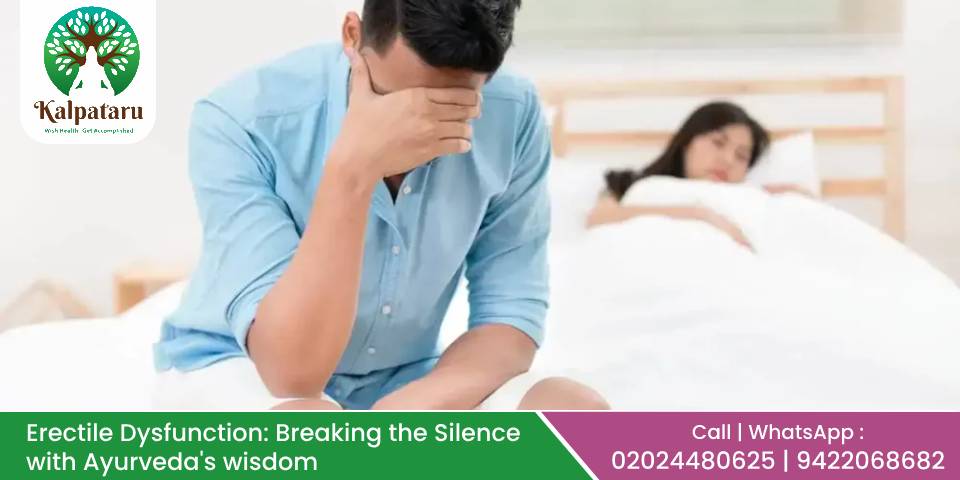
04Jan
Erectile Dysfunction: Breaking the Silence with Ayurveda’s wisdom
Erectile dysfunction (ED) is a topic many feel uncomfortable talking about, yet it's more common than you might think. Studies show that approximately 1 in 10 men will experience ED at some point in their lives. By the age of 40, around 40% of men report some degree of difficulty achieving or maintaining an erection, and this number rises to nearly 70% by age 70.Despite its prevalence, ED remains surrounded by myths and misunderstandings, often leading to unnecessary stress and feelings of isolation. It's important to remember that ED isn't just about physical health—it's also closely tied to mental well-being, relationships, and self-confidence.The good news is that understanding ED is the first step toward finding solutions. In this blog, we'll explore what ED is, its causes, and the best ways to address it with care ,confidence and Ayurvedic management. Let's break the silence and start a conversation that can help millions of men lead healthier, happier lives. What is Erectile Dysfunction? Erectile dysfunction occurs when a man consistently finds it difficult to achieve or sustain an erection. It can be a temporary issue or a chronic condition. Chronic ED can have a significant impact on self-esteem, relationships, and overall quality of life. Importantly, ED may also be an early indicator of underlying health problems such as cardiovascular disease. Key Causes of Erectile Dysfunction: Physical Health Issues: Cardiovascular Health: One of the most common causes of ED is poor heart health. When blood flow to the penis is restricted due to atherosclerosis (narrowing and hardening of arteries), it can lead to difficulties in achieving an erection. So,ED can often be an early warning sign of heart disease.Diabetes and Hypertension: Both conditions damage blood vessels and nerves, which are essential for erectile function.Neurological Disorders: Conditions like Alzheimer's disease, Parkinson's disease, stroke, or spinal injuries can impair nerve signals that facilitate erections.Hormonal Imbalances: Low testosterone levels or thyroid disorders can disrupt sexual function. Lifestyle Factors: Smoking: Smoking causes significant damage to blood vessels, including the penile arteries. This can worsen or cause ED.Cycling: Long-distance or professional cycling can lead to micro-traumas in the pelvic area, affecting nerves and blood flow, which can result in ED.Sleep Disorders: Poor sleep quality or conditions like sleep apnea can negatively impact erectile health. Psychological Factors: Stress, anxiety, depression, and relationship problems can interfere with the mental state necessary for sexual performance. Psychological issues often amplify the physical causes of ED. Surgical and Medication Side Effects: Surgical Procedures: Operations involving the bladder, rectum, or prostate can sometimes damage nerves involved in erectile function.Medications: Drugs for treating high blood pressure, depression, or other conditions can contribute to ED as a side effect. How Does an Erection Work? An erection is a complex physiological process that involves the nervous system, blood circulation, and muscle relaxation. Here's a step-by-step explanation:Arousal: Sexual arousal triggers the brain to send signals through the nervous system to the penis.Nitric Oxide Release: The nerves release nitric oxide (NO), which relaxes the smooth muscles in the penile blood vessels.Increased Blood Flow: The relaxation of these muscles allows blood to flow into the penis, filling the erectile tissues.Engorgement and Rigidity: The veins that drain blood from the penis are compressed, trapping the blood and maintaining the erection.Any disruption in this process, whether due to poor blood flow, nerve damage, or insufficient nitric oxide, can result in erectile dysfunction. Dietary Recommendations to Improve Erectile Health: Diet plays a crucial role in managing ED. Here are some food recommendations categorized for ease:Vegetarian Options:Fruits: Pomegranates, watermelons, and raisins (black) are known to enhance blood flow and boost nitric oxide levels.Nuts and Seeds: Almonds, pistachios, dried dates (khariks), and poppy seeds are rich in nutrients that support sexual health.Vegetables: Carrots and green leafy vegetables improve overall blood circulation.Spices: Nutmeg, cinnamon, cloves, cardamom, and saffron are natural aphrodisiacs.Non-Vegetarian Options:Lean meats and eggs provide essential proteins and nutrients that support hormonal balance.Dairy Products:Milk, paneer (cottage cheese), and yogurt are energy-boosting foods that can improve stamina.Have 10 grams of paneer with 1-2 cloves fried in ghee for two months helps reduce fatigue after intercourse. Lifestyle Changes to Address ED: Incorporating specific lifestyle changes can significantly improve erectile function:Regular ExerciseCardio Exercises: Activities like walking, running, and swimming improve heart health and blood circulation.Strength Training: Weightlifting helps boost testosterone levels.Yoga and Pelvic Exercises: Practices like butterfly pose, Kegel exercises, and Shashankasana strengthen pelvic muscles.Quit Smoking: Reducing or eliminating smoking improves vascular health and reduces arterial damage.Manage Stress: Techniques like mindfulness, meditation, and counseling can alleviate psychological barriers to sexual health.Sleep Well: Adequate and quality sleep is essential for hormone regulation and overall well-being. Ayurvedic Remedies for Erectile Dysfunction: Ayurveda offers time-tested remedies that address ED holistically:Herbal Solutions: Herbs like ashwagandha, gokhru, safed musli, shatavari, and kavach beej are known to enhance libido and improve erectile function.Oils for Local Application: Ayurvedic oils like Shri Gopal Taila and Narayan Taila can be applied locally to improve strength and stamina.Panchakarma Therapies: Treatments such as basti (medicated enema), uttarbasti, and abhyanga (oil massage) are highly effective when performed under expert supervision. For more information and treatment modalities watch our informative video https://www.youtube.com/watch?v=ebk8CLkoy94&t=13shttps://www.youtube.com/watch?v=RWFzZoPmRik&t=22shttps://www.youtube.com/watch?v=-34a86eVuS4&t=18shttps://www.youtube.com/watch?v=bMqtZwa2gBs&t=7s Ayurvedic herbal Groups for Sexual Wellness: Shukra Stambhaka (Retention): Enhances endurance and timing.Shukra Vardhana (Enhancement): Promotes vitality and energy. Boosting Nitric Oxide Naturally: Nitric oxide (NO) plays a vital role in relaxing blood vessels and improving blood flow to the penis. Foods that increase NO levels include:Green leafy vegetablesCitrus fruitsNuts and seedsPomegranatesGarlic Brief About Early Ejaculation: Early ejaculation is a condition distinct from erectile dysfunction. In many young men, over-masturbation or hypersensitivity in the penis, particularly around the glans (tip) and its nerves, performance anxiety can lead to early ejaculation. This sensitivity can cause ejaculation to occur quickly, often frustrating individuals experiencing it.This issue is widespread and, notably, about 4 to 5 out of 10 men begin experiencing early ejaculation concerns after the age of 40. For these cases, Ayurveda offers specific remedies and treatments aimed at improving control and performance.One effective approach is the use of the Shukra Sthambhak Gana, a group of herbs and formulations described in Ayurveda to support delayed ejaculation. For example:Haritaki: Known for its astringent taste, this herb helps improve control and longevity during sexual performance.Kuchala (Strychnos nux vomica): A powerful herb used in various formulations to address early ejaculation.Naga Bhasma: An Ayurvedic preparation beneficial in strengthening nerves and improving control.Pushpadhanva Rasa and Tapyaadi Loha: Classical formulations known to provide relief for such conditions.Chandraprabha Vati: A well-known Ayurvedic medicine that can be used based on individual complaints.When used appropriately under professional guidance, these remedies can effectively reduce symptoms of early ejaculation and improve sexual health. When to Seek Medical Help? If ED persists for more than three months, it's crucial to consult a healthcare provider. Temporary difficulties caused by stress or anxiety are common and should not immediately be labeled as ED. Consistent symptoms, however, may require medical evaluation and treatment. Erectile Dysfunction and Early Ejaculation Treatment at Kalpataru Ayurvediya Chikitsalaya™ At Kalpataru Ayurvediya Chikitsalaya™, we provide effective and holistic Ayurvedic treatment for erectile dysfunction and early ejaculation. Our specialized approach focuses on eliminating these embarrassing issues safely and naturally, ensuring lasting results.Key features of our treatment:Safe for All Ages: Suitable for men across all age groups.Natural Healing: Root-cause-focused Ayurvedic remedies for sustainable wellness.Proven Results: Our "Shukra-Janan, Vyavaysamarthya Vardhak Ayurvedic Aphrodisiac Treatment" has been tested on thousands of patients with remarkable success.Take the first step towards revitalized health and confidence today! Conclusion: Erectile dysfunction is a multifaceted condition influenced by physical, psychological, and lifestyle factors. By addressing these underlying causes and adopting natural remedies, men can effectively manage ED. Incorporating dietary changes, exercising regularly, and exploring Ayurvedic treatments can lead to improved sexual health and overall well-being. If symptoms persist, professional guidance is essential to ensure a comprehensive approach to treatment.
Read More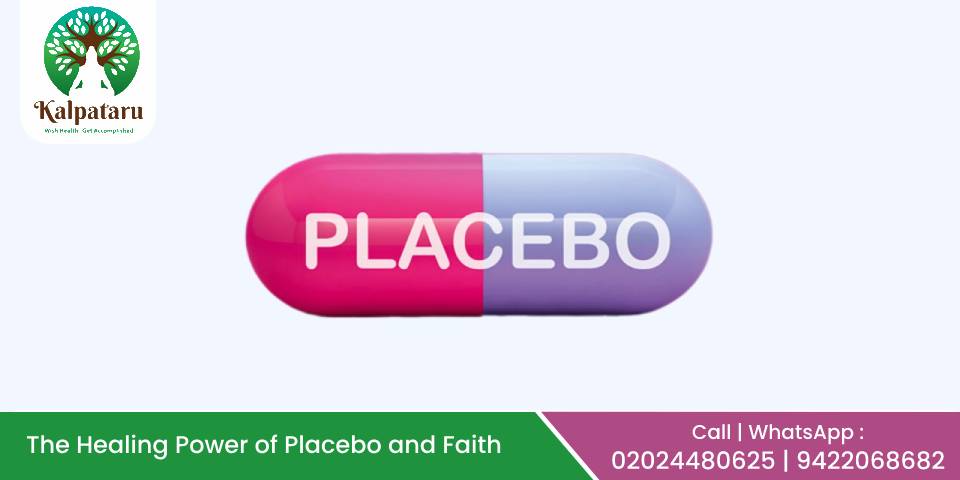
30Dec
The Healing Power of Placebo and Faith
The connection between the mind and body is truly amazing. One fascinating example of this is the placebo effect, where belief and faith can help in the healing process. Let's explore the science, history, and cultural significance of the placebo effect and its Ayurvedic connections. What is Placebo? A placebo is a treatment or substance that doesn't have any actual medicine in it but can still make a person feel better. In medicine, placebos are often used to compare real medicines with fake treatments to see how much of the healing comes from the medicine itself and how much comes from belief. Placebo in Ayurveda: Daiva Vyapashraya Chikitsa In Ayurveda, there is a similar idea called Daiva Vyapashraya Chikitsa, which means "spiritual or divine therapy." This method is used when other treatments don't work. It involves practices like chanting, worship, wearing gemstones, or doing rituals to increase the patient's mental strength and belief in recovery. This belief often helps patients feel better and heal faster. A Historical Example: Placebo in World War II: During World War II, injured soldiers were given morphine injections to ease their pain. But one time, the morphine ran out. A smart doctor used a saline solution instead and told the soldiers it was morphine itself. Surprisingly, 40-50% of them felt relief. This shows how trust and belief can change how we feel. How Placebo Works? Studies show that about 35% of patients get better just by believing in their treatment. Placebos have helped in treating:AsthmaParkinson's DiseaseDepressionMigrainesIrritable Bowel Syndrome (IBS)Chronic PainBack PainSkin diseases and so many ailments.When people believe in a treatment, the brain releases special chemicals that help the body heal. These chemicals improve the immune system, balance hormones, and promote recovery. Interesting Medical Trials: One study on knee surgery for osteoarthritis divided patients into two groups. One group had real surgery, while the other group only had a small cut on their knee without any surgery. Both groups felt almost same level of pain relief and improved movement. Some patients who couldn't walk properly before started walking without help even after fake surgery. This shows the power of belief in healing. Hypnosis and Placebo: Another example of the mind's power is seen in hypnosis. In one experiment, a person was hypnotized and told they were being burned with a cigarette, even though only a finger touched their skin. Afterward, a blister appeared as if they had been burned. This proves how deeply the mind can influence the body. Psycho-Neuro-Immunology: This new field studies how our thoughts and emotions affect our immune system and hormones. Positive thinking and strong belief can make the body healthier, reduce inflammation, and speed up healing. Spiritual Belief and Health: Having strong spiritual beliefs also helps mental and physical health. Studies show that people with faith are less likely to feel depressed or anxious. Brain scans reveal that spiritual people have thicker brain areas ( like hypothalamus) that protect them from stress and mental illnesses( Reduced Amygdala in size) . Faith gives hope and strength, which supports both the mind and body. Modern Applications of the Placebo Effect: Doctors today use placebos in various ways to help patients. For example, in some cases of chronic pain, doctors prescribe sugar pills while explaining their potential benefits. Patients often report significant improvements because they trust their doctor and believe in the treatment. Similarly, many wellness programs emphasize positive affirmations and visualization techniques, which leverage the placebo effect to boost recovery and mental health. The Role of Mindfulness and Meditation: Practices like mindfulness and meditation also tap into the power of the mind. By focusing on positive thoughts and reducing stress, these practices enhance the body's natural healing processes. They align closely with the placebo effect, as both depend on the belief that the mind can influence the body's health. Lessons from Traditional Healing Practices: In many traditional cultures, healers use rituals and ceremonies to inspire faith and hope in their patients. These practices often work not just because of the remedies but because they create a strong sense of belief and emotional support. Such approaches highlight the universal role of faith and mental strength in healing. Conclusion: The placebo effect shows how powerful belief and faith can be in healing. Whether it's through modern medicine or Ayurveda's Daiva Vyapashraya Chikitsa, the mind plays a huge role in recovery. Combining mental strength with medical treatments could transform healthcare. The power of belief isn't just in our heads—it's a real force for healing and transformation.By understanding and using the placebo effect, we can unlock new ways to improve health and well-being. It reminds us that healing is not just about the body; it's also about the strength and resilience of the human spirit.Dr. Manoj Deshpande and Dr. Aparna Deshpande at Kalpataru Ayurvediya Chikitsalaya™ Clinic provide the best Ayurvedic Treatment for Psoriasis & various diseases in Pune, Maharashtra. For more information about our comprehensive treatment options, or to requestan appointment with the best Ayurvedic Doctor in Pune, call +919422068682 / +919764837167 / 020-24480625 or Click on Book an Appointment.
Read More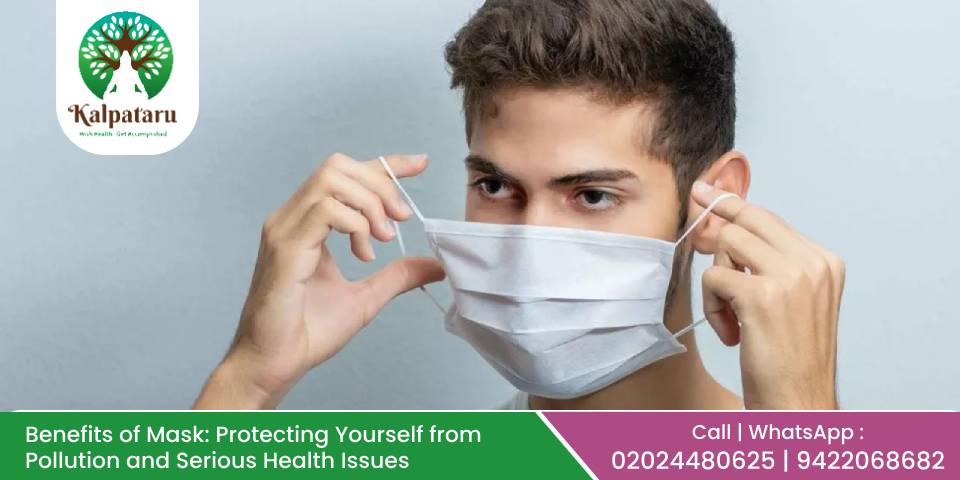
20Dec
Benefits of Mask: Protecting Yourself from Pollution and Serious Health Issues
Wearing a mask is something we can do to protect ourselves and others — but it's not limited to the COVID-19 pandemic; wearing a mask year-round has many health benefits. While many people focus on protecting against airborne viruses, there are additional important reasons to wear masks that are often overlooked. India faces a significant burden of tuberculosis (TB) cases, partly due to the dense population in urban areas. To prevent respiratory infections, the use of masks has proven to be highly beneficial. During the COVID-19 pandemic, it was observed that the use of masks not only curbed the spread of COVID-19 but also significantly reduced the number of tuberculosis cases. Types of Masks: Surgical Masks: These masks are mainly designed to protect others from respiratory droplets that we may release when speaking, coughing, or sneezing. They are typically used in clinical settings to prevent the spread of infections, but they also help filter out larger airborne particles, including dust and pollen. N95 and N99 Masks: N95 and N99 masks are more specialized and offer a higher level of protection. They filter out at least 95% (N95) or 99% (N99) of airborne particles, including bacteria, viruses, and fine particulate matter such as dust, smoke, and pollution. These masks are required in high-risk environments such as healthcare settings or during high pollution periods. Cloth Masks: Cloth masks offer a simple and sustainable option for daily use. They are effective in preventing larger droplets from reaching others and provide a level of protection against pollution. Multiple layers of fabric can improve their efficacy in filtering pollutants. Benefits of Masks: Masks have become a crucial tool in protecting ourselves and others from the spread of infectious diseases, including COVID-19. Here are the key benefits of wearing masks: Prevention of Virus Transmission: Masks help reduce the transmission of respiratory droplets that can include viruses when an infected person coughs, sneezes, or talks. Protection for the Wearer: Wearing a mask can protect the wearer from inhaling toxic particles, including viruses and bacteria, especially in crowded places. Community Safety: Masks contribute to the overall safety of communities by preventing outbreaks and helping maintain public health. Prevents the Spread of Germs: Masks act as a barrier to control respiratory droplets from reaching others, reducing the spread of viruses and bacteria. Reduces the Risk of Infection: Masks provide an additional layer of defense against airborne particles, helping to lower the chance of infection in crowded or high-risk environments. Enhanced Hygiene: Masks serve as a reminder to practice good hygiene, such as frequent handwashing and social distancing. Protection Against Pollution: Masks offer a layer of protection against harmful pollutants, allergens, and particulate matter present in the air. This is especially beneficial in urban areas with high pollution levels, helping to lower respiratory issues and protect against conditions like asthma and bronchitis. Effects of Pollution On Our Health: Pollution, including smoke, dust, chemicals, and allergens, has severe effects on health. It can irritate the eyes, nose, and throat, leading to discomfort and health problems such as: Respiratory problems: Pollutants like PM2.5 particles can penetrate the lungs and even enter the bloodstream, causing chronic respiratory conditions such as asthma and bronchitis. Cardiovascular diseases: Prolonged exposure to polluted air raises the risk of heart attacks and strokes by damaging blood vessels. Skin issues: Pollution can cause skin allergies, early aging, and other dermatological problems. Digestive Issues: Inhalation of polluted air can also affect the digestive system, causing issues like indigestion and acid reflux. Cognitive Impairment: Studies have shown that long-term exposure to pollution can impact cognitive function and improve the risk of neurodegenerative diseases. How Pollution Can Be Avoided? For school-going children who are prone to respiratory illnesses, parents and schools should encourage the regular use of masks. This simple practice can greatly reduce the risk of infections and provide much-needed relief to children suffering from chronic respiratory conditions. To avoid these health risks, consider the following tips: Use appropriate masks: Depending on your environment, choose an N95, N99, or a cloth mask to filter out harmful particles. Limit outdoor activities during peak pollution hours: Particularly in areas with heavy traffic or industrial activities. Keep indoors clean: Regularly clean indoor areas to reduce the accumulation of dust and allergens. Diet and lifestyle: An Ayurvedic approach involves consuming a balanced diet rich in antioxidants and anti-inflammatory foods to boost immunity and purify the body of toxins. Stay Hydrated: Drinking sufficient quantity of water aids flush out toxins from the body, helping in the reduction of pollution effects. How to Choose the Right Mask? For daily use: A cloth mask is sufficient if you're in an area with moderate pollution. But beware — it has limitations, and you should not rely solely on it for high exposure. For high-risk environments: N95 masks are a better option for protection against fine particulate matter and toxic gases. For specific needs: Surgical masks can be used in controlled environments for limited periods, or coupled with other preventive measures such as hygiene of hands and physical distancing. Such simple measures, like wearing a mask, can effectively reduce the recurrence of infections caused by pollution. This can, in turn, minimize the need for prolonged antibiotic treatments. Masks serve as a practical and low-cost solution for managing pollution-related respiratory conditions, ensuring better health and fewer complications. Importance for Outdoor Workers: For individuals who work on the road—drivers, passengers, traffic police,delivery personnel, and construction workers—wearing a mask is essential. These professionals are regularly exposed to high levels of pollution. They need a mask that offers robust protection against pollutants and particulate matter. An N95 or N99 mask is highly recommended, as it provides maximum filtration efficiency. Additionally, cloth masks can be used as a supplementary protective measure to boost respiratory health and overall well-being. A Case Study: Allergic Rhinitis and Mask Use One notable experience highlights the importance of masks. A patient had been suffering from allergic rhinitis for 5–10 years without finding relief. Ayurvedic medications were prescribed along with a recommendation to use a mask regularly. After some time, the patient returned to the clinic, accompanied by another patient. When asked about his condition, he happily reported feeling completely cured. He credited regular mask use for alleviating his persistent allergy symptoms. By understanding the benefits of different types of masks and taking steps to minimize exposure to pollution, we can protect ourselves from serious health problems and ensure a healthier lifestyle, no matter how good we eat and drink. For more information on how to protect yourself from pollution and the benefits of Ayurvedic treatments in enhancing your body's natural defenses, visit Dr. Manoj Deshpande at Kalpataru Ayurvediya Chikitsalaya™ today.
Read More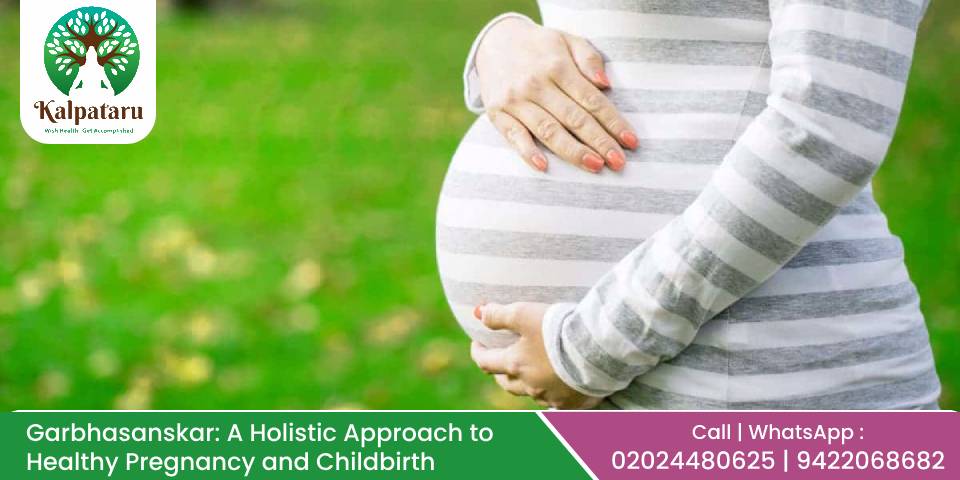
07Dec
Garbhasanskar: A Holistic Approach to Healthy Pregnancy and Childbirth
We often hear that children inherit traits from their parents' genes, meaning their personality, intelligence, and physical traits depending on genetics. While this was the old belief, modern science now focuses on epigenetics, which shows that genetic inheritance is not that much fixed . Although a child receives genes from their parents, how these genes work can change based on the environment. This means that surroundings, experiences, and conditions during pregnancy can influence how a child's genes are expressed. What is Garbhasanskar? Garbhasanskar is an Ayurvedic practice rooted in the belief that a baby's mental and emotional development begins in the womb. According to Ayurveda, a mother's thoughts, emotions, diet, and environment during pregnancy profoundly influence the baby's overall growth. The Importance of Garbhasanskar: This is where garbhasanskar (prenatal education) becomes significant. Epigenetics supports what Ayurveda has said for centuries—that the environment and care given to a baby in the womb can shape its physical, mental, and intellectual development. Ancient scholars and Ayurvedic doctors understood the importance of nurturing the child during pregnancy, long before modern scientific tools existed. They knew that a baby starts developing in the womb, and positive actions during this time can lead to healthier and smarter children. Today, modern science confirms this. Planning Pregnancy the Right Way: Ayurveda stresses that pregnancy should never be accidental. It should be planned when both parents are physically and mentally healthy. When a child is conceived with love, trust, and mutual respect between the parents, the child is more likely to inherit positive traits. Even modern science agrees with this. How the Mother's Condition Affects the Baby? Research shows that everything a mother does during pregnancy—her thoughts, actions, and feelings—affects the baby. With advanced tools like 3D sonography, scientists have observed how a baby's growth and responses change based on the mother's environment and emotions. If a mother experiences stress, anger, or sadness during pregnancy, it releases stress hormones like cortisol in her body. These hormones can cross the placenta and reach the baby, affecting the baby's brain development. This might result in conditions like anxiety, depression, autism, or even schizophrenia in the future. It shows how a mother's emotional state has a long-term impact on the child. Pregnancy care should go beyond taking vitamins, calcium, and doing regular health checkups. Along with antenatal care (ANC), practices like garbhasanskar and conscious parenting are equally important for the baby's overall development. Scientific Studies on Stress and Baby's Growth: Studies reveal that if a mother is stressed during pregnancy, it can affect the baby's forebrain, the part of the brain responsible for memory, intelligence, and logical thinking. High cortisol levels in the mother can also harm the baby's kidneys, showing how crucial proper care is needed during this period. Books like "Life in the Womb" explain how babies born underweight (less than 5 pounds) are at a higher risk of heart problems later in life. This emphasizes the importance of proper care during pregnancy to ensure the baby's healthy growth and weight. Intelligence and Parenting: While earlier it was believed that intelligence only depends on genetics, new research shows that 51% of intelligence depends on the environment. This means that good parenting, a healthy environment, and proper care can improve a child's intelligence. Even if parents are of average intelligence, they can raise a smart and capable child through proper parenting. Let us explore the concept, benefits, and practices of Garbhasanskar in detail. Garbhasanskar and Ayurveda: If parents want their child to grow up smarter, healthier, and more joyful, they should consider garbhasanskar therapy under expert guidance, especially from Ayurvedic specialists. Ayurveda provides not only counseling but also specific treatments that support the child's physical and mental development. One such Ayurvedic concept is Masanumasik Chikitsa (monthly therapy), which focuses on the sequential formation of bodily tissues like rasa, rakta, mamsa, med, asthi, majja, shukra and Ojas during pregnancy. By providing the right guidance and treatments at every stage, each tissue can develop optimally, ensuring a strong foundation for the baby's body and mind. At Kalpataru Ayurvediya Chikitsalaya™, we have successfully implemented garbhasanskar therapy for hundreds of couples. Our experience confirms that it leads to healthier physical, mental, and intellectual growth in children, alongside improved immunity. Thus, the practice of garbhasanskar is invaluable for shaping the future of a child, ensuring they grow into intelligent, healthy, and happy individuals. The practice involves: Prenatal care focusing on nutrition and health. Spiritual activities like meditation and chanting. Emotional connection through music, positive thoughts, and storytelling. Lifestyle modifications to ensure holistic development. The Science Behind Garbhasanskar: Modern science supports many aspects of Garbhasanskar. Studies have shown that a baby in the womb responds to external stimuli, including sounds, emotions, and maternal stress levels. In Indian mythology we come across the story of Abhimanyu learning the techniques of entering the chakravyuh. It might sound unrealistic. But modern research supports this kind of geststional knowledge gaining. A nurturing and positive environment during pregnancy can lead to: Improved brain development. Emotional stability in the child. A stronger bond between mother and baby. For instance, calming music and chanting help in stimulating the baby's auditory senses, while a balanced diet aids in proper physical development. Key Practices of Garbhasanskar: Balanced Diet and Nutrition: A healthy and nutritious diet forms the cornerstone of Garbhasanskar. Foods rich in vitamins, minerals, and proteins are essential for fetal growth. Ayurveda emphasizes the inclusion of: Milk and ghee for strength. Seasonal fruits for vitamins. Whole grains for energy. Spices like turmeric and cumin for digestion and immunity. Positive Thinking and Emotional Well-being: The mother's thoughts and emotions significantly impact the baby. Garbhasanskar advocates: Reading uplifting literature. Practicing gratitude. Avoiding negative news or stressful situations. Meditation and Yoga: Yoga and meditation ensure physical fitness, reduce stress, and help connect with the unborn baby. Prenatal yoga improves flexibility and reduces pregnancy discomfort. Meditation fosters mental peace and a deeper bond with the baby. Chanting and Mantras: Chanting Sanskrit shlokas or mantras, such as the Gayatri Mantra, Vishnu Sahasranam, Ramraksha, Hanuman stotra are believed to create a calming and positive vibration around the baby. Music Therapy: Listening to soothing music or classical ragas can stimulate the baby's auditory senses and enhance brain development. Storytelling: Reading moral stories or reciting mythological tales helps instill values and virtues in the unborn child. Ayurvedic Remedies: Ayurveda recommends specific herbal formulations to improve digestion, boost immunity, and ensure the baby's overall well-being. Consult an Ayurvedic practitioner for personalized remedies. Benefits of Garbhasanskar: Holistic Development of the Baby: Better cognitive and emotional abilities. Strong immunity and overall health. Healthy Pregnancy for the Mother: Reduced stress and anxiety. Lesser complications during childbirth. Strengthened Mother-Child Bond: Creates a loving and secure environment for the baby. Cultural and Spiritual Growth: Preserves ancient Indian traditions. Promotes a spiritual approach to pregnancy. Modern Adaptations of Garbhasanskar: Today, many prenatal programs incorporate elements of Garbhasanskar, combining traditional practices with scientific knowledge. Workshops and online courses are available to guide expectant mothers. Conclusion: Garbhasanskar is more than a set of rituals; it is a holistic lifestyle for expectant mothers. By nurturing the mind, body, and soul during pregnancy, it lays the foundation for the baby's health, happiness, and character. Embracing these timeless principles can transform pregnancy into a sacred and enriching experience. At Kalpataru Ayurvediya Chikitsalaya™, we specialize in providing personalized Garbhasanskar programs rooted in Ayurvedic wisdom. With over 25 years of expertise, our holistic approach ensures expectant mothers receive the care, guidance, and support needed for a healthy and joyous pregnancy journey. Visit us to learn more about how Garbhasanskar can enrich your experience and nurture your baby's well-being right from the womb.
Read More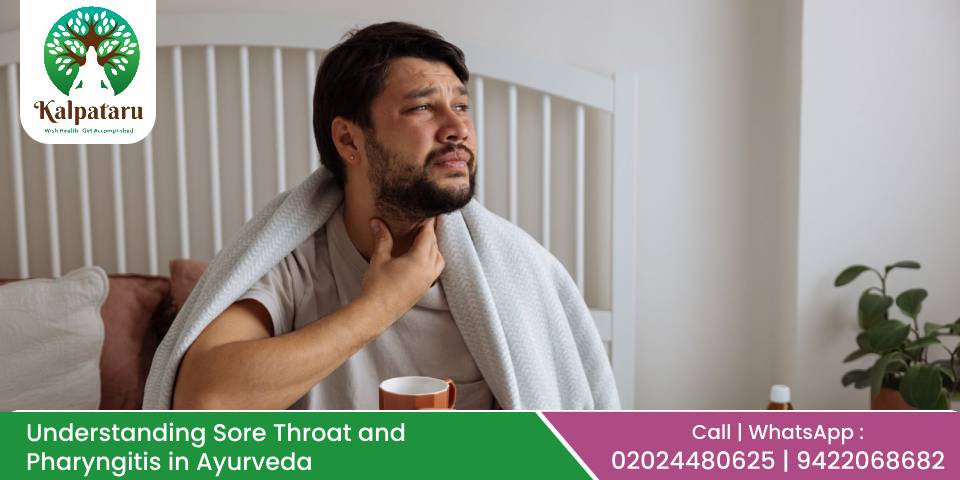
02Dec
Understanding Sore Throat and Pharyngitis in Ayurveda
In Ayurveda, the throat is considered a significant site for Kapha dosha, which governs mucus production, and Pitta dosha, which controls inflammation and metabolism. Imbalances in these doshas can lead to conditions like a sore throat and pharyngitis. Dosha-Specific Symptoms: Vata Imbalance: Dryness, scratchiness, and a hoarse voice.Pitta Imbalance: Burning sensation, redness, and inflammation.Kapha Imbalance: Mucus accumulation, swelling, and congestion.The goal of Ayurvedic treatment is to restore balance among these doshas and strengthen the immune system for long-term wellness. Causes of Sore Throat and Pharyngitis: Environmental Factors: Exposure to cold winds, dry air, or pollutants.Dietary Indulgence: Consumption of excessively cold, fried, or spicy foods that aggravate doshas.Seasonal Changes: Kapha imbalances are common during winter, while Pitta imbalances often occur during summer or with excess heat exposure.Viral and Bacterial Infections: While Ayurveda does not directly address pathogens, it focuses on enhancing immunity to prevent infections.Lifestyle Habits: Smoking, excessive talking, or overuse of vocal cords can irritate the throat. Modern Medical Treatment Options: For Viral Infections:Supportive care: Rest, hydration, and over-the-counter pain relievers like acetaminophen.Warm saltwater gargles to reduce swelling and irritation.For Bacterial Infections:Antibiotics such as penicillin or amoxicillin for strep throat.Anti-inflammatory medications for pain relief.For GERD-related Sore Throat:Antacids and lifestyle changes like avoiding acidic foods and eating smaller meals.Chronic Pharyngitis:Avoiding triggers such as smoking or chemical fumes.Treating underlying causes like allergies or sinus infections. Ayurvedic Remedies for Sore Throat and Pharyngitis: Herbal Remedies: Tulsi (Holy Basil): Tulsi is a powerful antimicrobial herb. Chewing fresh tulsi leaves or drinking tulsi tea helps soothe throat irritation and boosts immunity.Turmeric (Haridra): Known for its anti-inflammatory and antiseptic properties, turmeric can be used in warm milk or as a gargle (turmeric and salt in warm water).Mulethi (Licorice Root): Mulethi is renowned for its soothing and demulcent properties. Sucking on licorice lozenges or boiling mulethi in water for tea relieves throat pain.Ginger (Adraka): Ginger is a potent anti-inflammatory and immune-boosting herb. Drinking ginger tea with honey is highly effective for reducing throat inflammation.Clove (Lavanga): Cloves have a numbing effect and antimicrobial properties. Sucking on a clove or using clove oil in warm water for gargling provides quick relief. Ayurvedic Therapies: Kavala or Gandusha (Oil Pulling): Gargling with warm herbal decorations help lubricate the throat, reduce dryness, and remove toxins.Pratimarsha Nasya: Applying medicated oils like Anu Taila to the nasal passages clears Kapha and improves respiratory health, indirectly relieving throat issues.Steam Inhalation: Adding eucalyptus oil, tulsi, or mint leaves to boiling water and inhaling the steam clears congestion and reduces Kapha accumulation. Dietary Adjustments: Consume warm, soothing foods like soups, khichdi, and herbal teas.Avoid cold, sour, and processed foods that aggravate Kapha and Pitta.Drink warm water throughout the day to maintain hydration and ease throat discomfort.Include spices like cinnamon, black pepper, and turmeric in your meals for their therapeutic effects. Lifestyle Modifications: Protect the throat from cold air by wearing scarves or using warm beverages.Practice pranayama (breathing exercises) like Anulom Vilom to enhance respiratory function.Maintain oral hygiene by gargling with saline or herbal decoctions. Ayurvedic Preventive Measures: Daily Practices: Use turmeric and black pepper in your daily cooking to maintain throat health.Practice oil pulling with sesame oil every morning to keep the throat lubricated and reduce toxin buildup. Ritucharya (Seasonal Regimens): Follow Ayurvedic seasonal routines to minimize dosha imbalances. For instance, consume warm and Kapha-reducing foods during winter. Boost Immunity (Ojas Building): Drink Chyawanprash (an Ayurvedic herbal jam) to strengthen immunity.Include Amla (Indian gooseberry) in your diet for its high Vitamin C content. Avoid Triggers: Limit exposure to allergens, pollutants, and irritants that may cause throat irritation.If you are suffering from pharyngitis on recurrent basis, then consulting ayurvedic physician is always a good option. By means thorough history taking and trying herbal medicines which boost immnubity , you can get rid of recurrent pharyngitis issue Conclusion: Ayurveda offers a comprehensive and natural approach to managing sore throat and pharyngitis by addressing their root causes through dosha balancing. Herbal remedies, dietary modifications, and Ayurvedic therapies not only alleviate symptoms but also promote long-term throat health.For severe or recurring throat issues, consulting a qualified Ayurvedic practitioner can help personalize treatments based on your unique dosha constitution. Embracing Ayurveda ensures not just symptomatic relief but also holistic well-being, aligning your body with nature's rhythms.Dr. Manoj Deshpande and Dr. Aparna Deshpande at Kalpataru Ayurvediya Chikitsalaya™ Clinic provide the best Ayurvedic Treatment for Psoriasis & various diseases in Pune, Maharashtra. For more information about our comprehensive treatment options, or to requestan appointment with the best Ayurvedic Doctor in Pune, call +919422068682 / +919764837167 / 020-24480625 or Click on Book an Appointment.Stay natural, stay healthy!
Read More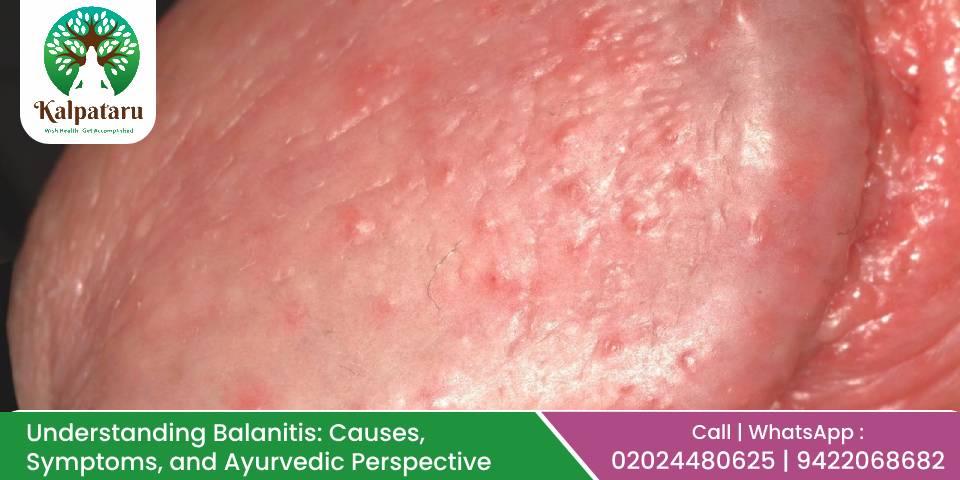
25Nov
Understanding Balanitis: Causes, Symptoms, and Ayurvedic Perspective
Balanitis is a medical condition characterized by inflammation of the glans penis, often accompanied by redness, swelling, and discomfort. While commonly affecting uncircumcised males, it can occur in anyone with a penis. This blog explores the causes, symptoms, treatment options, and how Ayurveda provides a unique perspective on managing balanitis. What is Balanitis? The term "balanitis" comes from the Greek word balanos, meaning "acorn," which refers to the shape of the glans penis. This condition is not only uncomfortable but can sometimes lead to complications if untreated. Causes of Balanitis: Several factors contribute to balanitis, including:Poor Hygiene: Accumulation of smegma (a combination of shed skin cells, oils, and moisture) can lead to irritation and infection.Infections:Bacterial: Staphylococcus or Streptococcus species.Fungal: Candida albicans is a common culprit.Viral: Herpes simplex virus in some cases.Allergic Reactions: Reaction to soaps, detergents, or latex condoms.Irritation: Use of scented hygiene products or tight-fitting clothing.Underlying Medical Conditions: Diabetes mellitus (increases the risk of fungal infections).Autoimmune disorders. Symptoms of Balanitis: Redness and swelling of the glans penis.Pain or discomfort, especially during urination or sexual activity.Foul-smelling discharge.Itching or burning sensation.Difficulty retracting the foreskin in severe cases (phimosis). Conventional Treatments for Balanitis: Treatment depends on the cause: Hygiene: Regular cleaning with warm water and gentle soap. Topical Medications: Antifungal creams (e.g., clotrimazole) for fungal infections. Antibiotics for bacterial infections. Corticosteroid creams for inflammation if not responding to conventional treatment. Avoiding Irritants: Discontinuing use of scented products, soaps or allergenic materials. Managing Underlying Conditions: Controlling blood sugar in diabetic patients. Ayurvedic Perspective on Balanitis: In Ayurveda, balanitis can be understood as a condition caused by an imbalance in the kaf and Pitta Dosha, which governs fluid balance, heat and inflammation in the body. The aggravated Pitta, along with Kapha Dosha (responsible for moisture and accumulation), can lead to symptoms akin to balanitis. Ayurvedic Causes and Pathogenesis: Dietary Factors: Excess consumption of spicy, acidic, or salty foods aggravates Pitta Dosha.Lifestyle Factors: Poor hygiene, lack of cleanliness, eating food items agreveting kaf dosh such as dairy products, sugary food,and excessive sweating contribute to Kapha imbalance.Infections: Could be linked to Krimi (microbial pathogens) in Ayurveda. Ayurvedic Management of Balanitis: Herbal Remedies:Neem (Azadirachta indica): Known for its antibacterial and antifungal properties. Neem paste or decoction can be applied locally.Turmeric (Curcuma longa): A natural anti-inflammatory and antimicrobial. A paste made with turmeric and water can soothe irritation.Aloe Vera (Kumari): Provides a cooling effect and reduces inflammation.Dietary Recommendations:Include cooling foods like cucumber, watermelon, and coconut water to pacify Pitta.Avoid spicy, salty, and fermented foods that exacerbate heat.Detoxification: Panchakarma therapies like Virechana (purgation) may be recommended to eliminate excess Pitta.Hygiene and Local Applications:Wash the affected area with decoctions of Triphala or Vetiver (Ushira) to cleanse and soothe the glans.Avgah chiktsa- immersing penis in a medicated decoration prepared by using some herbs like Vara gives very quick relief from balanitis.Creams - various ayurvedic creams prepared with purified sulfer have great role in Ayurveda regarding cure of balanitisUse herbal oils like Jatyadi Taila for wound healing and infection prevention.Internal Medications:Herbs like Guduchi (Tinospora cordifolia) and Manjistha (Rubia cordifolia) to purify the blood and reduce inflammation.Chandraprabha Vati, trivang bhasms for managing infections and maintaining urinary tract health. Lifestyle Modifications in Ayurveda: Maintain proper hygiene, especially after urination or sexual activity.Wear loose, breathable clothing made of natural fabrics like cotton.Avoid excessive heat and sweating, as it aggravates Pitta Dosha. When to Consult a Doctor? While mild cases of balanitis may resolve with improved hygiene, persistent or severe symptoms require medical attention. Delayed treatment can lead to complications like:Phimosis.Recurrent infections.Scarring. Conclusion: Balanitis, though a common condition, can be effectively managed with proper care. Ayurveda offers a holistic approach by addressing the root causes, pacifying dosha imbalances, and promoting long-term health. Combining Ayurvedic remedies with modern hygiene practices can lead to quicker recovery and prevent recurrences.In Kalpataru Ayurvediya Chikitsalaya™ so many patients of chronic recurrent balanitis patients have been cured who were otherwise advised to undergo circumcision surgery.Dr. Manoj Deshpande and Dr. Aparna Deshpande at Kalpataru Ayurvediya Chikitsalaya™ Clinic provide the best Ayurvedic Treatment for Psoriasis & various diseases in Pune, Maharashtra. For more information about our comprehensive treatment options, or to requestan appointment with the best Ayurvedic Doctor in Pune, call +919422068682 / +919764837167 / 020-24480625 or Click on Book an Appointment.
Read More
19Nov
Shunthi (Dried Ginger): Your Natural Remedy for Wellness and Vitality
Shunthi, also known as dried ginger, holds a significant place in Ayurvedic medicine and traditional health practices. Derived by drying fresh ginger, Shunthi concentrates the potent bioactive compounds of ginger, such as gingerol, shogaol, and zingerone. Revered for its therapeutic properties, Shunthi has been a trusted remedy in Ayurveda for centuries to balance the doshas and promote holistic wellness. Ayurvedic Properties of Shunthi: In Ayurveda, Shunthi is known for its unique combination of qualities:Rasa (Taste): Katu (Pungent)Guna (Qualities): Laghu (Light), Snigdha (Unctuous)Virya (Potency): Ushna (Hot)Vipaka (Post-digestive Effect): Madhura (Sweet)These properties make Shunthi particularly effective in balancing Vata and Kapha doshas, while moderately increasing Pitta. Health Benefits of Shunthi: Digestive Health: Shunthi is a powerful digestive aid that stimulates appetite, reduces bloating, and alleviates indigestion. Its carminative properties help in expelling gas and relieving indigestion. Shunthi tea is often recommended for improving gut health.Anti-inflammatory Properties: The active compounds in Shunthi, particularly gingerols and shogaols, have potent anti-inflammatory effects. It is highly effective in managing joint pain, arthritis, and other inflammatory conditions.Respiratory Wellness: Shunthi acts as a natural decongestant and expectorant. It is widely used in treating coughs, colds, and asthma by clearing mucus and soothing inflamed airways.Boosts Immunity: Rich in antioxidants, Shunthi strengthens the immune system and helps the body fight off infections. Its antimicrobial properties are particularly useful in preventing seasonal illnesses.Pain Relief: Shunthi is a natural analgesic and is effective in managing headaches, menstrual pain, and muscle soreness. Its heating qualities help in soothing discomfort.Metabolic Support: Shunthi is known to enhance metabolism, promoting better nutrient absorption and fat digestion. It is often used in Ayurvedic weight management regimens.Cardiovascular Health: Dried ginger helps in reducing cholesterol levels, improving blood circulation, and preventing clot formation, thereby supporting heart health.Regulation of Blood Sugar: Shunthi has been found to regulate blood sugar levels, making it beneficial for individuals with diabetes. It enhances insulin sensitivity and aids in managing glycemic control. Ayurvedic Remedies with Shunthi: For Digestive Issues: Mix 1/4 teaspoon of Shunthi powder with warm water and a pinch of rock salt. Consume after meals for better digestion.For Respiratory Health: Prepare a decoction with Shunthi, Tulsi leaves, and honey to alleviate cough and cold.For Joint Pain: Apply a paste of Shunthi powder mixed with warm sesame oil on affected areas to reduce pain and inflammation.For Weight Loss: Drink warm water infused with Shunthi, lemon, and honey in the morning to boost metabolism and aid fat burning.For Menstrual Pain: A cup of Shunthi tea can help ease cramps and regulate menstrual flow. Incorporating Shunthi in Daily Life: Shunthi can be easily added to your daily diet. Use it as a spice in soups, teas, or curries to enhance flavor and nutritional value. Shunthi powder can also be consumed as a supplement, but always consult an Ayurvedic practitioner for personalized advice. Precautions and Contraindications: While Shunthi is generally safe, it is important to keep the following in mind:Avoid excessive use if you have high Pitta-related conditions like hyperacidity.Pregnant and lactating women should consult a healthcare provider before consuming large quantities.People on blood-thinning medications should use Shunthi cautiously. Conclusion: Shunthi is truly a marvel of Ayurveda, offering a natural and effective way to address numerous health concerns. From enhancing digestion to boosting immunity and supporting cardiovascular health, its benefits are vast and well-documented. Incorporating this versatile herb into your daily routine can pave the way for improved health and well-being. Always remember, balance and moderation are key to reaping the best benefits of Ayurvedic herbs like Shunthi. Due to this diversified usage of Shunthi it is called as "Mahaushadhi" in AyurvedaEmbrace the power of Shunthi for a healthier, more vibrant life!Dr. Manoj Deshpande and Dr. Aparna Deshpande at Kalpataru Ayurvediya Chikitsalaya™ Clinic provide the best Ayurvedic Treatment for Psoriasis & various diseases in Pune, Maharashtra. For more information about our comprehensive treatment options, or to requestan appointment with the best Ayurvedic Doctor in Pune, call +919422068682 / +919764837167 / 020-24480625 or Click on Book an Appointment.
Read More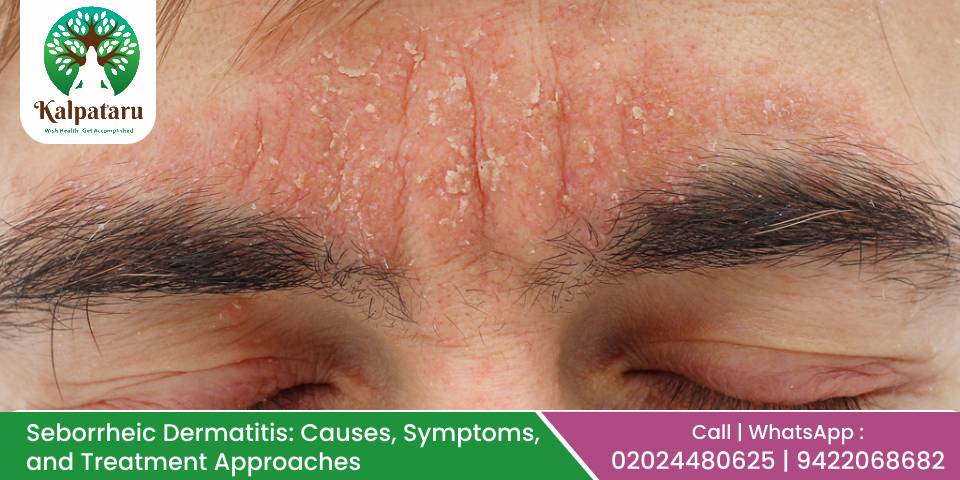
11Nov
Seborrheic Dermatitis: Causes, Symptoms, and Treatment Approaches
Seborrheic dermatitis is a chronic skin condition that primarily affects the scalp but can also extend to areas such as the eyebrows, moustache, beard, and chest. It is often characterized by red, flaky, itchy patches, causing patients to feel embarrassed due to its visibility on the face and other exposed areas. This condition affects the skin's sebaceous (oil-producing) areas, leading to scaling and dandruff. Common Symptoms of Seborrheic Dermatitis: Patients with seborrheic dermatitis often experience:Itching: One of the most prominent symptoms, especially when the condition affects the scalp.Redness and Flaking: This can occur in multiple areas like the scalp, face, chest, and upper back.Scaly Patches: Skin in affected areas can become scaly and greasy, appearing as dandruff.Embarrassment and Self-consciousness: Due to visible scaling, patients may feel socially embarrassed and self-conscious, especially when the dermatitis is prominent on the face. Causes and Contributing Factors: Seborrheic dermatitis has multiple underlying causes, which include:Oily Skin: People with naturally oily skin are more prone to developing this condition.Immune System Imbalance: An overactive immune system response may trigger inflammation, leading to dermatitis.Lifestyle and Environmental Factors: Stress, changes in climate, dietary variations, and inadequate sleep can exacerbate the condition.Yeast/Fungal Infections: Studies suggest that a specific yeast called Malassezia can thrive in oily areas of the skin, leading to an overgrowth and causing inflammation. This is why the condition is often referred to as seborrheic eczema, seborrheic psoriasis, or seborrheic fungal infection. Conventional Treatments: In modern medicine, treatment typically involves a combination of topical and oral medications to manage symptoms:Antifungal Treatments: Antifungal agents like ketoconazole are commonly used, particularly in shampoos, to reduce fungal overgrowth.Anti-inflammatory Medications: To manage inflammation, doctors may prescribe topical corticosteroids for short-term use.Oral Antifungals: In severe cases, oral antifungals may be considered to provide systemic relief.Steroids (in serious cases): When the condition is persistent and resistant to other treatments, steroids are sometimes prescribed. Ayurvedic Perspective on Seborrheic Dermatitis: At Kalpataru Ayurvediya Chikitsalaya™, a holistic approach is taken to treat the root causes of seborrheic dermatitis rather than merely addressing symptoms. The Ayurvedic treatment focuses on lifestyle adjustments, dietary recommendations, and natural remedies to balance the body's internal state.Lifestyle Modifications: Ayurvedic treatment begins with an in-depth analysis of the patient's lifestyle, diet, stress levels, and sleep patterns. Factors such as poor digestion, irregular sleep, and stress can disrupt the balance of pitta (heat) and kapha (coldness and moisture) in the body, contributing to skin issues.Internal Cleansing and Balancing: In Ayurveda, seborrheic dermatitis is linked to imbalances in pitta and kapha doshas. To restore balance, herbal formulations like Manjishthadi Kashaya , Aaragvadhadi kashay are used to detoxify the system and reduce internal inflammation.Topical Applications: Ayurvedic ointments made with purified sulfur (Gandhak) are applied to the affected areas to reduce itching and inflammation. Additionally, medicinal pastes created with yogurt mixed with herbs like kachura (spikenard), daruharidra (barberry), and triphala are applied for their cooling and soothing properties.Herbal Hair Washes: The clinic prepares specialized hair washes containing triphala, guduchi (tinospora), haridra (turmeric), and jyeshthamadha (licorice). These hair rinses, used warm, help cleanse the scalp, loosen stubborn dandruff, and enhance blood circulation to promote healing.Internal Herbal Medications: Ayurvedic formulations, such as various Guggulu compounds and Arogyavardhini Vati, act as internal cleansers, supporting skin health and addressing the underlying causes of seborrheic dermatitis. For more information and treatment modalities watch our informative video https://www.youtube.com/watch?v=ZinzvKQctEMhttps://www.youtube.com/watch?v=-6zKhTNjpzM Panchakarma Therapy for Accelerated Healing: Panchakarma, a key Ayurvedic detoxification process, is also beneficial for treating seborrheic dermatitis. Some of the recommended Panchakarma therapies include:Takra Dhara (Buttermilk Pouring Therapy): This unique Kerala Ayurvedic therapy involves pouring medicated buttermilk on the forehead, which helps reduce stress and balances pitta and kaf dosh, improving immunity and reducing fungal infections in the scalp.Virechana (Purgation Therapy): This therapy helps cleanse accumulated toxins and balances pitta and kapha doshas, addressing the root of seborrheic dermatitis.Raktamokshana (Bloodletting): Raktamokshana, or bloodletting, is a specialized Ayurvedic treatment aimed at purifying the blood by removing impurities. It is especially beneficial for conditions where intense infections or inflammation are present, such as severe scalp infections. In cases where scalp infections are particularly severe, leech therapy (Jalaukavacharan) is employed to draw out the impure blood. Alternatively, bloodletting may also involve the controlled withdrawal of 100-200 ml of blood from specific veins. This process promotes the formation of purified blood, reducing allergic factors in the body, which in turn accelerates healing and recovery. Raktamokshana helps alleviate symptoms and restore balance in the system, contributing to faster and more effective management of chronic conditions like seborrheic dermatitis.Nasya (Nasal Medication): Nasya is a treatment in Ayurveda that is specifically recommended for the organs located above the shoulders. This treatment involves the careful administration of medicinal oils or herbal preparations through the nasal passages. By applying a few drops of these medicated oils into the nose, Nasya therapy helps improve blood circulation to the scalp, boosts immunity, and effectively reduces infections in the affected areas. Benefits of Ayurvedic Treatment at Kalpataru Ayurvediya Chikitsalaya: The Ayurvedic approach goes beyond symptom management, addressing the root causes and offering long-term relief. Thousands of patients with seborrheic dermatitis have found lasting improvements by following this personalized Ayurvedic approach, which includes dietary adjustments, lifestyle modifications, and therapeutic herbal treatments. Conclusion: Seborrheic dermatitis can be challenging to manage, especially when conventional treatments provide only temporary relief. Ayurveda offers a comprehensive solution that not only targets the symptoms but also enhances overall health by balancing the body's internal environment. By focusing on lifestyle and diet changes, stress reduction, and herbal treatments, Ayurveda provides a sustainable approach to managing and healing seborrheic dermatitis.
Read More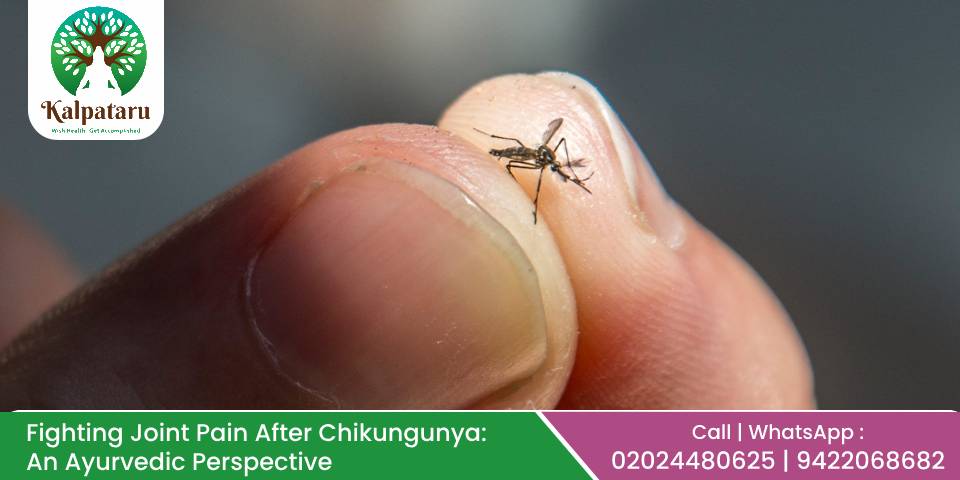
09Nov
Fighting Joint Pain After Chikungunya: An Ayurvedic Perspective
Chikungunya is a viral infection spread by mosquito bites, primarily characterized by severe joint pain and fever. While the fever generally subsides in a week or two, joint pain, stiffness, and swelling can linger for months, significantly impacting quality of life. Understanding the nature of post-Chikungunya joint pain and exploring both conventional and Ayurvedic approaches to manage it can bring relief to those affected. Understanding Post-Chikungunya Joint Pain: After a Chikungunya infection, some people may experience residual joint pain and stiffness, also known as "post-viral arthritis." This pain primarily affects the wrists, ankles, fingers, knees, and other large joints, with the severity varying from person to person. The exact cause of persistent pain isn't entirely understood, but it's believed that the virus may remain in the body, continuing to trigger inflammation in the joints.This lingering pain can lead to:Stiffness in the affected joints, particularly after periods of rest.Fatigue due to ongoing discomfort and limited mobility.Swelling and tenderness in the joints.Reduced mobility and functional limitations. Conventional Approaches to Managing Joint Pain: Treatment for joint pain post-Chikungunya usually focuses on symptom management:Pain Relief Medication: Non-steroidal anti-inflammatory drugs (NSAIDs) can help alleviate pain and reduce inflammation.Physiotherapy: Gentle exercises and stretching help improve joint mobility and reduce stiffness. Specific low-impact activities like swimming or yoga are also effective.Hydration: Drinking sufficient of fluids assists the body in flushing out residual toxins and viruses, which may help reduce inflammation.While these approaches offer relief, Ayurveda provides a holistic perspective that not only addresses symptoms but also aims to restore balance in the body. Ayurveda's Perspective on Joint Pain After Chikungunya: Ayurveda, a traditional system of Indian medicine, views joint pain following Chikungunya as a manifestation of Vata and Kaf dosha imbalance, exacerbated by the body's weakened state post-infection. Vata dosha governs movement, flexibility, and function of the joints, and when imbalanced, it leads to symptoms such as stiffness, pain, and dryness in the joints. Deranged kaf dosh leads to joint information Ayurvedic Remedies for Post-Chikungunya Joint Pain: Here are Ayurvedic treatments that can offer relief and facilitate recovery from post-Chikungunya joint pain:Herbal Remedies:Shallaki (Boswellia serrata): Known for its anti-inflammatory properties, Shallaki reduces joint inflammation and pain, enhancing flexibility and mobility.Ashwagandha (Withania somnifera): An adaptogen that helps strengthen the immune system and manage inflammation. It also supports tissue repair and provides strength to muscles and joints.Guggulu (Commiphora mukul): Often used in Ayurvedic formulations to manage arthritis, Guggulu has analgesic and anti-inflammatory properties beneficial for managing chronic pain.Some gugulu prepations like yograj,sinhnad, gokshuradi, kaishor, rasnadi are proved to be very useful in reducing pain and inflammation to a great extent.Deccoctions of some herbs like shunthi, guduchi, rasna, punarnava are given to the patients so as to boost their Agni status which is very important according to ayurvedic perspective.Panchakarma Therapy:Snehana (Oil Massage): External application of warm, medicated oils like Mahanarayan or Dhanvantaram Tailam , Mahavishgarbh tailam on painful joints helps balance Vata - Kaf doshas and improve circulation, thereby reducing pain and stiffness.Swedana (Herbal Steam Therapy): This therapy involves sweating through herbal steam. It relaxes stiff muscles and joints, promotes circulation, and helps in the elimination of toxins.Virechana (Detoxification Therapy): Virechana is a purgation therapy recommended to expel accumulated toxins. This process clears the gastrointestinal tract, which is believed to assist in reducing systemic inflammation.Basti - with this treatment pain is significantly managed from day 1. Delendance on painkillers is overcome by this unique panchkarm therapy named Basti. Dietary Recommendations: Warm and Nourishing Foods: Emphasize foods that pacify Vata- Kaf doshas such as warm soups, stews, and porridges with appropriate spices. Avoid cold, raw, and dry foods, which aggravate Vata and Kaf doshasSpices: Including turmeric, ginger, garlic, and black pepper can support digestion and reduce inflammation in the body.Hydration: Drinking herbal teas like ginger and turmeric tea or lukewarm water throughout the day can help maintain hydration, which is essential for joint health. Yoga and Pranayama: Gentle Stretching and Movement: Practicing yoga postures like Bhujangasana (Cobra pose), Marjariasana (Cat-Cow pose), and Balasana (Child's pose) can improve flexibility and reduce stiffness. This should be done with proper advice. If pain is more, abstain from heavy exercisePranayama (Breathing Exercises): Pranayama helps reduce stress, improves blood circulation, and facilitates oxygen supply to all parts of the body, which can help speed up the healing process. Lifestyle Adjustments: Rest and Recovery: Ayurveda encourages listening to your body and taking adequate rest. Avoid overexertion, especially during periods of pain.Moderation in Activity: Gradually increase physical activities to avoid placing too much strain on the joints.Daily Self-Massage: Gentle self-massage with warm medicated oils before a warm bath can help ease stiffness and improve joint flexibility. Preventing Joint Pain in the Long Term: Recovery from post-Chikungunya joint pain can be a slow process. To maintain healthy joints and reduce the chances of recurrence:Continue herbal supplements and dietary modifications.Practice regular exercise and gentle movement.Follow a balanced lifestyle that avoids excessive stress and fatigue. For more information and treatment modalities watch our informative video https://www.youtube.com/watch?v=8ZmjXqAnLfw&t=3shttps://www.youtube.com/watch?v=LnJelDfJXlU&t=2s Conclusion: While post-Chikungunya joint pain can be persistent and challenging, a comprehensive approach combining conventional and Ayurvedic treatments can bring relief and facilitate recovery. Ayurveda's holistic methods focus on reducing inflammation, detoxifying the body, and rebalancing the Vata dosha, offering a sustainable path to pain-free joints and improved well-being. As with any treatment, consult an experienced Ayurvedic practitioner like Dr. Manoj Deshpande to find the most appropriate plan tailored to your needs.During the endemic of Chikunguniya, we at Kalpataru Ayurvediya Chikitsalaya™ have treated so many patients having post viral arthralgia. Almost all patients are recovered from these lingering and notorious joint pain complaints. Now they don't need any pain killers for their smooth movements and daily activities
Read More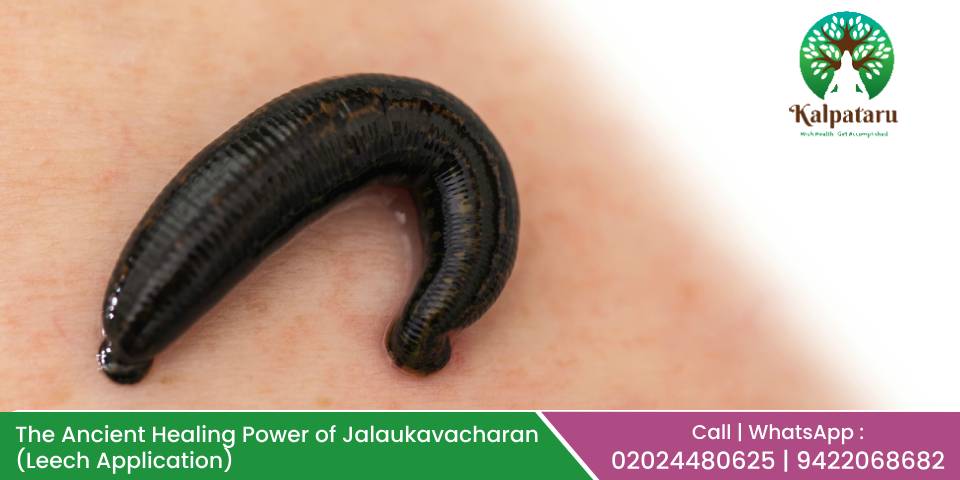
28Oct
जलौकावचरण एक प्राचीन उपचार पद्धती (लीच थेरपी)
आयुर्वेदात शरीर शुद्धीकरणाला आरोग्य राखण्यासाठी खूप महत्त्व दिले आहे. पंचकर्म, हे आयुर्वेदातील पाच शुद्धीकरण उपचार, वमन (उलटी), विरेचन (जुलाब), बस्ती (एनिमा), नस्य (नाकातील औषध ), आणि रक्तमोक्षण (रक्तस्राव) यांचा समावेश करतात. या पद्धतींमध्ये, रक्तमोक्षण, विशेषतः जलौकावचरण (लीच थेरपी) ला रक्त शुद्ध करण्याच्या क्षमतेमुळे विशेष स्थान आहे. आयुर्वेदातील रक्तधातूचे महत्त्व आयुर्वेदानुसार, शरीर सात मूलभूत धातूंनी बनलेले आहे: रस (प्लाझ्मा), रक्त (रक्त), मांस (मांसपेशी), मेद (चरबी), अस्थी (हाडे), मज्जा (हाडांच्या आतली मज्जा), आणि शुक्र (प्रजनन कारक शक्ती). रक्त, एक द्रव धातू असल्याने, पोषक द्रव्ये आणि घातक घटक तो वाहून नेतो. त्यामुळे रक्ताची शुद्धता अत्यावश्यक आहे. जर रक्तात विष किंवा अशुद्ध घटक जमा झाले तर ते विविध आरोग्य समस्या निर्माण करू शकतात. यासाठीच जलौकावचरण खूप फायदेशीर ठरते, कारण हे उपचार रक्त शुद्ध करून शरीरात संतुलन ठेवतात. जलौकावचरण -एक प्राचीन उपचार पद्धती लीच थेरपीचा वापर प्राचीन काळापासून जगभरात होताना दिसतो. आयुर्वेदात, भगवान धन्वंतरी, जे वैद्यकाचे देव आहेत, त्यांना एका हातात जलौका(लीच) धरलेले दाखवतात, जे या उपचाराचे महत्त्व अधोरेखित करते. विशिष्ठ पद्धतीच्या औषधी लीचचा या उपचारामध्ये महत्त्वपूर्ण वापर होतो. जलौकावचरण कार्य कसे करते? जलौका रक्तप्रवाह सुधारण्याच्या क्षमतेसाठी ओळखले जातात आणि त्यांच्या लाळेत आढळणाऱ्या विरोधी-रक्तस्रावक, विरोधी-संक्रमणकारक आणि विरोधी-प्रदाहक घटकांमुळे ते व्याधी बरा करण्यासाठी मदत करतात. लीचच्या लाळेमध्ये विविध जैविक घटक असतात जे वेदना कमी करण्यात, सूज कमी करण्यात आणि उपचार प्रक्रिया गतीमान करण्यात मदत करतात.लीचसाठी विशेषतः सक्रिय आणि निरोगी जलौका निवडले जातात. उपचाराच्या क्षेत्राची स्वच्छता करून, लीच त्वचेवर लावली जाते. Leech त्वचेवर चिकटून रक्त शोषून घेते. जवळपास ४५ मिनिटे ते १ तास या प्रक्रियेचा कालावधी असतो, यामध्ये साधारण ५-१० मि.ली. रक्त काढले जाते. लीच त्वचेवरून विषारी पदार्थ, संक्रामक घटक आणि सूजयुक्त घटक दूर करते, त्यामुळे त्वरित आराम मिळतो.खासकरून हर्पीज संसर्ग( नागीण अथवा नागवेढा )असलेल्या रुग्णांना, जे तीव्र वेदनेमुळे झोपू शकत नाहीत, या उपचारामुळे खूप दिलासा मिळतो. या थेरपीनंतर रुग्णांना सूज, खाज, आणि लालसरपण कमी झाल्याचे जाणवते, आणि बऱ्याचदा ते उपचारादरम्यानच झोपी जातात. For more information and treatment modalities watch our informative video https://www.youtube.com/watch?v=7JPbmOieG7k&t=4shttps://www.youtube.com/watch?v=DafTm-Fmoi4&t=15s जलौकावचरण चे औषधी उपयोग विविध प्रकारच्या समस्यांसाठी फायदेशीर ठरते:त्वचारोग: एक्झिमा, सोरायसिस, लायकेन प्लेनस, मेलास्मा, आणि फंगल इन्फेक्शन यासारख्या त्वचारोगांमध्ये लीच थेरपी उपयुक्त ठरते. व्हिटिलिगो आणि केस गळतीसारख्या अवस्थांमध्ये लीच उपचार सूक्ष्म रक्तप्रवाह सुधारून उपचार प्रक्रिया गतीमान करतो.जखमा: या उपचारामुळे विशेषतः डायबेटीस अल्सर आणि व्हेरिकोस अल्सरमध्ये, सूक्ष्म रक्तप्रवाह सुधारतो आणि संक्रमण कमी होते.सांधेदुखी आणि संधिवात: गुडघेदुखी, फ्रोझन शोल्डर, आणि टाचेदुखीमध्ये त्वरित आराम देतो.गँग्रीन आणि सूजलेल्या मूळव्याधी चे कोंब: गँग्रीनच्या प्रारंभिक अवस्थेत जलौकावचरण रक्तप्रवाह टिकवून ठेवते आणि सुजलेल्या मुळव्याधी मध्ये सूज कमी झाल्याने आराम मिळतो.फोड आणि गांठ: पुनरावृत्ती होणाऱ्या फोडांमध्ये जलौकावचरण ने वेगाने उपशय मिळतो.नेत्र आणि कर्करोग संबंधित समस्या: काही नेत्र विकारांमध्ये आणि कर्करोग रुग्णांमध्ये वेदना कमी करण्यासाठी सहाय्यक भूमिका निभावते.हर्पीज संसर्ग: हर्पीजसारख्या तीव्र वेदनेत रुग्णांना लगेच आराम मिळतो.सिस्टिक पिंपल्स (मुरुमे): सिस्टिक पिंपल्समध्ये लीच उपचार पुरळ कमी करून त्वचेला दुरुस्त करतो. लीचच्या लाळेतील औषधी घटक लीचच्या लाळेत ७-८ जैविक घटक असतात, जे विविध औषधी गुणधर्म देतात:हिरुडिन: एक महत्त्वाचा घटक जो रक्त गोठण्यापासून प्रतिबंधित करतो.कॅलिन: उपचारानंतर रक्तस्त्राव चालू ठेवतो, ज्यामुळे विषारी पदार्थ निघून जातात.बडेलिन आणि एग्लिन: प्रदाह कमी करतात.हायलुरोनिडेज: आजूबाजूच्या ऊतींची पारगम्यता वाढवतो, ज्यामुळे औषधी पदार्थांचा परिणाम वाढतो.लिपेस आणि इस्टेरेज: चरबीचे विघटन करून स्थानिक सूज कमी करतो. निष्कर्ष जलौकावचरण म्हणजे लीच थेरपी, एक प्राचीन आणि अत्यंत प्रभावी आयुर्वेदीय उपचार पद्धती आहे. अनेक रोगांमध्ये हा उपचार नैसर्गिक आणि परिणामकारक उपाय म्हणून काम करतो. हे रक्त शुद्ध करून, विषारी पदार्थ काढून टाकतं, ज्यामुळे शरीरात ऊर्जावान आणि निरोगी भावपदार्थ निर्माण होतात.
Read More
24Oct
The Ancient Healing Power of Jalaukavacharan (Leech Application)
In Ayurveda, the importance of body detoxification for maintaining health is well established. Panchakarma, the fivefold purification therapy, is a vital component of Ayurvedic treatment that includes Vaman (emesis), Virechan (purgation), Basti (enema), Nasya (nasal cleansing), and Raktamokshan (bloodletting). Among these, Raktamokshan, particularly through Jalaukavacharan (leech therapy), holds a unique place due to its ability to purify the blood. The Significance of Raktadhatu in Ayurveda: In Ayurveda, the human body is composed of seven fundamental tissues, or dhatus: Rasa (plasma), Rakta (blood), Mamsa (muscle), Meda (fat), Asthi (bone), Majja (bone marrow), and Shukra (reproductive fluids). Rakta, being a fluid tissue, carries nutrients and waste products, making its purity essential for overall health. If toxins or impurities accumulate in the blood, they can lead to various health issues. This is where Jalaukavacharan comes into play, purifying the blood and restoring balance to the body. Jalaukavacharan: An Ancient Practice: Leech therapy has been used since ancient times, with evidence of its practice in many parts of the world. In Ayurveda, Lord Dhanvantari, the God of medicine, is often depicted holding a leech in one hand, highlighting its significance. The medicinal leech, scientifically known as Hirudo medicinalis, plays a key role in this therapy. For more information and treatment modalities watch our informative video https://www.youtube.com/watch?v=7JPbmOieG7k&t=4shttps://www.youtube.com/watch?v=DafTm-Fmoi4&t=15s How Does Jalaukavacharan Work? Leeches are known for their ability to improve blood circulation and help in reducing infections, thanks to the anticoagulant, anti-inflammatory, and antimicrobial properties found in their saliva. Leech saliva contains various bioactive substances that aid in relieving pain, reducing swelling, and accelerating healing.Before application, carefully selected, healthy leeches are chosen based on their activeness and non-toxic nature. The treatment area is cleaned thoroughly, and the leech is gently placed on the skin. It then attaches itself and begins to suck blood. To maintain a moist environment conducive to the leech's natural function, a damp cloth or cotton is placed over it. The procedure typically lasts between 45 minutes to 1 hour, during which about 5-10 ml of blood is extracted. The leech effectively removes toxins, infectious agents, and inflammatory components from the affected area, providing almost immediate relief to the patient.Especially in patients with herpes infections, who often haven't slept for days due to severe pain and discomfort, this treatment provides significant relief. After undergoing the therapy, their pain, swelling, itching, and redness reduce considerably. In many cases, patients are able to sleep right on the treatment table itself, which is a common experience observed with many patients. Therapeutic Applications of Jalaukavacharan: Jalaukavacharan can be beneficial in a wide range of conditions:Skin Disorders: Leeches work wonders in treating skin conditions like eczema, psoriasis, Lichen planus, Melasma, and fungal infections. In vitiligo and alopecia (hair loss), leech therapy can stimulate microcirculation, aiding in healing and regeneration.Chronic Wounds: This therapy is highly effective in non-healing ulcers, especially in conditions like diabetic ulcers and varicose ulcers. Leech saliva helps improve microcirculation, reduce infection, and promote healing.Joint Pain and Arthritis: For patients suffering from conditions like osteoarthritis and rheumatoid arthritis, leech therapy can significantly reduce inflammation and pain in affected joints. Whether it's knee pain, frozen shoulder, or heel pain, the results are often immediate and profound.Gangrene and Thrombosed Hemorrhoids: In early stages of gangrene, leech therapy helps retain circulation, preventing the condition from worsening. It also provides relief from pain and swelling in thrombosed piles, which is one of the most painful forms of hemorrhoids.Abscesses: Recurrent abscesses, such as perianal or breast abscesses, benefit greatly from Jalaukavacharan when combined with pitta-pacifying treatments. It accelerates healing by reducing infection and inflammation.Ocular and Cancer-Related Conditions: In certain eye disorders and in the management of pain and swelling in cancer patients, leech therapy plays a supportive role by reducing tumor size and alleviating discomfort.Herpes Infections: Leech therapy offers immediate relief to herpes patients who often experience excruciating pain, swelling, and irritation. After treatment, many report reduced discomfort and improved sleep.Acne (Cystic Acne): For cystic acne, leeches help by draining pus, reducing inflammation, and preventing disfigurement caused by severe breakouts. The Magic of Leech Saliva: Leech saliva contains around 7-8 bioactive compounds that have various therapeutic properties. These include:Hirudin: A potent anticoagulant that prevents blood clotting.Calin: Extends the bleeding time post-treatment, promoting drainage of toxins.Bdellins and Eglins: Anti-inflammatory agents that reduce swelling and pain.Hyaluronidase: Increases the permeability of surrounding tissues, enhancing the spread of beneficial substances.Lipase and Esterase: Help in breaking down fats, contributing to the reduction of local inflammation.These combined actions make Jalaukavacharan a versatile treatment option for various ailments. Conclusion: Jalaukavacharan, or leech therapy, is an ancient yet highly relevant Ayurvedic treatment for a wide range of conditions. From managing chronic wounds to alleviating joint pain and even treating skin disorders, this therapy offers natural, effective solutions. With its ability to purify blood and eliminate toxins, Jalaukavacharan ensures improved health and vitality. For those seeking holistic and sustainable treatment methods, leech therapy is truly a remarkable option.
Read More
19Oct
Childhood Obesity and How to Combat It?
In today's world, celebrations revolve around food and drink. Whether it's birthdays, family events, successful achievements, or passing exams, high-calorie food is often the center of attention. The rise in childhood obesity, unhealthy lifestyles, and future health risks can be traced back to this food-focused culture. Causes of Obesity in Children: The modern lifestyle contributes to stress in children, caused by academics, extracurricular classes, irregular sleep, and poor eating habits. Additionally, the misconception that children should be chubby and that they need to eat more leads to overeating. When excess calories aren't burned through physical activity, they get stored as fat, causing weight gain and related health issues. The Problem with Parties and High-Calorie Foods: Parties often feature a variety of foods, many of which are high in refined flour, sugar, fat and junk ingredients. These foods are calorie-dense and not suitable for children for regular consumption. Since kids tend to indulge in these varieties frequently, unnecessary calories in turn of fats get accumulated in their bodies, leading to health problems like early-onset obesity, high blood pressure, high cholesterol, fatty liver, insulin resistance, and prediabetic conditions. Tips for Improving Eating Habits: Eating at Regular Intervals: Children should follow a routine of three or four meals a day, including breakfast, lunch, a light snack in the evening, and dinner. Avoid eating at irregular times or when not actually hungry. Avoid Forcing Milk Consumption: Some parents believe that milk is essential for children, but if a child dislikes it, there's no need to force it. Nutrients like calcium, protein, and vitamins can be obtained from other dietary sources. According to ayurvedic point of view, milk is kaf dosh enhancing food which boosts Med dhatu vrudddhi. Include Protein-Rich Foods: It's important to ensure that children's diets are rich in protein and other nutrients. Incorporating pulses, seeds (like pumpkin , sunflower , chia, sesame, flax seed, watermelon seeds), nuts, and salads into their daily meals is essential for balanced nutrition. Fruits and Vegetables: Daily consumption of one or two fruits and leafy vegetables is necessary. If children dislike certain fruits or vegetables, try offering them in different recipes( Paratha, thepla, dosa etc) to make them more appealing. Sleep and Its Impact on Obesity: Overuse of mobile devices and the pressure of extracurricular activities can disrupt children's sleep patterns. Lack of sleep increases cortisol levels in the body, which can contribute to fat accumulation and high blood pressure. Ensuring that children get adequate sleep is crucial for maintaining a healthy weight. Vitamin D3 Deficiency: Vitamin D3 deficiency in children can lead to inflammation, and other health concerns. It can fuel fat gain . So regular testing for Vitamin D3 levels and supplementing as needed is important for their overall health. Importance of Drinking Water: Inadequate water intake can often be mistaken for hunger. Encouraging children to drink water regularly can help curb false hunger signals and promote better eating habits. Portion Control and Smart Eating at Parties: When attending parties, it's important to teach children about portion control and making healthier food choices. Parents can guide their kids to start with healthier options first and then try other foods, ensuring they consume necessary nutrients. Ayurvedic Perspective on Childhood Obesity: Ayurveda, an ancient holistic healing system, views obesity as an imbalance of Kapha dosha, which governs the body's structure and fluid balance. When the Kapha is aggravated due to improper lifestyle and diet, it leads to the accumulation of fat, resulting in weight gain. Ayurveda emphasizes a balanced diet, regular exercise, proper sleep, and herbal remedies to restore balance and support natural weight management. Here are some Ayurvedic principles to consider for managing childhood obesity: Improving Digestion and Metabolism: Ayurveda believes that weak digestion (Agni) is a significant factor in obesity. Herbal formulations like Triphala (a combination of three fruits), Arogyavardhini Vati, and Chandraprabha Vati can be used to enhance digestion, improve metabolism, and support fat loss. These should be taken under the guidance of a qualified Ayurvedic practitioner. Enhancing Liver Function: The liver plays a critical role in fat metabolism. Ayurvedic herbs such as Kutki and Bhumyamalaki help improve liver function, ensuring that the body's natural detoxification processes are efficient. This aids in preventing fat accumulation and promotes a healthier weight. Herbal Remedies to Balance Kapha and Promote Fat Loss: Herbal preparations like Falatrikadi Guggulu help balance Kapha dosha and promote the mobilization of stored fat. Other remedies such as Guggulu and Punarnava are known for their ability to reduce body fat and fluid retention, thereby supporting weight management. Using Warm Spices to Stimulate Metabolism: Spices such as ginger, black pepper, and turmeric are known for their ability to stimulate digestion and increase metabolism. Including these spices in the daily diet helps in burning excess fat and improves overall digestive health. Mindful Eating and Portion Control: Ayurveda emphasizes eating with awareness. Encouraging children to eat slowly, chew their food properly, and avoid distractions (like screens) during meals can help in better digestion and portion control. Teaching children about portion size, especially during parties or buffets, is crucial. They should start with healthy foods and eat smaller portions of less nutritious options. Ayurvedic Lifestyle Changes for Weight Management: Encouraging Physical Activity: According to Ayurveda, regular physical activity is essential to balance Kapha. Activities like yoga, brisk walking, or playful exercises can help children stay active and burn calories. Ensuring Adequate Sleep: Good quality sleep is essential for maintaining a balanced metabolism. Ayurveda recommends a bedtime routine that includes avoiding screens before sleep, practicing calming activities like meditation or reading, and ensuring a consistent sleep schedule. Avoiding Foods That Aggravate Kapha: Heavy, oily, and cold foods can aggravate Kapha and lead to weight gain. Ayurveda advises incorporating light, warm, and freshly cooked foods into the diet, which are easier to digest. Seasonal Routines and Detox Practices: Ayurveda suggests seasonal cleansing to eliminate toxins that may contribute to weight gain. Simple detox practices such as herbal teas, or undergoing Panchakarma therapies under the guidance of an Ayurvedic expert, can help rejuvenate the body and promote healthy metabolism. Conclusion: Childhood obesity is a significant health challenge that requires a holistic approach for effective management. By combining modern dietary recommendations with Ayurvedic principles, children's health can be nurtured in a balanced way. Encouraging a proper diet, regular physical activity, adequate sleep, and hydration, along with the right herbal support, can help prevent and manage obesity. Parents play a vital role in instilling healthy habits early on. By educating children about mindful eating, proper portion sizes, and an active lifestyle, we can help them avoid future health issues and lead a balanced life. Ayurveda's holistic approach not only addresses the physical aspects of obesity but also aims to restore harmony in the mind and body, offering a natural pathway to health and wellness.
Read More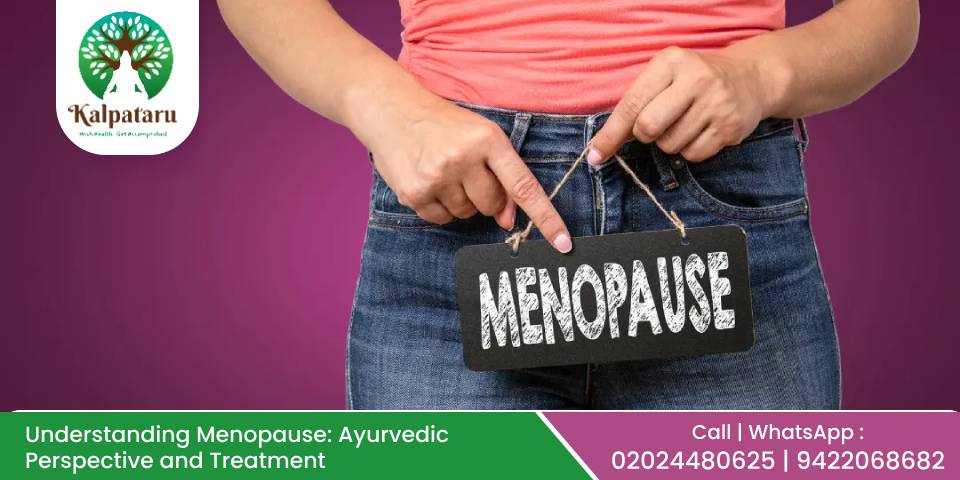
08Oct
Understanding Menopause: Ayurvedic Perspective and Treatment
Menopause marks a significant phase in a woman's life when her menstrual cycles permanently discontinue, signaling the end of her reproductive years. Typically, menopause occurs naturally in women between the ages of 45 and 55, with the average age being around 51. This transition, known as perimenopause, can last for several years and brings a range of physical, emotional, and hormonal changes due to declining estrogen levels. What is Menopause? Menopause is a natural biological process that marks the end of a woman's menstrual cycle, typically occurring between the ages of 45 to 55. It signifies the cessation of periods for 12 consecutive months. Menopause is not a sudden event but a gradual transition, often preceded by a phase called perimenopause, where menstrual irregularities and hormonal fluctuations occur. What is the Average Age of Menopause? The average age for menopause varies from woman to woman, but it typically occurs between 45 to 55 years. For most women, the average age of menopause is around 51. However, factors such as genetics, lifestyle, and health can influence when menopause occurs. Symptoms of Menopause: Menopause brings about a variety of physical and emotional changes due to the decline in estrogen levels. Some of the common symptoms include: Hot Flashes: Sudden feelings of heat, particularly in the upper body. Night Sweats: Excessive sweating during the night, leading to disturbed sleep. Irregular Periods: Menstrual cycles may become unpredictable before stopping completely. Fatigue: A constant feeling of tiredness, despite adequate rest. Mood Swings: Increased feelings of anxiety, irritability, and depression. Insomnia: Difficulty falling asleep or staying asleep. Loss of Libido: A decrease in sexual desire. Weight Gain: Particularly around the abdomen. Vaginal Dryness: Leading to discomfort during intercourse. Joint and Muscle Aches: Increased stiffness and soreness in the body. Why Do These Symptoms Occur? The primary cause of menopausal symptoms is the decrease in estrogen levels. Estrogen is closely linked with the function of the hypothalamus, a part of the brain responsible for regulating body temperature. As estrogen levels drop, the hypothalamus can misinterpret the body's actual temperature, leading to sensations of overheating or "hot flashes." This can cause the dilation of blood vessels and trigger the sweat glands to produce more sweat to cool down the body. This often results in excessive sweating, particularly at night (known as night sweats). Menopause and Ayurvedic Perspective: In Ayurveda, menopause is viewed as a natural transition, but one that is often accompanied by imbalances in the body's doshas (Vata, Pitta, and Kapha). According to Ayurvedic principles, during menopause, Vata and Pitta doshas tend to increase, leading to various symptoms like: Vata Imbalance: This can cause anxiety, insomnia, dry skin, fatigue, and joint pain. Pitta Imbalance: This leads to hot flashes, night sweats, irritability, and mood swings. The decline in estrogen, along with the involvement of the hypothalamus, can result in body temperature mismanagement, leading to the sensation of excessive heat and sweating. These imbalances require a holistic approach to bring harmony back to the body, and Ayurveda offers several remedies for this. Ayurvedic Remedies and Treatments for Menopause Symptoms: Ayurvedic treatments for menopause include herbs, therapies, and lifestyle modifications aimed at balancing Vata and Pitta doshas. Below are some of the commonly used Ayurvedic interventions: 1)Herbal Remedies: Certain herbs have been extensively researched and proven to reduce menopause symptoms effectively: Shatavari: Known as the "queen of herbs" for women's health, Shatavari helps nourish the reproductive system, supporting hormonal balance, and alleviating hot flashes and mood swings. Ashwagandha: A powerful adaptogen, Ashwagandha helps reduce stress and anxiety while boosting energy levels, making it ideal for combating fatigue and mental fogginess. Gokshura, Guggulu, and Guduchi: These herbs help regulate hormones, reducing inflammation, and improving overall vitality during menopause. 2) Night Sweats and Hot Flashes Remedies: To counteract night sweats and hot flashes, cooling, and Pitta-pacifying herbs are used: Ushir, Gokshura, Suvarnagairik, and Pravala Bhasma (Coral calcium): These remedies help reduce excessive heat, cooling down the body and balancing Pitta. Chandan (Sandalwood), Sariva (Indian Sarsaparilla), and Jatamansi: These herbs also work on reducing body heat and night sweats. 3) Treating Anxiety and Insomnia: For symptoms like anxiety, restlessness, or mood swings, the following Ayurvedic treatments are recommended: Chandraprabha Vati: This formulation helps in calming the mind and reducing anxiety, balancing the aggravated Vata dosha. Jatamansi is also used for psychological ailments occuring during menopausal age. Purnachandrodaya: This herbomineral ayurvedic drug helps reduce fatigue and loss of libido by nourishing the body's reproductive tissues and supporting hormonal balance and boosting Shukra shatu. 4) Panchakarma Therapies: Ayurvedic Panchakarma therapies are highly beneficial for balancing the doshas during menopause. These include: Nasya Therapy: Nasya is a treatment where medicated oil, such as Anutailam, is administered through the nose. It is believed that the nose is the gateway to the brain, and the Nasya can help regulate the hypothalamus, which plays a vital role in hormonal balance. Nasya is especially effective for managing stress, anxiety, and insomnia associated with menopause. Basti Therapy: Basti (medicated enema) is one of the most effective therapies for calming aggravated Vata dosha. Administering Narayana oil or Shatavari oil through Basti process helps in reducing symptoms like dryness, anxiety, and joint pain. 5) Cooling Formulations: For women suffering from hot flashes and night sweats, Ayurvedic cooling formulations like Pravala Bhasma and Jasad Bhasma (Zinc ash) are highly recommended to bring down excess heat and provide relief from these uncomfortable symptoms. Conclusion: Menopause is a natural phase that brings both challenges and opportunities for self-care. Ayurveda provides a holistic approach to managing menopause by managing the root causes of symptoms through diet, lifestyle changes, herbal remedies, and therapeutic treatments. By balancing the Vata and Pitta doshas, it is possible to reduce the discomfort associated with menopause and promote a healthy transition into this new stage of life. If you are experiencing severe symptoms, consulting with an Ayurvedic Doctor in Pune can help tailor a treatment plan to your individual needs, ensuring a smoother and healthier journey through menopause.
Read More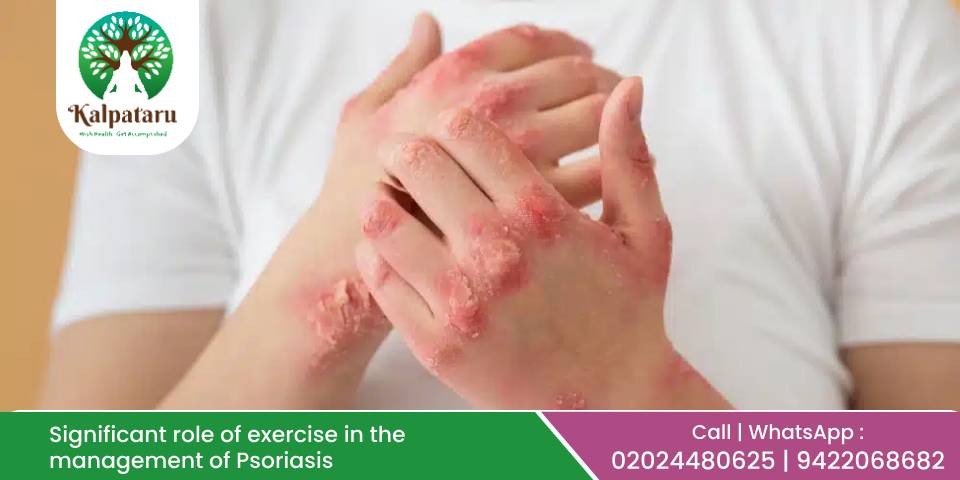
03Oct
Significant role of exercise in the management of Psoriasis
What is Psoriasis? Psoriasis is a chronic autoimmune condition characterized by the rapid growth of skin cells, leading to thick, red, scaly patches that can be itchy and painful. It affects approximately 2-3% of the global population, translating to millions of individuals worldwide. The condition not only has physical implications but also poses significant psychological challenges for those affected. Many patients experience social stigma, impacting their mental health and overall quality of life, as they may avoid certain clothing or social situations due to their visible symptoms. Physical and Mental Burden of Psoriasis: Living with psoriasis can lead to substantial physical discomfort and emotional distress. Patients may struggle with severe itching, pain, and discomfort from the lesions, which can hinder daily activities. The psychological impact is equally profound; individuals may face anxiety, depression, and social isolation, further exacerbating their condition. The fear of judgment can prevent them from participating in social activities or wearing certain clothes, leading to a cycle of decreased self-esteem and mental health challenges. For more information and treatment modalities watch our informative video https://www.youtube.com/watch?v=vRlhmQE1kF0&t=20s Complications of Psoriasis: When psoriasis becomes chronic, it can lead to various complications, impacting multiple systems within the body. Here are some of the key complications:Joint Issues: Psoriasis can trigger psoriatic arthritis, a painful condition affecting the joints. This can lead to swelling, stiffness, and reduced mobility.Increased Risk of Gout: Patients with psoriasis have a higher likelihood of developing gout, a type of arthritis caused by the accumulation of uric acid crystals in the joints.Ocular Problems: Psoriasis can affect the eyes, leading to conditions such as conjunctivitis or uveitis, which can cause pain and vision problems.Cardiovascular Issues: There is an elevated risk of cardiovascular diseases, including coronary artery disease, hypertension, and dyslipidemia, among psoriasis patients.Cancer Risk: Individuals with psoriasis may have a higher likelihood of developing certain types of cancer, underscoring the need for regular health monitoring.Metabolic Disorders: Conditions such as diabetes, obesity, and fatty liver disease are more prevalent among psoriasis patients, often linked to the inflammation associated with the disease.Given these complications, a holistic approach, including exercise, is vital for managing psoriasis and its associated risks. The Role of Exercise in Managing Psoriasis: Exercise plays a crucial role in managing psoriasis and its complications. Regular physical activity can significantly improve insulin sensitivity and reduce insulin resistance, which is essential for managing metabolic disorders. Exercise helps in weight management, lowers blood pressure, and improves lipid profiles—all factors that can help mitigate the risks associated with psoriasis.Incorporating moderate-intensity exercises such as cardio, weight training, and even yoga can have profound benefits. Yoga, in particular, aids not only in physical health but also supports mental well-being through relaxation techniques, breathing exercises, and mindfulness practices. These practices can help alleviate stress, a known trigger for psoriasis flare-ups. Mental Health Benefits of Exercise: The mental health benefits of exercise cannot be overlooked. Regular physical activity releases endorphins and serotonin, which help reduce pain and improve mood. This positive impact on mental health can alleviate some of the social anxieties faced by individuals with psoriasis, encouraging them to engage more fully in their lives.Moreover, yoga and mindfulness exercises can significantly improve overall well-being by reducing cortisol levels, which is a hormone associated with inflammation. By managing inflammation through exercise and a balanced lifestyle, individuals can experience a reduction in psoriasis symptoms and enhance their quality of life. Establishing a Regular Exercise Routine: Consistency is key when it comes to exercise. Aim for at least 5-6 days of moderate activity each week, balancing cardio, strength training, and flexibility exercises like yoga. Avoid overly strenuous workouts, as they may lead to injuries or exacerbate existing joint issues, especially in those with psoriatic arthritis.Regular physical activity not only enhances the body's immune response but also helps combat inflammation, making it a vital component of psoriasis management. Engaging in activities that promote joy and relaxation can also foster a more positive mindset, further supporting mental health. Conclusion: Psoriasis is more than just a skin condition; it has far-reaching effects on both physical and mental health. By understanding the complexities of this autoimmune disease and the importance of a comprehensive management plan—including exercise, diet, and lifestyle changes—patients can take control of their health. The integration of regular physical activity, particularly moderate exercises and yoga, can lead to significant improvements in both symptoms and overall well-being. Start incorporating these practices today to pave the way for a healthier, happier life with psoriasis.Dr. Manoj Deshpande and Dr. Aparna Deshpande at Kalpataru Ayurvediya Chikitsalaya™ Clinic provide the best Ayurvedic Treatment for Psoriasis & various diseases in Pune, Maharashtra. For more information about our comprehensive treatment options, or to requestan appointment with the best Ayurvedic Doctor in Pune, call +919422068682 / +919764837167 / 020-24480625 or Click on Book an Appointment.
Read More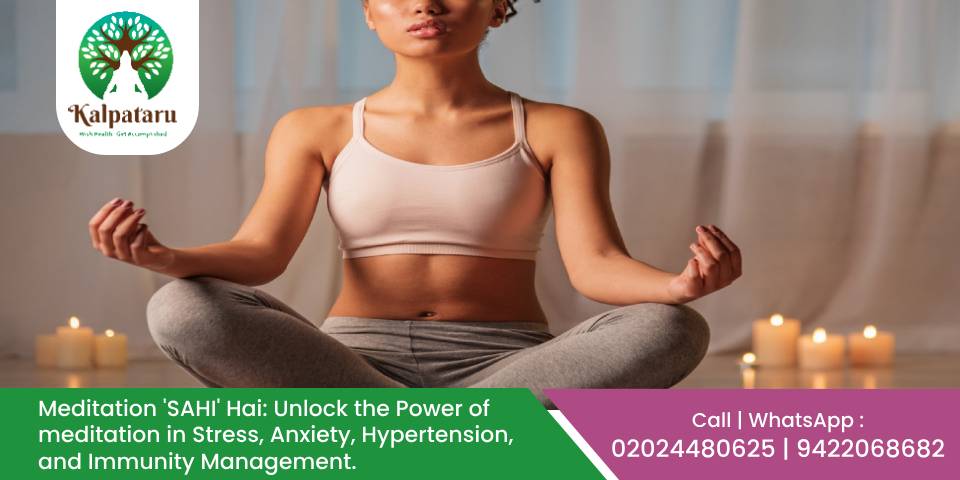
21Sep
Meditation ‘SAHI’ Hai: Unlock the Power of meditation in Stress, Anxiety, Hypertension, and Immunity Management.
In today's fast-paced world, our mental and physical health are often compromised due to various stressors. This is where meditation comes into play. It's not just a spiritual or calming activity; meditation is a powerful tool for managing four critical aspects of health: Here Stress, Anxiety, Hypertension, and Immunity, collectively referred to as 'SAHI.' Let's dive into how meditation can help you master these areas and lead a healthier, more balanced life. S (Stress)- Stress Management Through Meditation: Stress is an inevitable part of life, but how we manage it can make all the difference. Meditation plays a pivotal role in reducing the levels of stress hormones like cortisol, adrenaline and noradrenalin. These hormones, when elevated, contribute to increased heart rate, higher blood pressure, and faster breathing, which can lead to chronic stress and related health issues. Meditation effectively lowers these stress indicators, resulting in a relaxed state where the body can recover and rejuvenate.More importantly, meditation enhances your ability to cope with any form of stress. An interesting experiment demonstrated this: one group was asked to meditate for 20 minutes before playing a stressful computer game, while the other group simply sat without meditating. After the game, it was found that those who meditated had significantly lower stress levels, proving that meditation can help manage stress, especially in high-pressure situations like presentations, performances.Making a habit of practising meditation for 15-20 minutes daily can make you more 'present' and significantly reduce the stress caused by future anxieties. This practice not only improves your overall performance but also enhances the quality of your sleep, allowing you to wake up refreshed and ready to face the day. A (Anxiety)- Alleviating Anxiety with Meditation: Anxiety is often intertwined with stress, and it can significantly affect your quality of life. Meditation helps calm the mind by focusing on the present moment, which is crucial for reducing anxiety. Through consistent practice, meditation trains your brain to stay in the 'now,' preventing it from worrying about the future or dwelling on past events.This mindfulness not only reduces anxiety but also enhances your performance in daily tasks. Whether it's preparing for a presentation or dealing with the pressures of everyday life, meditation helps you stay centered, focused, and less anxious. H (Hypertension)- Hypertension Control with Meditation: Hypertension, or high blood pressure, is a silent killer affecting millions worldwide. Meditation can be a natural remedy for controlling hypertension. By inducing a state of deep relaxation, meditation helps lower blood pressure, reduce the strain on your heart, and promote better cardiovascular health.Moreover, meditation deactivates the sympathetic nervous system (SNS)—responsible for the body's 'fight or flight' response—and activates the parasympathetic nervous system (PNS), which promotes relaxation and recovery. This shift not only lowers blood pressure but also enhances feelings of peace, contentment, and positivity. I (Immunity)- Boosting Immunity Through Meditation: Your immune system is your body's defense mechanism against illness. Stress and anxiety can weaken this system, making you more susceptible to infections and diseases. Meditation has been shown to enhance the immune system by reducing stress levels and promoting overall well-being.When you meditate, your body shifts from a state of stress to a state of relaxation, allowing your immune system to function more effectively. This enhanced immune response helps your body fight off illnesses more efficiently and recover faster from health setbacks. Genes related with immunity are activated significantly after regular practice of meditation. Meditation reduces inflammation in the body which is root cause for so many serious chronic diseases. Types of Meditation: Meditation is a versatile practice with various forms that cater to different needs and preferences. Here are some of the most popular types:Mindfulness Meditation: Focuses on being aware of your thoughts and feelings without judgment, helping you stay present.Transcendental Meditation: Involves silently repeating a mantra to achieve deep relaxation and inner peace.Guided Meditation: A guide or instructor leads you through a meditative experience, often using visualizations.Loving-Kindness Meditation (Metta): Cultivates compassion and love towards oneself and others.Body Scan Meditation: Involves focusing on different parts of the body to release tension.Zen Meditation (Zazen): A form of seated meditation emphasizing posture and breath control.Yoga Nidra: Known as 'yogic sleep,' this practice induces deep rest and rejuvenation.Mantra chanting meditation: ( Namsmaran) Meditating on any divine name of God. Other Benefits of Meditation: Meditation offers a wide range of benefits that go beyond managing SAHI. Here are some of the key advantages:Improved Focus and Concentration: Regular meditation enhances your ability to concentrate, improving productivity and performance.Better Sleep Quality: Melatonin, a sleep hormone, is also enhanced through meditation. It helps calm the mind, making it easier to fall asleep and improving sleep quality.Emotional Stability: Meditation promotes emotional well-being by reducing negative emotions and increasing positive ones like happiness and contentment.Pain Management: Meditation helps reduce the perception of pain by increasing the production of endorphins, the body's natural painkillers.Anti-Aging Effects: Meditation has an anti-aging effect by reducing stress and promoting relaxation. It increases the production of feel-good hormones like serotonin, GABA, and DHEA, which slow down the aging process.Synchronization of Brain Hemispheres: Meditation creates harmony between the left and right hemispheres of the brain, leading to better cognitive functions and emotional balance.Relief From Psychosomatic Diseases: Conditions like back pain, neck pain, spondylosis, thyroid issues, depression, anxiety, psoriasis, eczema, cancer, asthma, IBD, heart disease, and migraines and so many are stress-related. Meditation helps reduce stress, which can positively impact these diseasesGut-Brain Axis: Meditation supports the gut-brain axis, improving gut health, which in turn positively affects brain health. It promotes the growth of good gut bacteria, which is crucial for overall well-being. Conclusion: Meditation 'SAHI' hai—it's a simple yet powerful practice that can significantly enhance your life by managing stress, anxiety, hypertension, and immunity. By incorporating meditation into your daily routine, you can unlock these benefits and lead a healthier, more balanced life. Whether you're new to meditation or a seasoned practitioner, the key is consistency. Start with a few minutes each day, explore different types of meditation, follow whichever likes and suits you and watch as your mental and physical health transform for the better.Dr. Manoj Deshpande and Dr. Aparna Deshpande at Kalpataru Ayurvediya Chikitsalaya™ Clinic provide the best Ayurvedic Treatment for Psoriasis & various diseases in Pune, Maharashtra. For more information about our comprehensive treatment options, or to requestan appointment with the best Ayurvedic Doctor in Pune, call +919422068682 / +919764837167 / 020-24480625 or Click on Book an Appointment.
Read More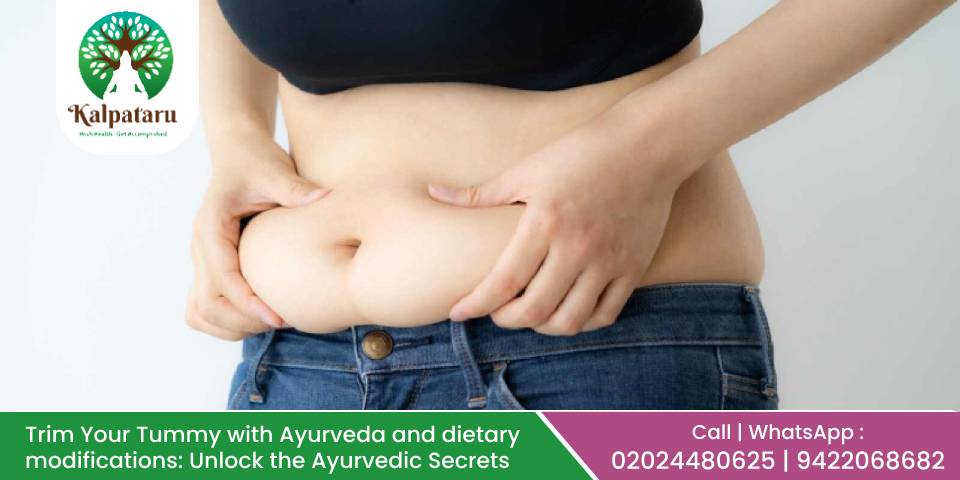
16Sep
Trim Your Tummy with Ayurveda and dietary modifications: Unlock the Ayurvedic Secrets
Ayurveda, the ancient holistic system of medicine from India, offers a unique approach to weight loss that focuses on balancing the body's natural energies, or doshas (Vata, Pitta, and Kapha). Unlike conventional methods that may solely focus on calorie counting or intensive workouts, Ayurveda emphasizes understanding the root cause of belly fat and using natural, sustainable practices to achieve balance and health. Understanding the Ayurvedic Perspective on Belly Fat: According to Ayurveda, excess belly fat is often linked to an imbalance in the Kapha dosha, which governs bodily structure and fluid balance. When Kapha is aggravated, it can lead to weight gain, slow metabolism, and accumulation of fat, particularly around the abdomen. Addressing this imbalance is key to reducing belly fat. Causes of Belly Fat According to Ayurveda: Imbalance of the Kapha Dosha: Kapha is associated with qualities like heaviness, coldness, and stability. When Kapha becomes aggravated due to poor diet, lack of exercise, or a sedentary lifestyle.Poor Digestion and Weak Digestive Fire (Agni): Ayurveda believes that a weak or impaired digestive fire (Agni) can lead to the buildup of toxins (ama) in the body.Unhealthy Eating Habits: Consuming Kapha-aggravating foods, such as heavy, oily, cold, and processed foods, can increase fat deposition in the abdominal area.Sedentary Lifestyle: Lack of physical activity and a sedentary lifestyle promote Kapha accumulation, leading to weight gain and an increase in belly fat.Stress and Emotional Imbalance: High levels of stress and anxiety can aggravate Vata dosha leading to emotional eating, poor digestion, and fat accumulation.Hormonal Imbalances: Hormonal changes, particularly during menopause, pregnancy, or due to conditions like polycystic ovary syndrome (PCOS), can lead to weight gain and increased abdominal fat.Lack of Quality Sleep: Insufficient or irregular sleep patterns can disturb the body's natural rhythms, slow metabolism, and lead to increased fat storage around the belly. Complications of Belly Fat: Excess belly fat is not just a cosmetic concern; it can have serious health implications.Cardiovascular Diseases: Belly fat, particularly visceral fat around the abdominal organs, is closely associated with an increased risk of heart disease, high blood pressure, and stroke.Type 2 Diabetes: Excess abdominal fat can increase insulin resistance, which is a major risk factor for Type 2 diabetes.Metabolic Syndrome: Metabolic syndrome is a cluster of conditions, including high blood pressure, elevated blood sugar, and abnormal cholesterol levels.Digestive Issues: Belly fat can lead to digestive problems like acid reflux, bloating, and constipation.Respiratory Problems: Excess abdominal fat can put pressure on the diaphragm, leading to breathing difficulties, sleep apnea, and reduced lung function.Hormonal Imbalances: Belly fat is linked to hormonal imbalances that can affect reproductive health, including menstrual irregularities, PCOS, and fertility issues.Increased Risk of Certain Cancers: Studies show that excess abdominal fat is associated with a higher risk of certain cancers, such as breast, colon, and endometrial cancers. Ayurvedic Solutions for Reducing Belly Fat: Dietary Adjustments Based on Dosha: Follow a Kapha-pacifying diet that includes warm, light, and easily digestible foods. Incorporate spices like ginger, black pepper, cinnamon, and turmeric to boost metabolism and support digestion.Herbs and Natural Remedies: Use Ayurvedic herbs such as Triphala, Guggul, Fenugreek, and Ginger to aid in weight loss and detoxification. These herbs help enhance digestion, boost metabolism, and reduce fat accumulation.Daily Routine (Dinacharya) and Lifestyle Changes: Adopt a balanced daily routine that includes:Self-Massage (Abhyanga): Practice daily oil massage to improve circulation and break down fat deposits.Regular Exercise: Engage in daily physical activities like brisk walking, yoga, and strength training to balance Kapha and burn excess fat.Yoga and Pranayama (Breathing Exercises): Incorporate yoga poses that specifically target the abdominal area, such as Naukasana (Boat Pose), Bhujangasana (Cobra Pose), and Dhanurasana (Bow Pose). Practice breathing techniques like Kapalabhati (Skull-Shining Breath) to boost metabolism.Detoxification and Cleansing (Panchakarma): Regular detoxification practices, such as Panchakarma, help remove toxins (ama) from the body, enhance digestion, and reset metabolism, aiding in the reduction of belly fat.Stress Management: Practice meditation, mindfulness, and relaxation techniques to manage stress and reduce emotional eating, which can contribute to belly fat.Ayurvedic Teas and Hydration: Drink herbal teas like Cumin-Coriander-Fennel (CCF) tea and Ginger tea to improve digestion, reduce bloating, and promote fat metabolism. Staying hydrated with warm water throughout the day helps maintain metabolism and flush out toxins. A Holistic Approach to Belly Fat Reduction: Nowadays, various products and exercises are promoted for reducing belly fat, with claims that they will help you lose fat around your stomach. However, this is not how the body works. Overall body fat, including belly fat, will decrease as you reduce excess fat throughout the body. Therefore, it's important to focus on ideal factors such as a balanced diet, regular exercise, mental well-being, and good sleep. When you make lifestyle changes with a holistic approach, you'll start seeing a reduction in belly fat.To achieve this, stay active as much as possible. Keep moving whenever you get the chance and avoid a sedentary lifestyle. At work, make it a point to get up every 30 minutes and do some stretches. This will help maintain your metabolism.Fasting has also been an important part of Indian culture. When you fast, your digestive system gets a break, and it allows the body to digest any toxins. Fasting also lowers insulin levels, helping the body use stored glucose and burn unwanted fat.Exercise alone is not enough for weight loss; diet plays a crucial role. Exercise can improve mental health, reduce insulin levels, and increase muscle efficiency. Muscles absorb stored sugar, and when sugar levels decrease, the body starts using fat as energy.Diet is extremely important. To maintain an ideal weight, your diet should include good nutrition, such as proteins, fiber, fruits, salads, and dry fruits. Minimize the consumption of junk and fast foods.Good sleep is also crucial. Poor sleep increases cortisol, a stress hormone, which can cause extra sugar to be stored as fat. Adequate sleep helps regulate cortisol and insulin levels, preventing weight gain.Meditation is an essential practice for achieving weight loss goals. It helps strengthen your control over temptations, allowing you to stick to your resolutions. Practicing meditation for 10-15 minutes daily can be a significant part of your weight loss journey. Conclusion: Ayurveda offers a comprehensive approach to Trim Your Tummy fat by addressing the root causes and complications through diet, lifestyle changes, herbal remedies, and holistic practices. By focusing on balancing the doshas, strengthening digestion, and promoting a healthy lifestyle, you can achieve sustainable weight loss and overall wellness.Dr. Manoj Deshpande and Dr. Aparna Deshpande at Kalpataru Ayurvediya Chikitsalaya™ Clinic provide the best Ayurvedic Treatment for Psoriasis & various diseases in Pune, Maharashtra. For more information about our comprehensive treatment options, or to requestan appointment with the best Ayurvedic Doctor in Pune, call +919422068682 / +919764837167 / 020-24480625 or Click on Book an Appointment.
Read More
06Sep
Belching: Ayurvedic Remedies and Management for Lasting Relief
Belching, also known as burping, is a natural process where excess gas is expelled from the stomach through the mouth. It usually occurs after eating or drinking when air is swallowed along with food. However, excessive or chronic belching can be a sign of underlying digestive issues. Ayurveda, the ancient science of holistic healing, offers time-tested remedies and lifestyle adjustments to manage and cure belching by addressing the root cause rather than just the symptoms. Understanding Belching: In Ayurveda, belching is often linked to an imbalance of the Vata and Pitta doshas. Vata, associated with air and movement, controls all bodily functions related to motion, including the expulsion of gas. Pitta, associated with fire, controls digestion and metabolism. When these doshas become imbalanced, digestive issues such as bloating, gas, and belching can arise. The key to Ayurvedic management is understanding that belching is often a result of poor digestion or the improper breakdown of food in the stomach. Causes of Belching: Agni (Digestive Fire) Imbalance: Weak or irregular digestive fire can lead to improper digestion, resulting in gas formation. Ama (Toxins): Accumulation of undigested food or toxins in the digestive tract can cause excessive gas and belching. Diet and Lifestyle: Eating incompatible foods, consuming excessive oily or fried foods, overeating, eating too quickly, or consuming carbonated beverages can disturb digestion and lead to belching. Vata Imbalance: Overconsumption of dry, cold, or raw foods can aggravate Vata dosha, leading to gas and bloating. Stress: Mental and emotional stress can disturb digestion and contribute to increased air swallowing, leading to more frequent belching. Ayurvedic Remedies for Managing and Curing Belching: Herbal Remedies: Hingvastak Churna: This Ayurvedic powder is a combination of herbs that help balance Vata and improve digestion. It can be taken before meals with warm water and ghee to prevent gas formation. Triphala: A powerful combination of three fruits – Amalaki, Bibhitaki, and Haritaki – that helps detoxify the digestive system, enhance digestion, and eliminate gas. Jeerakarishtam: This herbal formulation contains cumin (jeera), which helps in managing digestive disturbances and reducing belching. Ginger: Fresh or dried ginger (Shunthi) can stimulate the digestive fire and reduce gas and bloating. You can chew a small piece of ginger or drink ginger tea after meals. Ajwain (Carom seeds): Ajwain is a natural remedy for gas and indigestion. Consuming a teaspoon of roasted Ajwain with a pinch of black salt can relieve belching. Dietary Adjustments: Eat mindfully: Avoid overeating and chew food properly. This helps reduce air swallowing and aids proper digestion. Avoid incompatible foods: Stay away from incompatible food combinations such as milk and sour fruits, or yogurt and fish. These can lead to improper digestion and gas formation. Warm and Cooked Foods: Incorporate warm, well-cooked foods in your diet that are easy to digest. Avoid raw, cold, and processed foods. Avoid Carbonated Beverages: Fizzy drinks can increase gas in the stomach, leading to belching. Include Digestive Spices: Spices like cumin, coriander, fennel, and asafoetida (hing) can help balance digestion and reduce gas formation. Lifestyle Recommendations: Regular Meal Timings: Eating at regular intervals can help maintain the rhythm of your digestive system and prevent gas formation. Stay Active: Engage in light physical activity like walking after meals to promote digestion and prevent gas buildup. Avoid Lying Down Immediately After Eating: This can cause improper digestion and increase gas formation. Wait at least 2-3 hours after meals before lying down. Practice Yoga and Pranayama: Certain yoga poses like Pawanmuktasana (Wind-Relieving Pose) can help in releasing trapped gas. Pranayama techniques like Anulom Vilom and Kapalbhati help balance Vata and improve digestion. Detoxification and Panchakarma: Virechana (Purgation Therapy): For chronic cases of gas and indigestion, Ayurvedic practitioners may recommend Virechana to eliminate toxins from the body and balance Pitta dosha. Basti (Enema Therapy): Basti helps in balancing Vata dosha and is effective in treating gas, bloating, and constipation, which may contribute to belching. Ayurvedic Home Remedies for Quick Relief: Hing (Asafoetida) Paste: Mix a pinch of hing with a few drops of water to make a paste and apply it around the navel area. This can help in relieving gas and bloating. Lemon and Baking Soda: A mixture of lemon juice and a pinch of baking soda in warm water can provide immediate relief from gas and belching. Fennel Seeds (Saunf): Chewing a teaspoon of fennel seeds after meals can aid digestion and reduce belching. Buttermilk with Rock Salt and Cumin: Drinking buttermilk spiced with rock salt and roasted cumin seeds can soothe the digestive system and prevent gas formation. Conclusion: Ayurveda approaches belching by addressing the root cause of digestive disturbances rather than merely suppressing the symptoms. By balancing the doshas, strengthening the digestive fire, and adopting mindful dietary and lifestyle practices, you can manage and cure belching naturally and effectively. If you experience chronic or severe belching, it's advisable to consult with the best ayurveda specialist in Pune, Dr. Manoj Deshpande for a personalized treatment plan that includes herbal remedies, dietary adjustments, and detoxification therapies. Balancing your digestion through Ayurveda will not only reduce belching but also enhance your overall health and well-being.
Read More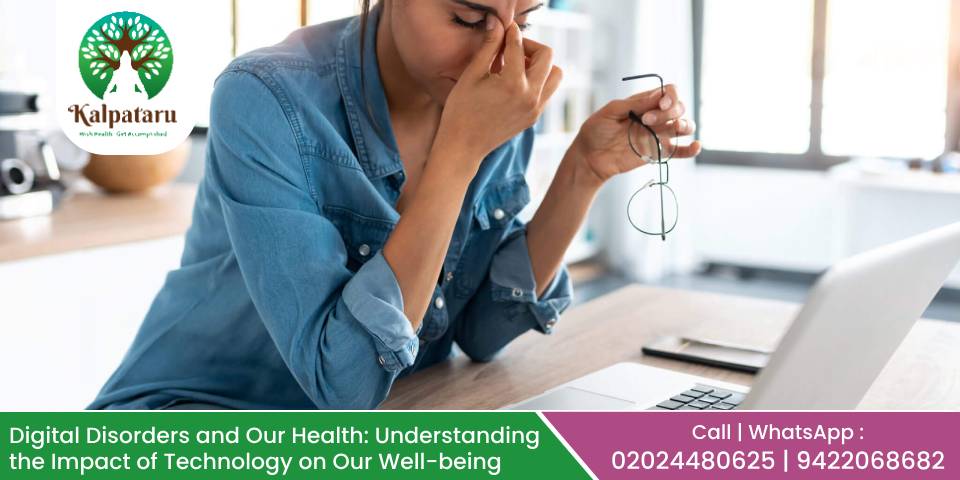
02Sep
Digital Disorders and Our Health: Understanding the Impact of Technology on Our Well-being
In the digital world, technology has become an essential part of our daily lives, impacting how we work, communicate, and relax. While digitalization have undoubtedly brought many benefits, the increasing dependence on technology has also given rise to a set of health concerns collectively referred to as "digital disorders." These disorders are associated with extreme or inappropriate use of digital devices such as smartphones, computers, and gaming tools, which can badly affect both physical and mental health. Types of Digital Disorders: Computer Vision Syndrome (CVS): Staring at screens for prolonged periods can lead to eye stress, blurred vision, and headaches. Known as CVS or digital eye strain, this condition is a result of reduced blinking and constant focusing on digital screens.Text Neck Syndrome: Constantly looking down at smartphones or tablets can cause strain on the neck muscles and lead to poor posture, commonly known as "text neck." Over time, this can result in chronic neck pain and spinal issues.Carpal Tunnel Syndrome: Repetitive use of keyboards and mouse can cause inflammation in the wrist, leading to carpal tunnel syndrome. This condition results in pain, tingling, and numbness in the hands and fingers, often requiring medical intervention.Insomnia and Sleep Disorders: The blue light emitted from digital devices can interfere with the production of melatonin, the hormone responsible for regulating sleep. Excessive use of smartphones and computers, especially before bedtime, can lead to insomnia and other sleep disorders.Smartphone Addiction: The constant need to check notifications, social media, and messages has led to a rise in smartphone addiction. This behavioral addiction can affect daily functioning, reduce productivity, and lead to increased anxiety and stress.Gaming Disorder: Excessive video gaming has been recognized by the World Health Organization (WHO) as a mental health condition. Gaming disorder is characterized by impaired control over gaming, increased priority given to gaming over other activities, and continuation of gaming despite negative consequences.Digital Dementia: A relatively new term, digital dementia refers to the cognitive decline associated with the overuse of digital devices. Constant multitasking and dependence on technology for memory and information can weaken cognitive skills, particularly in younger individuals.Social Media Anxiety and Depression: The use of social media platforms can lead to feelings of inadequacy, anxiety, and depression. Constant comparison with others, exposure to negative content, and cyberbullying are contributing factors to mental health issues related to social media use.Nomophobia (Fear of Being Without a Mobile Phone): The fear of being disconnected from a mobile device, known as nomophobia, is becoming increasingly common. People experience anxiety and discomfort when they are unable to access their phones, which can disrupt daily life and relationships. Physical Health Impacts: Sedentary Lifestyle: Prolonged use of digital devices often results in a sedentary lifestyle, which is linked to various health problems, including obesity, cardiovascular diseases, and diabetes. The lack of physical activity due to excessive screen time can have long-term consequences on overall health.Musculoskeletal Problems: Poor posture while using digital devices can lead to musculoskeletal disorders, such as back pain, neck pain, and joint problems. Sitting for long hours without proper posture or breaks can exacerbate these issues.Obesity and Weight Gain: Excessive screen time is often associated with unhealthy eating habits and reduced physical activity, leading to weight gain and obesity. This can further increase the risk of developing lifestyle-related diseases. Mental Health Impacts: Increased Stress and Anxiety: Constant connectivity and the pressure to stay updated with digital content can lead to heightened stress and anxiety levels. The need to respond immediately to messages, emails, and notifications creates a sense of urgency, contributing to mental strain.Attention Deficit: The constant bombardment of information and notifications from digital devices can lead to shorter attention spans and difficulty concentrating on tasks. This phenomenon, often referred to as "digital distraction," affects productivity and cognitive function.Depression and Isolation: Extreme use of digital channels, particularly social media, can lead to feelings of loneliness and depression. Online interactions can sometimes replace face-to-face social connections, leading to social isolation and a sense of disconnection.Impact of Social Media and Reels: Extreme digital activity, especially through reels and platforms like Instagram, keeps the brain in a constant state of alertness. This leads to increased dopamine levels, causing continuous scrolling and a desire for constant excitement. When excitement declines, users lose interest in clips and he always seeking thrilling content. When disengaged from mobile devices and returning to normal life, dopamine levels drop, making it difficult to find joy in everyday activities. This can result in depression, disinterest in activities, and difficulties in connecting with family and friends.Pornography: Pornography also negatively impacts the overall personality of individuals, particularly affecting their family and marital relationships. Research shows that, in India, a significant portion of internet usage is dedicated to viewing pornography. This alarming trend has placed India at the top spot globally, surpassing the United States. The overall consumption of pornography can create problems in personal relationships, contributing to further emotional and relational challenges. For more information and treatment modalities watch our informative video https://www.youtube.com/watch?v=B0rLw8GZG28&t=5shttps://www.youtube.com/watch?v=B1Xjs_KLqaA&t=3s Preventing Digital Disorders: While the digital age is here to stay, there are several steps individuals can take to mitigate the risks associated with digital disorders:Practice Digital Detox: Regular breaks from digital devices, especially during leisure time, can help reduce stress and prevent digital fatigue. Setting boundaries on screen time and engaging in outdoor activities can provide a much-needed break from technology.Ergonomics and Posture: Ensuring proper ergonomics while using digital devices is essential to avoid musculoskeletal problems. Using chairs that support good posture, adjusting screen height, and taking frequent breaks to stretch can help prevent strain.Use Blue Light Filters: Blue light filters on screens can reduce eye strain and minimize the impact of digital devices on sleep patterns. Many devices now offer night mode settings that automatically adjust the color temperature of the screen.Mindful Use of Social Media: Limiting the time spent on social media and curating content that positively impacts mental health can help reduce anxiety and depression. Engaging in meaningful real-life social interactions is also crucial for maintaining mental well-being.Digital Wellness Apps: Several apps are designed to help users track and manage their screen time. These apps can set usage limits, remind users to take breaks and provide insights into digital habits, encouraging healthier use of technology.Encourage Physical Activity: Incorporating regular exercise into daily routines can counterbalance the effects of a sedentary lifestyle caused by excessive screen time. Simple activities such as walking, yoga, or stretching can improve physical and mental health.Seek Professional Help: If digital disorders begin to significantly impact daily life, seeking professional help from a healthcare provider or therapist is essential. Cognitive-behavioral therapy (CBT) and counseling can help address underlying issues related to digital addiction and other disorders. Conclusion: Digital disorders are an emerging concern in our tech-driven society. While technology offers numerous advantages, it is crucial to be aware of the potential health risks associated with excessive use of digital devices. By adopting healthy digital habits, setting boundaries, and staying mindful of screen time, we can protect our physical and mental well-being in the digital age.Dr. Manoj Deshpande and Dr. Aparna Deshpande at Kalpataru Ayurvediya Chikitsalaya™ Clinic provide the best Ayurvedic Treatment for Psoriasis & various diseases in Pune, Maharashtra. For more information about our comprehensive treatment options, or to requestan appointment with the best Ayurvedic Doctor in Pune, call +919422068682 / +919764837167 / 020-24480625 or Click on Book an Appointment.
Read More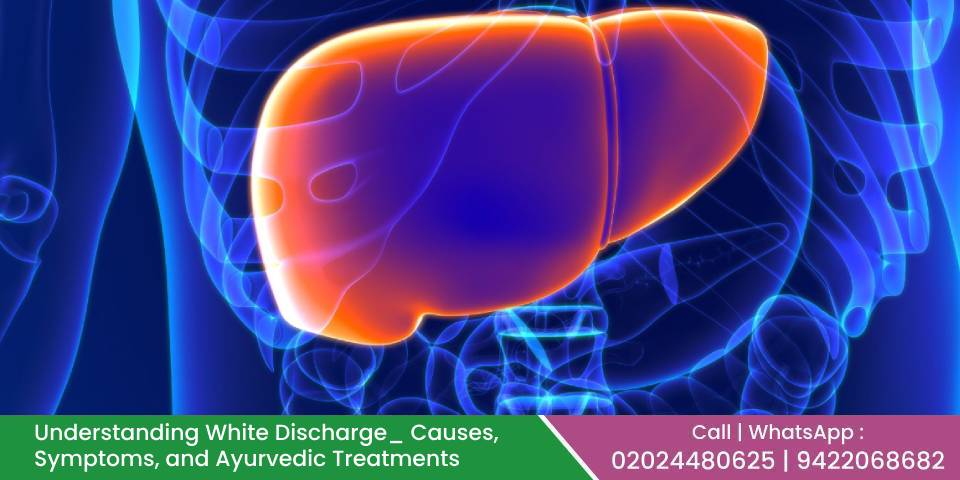
26Aug
How to Prevent and treat Fatty Liver Disease with Ayurveda
The liver is one of the most vital organs in the human body, essential for life. While we can live with just one kidney, and even survive without our spleen, gallbladder, or stomach, life without a functioning liver is impossible. The liver is the largest internal organ, performing nearly 500 different functions necessary for our health. If the liver begins to fail, it can lead to serious illness and eventually death. This makes it crucial to care for our liver. Why the Liver Is So Important? When we eat food or drink beverages, the nutrients are absorbed through the stomach and intestines into the bloodstream. The first stop for these nutrients is the liver. Here, the liver metabolizes the nutrients, converting them into forms that the body can use. It also plays a key role in detoxifying harmful substances, ensuring that toxins are broken down and safely eliminated from the body. Without the liver, toxins would accumulate, and the body would be unable to function properly.One of the liver's most important tasks is regulating and processing nutrients, fats, proteins, and carbohydrates. It stores glucose for energy, produces bile to aid in digestion, and helps the body fight infections. In addition, it plays a role in hormone regulation and blood clotting. Given the number of critical functions it performs, it's easy to see why maintaining liver health is so important. Causes of Liver Damage: Liver damage can occur due to various factors, including excessive alcohol consumption, fatty liver disease, and certain medications. Research shows that even one week of consuming unhealthy junk food can cause elevated liver enzyme levels, indicating stress on the liver.One of the most common liver conditions is fatty liver disease. If not treated in its early stages, fatty liver disease can progress, leading to scarring (fibrosis) of the liver. Over time, this scarring can develop into cirrhosis, a condition that can result in liver failure or liver cancer, ultimately leading to death. The Role of Cholesterol in Liver Disease: Many diseases begin with increased cholesterol levels. When cholesterol oxidizes, it starts to accumulate in liver cells. After a certain limit, this oxidized cholesterol crystallizes. White blood cells (WBCs) attack these crystals, which leads to their death. During this process, certain inflammatory compounds are produced, causing inflammation in the liver cells. This inflammation can lead to hepatitis. As the pathology of fatty liver disease progresses, the damage becomes more severe, increasing the risk of serious liver conditions.Therefore, to prevent fatty liver disease, it is essential to reduce the consumption of cholesterol, bad fats, and sugar, and to avoid overeating. Risk Factors for Fatty Liver Disease: Fatty liver disease can be triggered by several factors:Alcohol consumption: Alcohol is a leading cause of liver damage and fatty liver disease.Obesity: Excess weight can lead to fat accumulation in the liver, causing fatty liver disease.Diabetes: People with diabetes are at a higher risk of developing fatty liver disease due to insulin resistance.High cholesterol and triglycerides: Elevated levels of cholesterol and triglycerides can increase the risk of liver disease.Unhealthy diet: A diet high in sugars, refined carbohydrates, and unhealthy fats can contribute to fatty liver disease.Certain medications: Drugs such as steroids, methotrexate, and estrogen can also increase the risk of fatty liver disease. Symptoms of Fatty Liver Disease: In the early stages, fatty liver disease may not cause any noticeable symptoms. However, as the condition progresses, symptoms such as fatigue, discomfort in the upper abdomen, and a general feeling of illness can occur. It is important to recognize these symptoms early and seek medical advice to prevent further damage. Preventing Fatty Liver Disease: Preventing fatty liver disease requires lifestyle changes that promote liver health. Here are some steps that can help:Adopt a plant-based diet: Eating more fruits, vegetables, legumes, whole grains, nuts, and seeds can help reduce the risk of fatty liver disease. These foods are rich in nutrients and antioxidants that support liver function.Reduce sugar intake: Excessive sugar consumption can lead to fat accumulation in the liver, contributing to fatty liver disease. Limiting the intake of sugary foods and drinks is essential for liver health.Limit unhealthy fats: Consuming too much bad fat, such as trans fats and saturated fats, can lead to fatty liver disease. Choose healthy fats, such as those found in olive oil, avocados, and nuts, instead.Eat in moderation: Overeating puts extra stress on the liver and can contribute to fat buildup. Practice portion control and avoid eating beyond your hunger.Exercise regularly: Physical activity helps maintain a healthy weight and reduces the risk of fatty liver disease. Aim for at least 30 minutes of exercise most days of the week.Avoid alcohol: Excessive alcohol consumption is one of the leading causes of liver damage. Limiting alcohol intake can protect your liver from harm.Get enough sleep: Adequate sleep is crucial for liver health. Poor sleep can lead to insulin resistance and weight gain, which can contribute to fatty liver disease. For more information and treatment modalities watch our informative video https://www.youtube.com/watch?v=5itLtStqA3chttps://www.youtube.com/watch?v=SXHfxYu1A5w&t=2s How Ayurveda Can Help You? Kalpataru Ayurvediya Chikitsalaya™, offers holistic approaches to improving liver health and preventing fatty liver disease. Ayurvedic practices focus on balancing the body's doshas (energies) and eliminating toxins. For liver health, Ayurveda recommends:Herbal remedies: Herbs like Kalmegh (Andrographis paniculata), Bhumyamalaki (Phyllanthus niruri), Trifala, Guduchi, Punarnava, Bhrungraj, Turmeric etc are known for their hepatoprotective properties, helping detoxify and rejuvenate the liver.Dietary changes: Ayurveda emphasizes a diet rich in fresh, organic foods that are easy to digest. Bitter-tasting vegetables, such as bitter gourd, and certain spices like Turmeric and Ginger, can improve liver function and help cleanse the liver.Panchakarma therapy: This detoxification process in Ayurveda includes procedures such as Virechana (therapeutic purgation) to cleanse the liver and other organs of accumulated toxins.Lifestyle modifications: Ayurveda advocates for regular exercise, stress management techniques like yoga and meditation, and maintaining a routine that supports overall health, all of which contribute to liver wellness.Ayurveda can play a significant role in maintaining liver health through natural methods, making it an excellent complementary approach alongside modern medical practices. During reasearch in various institutes, ayurvedic herbs are found to be very potent capable of reversing fatty liver disease . Conclusion: The liver is a vital organ that performs many essential functions, making its health crucial to overall well-being. Fatty liver disease is a growing concern due to unhealthy lifestyles and diets. However, with the right lifestyle changes—such as adopting a plant-based diet, reducing sugar intake, exercising regularly, and avoiding alcohol—fatty liver disease can be prevented. Taking care of your liver now can protect you from serious health problems in the future.
Read More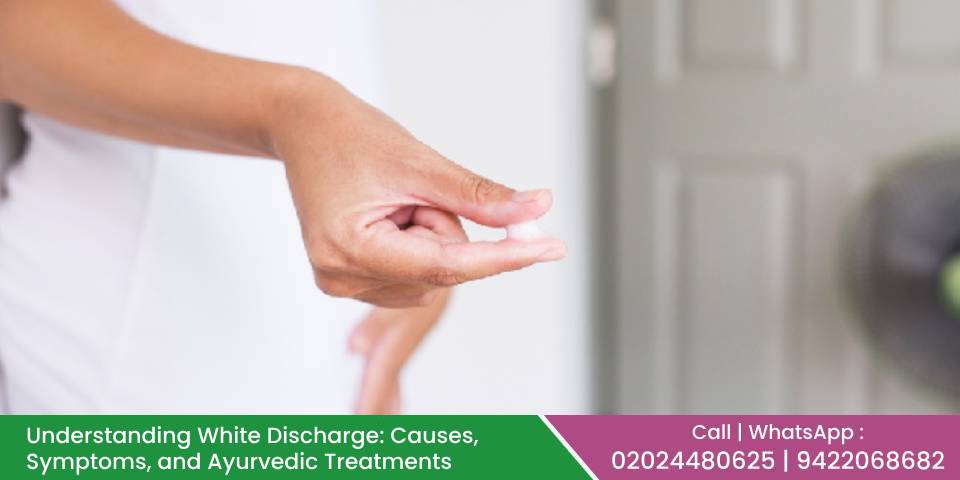
21Aug
Understanding White Discharge: Causes, Symptoms, and Ayurvedic Treatments
White discharge, also known as leucorrhea, is a common occurrence among women. While a small amount of discharge is normal, any changes in its consistency, color, or smell may indicate an underlying condition that requires treatment. Generally, normal white discharge is clear or white and has no strong odor. However, if the discharge becomes dark yellow, gray, has a foul smell, or is accompanied by itching or burning sensations, it is essential to seek medical attention. Types of Infections: When white discharge becomes abnormal, it could indicate an infection. The two most common types of infections are bacterial and fungal. Fungal infections typically result in a thick, curd-like discharge resembling cottage cheese. These infections may also cause swelling, pain, and intense itching in the affected area. Additionally, certain sexually transmitted infections (STIs) can also lead to abnormal white discharge. Importance of Treatment: Untreated infections can spread throughout the genital system, leading to more severe complications. Allergies to specific medications, soaps, detergents, or condoms can also trigger white discharge. Therefore, it is crucial to identify the cause and seek appropriate treatment to prevent further health issues. Pregnancy and White Discharge: During pregnancy, an increase in white discharge is common. This discharge serves a protective purpose, helping to prevent infections from reaching the uterus. While increased discharge during pregnancy is generally not a cause for concern, it's essential to monitor any significant changes. Other Contributing Factors: Several factors contribute to abnormal white discharge, including diabetes, low immunity, and improper vaginal hygiene practices. The frequent use of vaginal douches or hygiene products marketed for cleansing the vaginal area can be harmful, causing irritation or allergic reactions that lead to discharge. Similarly, oral contraceptive pills (OCPs) can disrupt the natural balance of the vaginal flora, resulting in discharge. Preventive Measures: To avoid recurrent issues with white discharge, it is recommended to wear loose-fitting innerwear and maintain proper hygiene by cleaning from front to back to prevent the spread of infections from the rectal area to the vaginal area. For more information and treatment modalities watch our informative video https://www.youtube.com/watch?v=2EnJAzatph8&t=3s Ayurvedic Perspective on White Discharge: In Ayurveda, this condition is referred to as "Pradar," which can be categorized into two types: Rakta Pradar (excessive bleeding) and Shweta Pradar (white discharge). The causes of Shweta Pradar are linked to the imbalance of the Kapha Dosha.Ayurvedic treatment for white discharge involves two main approaches:Bruhana Chikitsa (Nourishing Treatment): This treatment strengthens the genital system and boosts local immunity to prevent recurrent infections and allergies. Herbs like Shatavari, Ashwagandha, Kushmand, and medicines like Laghu Malini Vasant are commonly used.Stambhana Chikitsa (Astringent Treatment): This treatment focuses on reducing excessive secretions from the genital area. Herbs like Lodhra, Dhataki, Daruharidra, Nagarmotha, Sariva, Yashtimadhu (Licorice), and Amla are utilized for this purpose. Pushyanug Churna is a particularly effective remedy, and its efficacy increases when taken with rice water. Vaginal Cleansing (Yoni Prakshalan): Ayurveda recommends vaginal cleansing (Yoni Prakshalan) as a treatment for infections, swelling, burning sensations, itching, and abnormal discharge. Herbal decoctions made from Triphala or Panchvalkala are used for vaginal douching to alleviate these symptoms and reduce excessive discharge. Conclusion: White discharge, while often harmless, can sometimes signal underlying health issues that need attention. Timely treatment, proper hygiene, and Ayurvedic interventions can help manage and prevent recurrent infections. If you notice any unusual symptoms related to white discharge, consulting a healthcare professional for appropriate diagnosis and treatment is essential.Dr. Manoj Deshpande and Dr. Aparna Deshpande at Kalpataru Ayurvediya Chikitsalaya™ Clinic provide the best Ayurvedic Treatment for Psoriasis & various diseases in Pune, Maharashtra. For more information about our comprehensive treatment options, or to requestan appointment with the best Ayurvedic Doctor in Pune, call +919422068682 / +919764837167 / 020-24480625 or Click on Book an Appointment.
Read More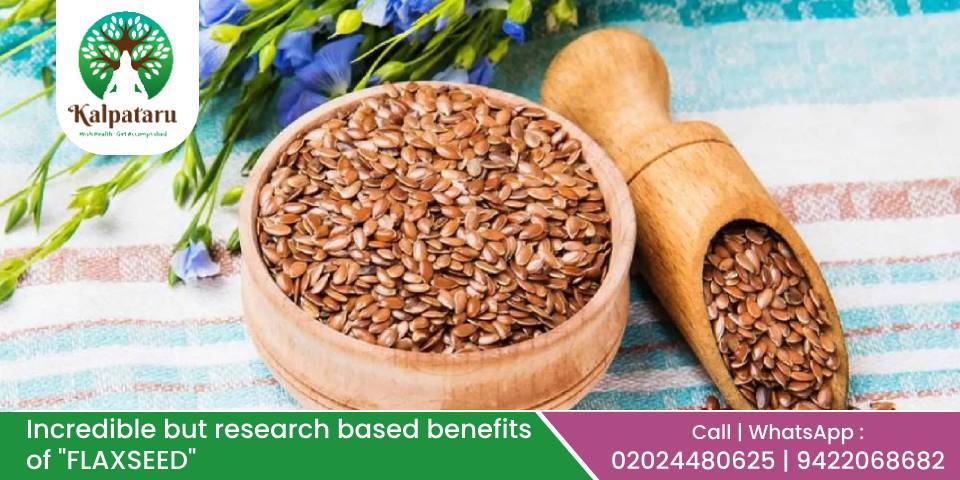
10Aug
Incredible but research based benefits of “FLAXSEED”
Flaxseeds, known as "जवस" (Javas) in Marathi and "अलसी" (Alsi) in Hindi, are small yet powerful seeds packed with a multitude of health benefits. They have been revered in traditional medicine for centuries and are now gaining popularity in modern health and wellness circles. These nutrient-dense seeds are rich in essential fatty acids, fiber, and unique compounds that contribute to overall well-being. Whether added to your diet for their potential to prevent certain types of cancer, support heart health, or improve digestive function, flaxseeds are a versatile superfood worth incorporating into your daily routine. Key Components of Flaxseeds: One of the critical active components in flaxseeds is lignans, which are rich in phytoestrogens. Phytoestrogens are plant-based compounds that mimic estrogen in the body. They can suppress excess estrogen in women, particularly helping in reducing the risk of breast cancer. Research has shown that in laboratory experiments, when breast cancer cells were treated with flaxseed powder, the growth of these cancer cells was significantly reduced. Thus, incorporating flaxseeds in the diet can be beneficial in preventing the progression of breast cancer, especially in postmenopausal women. For more information and treatment modalities watch our informative video https://www.youtube.com/watch?v=qgFpj_xuxBo&t=2s Benefits for Prostate Health: Flaxseeds are also beneficial for prostate health. Prostate cancer and the enlargement of the prostate gland are common issues among men today. Comparative studies, including double-blind, randomized, placebo-controlled trials, have shown that consuming flaxseeds can be more effective than some conventional medications in managing prostate conditions. Thus, flaxseeds can be a valuable dietary addition for maintaining prostate health.Impact on Blood Pressure: Trials have demonstrated that flaxseeds can help reduce blood pressure. Regular consumption of flaxseeds can lower systolic blood pressure by 15 points and diastolic blood pressure by 7 points. When compared with calcium channel blockers (a class of allopathic medications), flaxseeds have shown similar or better efficacy in reducing blood pressure after three months of regular intake.Cardiovascular Benefits: Flaxseeds are effective in lowering cholesterol and triglycerides, reducing the risk of atherosclerosis. This, in turn, helps prevent heart diseases, vascular diseases, and conditions like paralysis and stroke, making flaxseeds a heart-healthy food.Digestive Health: Flaxseeds are rich in soluble fiber, which aids in relieving constipation. They also have anti-inflammatory properties, which help reduce inflammation in the body, benefiting those with joint pain and muscle pain.Daily Consumption: Incorporating at least two tablespoons of flaxseeds into your daily diet is recommended. However, for maximum benefits, it is crucial to grind the seeds or consume them in powdered form, as whole flaxseeds can pass through the digestive system undigested.Weight Management: Flaxseeds are a valuable addition to any weight management plan. Rich in dietary fiber, they promote a feeling of fullness, which can help reduce overall calorie intake. The high content of omega-3 fatty acids and lignans in flaxseeds also supports metabolic health.Skin Care: Flaxseeds are a powerhouse for skin health, thanks to their high content of omega-3 fatty acids, antioxidants, and lignans. These nutrients help maintain skin hydration, reduce inflammation, and promote a healthy, radiant complexion.Culinary Uses: In Maharashtrian cuisine, "Javasachi chutney" (flaxseed chutney) made with garlic and flaxseeds is a popular dish. Sprinkling flaxseed powder on salads and other dishes is an easy way to include them in your diet. Summary: According to Ayurveda, flaxseeds can increase Pitta and Kapha doshas but reduce Vata dosha. They are packed with essential fatty acids, fiber, and lignans, which are phytoestrogens that may help reduce the risk of breast cancer, particularly in postmenopausal women. Flaxseeds also support prostate health, lower blood pressure, improve heart health by reducing cholesterol and triglycerides, aid digestion, and promote weight management. Additionally, they are beneficial for skin care and can be easily incorporated into the diet, such as through "Javasachi chutney" in Maharashtrian cuisine. To maximize their benefits, it's recommended to consume them in ground or powdered form.Dr. Manoj Deshpande and Dr. Aparna Deshpande at Kalpataru Ayurvediya Chikitsalaya™ Clinic provide the best Ayurvedic Treatment for Psoriasis & various diseases in Pune, Maharashtra. For more information about our comprehensive treatment options, or to request an appointment with the best Ayurvedic Doctor in Pune, call +919422068682 / +919764837167 / 020-24480625 or Click on Book an Appointment
Read More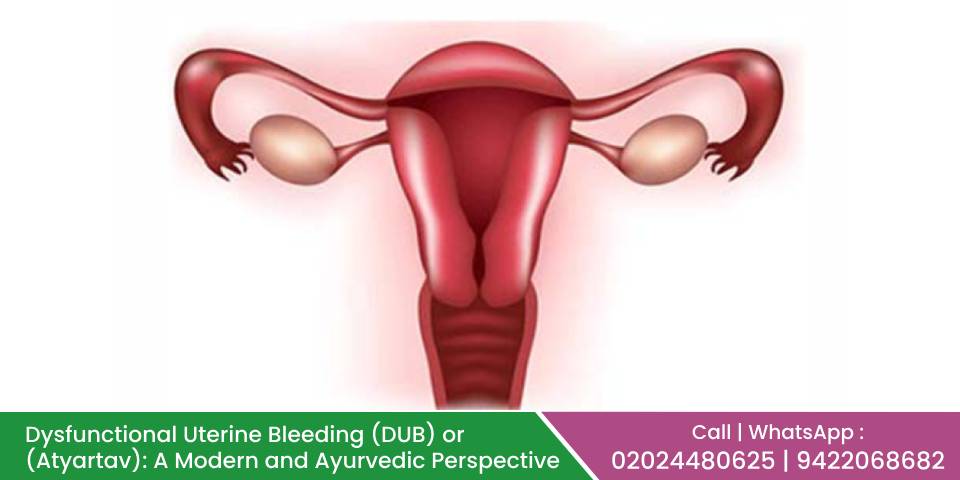
05Aug
Dysfunctional Uterine Bleeding (DUB) or (Atyartav): A Modern and Ayurvedic Perspective
Are you tired of heavy menstrual bleeding disrupting your life? Discover the holistic power of Ayurveda in managing Dysfunctional Uterine Bleeding (DUB) and Heavy Menstruation (Atyartav). Learn how modern ancient Ayurvedic wisdom can provide a comprehensive solution, helping you regain control and improve your well-being without invasive procedures. Dive into our insightful guide and explore the path to a balanced, healthier you! Modern Understanding of Dysfunctional Uterine Bleeding (DUB): Aetiology and Causes: Hormonal Imbalance: The disruption in the balance of estrogen and progesterone can lead to heavy menstrual bleeding. This is often seen in women during puberty and menopause when hormonal fluctuations are more pronounced.Uterine Conditions: Structural issues in the uterus such as fibroids, polyps, adenomyosis, and endometriosis can contribute to heavy menstrual bleeding.Medical Conditions: Underlying medical conditions like thyroid disorders, clotting disorders, liver, or kidney diseases can also cause excessive menstrual bleeding.Medications: Certain medications, especially blood thinners and hormonal treatments, can affect menstrual bleeding patterns.Pregnancy Complications: Miscarriage, ectopic pregnancy, or trophoblastic disease are pregnancy-related complications that can result in heavy bleeding.Pathophysiology: DUB often results from an imbalance in the hypothalamic-pituitary-ovarian axis, leading to irregular endometrial shedding. Structural abnormalities in the uterus can also contribute to excessive bleeding. Symptoms: Heavy menstrual bleeding.Prolonged menstrual periods.Bleeding between periods.Severe menstrual cramps.Symptoms of anemia such as fatigue, weakness, and shortness of breath. Complications: Anemia due to excessive blood loss.Severe pain and cramping affecting daily activities.Disruption in daily activities and quality of life.Fertility issues. For more information and treatment modalities watch our informative video https://www.youtube.com/watch?v=dGOaFwMxD0I&t=27shttps://www.youtube.com/watch?v=of-CD88N-m8&t=1s Ayurvedic Perspective on Dysfunctional Uterine Bleeding (Atyartav): Causes: Imbalance in Teja and Vata Doshas:In Ayurveda, an imbalance in the Teja (fire element) can lead to excessive bleeding. The disturbance in Vata dosha causes issues in the downward flow, which increases menstrual bleeding.Diet and Lifestyle Factors:Consumption of spicy, oily, and junk foods can aggravate Teja and Vata doshas.Excessive physical activity or a sedentary lifestyle can also contribute to the imbalance.Irregular sleep patterns and high levels of stress are known to exacerbate menstrual issues. Treatment Approaches: Avoiding Surgery:Even in menopausal age, surgery comes with its own side effects such as infection, bleeding, complications from anesthesia, and post-operative infections. Therefore, it is crucial for women to explore Ayurvedic treatments before opting for surgery to see if their bleeding can be controlled without surgical intervention.Ayurvedic Medicines:The medicines used in Ayurvedic treatment are administered with a specific vehicle called "tandulodaka" (rice water). This involves soaking rice overnight in water and using the milky water as a vehicle for the medicines, which enhances their efficacy.Common herbs used include Ashoka (Saraca indica), Lodhra (Symplocos racemosa), Suvarna Gairik (Red ochre), Guduchi (Tinospora cordifolia), Laksha (Laccifer lacca), and Jambool (Syzygium cumini) bark. These herbs have properties that help in balancing hormones, reducing inflammation, promoting coagulation, and enhancing immunity. Dietary Recommendations: Dietary advice is also very important in managing DUB. The aim is to stop the bleeding and address the anemia caused by excessive blood loss.Consuming pomegranate, ragi (finger millet), black raisins, and amaranth is beneficial for increasing hemoglobin levels and overall health.Avoid spicy, oily, and junk foods, and include iron-rich foods to combat anemia. Success at Kalpataru Ayurvedic Dermatology Speciality Clinic: hundreds of women have successfully avoided hysterectomy surgery through these Ayurvedic treatments. By employing specific Ayurvedic treatments and lifestyle modifications, many patients have been able to manage their symptoms effectively and avoid the complications associated with surgical interventions. Conclusion: Dysfunctional Uterine Bleeding (DUB) or Heavy Menstruation (Atyartav) is a condition that affects many women and can significantly impact their quality of life. While modern medicine offers various treatments, Ayurveda provides a holistic approach that can help manage and often alleviate the symptoms without the need for invasive procedures. Understanding both perspectives and integrating Ayurvedic principles into treatment plans can offer a more comprehensive and effective solution for managing DUB.If you or someone you know is struggling with heavy menstrual bleeding, consider exploring Ayurvedic treatments. With the right approach, it's possible to manage the condition effectively and improve overall health and well-being.Dr. Manoj Deshpande and Dr. Aparna Deshpande at Kalpataru Ayurvediya Chikitsalaya™ Clinic provide the best Ayurvedic Treatment for Psoriasis & various diseases in Pune, Maharashtra. For more information about our comprehensive treatment options, or to requestan appointment with the best Ayurvedic Doctor in Pune, call +919422068682 / +919764837167 / 020-24480625 or Click on Book an Appointment.
Read More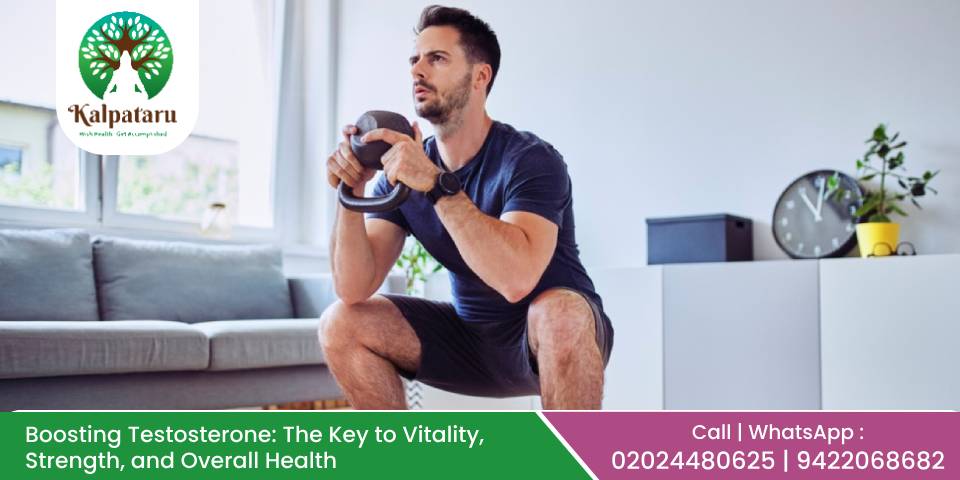
29Jul
Boosting Testosterone: The Key to Vitality, Strength, and Overall Health
Testosterone is a primary male sex hormone that plays a crucial role in the development and maintenance of male characteristics and reproductive functions. It is produced mainly in the testicles in men and in smaller amounts in the ovaries in women and the adrenal glands in both sexes. Here are some key functions of testosterone:Development of Male Characteristics: Responsible for the development of male secondary sexual characteristics such as deepening of the voice, growth of facial and body hair, and development of muscle mass and strength.Reproductive Function: Essential for sperm production and maintaining libido.Muscle and Bone Health: Promotes muscle growth and bone density.Metabolism: Influences fat distribution and muscle mass, contributing to overall metabolic health.Cognitive Function: Affects brain functions such as memory, mood, and cognitive abilities.Cardiac Health: Plays a role in maintaining cardiovascular health. Normal Testosterone Levels: Men: Normal testosterone levels in adult men typically range from 300 to 1,000 nanograms per deciliter (ng/dL).Women: Normal levels in adult women range from 15 to 70 ng/dL. Causes of Low Testosterone Levels in the Current Generation: Several factors can contribute to low testosterone levels in the current generation:Lifestyle Choices: Poor diet, lack of exercise, and inadequate sleep can negatively impact testosterone production.Stress: High levels of stress increase cortisol, a hormone that can suppress testosterone production.Obesity: Excess body fat, especially around the abdomen, can lower testosterone levels.Environmental Factors: Exposure to endocrine-disrupting chemicals found in some plastics, pesticides, and other pollutants.Medical Conditions: Conditions like diabetes, metabolic syndrome, and chronic illnesses can affect hormone levels. Symptoms of Low Testosterone: Decreased libidoErectile dysfunctionFatigue and low energyLoss of muscle mass and strengthIncreased body fatDepression and mood swingsReduced cognitive abilities Testosterone and Overall Health: Testosterone is not just a sex-related hormone. Its effects are far-reaching and include:Muscle Strength: Maintains muscle mass and strength.Metabolism: Regulates fat distribution and contributes to metabolic health.Insulin Levels: Influences insulin sensitivity, affecting blood sugar levels.Cardiac Activity: Supports heart health.Cognitive Health: Affects brain functions, including memory and mood. Research on Physical Activity and Testosterone Levels: Research indicates that individuals with higher levels of physical activity tend to have higher testosterone levels. A structured 12-week program that includes at least 40-50 minutes of cardio exercise four days a week can significantly boost testosterone levels, offering multiple benefits for men. For more information and treatment modalities watch our informative video https://www.youtube.com/watch?v=0-ddAiAbREM&t=52shttps://www.youtube.com/watch?v=lPvApxSE8mc&t=16s Diet and Testosterone: Certain dietary factors can influence testosterone levels:Dry Fruits and Nuts: Studies have shown that foods like pistachios can improve testosterone levels and performance in men.Balanced Diet: Consuming a diet rich in vitamins and minerals, such as zinc and vitamin D, is essential for maintaining healthy testosterone levels. Modern Lifestyle and Its Impact: Today's fast-paced lifestyle, characterized by fast food consumption, irregular eating habits, and inadequate sleep, can lead to increased cortisol levels. High cortisol levels counteract testosterone, leading to lower levels of this crucial hormone.By making informed lifestyle and dietary choices, including regular exercise and consuming testosterone-boosting foods like pistachios, individuals can improve their testosterone levels and overall health. Conclusion: Testosterone is essential for various aspects of male health, including muscle strength, metabolism, and cognitive function. Modern lifestyle factors like poor diet, lack of exercise, and stress can lower testosterone levels. Symptoms of low testosterone include decreased libido, fatigue, and cognitive issues. However, regular physical activity and a balanced diet, including foods like pistachios, can significantly boost testosterone levels. Making these lifestyle changes can enhance overall well-being and mitigate the effects of low testosterone.There are several herbs described in Ayurved which show very encouraging results during research for boosting testosterone. E.g. Ashwagandha, Shatawari, Kavach beej, Safed musli etc.Dr. Manoj Deshpande and Dr. Aparna Deshpande at Kalpataru Ayurvediya Chikitsalaya™ Clinic provide the best Ayurvedic Treatment for Psoriasis & various diseases in Pune, Maharashtra. For more information about our comprehensive treatment options, or to requestan appointment with the best Ayurvedic Doctor in Pune, call +919422068682 / +919764837167 / 020-24480625 or Click on Book an Appointment.
Read More
21Jul
Embrace Wholesome Wellness: Path to Avoiding Processed Foods
In the fast-paced modern world, convenience often dictates our food choices. Processed foods, loaded with preservatives, artificial flavors, and unhealthy fats, have become a staple in many diets. However, from an Ayurvedic perspective, these foods are far from nourishing and can disrupt the body's natural balance. Embracing whole foods is not only a return to simpler eating but also a powerful step towards holistic health. Understanding Ayurveda and Whole Foods: Ayurveda, the ancient Indian system of medicine, emphasizes the importance of eating fresh, natural, and whole foods. These foods are rich in Prana (life force), which nourishes the body, mind, and spirit. In contrast, processed foods are considered Tamasic (dull and lifeless), contributing to lethargy, disease, and imbalance. The Ayurvedic approach to diet is one of mindfulness, balance, and harmony with nature. The Benefits of Whole Foods: Enhanced Digestion and Absorption: Whole foods are easier to digest and assimilate, providing the body with essential nutrients. Fresh fruits, vegetables, whole grains, nuts, and seeds are packed with vitamins, minerals, and fiber, promoting healthy digestion. Ayurveda places great emphasis on Agni, the digestive fire. Whole foods support Agni, ensuring that food is properly broken down and nutrients are absorbed efficiently.Balanced Doshas: Ayurveda teaches that everyone has a unique constitution, or dosha, which can be balanced through diet. Whole foods help maintain the balance of Vata, Pitta, and Kapha doshas, preventing various ailments. For instance, cooling foods like cucumbers and melons can help balance Pitta, while grounding foods like root vegetables are excellent for calming Vata.Improved Energy and Vitality: Eating whole foods boosts energy levels and enhances overall vitality. These foods support mental clarity, physical strength, and emotional stability. Foods rich in Prana, such as fresh fruits and leafy greens, invigorate the body and mind, promoting a sense of well-being and zest for life.Detoxification and Healing: Whole foods aid in detoxifying the body, flushing out toxins accumulated from processed foods. They support the body's natural healing processes, reducing inflammation and promoting longevity.Ayurvedic practices such as seasonal cleansing and incorporating detoxifying herbs like turmeric and ginger further enhance the body's ability to heal and regenerate. For more information and treatment modalities watch our informative video https://www.youtube.com/watch?v=PCYTM8hHQrc&t=19s Tips for Embracing Whole Foods: Choose Seasonal and Local Produce: Eating seasonal fruits and vegetables ensures you get the freshest and most nutritious options. Seasonal eating aligns with the natural cycles and helps balance the doshas according to the time of year.Incorporate Variety: Include a diverse range of whole foods in your diet to cover all nutritional bases. A colorful plate is not only visually appealing but also nutritionally beneficial, as different colors indicate a variety of nutrients.Cook at Home: Preparing meals at home allows you to control the ingredients and avoid unnecessary additives. Cooking with love and intention adds a subtle, positive energy to your food, enhancing its nourishment.Mindful Eating: Practice mindful eating by savoring each bite, which aids digestion and promotes satisfaction. Mindfulness during meals can help you become more attuned to your body's hunger and satiety signals, preventing overeating.Hydrate Naturally: Drink a sufficient quantity of water, herbal teas, and fresh fruit juices to stay hydrated.Avoid sugary sodas and artificial beverages which can disturb the balance of doshas and hinder digestion.Incorporate Ayurvedic Superfoods: Use spices and herbs like turmeric, cumin, coriander, and ginger, which have medicinal properties and enhance the flavor of your meals.Ghee (clarified butter) is another Ayurvedic staple, known for its digestive and anti-inflammatory benefits. Conclusion: Switching from processed foods to whole foods is not just a dietary change; it's a lifestyle shift toward holistic wellness. By embracing the Ayurvedic principles of eating, you can enhance your health, vitality, and overall well-being. Make the conscious choice to nourish your body with whole foods, and experience the profound benefits of Ayurvedic living. Remember, food is not just fuel for the body; it's a vital component of your overall health and a key to unlocking your full potential.Dr. Manoj Deshpande and Dr. Aparna Deshpande at Kalpataru Ayurvediya Chikitsalaya™ Clinic provide the best Ayurvedic Treatment for Psoriasis & various diseases in Pune, Maharashtra. For more information about our comprehensive treatment options, or to requestan appointment with the best Ayurvedic Doctor in Pune, call +919422068682 / +919764837167 / 020-24480625 or Click on Book an Appointment.
Read More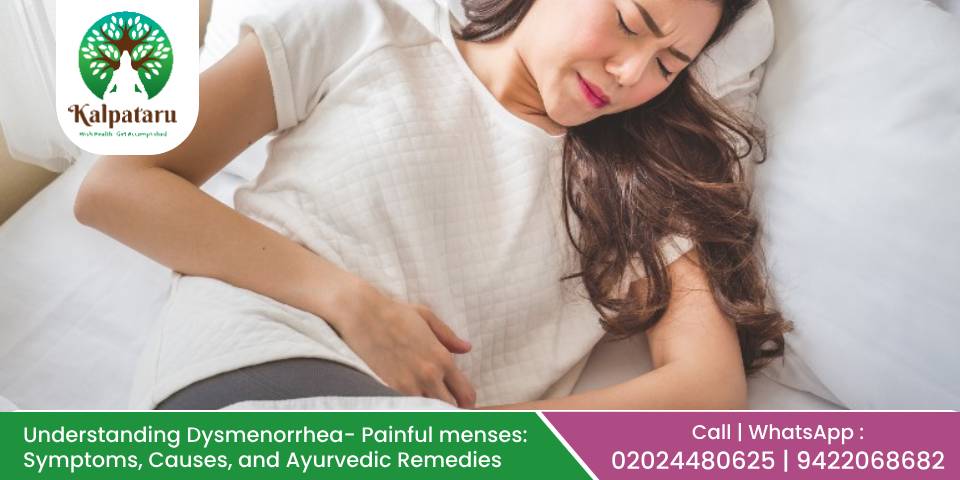
16Jul
Understanding Dysmenorrhea- Painful menses: Symptoms, Causes, and Ayurvedic Remedies
Dysmenorrhea refers to the occurrence of painful menstrual cramps that occur immediately before or during menstruation. It is a common gynecological condition that affects a significant number of women worldwide, leading to discomfort and sometimes debilitating pain. The pain starts one or two days before the onset of the period and stops one or two days after the period beginsDysmenorrhea is one of the most frequently reported menstrual disorders. Studies suggest that approximately 50-90% of menstruating women experience dysmenorrhea at some point in their lives. Among these, about 10-15% experience severe pain that interferes with daily activities. The prevalence is higher among adolescents and younger women, typically decreasing with age and often after childbirth. Overview: Dysmenorrhea is commonly observed in girls after they start their periods or before marriage. In many cases, the intensity of the symptoms decreases after marriage. However, if these complaints are frequent and severe, and do not improve with usual treatments, it is crucial to rule out other serious conditions like endometriosis or fibroids. Neglecting these issues can lead to complications, such as difficulties in conceiving after marriage. Causes of Dysmenorrhea: Primary Dysmenorrhea: This type is caused by natural chemical changes in the body, specifically the overproduction of prostaglandins, which leads to increased uterine contractions.Secondary Dysmenorrhea: This type is due to underlying reproductive health issues such as endometriosis, fibroids, pelvic inflammatory disease, or other gynecological conditions. Vitamin B1 Deficiency and Dysmenorrhea: A deficiency in Vitamin B1, also known as Thiamine, can also cause dysmenorrhea. Thiamine plays a crucial role in energy metabolism and nerve function. Taking 100mg of Vitamin B1 for three months can provide significant relief from menstrual pain. Consuming unpolished rice, which contains Thiamine, can also help reduce painful menstrual cycles. Symptoms of Dysmenorrhea: Lower abdominal painNauseaVomitingDizzinessHeadachesLeg pain Lifestyle Corrections: Lifestyle correction plays a key role in managing dysmenorrhea. Proper nutrition, avoiding junk food and fast food, and following seasonal routines are essential. During periods, it is advisable to minimize heavy exercise and sports activities according to Ayurvedic recommendations. For more information and treatment modalities watch our informative video https://www.youtube.com/watch?v=PEMqBQxUGvE Ayurvedic Approaches to Managing Dysmenorrhea: Yoga and Meditation: Incorporating yoga and meditation into daily routines can help manage stress and improve overall well-being, thereby reducing the severity of menstrual pain.Exercise: Regular, moderate exercise helps improve blood circulation and can alleviate menstrual cramps.Panchakarma Treatments: Some Ayurvedic treatments, particularly Virechana (therapeutic purgation) and Basti (medicated enema), can be beneficial. For example, starting oil-based Basti treatment eight days before periods and continuing for three months can significantly reduce dysmenorrhea. Dietary Recommendations: Certain kitchen ingredients can also be helpful in managing dysmenorrhea. These include:Fennel Seeds: Known for their antispasmodic properties, fennel seeds can help relieve menstrual cramps.Fenugreek: Helps in balancing hormones and reducing menstrual pain.Asafoetida (Hing): Known for its anti-inflammatory properties, it helps in alleviating pain.Carom Seeds (Ajwain): Aid in digestion and relieve menstrual pain.Cumin Seeds: Help in reducing hormonal imbalances and alleviate pain associated with menstruation. Conclusion: Dysmenorrhea is a common condition that affects many women, but with the right approach, it can be managed effectively. By understanding the causes, recognizing the symptoms, and incorporating lifestyle changes along with Ayurvedic treatments, women can find relief from painful menstrual cycles. Proper nutrition, yoga, meditation, and the use of beneficial herbs and spices can play a significant role in alleviating the discomfort associated with dysmenorrhea. If symptoms persist or worsen, it is essential to seek medical advice to rule out any underlying conditions.Dr. Manoj Deshpande and Dr. Aparna Deshpande at Kalpataru Ayurvediya Chikitsalaya™ Clinic provide the best Ayurvedic Treatment for Psoriasis & various diseases in Pune, Maharashtra. For more information about our comprehensive treatment options, or to requestan appointment with the best Ayurvedic Doctor in Pune, call +919422068682 / +919764837167 / 020-24480625 or Click on Book an Appointment.
Read More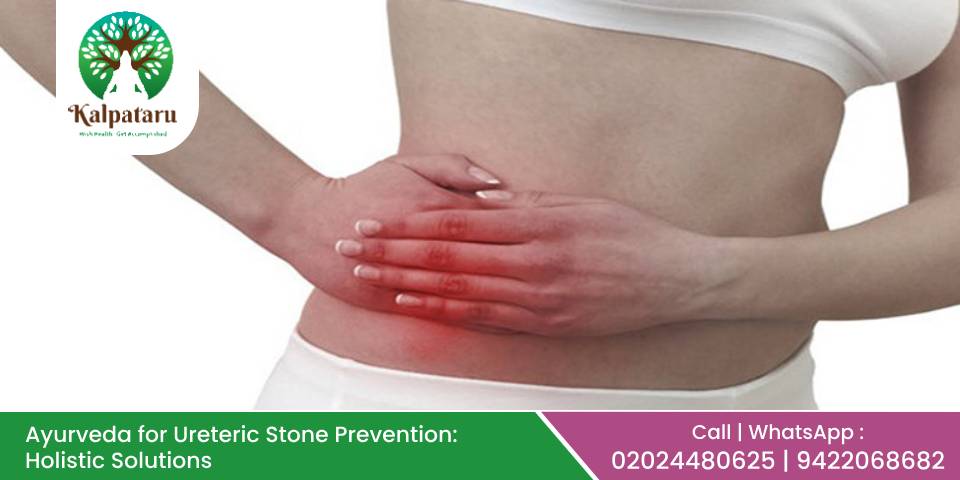
05Jul
Ayurveda for Ureteric Stone Prevention: Holistic Solutions
Ureteric stones, or ureteral stones, are kidney stones that have migrated into the ureter, the narrow tube that connects the kidney to the bladder. This tube is typically about 10-12 inches long. Ureteric stones can be classified based on their location within the ureter: proximal (closer to the kidney) or distal (nearer to the bladder). Generally, stones located near the bladder are easier to pass. Ayurvedic Treatments for Ureteric Stones: Ayurveda offers a holistic approach to managing and treating ureteric stones through various treatments and natural remedies. These treatments focus on stimulating the passage of stones and providing relief from pain and discomfort. Panchakarma Treatment: Panchakarma, a set of five therapeutic procedures, is highly effective in managing ureteric stones. The natural downward movement of these stones due to gravity can be assisted through specific Panchakarma treatments, aiding in their passage through the ureter. Snehana (Oil Massage): A warm oil massage applied to the back, lower abdomen, and waist area helps relax the muscles, including those in the ureter. This relaxation aids in the movement and passage of the stone. Swedana (Sweating Therapy): The application of steam therapy helps further relax the muscles, making it easier for the stone to pass through the ureter. Basti Treatment: Basti, a type of Ayurvedic enema, involves introducing medicated oils or herbal decoctions into the body through the rectal route. This treatment helps in the downward movement of Vata (the air element), facilitating the passage of the stone. Avagaha (Sitz Bath): Sitting in a warm water bath or a bath with warm herbal decoctions helps relax the muscles, aiding in the smooth passage of the stone. Avapidaka Ghrita: Medicated ghee, known as Avapidaka Ghrita, is highly beneficial for ureteric stones. Consuming a small bowl of this ghee with warm water twice daily—before lunch and 3-4 hours after meals—helps in the movement of Vata and smooth passage of the stone due to its lubricating properties. Herbal Medicines: Various Ayurvedic medicines are effective in treating ureteric stones, including:Hazral Yahood BhasmaShweta ParpatiChandraprabha VatiGokshuradi GugguluVarunadi Kwath Importance of Treatment: Ignoring ureteric stones can lead to severe complications. The urine produced by the kidneys may not flow properly into the bladder, causing back pressure. This can result in hydronephrosis (swelling of the kidney) and hydroureter (swelling of the ureter), conditions that can be detected through sonography. Neglecting these conditions may lead to recurrent urinary tract infections, kidney dysfunction, and potentially permanent kidney damage. For more information and treatment modalities watch our informative video https://www.youtube.com/watch?v=6hiu3mkdtIM&t=2s How to Avoid Recurrence of Ureteric Stones: Recurrence of ureteric stones can be a significant concern for many individuals. Implementing preventive measures and making lifestyle changes can greatly reduce the risk of recurrence. Here are some effective strategies to help avoid the recurrence of ureteric stones: Hydration: Increase Fluid Intake: Drink plenty of water throughout the day. Aim for at least 2-3 liters (about 8-12 cups) daily, or more if you live in a hot climate or engage in strenuous physical activity. Hydration helps dilute urine, reducing the concentration of minerals that can form stones. Monitor Urine Color: Aim for light yellow or clear urine, indicating proper hydration. Dark yellow urine is a sign of dehydration. Dietary Modifications: Limit Salt Intake: Reduce the consumption of salty foods and avoid adding extra salt to your meals. High sodium intake can increase calcium levels in the urine, leading to stone formation. Reduce Oxalate-Rich Foods: Limit foods high in oxalates, such as spinach, rhubarb, beets, nuts, and chocolate. Oxalates can combine with calcium to form stones. Moderate Protein Intake: Avoid excessive consumption of animal protein (meat, eggs, fish). High protein intake can increase uric acid levels and lower citrate levels in the urine, promoting stone formation. Increase Citrate Intake: Consume foods high in citrate, such as lemons and oranges. Citrate helps prevent stone formation by binding with calcium in the urine. Balanced Calcium Intake: Maintain a balanced calcium intake through dietary sources rather than supplements. Consult with a healthcare provider to determine the appropriate amount for you. Lifestyle Changes: Regular Physical Activity: Engage in regular exercise to promote overall health and improve urine flow. Physical activity can help prevent the formation of stones by reducing body weight and improving metabolic functions. Maintain a Healthy Weight: Achieve and maintain a healthy weight through a balanced diet and regular exercise. Obesity is a risk factor for kidney stones. Conclusion: Ureteric stones, while often painful and inconvenient, can be effectively managed and treated through a combination of Ayurvedic treatments and lifestyle changes. The holistic approach of Ayurveda not only addresses the immediate issue of stone passage but also promotes overall urinary health and well-being. By incorporating these treatments and tips into your routine, you can prevent the occurrence of ureteric stones and ensure a healthier urinary system.Dr. Manoj Deshpande and Dr. Aparna Deshpande at Kalpataru Ayurvediya Chikitsalaya™ Clinic provide the best Ayurvedic Treatment for Psoriasis & various diseases in Pune, Maharashtra. For more information about our comprehensive treatment options, or to request an appointment with the best Ayurvedic Doctor in Pune, call +919422068682 / +919764837167 / 020-24480625 or Click on Book an Appointment.
Read More
29Jun
The Dangers of Prolonged Sitting: Why Sitting is the New Smoking
In today's fast-paced world, we often hear that "sitting is the new smoking." This analogy highlights the harmful effects prolonged sitting can have on our bodies, comparable to, or even more detrimental than, smoking. Let's explore why reducing prolonged sitting is crucial for our health and how we can incorporate simple habits to mitigate its adverse effects. The Impact of Prolonged Sitting: Prolonged sitting can have numerous negative consequences on our overall health, affecting everything from our posture to our internal organs. Here are some key impacts: Blood Circulation and Endothelial Health: Endothelial Function: The endothelium is the thin layer lining inside our blood vessels. Good endothelial health is crucial for preventing atherosclerosis (hardening of the arteries) and ensuring proper blood and nutrient supply to all organs. Poor diet, pollution, stress, cholesterol, and diabetes can damage the endothelium, but regular physical activity can help maintain its health. Posture and Musculoskeletal Issues: Posture: Prolonged sitting can lead to poor posture, resulting in back pain, neck pain, and shoulder pain.Musculoskeletal Disorders: Continuous sitting can cause various musculoskeletal problems, contributing to discomfort and chronic pain. Metabolic Health: Diabetes and Obesity: Studies have shown a significant increase in the risk of diabetes, obesity, hypertension, hypercholesterolemia, and metabolic syndrome with prolonged sitting. Central obesity, characterized by fat accumulation around the abdomen and internal organs, is particularly harmful and prevalent in sedentary individuals.Metabolism: Sitting for extended periods slows down metabolism, leading to minimal calorie utilization and increased fat storage. Mental Health: Mental Disorders: Prolonged sitting can negatively impact mental health, leading to conditions such as anxiety, depression, cognitive disorders, dementia and sleep disturbances. Inflammation and Blood Clots: C-Reactive Protein (CRP): Increased sitting raises CRP levels, causing inflammation and joint pain.Blood Clotting: Reduced movement can increase blood viscosity and the risk of clot formation, potentially leading to deep vein thrombosis, heart attacks, or strokes. Cancer: Emerging research suggests a link between prolonged sitting and certain types of cancer, including colon, breast, and endometrial cancers. The exact mechanisms are still being studied, but it is believed that increased insulin levels and inflammation due to sedentary behavior may play a role. For more information and treatment modalities watch our informative video https://www.youtube.com/watch?v=TpBNbm8sLEY&t=16shttps://www.youtube.com/watch?v=nXStcqFegds&t=60s Simple Solutions to Counteract Prolonged Sitting: While it may not be possible to avoid sitting entirely, especially for those with desk jobs, there are several practical strategies to reduce its harmful effects:Frequent Breaks: Movement Breaks: Take a 1-2 minute break every 20-30 minutes to walk, climb stairs, go to the bathroom, drink water, or do some body stretches. If moving around isn't possible, simply stand up and sit down in your chair every 15-20 minutes.Incorporate Activity into Your Workday: Walking and Standing Meetings: Conduct meetings while walking or standing instead of sitting.Phone Calls: Walk while talking on the phone rather than sitting.Deliver Messages in Person: Instead of calling or emailing, walk to your colleague's desk to deliver messages.Optimize Your Workstation: Ensure your chair and desk are ergonomically designed to support good posture. Your chair should support the natural curve of your spine, and your computer screen should be at eye level to prevent neck strain.Daily Physical Exercise: Cardio Exercises: Engage in 45 minutes to an hour of cardio exercises in the morning or evening to counteract the effects of prolonged sitting.Stretching and Strength Training: Include stretching and strength training exercises in your routine to improve posture and musculoskeletal health.Dietary Supplements: Turmeric: The compound curcumin in turmeric has been shown to maintain endothelial health and function.Green Tea: Drinking green tea 2-3 times a day can provide polyphenols that support endothelial health.Stay Active During Leisure Time: Instead of sitting on the couch after a long day at work, find ways to stay active. Go for a walk, engage in a hobby that requires movement, or try standing while watching TV or talking on the phone. Conclusion: The dangers of prolonged sitting are clear and multifaceted, affecting everything from cardiovascular health to mental well-being. However, by making small, manageable changes to our daily routines, we can significantly reduce these risks. Incorporate more movement into your day, optimize your work environment, and prioritize regular exercise. Remember, every bit of activity counts and can contribute to a healthier, more active lifestyle.Taking these steps not only improves your physical health but also enhances your mental and emotional well-being. It's time to stand up for your health—literally!Dr. Manoj Deshpande and Dr. Aparna Deshpande at Kalpataru Ayurvediya Chikitsalaya™ Clinic provide the best Ayurvedic Treatment for Psoriasis & various diseases in Pune, Maharashtra. For more information about our comprehensive treatment options, or to request an appointment with the best Ayurvedic Doctor in Pune, call +919422068682 / +919764837167 / 020-24480625 or Click on Book an Appointment.
Read More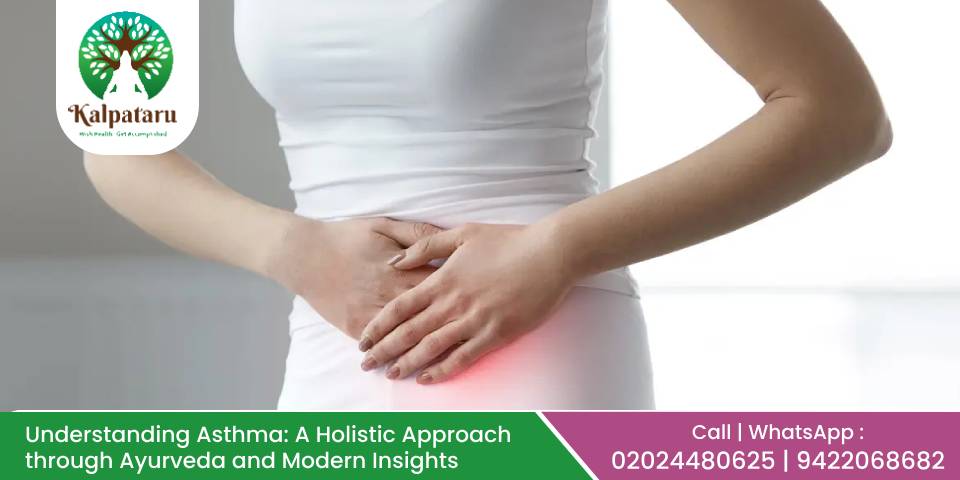
21Jun
Healing Ovarian Cysts Holistically: An Ayurvedic Approach to Comprehensive Treatment
Ovarian cysts are fluid-filled sacs or pockets that develop in or on the surface of an ovary. Women have two ovaries—each about the size and shape of an almond—on each side of the uterus. Ovarian cysts are common and can occur during the menstrual cycle or after menopause. Most ovarian cysts are benign and harmless, causing no symptoms and resolving on their own. However, some cysts can cause serious symptoms, including pelvic pain, bloating, and irregular menstrual cycles, and may require medical attention. Statistics of Ovarian Cysts in India: Ovarian cysts are a common gynecological problem among women in India, as in other parts of the world. While specific national statistics on the prevalence of ovarian cysts in India are limited, global estimates suggest that most women will develop at least one ovarian cyst during their lifetime. According to a study by AIIMS, 20–25% of women in India, or 1 in every 4–5 women. Studies indicate that functional ovarian cysts are particularly common among premenopausal women, with the prevalence decreasing after menopause. In India, hospital-based studies and smaller population samples have shown that ovarian cysts are frequently diagnosed during routine pelvic examinations and ultrasound scans. Prevalence and Modern Science Treatment: Prevalence: The prevalence of ovarian cysts varies by age, reproductive status, and other health factors. Functional ovarian cysts are most common in women of reproductive age. These cysts typically form due to the menstrual cycle and often resolve without treatment. In postmenopausal women, the occurrence of ovarian cysts is less common, but when they do occur, they are more likely to be benign than malignant. Studies estimate that about 7% of women worldwide will receive a diagnosis of an ovarian cyst at some point in their lives. For more information and treatment modalities watch our informative video https://www.youtube.com/watch?v=DREWZV_wvhE Modern Science Treatment: Treatment for ovarian cysts depends on several factors, including the cyst's size, type, and symptoms. Common treatments include: Watchful Waiting: For small, asymptomatic cysts, doctors may recommend regular monitoring with follow-up ultrasounds to check if the cyst resolves on its own. Hormonal Contraceptives: Birth control pills can help regulate the menstrual cycle and prevent the formation of new cysts. Surgery: If a cyst is large, persistent, symptomatic, or suspicious for malignancy, surgical removal may be necessary. Surgical options include: Laparoscopy: A minimally invasive surgery where the cyst is removed through small incisions using a laparoscope. Laparotomy: A more extensive surgery involving a larger incision, used for larger cysts or when cancer is suspected. Medication: Pain relief medications can be prescribed to manage symptoms associated with ovarian cysts. Ayurvedic Perspective and Treatment: According to Ayurveda, the imbalance of the three doshas—Vata, Pitta, and Kapha—causes health issues, including ovarian cysts. This imbalance can be due to improper diet, lack of exercise, weight gain, and other lifestyle factors. Ayurveda describes five types of Vayu (air) – Prana, Apana, Udana, Vyana, and Samana. The disruption of Apana Vayu, which governs the lower abdomen and reproductive system, can lead to the formation of cysts due to improper dietary and lifestyle habits. Ayurvedic Explanation of Ovarian Cysts: In the fast-paced modern lifestyle, women often engage in heavy work, stress, and irregular routines even during their menstrual periods. This disruption can affect Apana Vayu, leading to the development of ovarian cysts. Ayurveda emphasizes slowing down and reducing physical strain during menstruation to maintain balance. Ayurvedic Treatments: Ayurvedic treatments have shown success in reducing the size of ovarian cysts, even those measuring up to 5 millimeters. Various herbal remedies and formulations are used, including:Kanchanar Guggulu: A combination of herbs known to reduce cysts and tumors.Chandraprabha Vati: A potent herbal formulation used for various reproductive and urinary disorders.Specific Herbs: Such as Kunkhi or Kombdnakhi (Piper longum), Varun (Crataeva nurvala), Shigru (Moringa oleifera), Guggul (Commiphora mukul), and Triphala (a combination of three fruits: Amalaki, Bibhitaki, and Haritaki). Panchakarma Therapies: Panchakarma, the Ayurvedic detoxification and purification process, includes treatments like Basti (medicated enema) and Virechana (purgation therapy), which are highly effective for balancing doshas and treating ovarian cysts.While modern medicine provides effective diagnostic tools and treatments for ovarian cysts, Ayurveda offers a holistic approach that includes dietary modifications, herbal remedies, and detoxification therapies to address the root cause and promote overall health.Dr. Manoj Deshpande and Dr. Aparna Deshpande at Kalpataru Ayurvediya Chikitsalaya™ Clinic provide the best Ayurvedic Treatment for Psoriasis & various diseases in Pune, Maharashtra. For more information about our comprehensive treatment options, or to request an appointment with the best Ayurvedic Doctor in Pune, call +919422068682 / +919764837167 / 020-24480625 or Click on Book an Appointment.
Read More
17Jun
Understanding Antioxidants and How They Slow Down Ageing
In the quest for eternal youth, antioxidants have emerged as powerful allies. To truly appreciate their role in slowing down the ageing process, it is crucial to understand the underlying mechanisms of oxidation and how antioxidants combat this natural phenomenon. What is Oxidation, and What Happens in the Body During Oxidation? Oxidation is a chemical reaction that occurs when molecules in the body interact with oxygen. This process is essential for life, as it helps convert food into energy. However, oxidation also produces harmful byproducts known as free radicals. These are unstable molecules with unpaired electrons, which make them highly reactive. Free radicals can cause cellular damage, leading to various health issues, including ageing, by attacking healthy cells and their DNA. What Are Antioxidants? Antioxidants are compounds that inhibit oxidation. They neutralize free radicals by donating electrons, thereby stabilizing them and preventing cellular damage. This protective action helps maintain the integrity of cells, slows down the ageing process, and reduces the risk of chronic diseases How Do Antioxidants Work? Antioxidants work through a process of electron donation. By providing the missing electron to free radicals, antioxidants convert them into stable molecules, thus preventing them from causing further harm. This mechanism of action is vital in opposing oxidation and maintaining cellular health.Neutralizing Free Radicals: Antioxidants neutralize free radicals by donating an electron without becoming destabilized themselves. This stops the chain reaction of oxidative stress that can damage cells.Repairing Damaged Cells: Some antioxidants can also help repair oxidative damage by stimulating cellular repair mechanisms or directly interacting with the damaged moleculesSupporting Immune Function: By reducing oxidative stress, antioxidants enhance the immune system's efficiency, helping the body fend off infections and diseases more effectively. Foods Rich in Antioxidants Incorporating antioxidant-rich foods into your diet is one of the best ways to harness their benefits. Here are some examples:Fruits: Berries (blueberries, strawberries, raspberries), oranges, and grapesVegetables: Spinach, kale, broccoli, and carrotsNuts and Seeds: Walnuts, almonds, sunflower seedsBeverages: Green tea, coffee, and red wineOthers: Dark chocolate, whole grains, and legumes Ayurvedic Herbs and Spices Rich in Antioxidant Properties Several Ayurvedic herbs and spices are renowned for their high antioxidant content. These include:Turmeric (Curcuma longa): Contains curcumin, a potent antioxidant with anti-inflammatory properties.Ashwagandha (Withania somnifera): Known for its ability to reduce oxidative stress and support overall health.Tulsi (Ocimum sanctum): Holy basil, rich in antioxidants, helps boost the immune system and combat oxidative stress.Amalaki (Emblica officinalis): Also known as Indian gooseberry, it is a powerful antioxidant that supports liver health and boosts immunity.Ginger (Zingiber officinale): Contains gingerol, which has potent antioxidant and anti-inflammatory effects. Research on Antioxidant Herbs from an Ayurvedic Perspective Ayurveda, an ancient Indian medical system, incorporates a holistic approach to health that includes the use of antioxidants to combat oxidative stress and promote longevity. Key Ayurvedic formulations, such as Triphala and herbs like Ashwagandha and Amalaki, have been scientifically validated for their antioxidant properties. These substances help neutralize free radicals, support immune function, and may even play a role in reproductive health by enhancing cellular repair mechanisms and reducing inflammation. The concept of "Ojas," central to Ayurveda, is also linked to modern scientific understanding of immune and antioxidant systems.For example, Triphala, a well-known Ayurvedic formulation, has shown significant antioxidant activity, including nitric oxide scavenging and anti-lipid peroxidation. It also enhances the body's overall antioxidant status by influencing key enzymes like catalase and superoxide dismutase. For more information and treatment modalities watch our informative video https://www.youtube.com/watch?v=8q4Ar1z5ODghttps://www.youtube.com/watch?v=d7ReUI030ZU&t=4s The Importance of Consuming Antioxidants in Their Natural Form While antioxidant supplements are available, obtaining these nutrients through a balanced diet is generally more beneficial. Whole foods provide a complex matrix of nutrients that work synergistically to enhance antioxidant absorption and efficacy. Moreover, natural sources of antioxidants are less likely to cause adverse effects compared to high doses of isolated compounds in supplements. For example, Triphala, a well-known Ayurvedic formulation, has shown significant antioxidant activity, including nitric oxide scavenging and anti-lipid peroxidation. It also enhances the body's overall antioxidant status by influencing key enzymes like catalase and superoxide dismutase. Conclusion Incorporating antioxidant-rich foods and herbs into your daily diet can significantly contribute to slowing down the aging process and improving overall health. By understanding the role of oxidation and the protective actions of antioxidants, you can make informed dietary choices that support longevity and vitality. Remember, the best way to benefit from antioxidants is through a diverse and balanced diet rich in fruits, vegetables, nuts, seeds, and whole grains, complemented by the wisdom of Ayurvedic herbs and spices.Dr. Manoj Deshpande and Dr. Aparna Deshpande at Kalpataru Ayurvediya Chikitsalaya™ Clinic provide the best Ayurvedic Treatment for Psoriasis & various diseases in Pune, Maharashtra. For more information about our comprehensive treatment options, or to request an appointment with the best Ayurvedic Doctor in Pune, call +919422068682 / +919764837167 / 020-24480625 or Click on Book an Appointment.
Read More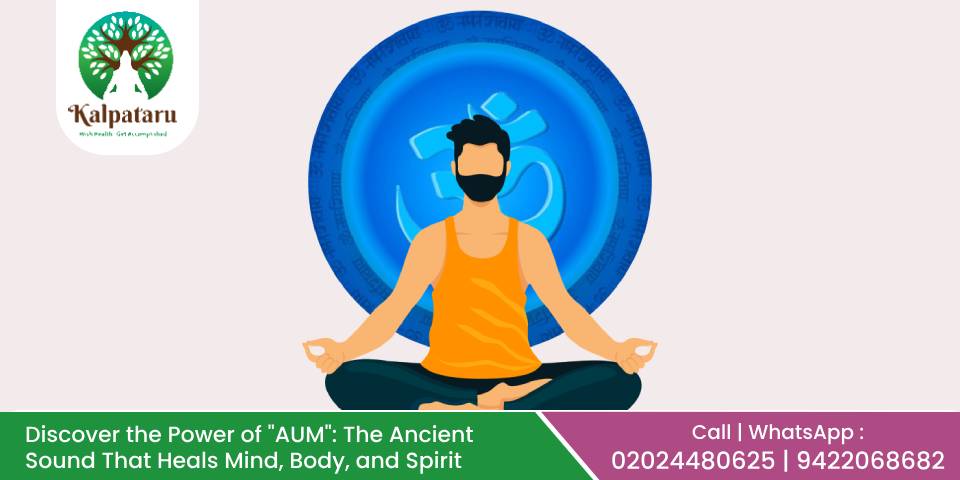
07Jun
Discover the Power of “AUM”: The Ancient Sound That Heals Mind, Body, and Spirit
Omkar considered the root of all mantras, is described in the Vedas as the primordial sound that emerged at the creation of the universe. "Aum" is believed to be the primordial sound of the universe, embodying the essence of the ultimate reality, consciousness, or Atman. Beyond its spiritual significance, modern science has begun to explore and validate the potential health benefits of chanting "Aum". The vibrations of this sound have a significant impact on our brain, activating our parasympathetic nervous system. This activation helps reduce depression, anxiety, physical ailments, restlessness, anger, irritability, and insomnia. Understanding "Aum": "Aum" is composed of three sounds: "A," "U," and "M." Each part represents different states of consciousness:"A" (pronounced as "ah") symbolizes the waking state."U" (pronounced as "oo") represents the dream state."M" (pronounced as "mm") signifies the state of deep sleep.The silent resonance that follows the chant is believed to signify the transcendental state, or Turiya, a state of pure consciousness. Research Studies: Numerous studies have been conducted on Omkar. One technique, known as FMRI, has shown that people who chant Omkar experience a decrease in heart and respiration rate, improved breathing, better digestion, enhanced immunity, and a better mood. The Science Behind "Aum": Modern science has investigated the physiological and psychological impacts of chanting "Aum." Here are some key findings:Neurological Benefits: Activation of the Vagus Nerve: Chanting "Aum" stimulates the vagus nerve, which is crucial for parasympathetic nervous system functioning. This nerve helps control stress responses and promotes relaxation.EEG Studies: Electroencephalogram (EEG) studies have shown increased alpha wave production during "Aum" chanting, indicating a state of relaxed alertness similar to that achieved in meditation.Respiratory Benefits: Breath Control: The rhythmic chanting of "Aum" involves prolonged exhalation, which can enhance lung capacity and improve oxygenation of the blood.Respiratory Rhythm: Chanting can synchronize the breathing pattern, promoting a steady respiratory rate and reducing stress.Psychological Benefits: Stress Reduction: Studies have shown that chanting "Aum" can reduce cortisol levels, a primary stress hormone, leading to decreased anxiety and stress.Enhanced Focus and Concentration: The repetitive nature of chanting helps anchor the mind, improving concentration and mental clarity.Cardiovascular Benefits: Heart Rate Variability (HRV): Improved HRV is associated with better cardiovascular health. Chanting "Aum" has been linked to increased HRV, suggesting enhanced autonomic nervous system balance and heart health.Physical Benefits: There are also physical benefits to chanting Omkar. It helps alleviate various stomach ailments because the diaphragm, a large muscle in the abdomen, gets exercised during chanting, improving blood circulation to the abdominal organs and enhancing their efficiency. It also benefits chronic headaches, migraines, allergies, bronchial asthma, and lung disorders.Overall Well-being: Mood Enhancement: Chanting "Aum" can lead to the release of endorphins, the body's natural "feel-good" chemicals, thereby enhancing mood and promoting a sense of well-being.Mind-Body Connection: Engaging in this practice fosters a deeper connection between the mind and body, contributing to holistic health.Pranayama Benefits: Omkar is a type of pranayama (breathing exercise), and thus, it confers all the benefits of pranayama. It purifies and activates the body's energy chakras. How to Chant "Aum": To experience the benefits of chanting "Aum," it is essential to practice it correctly. Here is a simple guide:Find a Quiet Place: Choose a calm and quiet environment to minimize distractions.Sit Comfortably: Sit in a comfortable position with your spine erect. You can sit cross-legged on the floor or on a chair with your feet flat on the ground.Relax: Close your eyes and take a few deep breaths to relax your body and mind.Chant "Aum": Inhale deeply and chant "Aum" in one long exhalation. Focus on the vibration of the sound as it moves through your body.*Begin with the "A" sound, feeling the vibration in your lower abdomen.*Transition to the "U" sound, feeling the vibration move up to your chest.*Conclude with the "M" sound, feeling the vibration in your head.Repeat: Repeat the chant for at least five minutes, allowing yourself to immerse in the sound and vibration.Reflect: After chanting, sit quietly for a few moments to absorb the effects. Integrating "Aum" Chanting into Daily Life: To reap the full benefits, integrate "Aum" chanting into your daily routine:Morning Routine: Begin your day with a few minutes of chanting to set a positive tone.Stressful Moments: Use chanting as a tool to manage stress during challenging times.Meditation Practice: Incorporate "Aum" chanting into your meditation sessions to deepen your practice. For more information and treatment modalities watch our informative video https://www.youtube.com/watch?v=wrfHj00PfsY&t=16shttps://www.youtube.com/watch?v=idzA2qb-EKo&t=1s Conclusion: Chanting "Aum" is more than a spiritual practice; it is a scientifically backed method to enhance health and well-being. By engaging in this ancient technique, you can tap into a reservoir of benefits for the mind, body, and spirit. Whether you seek stress relief, improved focus, or a greater sense of peace, chanting "Aum" offers a simple yet profound pathway to holistic health. Embrace this practice and let the sound of "Aum" resonate through your being, bringing harmony and wellness to your life.Dr. Manoj Deshpande and Dr. Aparna Deshpande at Kalpataru Ayurvediya Chikitsalaya™ Clinic provide the best Ayurvedic Treatment for Psoriasis & various diseases in Pune, Maharashtra. For more information about our comprehensive treatment options, or to request an appointment with the best Ayurvedic Doctor in Pune, call +919422068682 / +919764837167/ 020-24480625 or Click on Book an Appointment.
Read More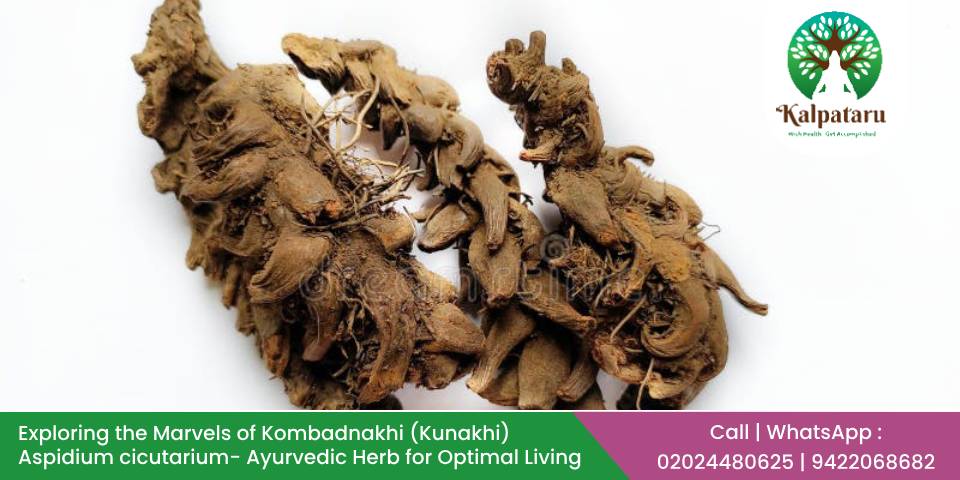
03Jun
Exploring the Marvels of Kombadnakhi (Kunakhi) Aspidium cicutarium- Ayurvedic Herb for Optimal Living
In the realm of holistic wellness and traditional medicine, the rich tapestry of Ayurveda offers a treasure trove of natural remedies for better living. Among its many wonders is Kombadnakhi, also known as Kunakhi or Aspidium Cicutarium. This ancient herb, cherished for centuries for its medicinal properties, holds immense potential in promoting holistic well-being. Let's embark on a journey to uncover the marvels of Kombadnakhi and explore its myriad benefits for a healthier, more balanced life. Understanding Kombadnakhi: Kombadnakhi, scientifically identified as Aspidium Cicutarium, belongs to the fern family and is native to regions like India, Nepal, and Sri Lanka. Revered in Ayurveda, this herb has been used for generations to alleviate various ailments and promote overall wellness. It is characterized by its delicate fronds and distinctive medicinal properties, making it a prized asset in traditional medicine. Extensive Research on Kombadnakhi: Kombadnakhi has been the subject of extensive research, and findings have consistently highlighted its efficacy in treating a variety of health conditions. The plant's therapeutic properties make it an invaluable resource in both traditional and modern medicine. For more information and treatment modalities watch our informative video https://www.youtube.com/watch?v=LPZiGkHQNB8&t=1s Health Benefits of Kombadnakhi: Let's delve into the specific health benefits of this amazing plant and understand how it can be used to address different medical conditions.Treatment of Lumps and Nodules: Kombadnakhi is effective in the treatment of various types of lumps and nodules. Whether these are benign or potentially harmful, the anti-inflammatory properties of the plant help reduce their size and alleviate associated discomfort.Reduction of Inflammation: Inflammation is a common response to injury or infection, but chronic inflammation can lead to several health issues. Kombadnakhi's potent anti-inflammatory properties make it an excellent natural remedy for reducing inflammation throughout the body.Healing Abscesses: Abscesses, which are pockets of pus caused by infections, can be painful and potentially dangerous if left untreated. Kombadnakhi aids in the healing of abscesses by promoting drainage and reducing infection, thereby accelerating the healing process.Relief from Tonsillitis: Tonsillitis, an infection of the tonsils, can cause severe throat pain and difficulty in swallowing. The antibacterial and anti-inflammatory effects of Kombadnakhi can help alleviate the symptoms of tonsillitis and promote quicker recovery.Treatment of Breast Abscesses: Breast abscesses, often resulting from infections, can be particularly painful and concerning. Kombadnakhi has shown promise in treating these abscesses, helping to reduce pain and inflammation, and promoting healing.Management of Thyroid Goiter: A goiter is an abnormal enlargement of the thyroid gland, often due to iodine deficiency or thyroid disorders. Kombadnakhi is beneficial in managing thyroid goiters by reducing the size of the swelling and improving thyroid function.Curing Primary Stage Cancer Tumors: Emerging research suggests that Kombadnakhi may have potential in curing primary stage cancer tumors. The plant's bioactive compounds could help in inhibiting the growth of cancerous cells, making it a promising natural adjunct in cancer treatment protocols.Reducing Triglycerides: Elevated triglycerides in the blood can increase the risk of heart disease. Kombadnakhi has been shown to have lipid-lowering effects, helping to reduce triglyceride levels and promote cardiovascular health. How to Incorporate Kombadnakhi into your medicine Routine? Herbal Tea: Prepare a nourishing herbal tea by steeping dried Kombadnakhi fronds in hot water. Have this soothing beverage daily to reap its antiinflammatory and immune-boosting benefits.Herbal Supplements: Kombadnakhi supplements, available in various forms such as capsules or powders, offer a convenient way to incorporate this herb into your daily regimen. Consult with best ayurvedic doctor in Pune like Dr. Manoj Deshpande for appropriate dosage and usage guidelines.Culinary Delights: Explore the culinary possibilities of Kombadnakhi by adding fresh or dried fronds to soups, stews, and stir-fries. Not only does it impart a unique flavor, but it also enhances the nutritional profile of your meals.Topical Applications: Harness the anti-inflammatory properties of Kombadnakhi by using it topically. Create a poultice or infused oil to soothe sore muscles, alleviate joint pain, and promote skin health. Precautions and Considerations: While Kombadnakhi offers numerous health benefits, it's essential to exercise caution and consult with a healthcare professional before incorporating it into your wellness routine, especially if you have pre-existing health conditions or are pregnant or breastfeeding. Contact Kalpataru Ayurvediya Chikitsalaya™ for more information. Conclusion: While Kombadnakhi offers numerous health benefits, it's essential to exercise caution and consult with a healthcare professional before incorporating it into your wellness routine, especially if you have pre-existing health conditions or are pregnant or breastfeeding. Book An Appointment Kalpataru Ayurvediya Chikitsalaya™ for more information.
Read More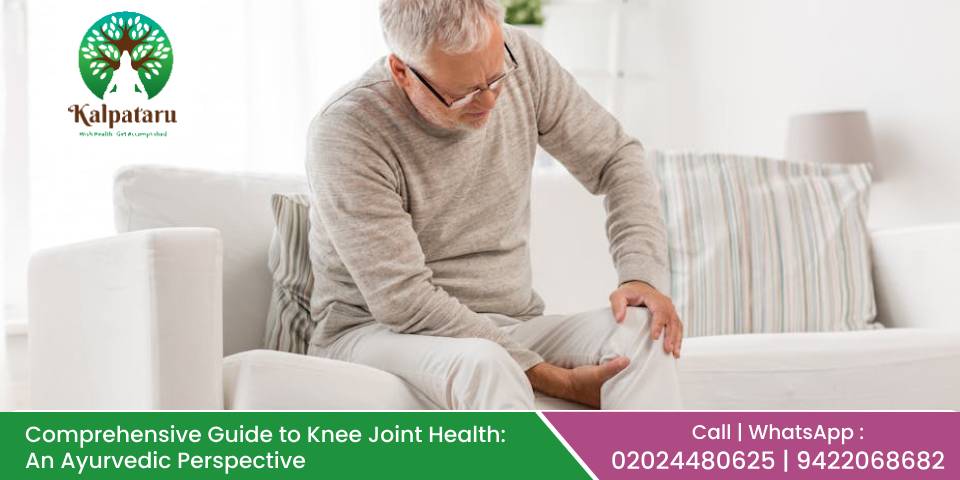
27May
Comprehensive Guide to Knee Joint Health: An Ayurvedic Perspective
Knee joint health is a crucial aspect of overall mobility and quality of life. As we age, knee problems such as osteoarthritis become increasingly common. In Ayurveda, a holistic system of medicine, knee joint issues are often categorized under "Sandhigata Vata," specifically referred to as "Janushool" when affecting the knees. This condition, akin to osteoarthritis, is primarily due to the degeneration of bone tissue (Asthi Dhatu). Understanding the Knee Joint: The knee joint is one of the most complex joints in the human body, consisting of bones, cartilage, ligaments, and tendons. Here’s a brief overview:Bones: The knee joint is formed by the femur (thigh bone), tibia (shin bone), and patella (kneecap).Cartilage: The ends of the bones are covered with cartilage, which cushions the joint and allows smooth movement.Ligaments: These are strong bands of tissue that connect bones to other bones. The knee has four main ligaments – ACL, PCL, MCL, and LCL – that stabilize the joint.Tendons: Tendons connect muscles to bones. The quadriceps tendon connects the quadriceps muscle to the patella, and the patellar tendon connects the patella to the tibia. Common Knee Problems: Understanding common knee problems can help in early detection and treatment:Osteoarthritis: A degenerative condition where the cartilage wears down, causing pain and stiffness.Tendinitis: Inflammation of the tendons, often due to overuse.Bursitis: Inflammation of the bursae, the small sacs of fluid that cushion the knee.Ligament Injuries: Such as ACL or MCL tears, often resulting from sports or accidents.Meniscus Tears: Tears in the cartilage that absorbs shock in the knee. Preventive Measures: Here are the preventive measures for better knee joint health in a concise manner:Maintain a Healthy Weight: Excess weight strains knees. Aim for a balanced diet and regular exercise.Stay Active: Engage in low-impact exercises like walking and swimming to strengthen knee muscles.Warm-Up: Always warm up before exercise to prevent injury.Proper Footwear: Wear supportive shoes to reduce knee strain.Avoid High-Impact Activities: Minimize activities like running on hard surfaces.Practice Good Posture: Maintain proper posture to reduce knee strain.Stay Hydrated: Drink sufficient water for joint lubrication.Balanced Diet: Consume foods rich in joint-supporting nutrients.Listen to Your Body: Pay attention to knee pain or discomfort and avoid activities that worsen it.These measures help maintain knee joint health, reducing the risk of knee problems. Ayurvedic Therapies for Knee Joint Health: Snehana (Oiling) and Swedana (Sweating): Snehana involves the application of warm medicinal oils prepared with herbs that strengthen bones, muscles, and tissues. This oil is massaged around the affected knee area, promoting relaxation and lubrication of the joints. Swedana follows Snehana and involves a steaming treatment called "Nadi Swedana." In this procedure, steam from a pressure cooker containing herbs is directed onto the painful knee. The combination of oil massage and steam therapy provides significant pain relief and improves joint flexibility.Vedhan (Ayurvedic Acupuncture) and Agnikarma: Vedhan is a type of Ayurvedic acupuncture performed on specific points to alleviate pain. This technique stimulates specific points to enhance energy flow and reduce discomfort. Agnikarma involves applying mild heat using a gold instrument ( Shalaka) to the affected area. This treatment can be direct or indirect and is very effective in reducing knee pain by improving circulation and promoting healing.Janubasti: Janubasti is a unique Ayurvedic treatment specifically for knee pain. A dough ring made from flour is placed around the knee, and warm medicinal oil is poured into it. This oil remains in contact with the knee for about half an hour, providing deep nourishment to the joints and reducing pain. Janubasti is a highly effective treatment for knee osteoarthritis.Patrapottali or Pinda Sweda: In Patrapottali or Pinda Sweda, medicinal herbs are fried in oil and made into a poultice. This poultice is then used to massage the affected knee. The warmth and medicinal properties of the herbs help in alleviating pain and reducing inflammation.Basti (Medicated Enema): For severe bone degeneration, Basti is recommended. This treatment involves preparing an enema with herbs boiled in milk and adding medicinal ghee into it. This "Tikta Ksheer Basti" is administered rectally, allowing the medicine to be absorbed well into the body. This treatment helps stop bone and cartilage deterioration and provides significant pain relief. Herbal Remedies for Knee Joint Health: Ayurveda utilizes various herbs to treat the deterioration of bone tissue. These include:Padhmakashta, Khair, Shringa, Mandur and many more.Medicinal preparations used to nourish and strengthen bones.Vidrum, Ashwagandha, Shatavari, Asthishrunkhala:These are herbs known for their regenerative properties on bone tissue.Guggul Preparations: Guggul is a potent Ayurvedic resin used in various formulations to alleviate Vata dosha (imbalance of air and space elements in the body). Guggul preparations are particularly effective in reducing joint pain and inflammation.Exercise Recommendations for Knee Joint Health: Patients with knee pain should avoid high-impact exercises like running, which can exacerbate the condition. Instead, the following exercises are recommended:Stationary Cycling or Regular Cycling: These exercises are gentle on the knees and help maintain joint mobility.Water Exercises: Activities like walking in a swimming pool provide resistance without putting pressure on the joints, making them highly beneficial for knee health. Dietary Recommendations for Knee Joint Health: A balanced diet plays a crucial role in maintaining and improving knee joint health. To reduce bone deterioration and strengthen muscles, include the following in your diet:Coconut, Dates, Pomegranate: These fruits provide essential nutrients for joint health.Eggs, Soybeans, Almonds: Rich in protein and other nutrients that support muscle and bone strength.Black Gram (Urad Dal), Sesame Seeds: These help in nourishing and strengthening the joints. Early Treatment Benefits: Starting Ayurvedic treatments early and avoiding dependency on painkillers can significantly reduce knee pain. Early intervention with Ayurveda may prevent the need for surgical procedures such as knee replacement, offering a natural and holistic approach to knee joint health. Conclusion: Ayurveda offers a comprehensive approach to knee joint health through a combination of therapies, herbal remedies, exercises, and dietary recommendations. By incorporating these practices into your routine, you can effectively manage knee pain, improve joint function, and maintain overall knee health. Embrace the wisdom of Ayurveda for a pain-free, active life!Dr. Manoj Deshpande and Dr. Aparna Deshpande at Kalpataru Ayurvediya Chikitsalaya™ Clinic provide the best Ayurvedic Treatment for Psoriasis & various diseases in Pune, Maharashtra. For more information about our comprehensive treatment options, or to request an appointment with the best Ayurvedic Doctor in Pune, call +919422068682 / +919764837167 / 020-24480625 or Click on Book an Appointment.
Read More
20May
Nourishing the Mind: Ayurvedic Wisdom on Foods and Meal Practices for Brain Health
In the bustling chaos of modern life, our minds often bear the brunt of stress, multitasking, and sensory overload. Just as we nourish our bodies, it's crucial to tend to the health of our brains, which serve as the command center for our entire being. Ayurveda, the ancient Indian system of medicine, offers a treasure trove of wisdom on how we can support and enhance brain health through our diet and meal practices. Let's delve into the world of Ayurvedic nutrition and explore the foods and meal guidelines that are revered for their ability to nourish and rejuvenate the mind. Understanding Ayurveda and Brain Health: Ayurveda views the human body as a microcosm of the universe, consisting of the same elemental building blocks: space (akash), air (vayu), fire (agni), water (jala), and earth (prithvi). When these elements are in balance within us, we experience optimal health. Imbalances, however, can lead to various ailments, including those affecting the mind. In Ayurveda, the mind is intricately connected to the doshas – Vata, Pitta, and Kapha – which govern different physiological functions. When these doshas are in harmony, mental clarity, focus, and emotional stability prevail. Conversely, imbalances can manifest as anxiety, depression, or cognitive fog. The Role of Food in Ayurveda: Ayurveda emphasizes the importance of food not only as sustenance but as medicine. Every morsel we consume has the potential to either nourish or disrupt the delicate balance of our doshas. By selecting foods that align with our unique constitution and current state of being, we can promote overall well-being, including mental health. Foods for Brain Health in Ayurveda: Ghee (Clarified Butter): Ghee is revered in Ayurveda for its ability to nourish the brain and nervous system. Rich in fat-soluble vitamins and essential fatty acids, ghee supports cognitive function, memory, and mental clarity. Consuming a teaspoon of ghee daily, particularly in the morning, is believed to enhance intellect and promote emotional stability. Nuts and Seeds: Almonds, walnuts, sesame seeds, and pumpkin seeds are packed with nutrients essential for brain health, including omega-3 fatty acids, vitamin E, and antioxidants. These nuts and seeds nourish the nervous system, enhance memory, and support overall cognitive function. Ayurveda recommends soaking nuts and seeds overnight to improve digestibility and nutrient absorption. Turmeric: Renowned for its potent anti-inflammatory properties, turmeric is a staple in Ayurvedic cooking. Curcumin, the active compound in turmeric, crosses the blood-brain barrier, where it exerts neuroprotective effects. Consuming turmeric regularly can help prevent cognitive decline, support mood balance, and enhance brain function. Brahmi (Bacopa monnieri): Brahmi is a revered herb in Ayurveda known for its profound impact on cognitive function and mental clarity. It enhances neurotransmitter function, improves memory retention, and promotes a calm and focused mind. Brahmi can be consumed as a supplement or infused into teas and tinctures for maximum benefit. Saffron: Saffron, the world's most expensive spice, is cherished in Ayurveda for its ability to uplift the mood and enhance cognitive function. It contains compounds that stimulate the production of neurotransmitters like serotonin and dopamine, promoting feelings of well-being and mental acuity. Ayurvedic Meal Practices for Brain Health: In Ayurveda, how we eat is as important as what we eat. Here are some key meal practices to support brain health: Eat Mindfully: Ayurveda emphasizes the importance of mindful eating. Slow down, savor each bite, and chew your food thoroughly. This allows for better digestion and absorption of nutrients, ensuring that your brain receives the nourishment it needs. Favor Warm, Cooked Foods: Warm, cooked foods are easier to digest and are gentler on the digestive system. Prioritize soups, stews, steamed vegetables, and cooked grains in your meals to support optimal digestion and nutrient assimilation. Follow Regular Meal Times: Establishing regular meal times helps regulate your digestive fire (agni) and promotes a sense of stability and routine. Aim to eat your meals at roughly the same times each day, allowing for adequate gaps between meals for digestion. Avoid Overeating: Overeating can overwhelm the digestive system and lead to sluggishness and lethargy, affecting both body and mind. Eat until you are satisfied, but not overly full, and listen to your body's hunger and satiety cues. Stay Hydrated: Proper hydration is essential for brain function and overall well-being. Sip warm water throughout the day to support digestion and hydration without dampening your digestive fire. Conclusion: By incorporating brain-nourishing foods into your diet and embracing Ayurvedic meal practices, you can nourish your mind and support optimal brain health. There are so many herbs which are proven to boost brain functions by means of better cognition, memory enhancement, stress relief such as Brahmi, Jatamansi,Shankhpushpi , Jyotishmati etc. Many panchkarma allied procedures such as takradhara, shirodhara , nasya are proved to be very effective for improving brain functions. Remember, true health is a holistic endeavor that encompasses body, mind, and spirit. Cultivate a deeper connection to yourself and the world around you through the wisdom of Ayurveda, and experience the profound benefits of holistic well-being.
Read More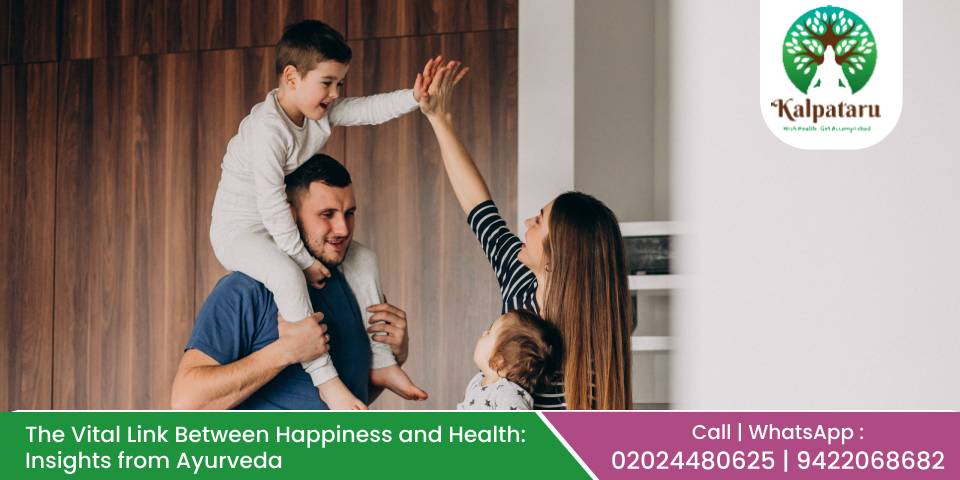
16May
The Vital Link Between Happiness and Health: Insights from Ayurveda
In Ayurveda, the ancient Indian system of medicine, the significance of mental well-being in maintaining overall health is paramount. It suggests that depression, characterized by feelings of sorrow and despair, is considered the primary cause of illness. Therefore, nurturing a happy and contented mind is deemed essential for optimal health.According to Ayurveda, individuals who embody a state of joyfulness and contentment reside predominantly in the quality known as Sattva. Sattva, one of the three fundamental qualities of the mind along with Rajas and Tamas, represents purity, harmony, and balance. It is believed that those who cultivate Sattva within themselves experience enhanced physical, mental, and emotional well-being.The concept underscores the interconnectedness of the mind, body, and spirit in Ayurvedic philosophy. It suggests that maintaining a state of mental tranquility and positivity not only promotes psychological health but also contributes significantly to physical health. By residing in the realm of Sattva, individuals can experience improved vitality, resilience, and overall vitality, thus fostering a foundation of robust health and wellness. The Science of Happiness and Health: Numerous studies have established a strong correlation between happiness and health. When we experience joy, our bodies respond by releasing hormones like serotonin and endorphins, which promote feelings of well-being and reduce stress levels. Conversely, chronic stress and negative emotions can lead to the release of cortisol, a hormone associated with inflammation and various health problems.Boosted Immunity: Happiness has been linked to a stronger immune system, making us more resilient to infections and illnesses. Positive emotions stimulate the production of antibodies and enhance the activity of immune cells, helping us ward off diseases more effectively.Reduced Risk of Chronic Diseases: Long-term happiness is associated with a lower risk of chronic conditions such as heart disease, diabetes, and hypertension. Positive emotions contribute to healthier lifestyle choices, including better dietary habits, regular exercise, and improved sleep patterns, all of which play a significant role in disease prevention.Improved Cardiovascular Health: Happy individuals tend to have lower blood pressure and reduced risk of cardiovascular events. Positive emotions promote relaxation and vasodilation, leading to better circulation and cardiovascular function.Enhanced Longevity: Several studies suggest that happiness is a predictor of longevity. People who report higher levels of happiness and life satisfaction are more likely to live longer, enjoying better overall health and quality of life in their later years. Ayurvedic Perspective on Happiness and Health: Ayurveda, the ancient Indian system of medicine, offers profound insights into the connection between happiness and health. According to Ayurveda, our state of mind profoundly influences our physical health through the concept of doshas (biological energies) and their balance.Balance of Doshas: Ayurveda recognizes three primary doshas—Vata, Pitta, and Kapha—each representing different elements and functions in the body. Happiness is seen as a state of mental equilibrium where all doshas are in harmony. When we experience joy and contentment, it indicates a balanced state of mind, which in turn supports the balance of doshas and promotes overall health.Impact on Agni (Digestive Fire): Ayurveda considers mental well-being as crucial for maintaining healthy digestion and metabolism. Happiness strengthens agni, the digestive fire, promoting efficient assimilation of nutrients and elimination of toxins from the body. Conversely, negative emotions weaken agni, leading to digestive disturbances and the accumulation of ama (toxins) in the body.Practices for Emotional Balance: Ayurveda emphasizes holistic practices to cultivate happiness and emotional balance. These include yoga, meditation, pranayama (breathwork), and daily routines (dinacharya) that align with natural rhythms. By incorporating these practices into our lives, we can nurture a positive mindset and support our overall health and well-being. Cultivating Happiness for Better Health: Given the compelling evidence from both modern science and ancient wisdom, it's clear that prioritizing happiness is essential for maintaining optimal health. Here are some practical tips for cultivating happiness in your daily life:Practice Gratitude: Take time each day to appreciate the blessings in your life, no matter how small. Gratitude has been shown to enhance mood and overall well-being.Engage in Activities You Enjoy: Whether it's pursuing hobbies, spending time with loved ones, or immersing yourself in nature, make space for activities that bring you joy and fulfillment.Mindfulness and Meditation: Incorporate mindfulness practices and meditation into your daily routine to cultivate present-moment awareness and reduce stress.Prioritize Self-Care: Take care of your physical, mental, and emotional needs by prioritizing self-care activities such as adequate sleep, healthy nutrition, and regular exercise.Nurture Social Connections: Cultivate meaningful relationships and spend time with friends and family who uplift and support you. Strong social connections are a cornerstone of happiness and resilience.Embrace Humor: Laughter truly is the best medicine. Seek out opportunities for humor and lightheartedness in your daily life. Whether it's watching a funny movie, sharing jokes with friends, or simply finding the humor in everyday situations, laughter can boost mood, reduce stress, and enhance overall well-being.Connect with Nature: Spending time in nature has been shown to have numerous benefits for mental and emotional health. Whether it's taking a walk in the park, hiking in the mountains, or simply sitting in a garden, immersing yourself in nature can reduce stress, improve mood, and foster a sense of connection with the world around you.Engage in Social Activities: Helping others and participating in social activities can significantly boost happiness levels. Volunteer work, acts of kindness, and community involvement not only benefit others but also foster a sense of purpose and fulfillment in your own life. Summary: Happiness is not just a fleeting emotion; it's a powerful determinant of our overall health and well-being. By embracing happiness as a priority and integrating practices that promote emotional balance, we can unlock the key to a healthier, more fulfilling life. Ayurveda's holistic perspective reminds us that true wellness encompasses harmony of body, mind, and spirit, with happiness serving as a vital bridge between them.Dr. Manoj Deshpande and Dr. Aparna Deshpande at Kalpataru Ayurvediya Chikitsalaya™ Clinic provide the best Ayurvedic Treatment for Psoriasis & various diseases in Pune, Maharashtra. For more information about our comprehensive treatment options, or to request an appointment with the best Ayurvedic Doctor in Pune, call +919422068682 / +91764837167 / 020-24480625 or Click on Book an Appointment.
Read More
06May
Delving Deeper into the Impact of Late Night Sleeping: A Comprehensive Exploration
Sleep, often overlooked in the hustle and bustle of modern life, is a cornerstone of our overall health and well-being. Yet, with the prevalence of screens, demanding work schedules, and social obligations, many of us find ourselves sacrificing sleep, particularly by staying up late into the night.While occasional late nights might seem harmless, the cumulative effects of consistent late-night sleeping can deeply impact various facets of our lives. In this detailed exploration, we will delve deeper into the effects of late-night sleeping, unraveling its intricate implications on physical health, mental well-being, cognitive function, and productivity. Physical Health Effects: Disrupted Circadian Rhythm: Our bodies are finely tuned to follow a circadian rhythm, a natural cycle that regulates our sleep-wake patterns, hormone secretion, and other physiological processes.Metabolic Consequences: Studies have shown a link between late-night sleeping and metabolic disturbances, including alterations in glucose metabolism, insulin sensitivity, and appetite regulation.Hormonal Imbalance: Sleep deprivation, especially during the late-night hours when our bodies are primed for rest, can disrupt the secretion of hormones such as cortisol, growth hormone, and melatonin. Mental Well-being Effects: Impact on Mood Stability: Adequate sleep is vital for maintaining emotional equilibrium and psychological well-being. Chronic sleep deprivation due to late-night sleeping can heighten susceptibility to mood disorders such as depression, anxiety, and irritability.Cognitive Vulnerability: Sleep plays a pivotal role in cognitive processes such as attention, memory consolidation, and problem-solving. Lack of sufficient sleep, particularly during the late-night hours, impairs cognitive function, leading to decreased mental acuity, poor decision-making, and difficulty in processing information.Vicious Cycle of Stress: The interplay between sleep and stress is bidirectional – while stress can disrupt sleep, inadequate sleep can exacerbate stress levels. Late-night sleeping can perpetuate this vicious cycle, making individuals more vulnerable to chronic stress and its associated health consequences. Cognitive Function Effects: Memory and Learning Impairments: Sleep is crucial for memory consolidation, a process through which newly acquired information is transferred from short-term to long-term memory.Attentional Deficits: Sleep-deprived individuals often struggle with maintaining attention, sustaining focus, and filtering out distractions. This can impair performance in tasks requiring sustained attention, such as studying, working on complex projects, or driving.Executive Dysfunction: Sleep deprivation affects higher-order cognitive functions known as executive functions, including planning, decision-making, and impulse control. Productivity and Performance Effects: Diminished Work Efficiency: Consistently staying up late can result in decreased productivity, efficiency, and overall performance in both professional and academic settings. Sleep-deprived individuals may struggle to concentrate, problem-solve, and meet deadlines effectively.Increased Risk of Errors: Sleep deprivation, particularly during the late-night hours, can heighten the risk of errors and accidents. Whether in the workplace, on the road, or during other activities requiring precision and attention, impaired cognitive function due to late-night sleeping can have serious consequences.Long-term Impact on Career Trajectory: Chronic sleep deprivation can undermine career advancement and professional success. Individuals who consistently sacrifice sleep for work or social activities may find themselves grappling with burnout, decreased job satisfaction, and limited opportunities for growth. Ayurvedic Perspective on Late Night Sleeping: In Ayurveda, sleep, known as nidra or dhatri, holds significant importance in maintaining overall health and balance within the body. However, sleeping late at night can disrupt the body's natural rhythms and lead to imbalances, particularly affecting the vata and pitta doshas.Imbalance of Vata and Pitta Doshas: Late night sleeping disrupts the natural cycle of the body, which can aggravate the vata and pitta doshas. Vata, responsible for movement and nervous system functions, may become imbalanced, leading to restlessness and anxiety. Pitta, governing metabolism and digestion, may also be affected, causing increased heat in the body.Manifestations of Heat Increase: One of the primary concerns associated with late night sleeping in Ayurveda is the rise in internal heat, leading to various health issues. Conditions such as piles, mouth ulcers, acidity, hair fall, and premature graying of hair are believed to be exacerbated by this increased heat. The body's natural cooling mechanisms become disrupted, resulting in these discomforts and ailments.Consequences on Overall Health: The repercussions of late night sleeping extend beyond mere fatigue. Ayurveda emphasizes the interconnectedness of body, mind, and environment. Sleeping late disrupts this harmony, potentially leading to a cascade of health issues. It not only affects physical health but also impacts mental clarity, emotional balance, and overall vitality. Ayurvedic Tips for Restful Sleep: In the realm of Ayurveda, achieving restful sleep is considered crucial for overall well-being, and several time-tested practices are recommended to facilitate this essential aspect of health.Foot Massage with Coconut Oil: A traditional Ayurvedic remedy for promoting sound sleep involves indulging in a soothing foot massage with coconut oil. This practice not only helps to relax the muscles and alleviate tension but also aids in calming the nervous system. The application of coconut oil, known for its nourishing properties, can further enhance the therapeutic benefits of this massage, promoting a sense of tranquility and preparing the body for restorative sleep.Panchakarma Treatments: Shirodhara and Takradhara: Ayurveda offers sophisticated therapeutic techniques known as Panchakarma, which are designed to detoxify and rejuvenate the body. Among these, Shirodhara and Takradhara are particularly renowned for their ability to induce deep relaxation and promote quality sleep. Shirodhara involves a continuous stream of warm oil poured over the forehead, while Takradhara employs a similar method using medicated buttermilk. These treatments not only soothe the mind but also balance the doshas, paving the way for a peaceful and rejuvenating sleep experience.Maintain Circadian Cycle: Central to Ayurvedic principles is the concept of maintaining harmony with nature's rhythms, including the body's circadian cycle. Establishing a consistent sleep schedule aligned with the natural rise and fall of daylight can significantly enhance the quality of sleep. By synchronizing bedtime and wake-up times with the body's internal clock, individuals can optimize their sleep-wake cycles, fostering a sense of balance and vitality. Conclusion: Ayurveda highlights the significance of maintaining healthy sleep patterns to preserve overall well-being. Late night sleeping disrupts the body's natural balance, particularly affecting the vata and pitta doshas, leading to various health issues due to increased internal heat. However, Ayurveda offers practical solutions such as foot massages with coconut oil, Panchakarma treatments like Shirodhara and Takradhara, and adhering to a consistent circadian cycle. By embracing these practices, individuals can foster better sleep and holistic health, aligning with nature's rhythms for optimal vitality.Dr. Manoj Deshpande and Dr. Aparna Deshpande at Kalpataru Ayurvediya Chikitsalaya™ Clinic provide the best Ayurvedic Treatment for Psoriasis & various diseases in Pune, Maharashtra. For more information about our comprehensive treatment options, or to request an appointment with the best Ayurvedic Doctor in Pune, call +919422068682 / +919764837167 / 020-24480625 or Click on Book an Appointment.
Read More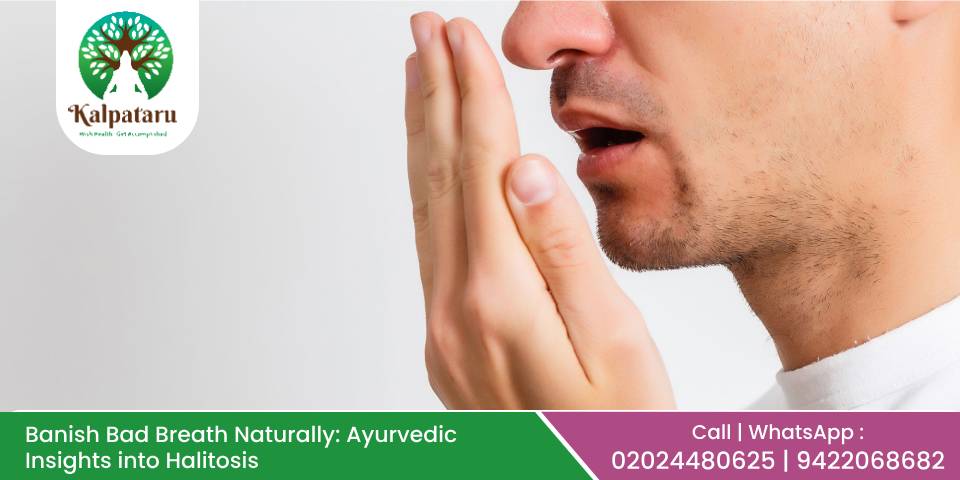
30Apr
Banish Bad Breath Naturally: Ayurvedic Insights into Halitosis
Halitosis, commonly known as bad breath, can be an embarrassing and uncomfortable condition affecting individuals worldwide. While commercial products offer temporary relief, Ayurveda, the ancient Indian system of medicine, provides holistic solutions that address the root cause of halitosis. By understanding the underlying imbalance in the body, Ayurveda offers natural remedies and lifestyle practices to combat bad breath and promote overall oral health. Understanding Halitosis from an Ayurvedic Perspective: According to Ayurveda, halitosis is primarily caused by an imbalance in the doshas, specifically the imbalance of Vata and Kapha doshas. When the digestive fire (agni) is weakened, undigested food particles accumulate in the digestive tract, leading to the production of toxins (ama). These toxins can manifest as bad breath when they reach the oral cavity.Furthermore, poor oral hygiene, improper diet, digestive issues, and systemic diseases can also contribute to halitosis according to Ayurvedic principles. Therefore, Ayurvedic treatment focuses on restoring balance to the doshas, improving digestion, and promoting oral hygiene to alleviate bad breath naturally. Ayurvedic Remedies for Halitosis: Tongue Scraping (Jihwa Prakshalana): Ayurveda recommends tongue scraping as a daily oral hygiene practice to remove accumulated toxins and bacteria from the tongue. Using a copper or stainless steel tongue scraper, gently scrape the surface of the tongue from back to front to eliminate odor-causing bacteria. Oil Pulling (Gandusha): Oil pulling is an ancient Ayurvedic practice that involves swishing oil in the mouth to draw out toxins and bacteria. Use organic sesame oil or coconut oil and swish it around in your mouth for 10-15 minutes before spitting it out. This practice not only freshens breath but also improves oral health. Herbal Mouth Rinse: Prepare a herbal mouth rinse using antimicrobial herbs like neem, clove, and peppermint. Boil these herbs in water, strain the solution, and use it as a mouth rinse after meals to kill bacteria and freshen breath. Digestive Support: Enhancing digestion is crucial in Ayurveda for preventing the accumulation of toxins that can cause bad breath. Incorporate digestive spices such as ginger, cumin, and fennel into your meals to strengthen the digestive fire and promote proper digestion. Stay Hydrated: Drinking plenty of water throughout the day helps flush out toxins from the body and keeps the mouth hydrated, reducing the risk of dry mouth and halitosis. Balanced Diet: Follow a balanced Ayurvedic diet that includes fresh fruits, vegetables, whole grains, and lean proteins. Avoid heavy, processed foods, as they can contribute to digestive issues and bad breath. Stress Management: Chronic stress can disrupt digestion and contribute to halitosis. Practice stress-reducing techniques such as yoga, meditation, and deep breathing exercises to promote relaxation and balance in the body. Conclusion: Halitosis is not just a superficial issue; it often reflects underlying imbalances in the body according to Ayurveda. By incorporating natural remedies and lifestyle practices that promote oral hygiene, digestion, and overall well-being, individuals can effectively address bad breath and experience lasting freshness from an Ayurvedic perspective. Embracing these holistic approaches not only eliminates bad breath but also supports optimal health and vitality.Dr. Manoj Deshpande and Dr. Aparna Deshpande at Kalpataru Ayurvediya Chikitsalaya™ Clinic provide the best Ayurvedic Treatment for Psoriasis & various diseases in Pune, Maharashtra. For more information about our comprehensive treatment options, or to request an appointment with the best Ayurvedic Doctor in Pune, call +919422068682 / +919764837167 / 020-24480625 or Click on Book an Appointment.
Read More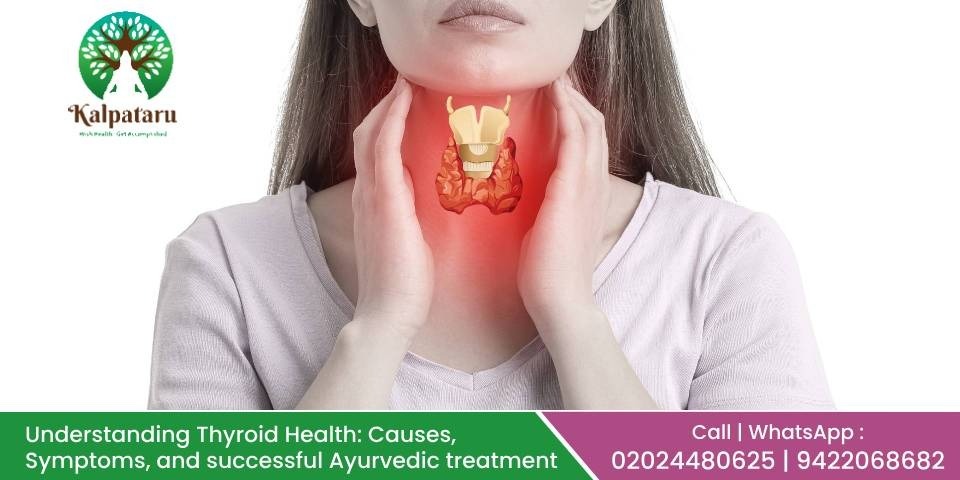
22Apr
Understanding Thyroid Health: Causes, Symptoms, and successful Ayurvedic treatment
The thyroid gland, a small butterfly-shaped organ located in the front of the neck, plays a crucial role in regulating various bodily functions by producing hormones. Thyroid disorders can significantly impact health, with hypothyroidism being one of the most common conditions associated with this gland. What is the Thyroid Gland? The thyroid gland produces hormones—thyroxine (T4) and triiodothyronine (T3)—that regulate metabolism, growth, and development. These hormones influence vital functions like heart rate, body temperature, and energy levels. Hypothyroidism: Underactive Thyroid Hypothyroidism occurs when the thyroid gland doesn't produce enough hormones to meet the body's needs. This condition can arise due to various factors. Causes of Hypothyroidism: Autoimmune Disease (Hashimoto's Thyroiditis): The most common cause where the immune system attacks the thyroid gland, impairing hormone production. Iodine Deficiency: Inadequate iodine intake affects hormone synthesis by the thyroid. Thyroid Surgery or Radiation Therapy: Treatment for thyroid cancer or other conditions can lead to reduced hormone production. Medications: Certain medications can interfere with thyroid hormone production. Symptoms of Hypothyroidism: Recognizing the signs of hypothyroidism is crucial for timely diagnosis and treatment. Common symptoms include: Fatigue Weight gain Cold sensitivity Dry skin Hair fall, hair thinning Constipation Depression Irritability Muscle weakness Irregular menstrual cycles. Etc Complications of Untreated Hypothyroidism: If left untreated, hypothyroidism can lead to serious health complications, including: Goiter: Enlargement of the thyroid gland due to constant stimulation by the pituitary gland. Heart Problems: Increased risk of heart disease, including elevated cholesterol levels and heart failure. Infertility and Pregnancy Issues: Hypothyroidism can affect fertility and increase the risk of miscarriage or birth defects if not managed during pregnancy. Myxedema: A rare but life-threatening condition characterized by extreme symptoms of hypothyroidism, such as decreased body temperature, confusion, and unconsciousness. Exploring Thyroid Health in Ayurveda: The concept of thyroid disorders in Ayurveda delves into the intricate balance of bodily elements and doshas (bio-energies) that influence overall health and well-being. As per ayurvedic principles, Thyroid disease can be correlated to "Galgand" vyadhi. According to Ayurvedic principles, imbalances in elements like ras (plasma), rakta (blood), maansa (muscles), meda (fat) dhatus, along with the accumulation of kapha dosha, can contribute to thyroid dysfunction. Ayurvedic Perspective on Thyroid Disorders: In Ayurveda, thyroid disorders are seen as a manifestation of underlying imbalances in the body's constitution. The treatments aim to restore harmony and promote optimal functioning by addressing these imbalances. Research in Ayurveda has explored herbal remedies and therapies that show promise in alleviating thyroid disorders. Role of Toxins in Thyroid Disorders: In Ayurveda, when you notice symptoms of thyroid imbalance by paying attention regularly, you may see that there are more toxins in the body because the metabolism is slower. This can lead to different symptoms like changes in weight, hair loss, feeling tired, irregular periods, and constipation. These symptoms mostly happen because toxins build up in the body. So, it's important to reduce toxins through medicine and special Ayurvedic treatments like panchakarma to treat thyroid problems effectively. Herbal Remedies and Therapies: Ayurvedic treatments often incorporate herbal remedies known for their potential to regulate thyroid function and reduce symptoms. Herbs like guggul, Kanchnar, Punarnava, Ashwagandha, Kunakhi, bhallatak, Varun, shigru, etc. have been studied for their ability to reduce TSH, goiter and thyroid nodules, potentially avoiding the need for surgical intervention. Lifestyle and Dietary Modifications: Ayurveda places significant emphasis on daily routines (dinacharya) and dietary habits (ahar) in managing thyroid health. These practices influence the body's biological clock (circadian rhythms) and metabolism. Mainly eating habits and sleeping time is the most important thing. Adopting specific dietary guidelines and incorporating Ayurvedic practices into daily routines can play a pivotal role in supporting thyroid function. Therapeutic Practices: Panchakarma treatments are an important part of healing thyroid disorders from their roots. Procedures like vomiting therapy (Vaman), purgation therapy (Virechana), enema therapy (Basti), nasal therapy (Nasya), and various types of herbal applications are highly beneficial in correcting thyroid imbalances. These treatments can help alleviate issues caused by thyroid medications. Additionally, incorporating different types of yoga along with exercise can also be very beneficial. Practices like Omkar chanting, Kapalabhati (breathing exercise), and specific yoga poses such as Sarvangasana, Halasana, Shishuasana, Matsyasana, and Dhanurasana help stimulate the thyroid gland to naturally produce necessary hormones. Early Recognition and Prevention: Recognizing the symptoms of thyroid disorders early is crucial in Ayurveda to prevent complications such as weight gain, fatigue, hair loss, depression, menstrual irregularities, and constipation. Ayurveda also acknowledges subclinical thyroid disorders, emphasizing the importance of expert advice and tailored treatment to prevent adverse health outcomes, particularly cardiovascular issues. Summary: Ayurveda advocates for a holistic approach to thyroid health, combining lifestyle modifications, herbal remedies, and therapeutic practices to restore balance and harmony in the body's functioning. By addressing the root cause of thyroid imbalances, Ayurveda aims to promote overall well-being and vitality. If you suspect thyroid dysfunction or are seeking alternative approaches to managing thyroid disorders, consult with a Kalpataru Ayurvediya Chikitsalaya™ qualified Ayurvedic Dr. Manoj Deshpande for personalized guidance and treatment options tailored to your unique constitution and health needs. Embracing Ayurvedic principles can offer a holistic pathway to thyroid wellness, enhancing both physical health and inner vitality.
Read More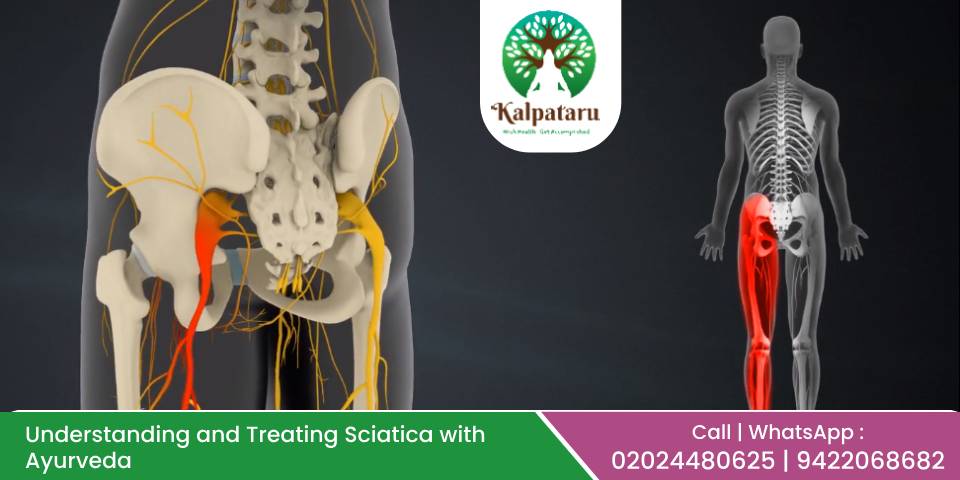
13Apr
Understanding and Treating Sciatica with Ayurveda
Sciatica is a common condition characterized by symptoms such as leg pain, numbness, and tingling, rooted in the disorder of the intervertebral discs in the spine. When discs in the lower back are displaced, they can press on nerves, leading to these uncomfortable sensations and reduced leg strength—a condition known as sciatica.Ayurveda, the ancient Indian system of medicine, offers a holistic approach to treating sciatica by addressing the underlying imbalance of Vata (air) and Kapha (earth) doshas. Ayurvedic therapies aim to restore balance and alleviate symptoms through various treatments:Snehana (Oleation Therapy): This involves specific massages using medicinal oils tailored to the individual's constitution, which helps in lubricating and strengthening tissues, reducing pain and inflammation.Swedana (Fomentation): A steam therapy that enhances circulation, relaxes muscles, and reduces stiffness, providing relief from sciatic symptoms.Basti (Enema Therapy): A key part of Panchakarma, basti involves administering herbal decoctions, oils, and salts into the rectum to detoxify and balance the body's internal environment. Basti treatments are customized based on the severity of the condition, lasting from eight to fifteen days.Ayurvedic Acupuncture(Vedhan) and Agnikarma: Unlike traditional acupuncture, Ayurvedic acupuncture uses specialized points with delicate insulin needles to minimize discomfort. Agnikarma, involving heat therapy with metals like gold or iron, helps in reducing pain and muscle tightness, promoting deep relaxation.Bloodletting (Raktamokshana): This Ayurvedic therapy aids in reducing the Vata dosha, thus alleviating pain associated with sciatica.Herbal Medications: Ayurvedic herbs like Padmakastha, Shring, Mandur, Ashwagandha, Shatavari, and Triphala are used to strengthen bones and muscles, providing stability to the spine and preventing recurrent episodes of sciatica.Physiotherapy and Lifestyle Modifications: Physiotherapy plays a vital role in improving stability and preventing sciatic flare-ups by strengthening muscles around the affected area. Lifestyle changes such as avoiding prolonged sitting, maintaining correct posture, lifting weights properly, and minimizing activities that strain the lower back are crucial to managing sciatica. For more information and treatment modalities watch our informative video https://www.youtube.com/watch?v=ySDM5b3P8Mc&t=3shttps://www.youtube.com/watch?v=S2SSbrSFj_c&t=2s Modern Science View of Sciatica: Modern medicine relies on advanced diagnostic tools like MRI scans and X-rays to accurately visualize and identify the underlying causes of sciatica. This technology helps healthcare providers tailor treatment plans based on individual patient presentations. Treatment Approaches: Medications: Nonsteroidal anti-inflammatory drugs (NSAIDs), muscle relaxants, and corticosteroid injections are commonly used in modern medicine to manage pain and inflammation associated with sciatica.Physical Therapy: Similar to Ayurveda, modern physical therapy focuses on strengthening and stretching exercises to alleviate pressure on the sciatic nerve and improve mobility.Minimally Invasive Procedures: In cases where conservative treatments fail, modern interventions like epidural steroid injections or minimally invasive spine surgeries (e.g., discectomy or laminectomy) may be recommended to relieve nerve compression.Ayurveda emphasizes a comprehensive approach to treating sciatica, focusing on restoring balance to the body and alleviating symptoms naturally. With the right combination of therapies and lifestyle adjustments, sciatica can be effectively managed and even completely cured without the need for surgery, significantly improving the quality of life for those affected by this condition. If you're struggling with sciatica, consider consulting an Ayurvedic practitioner to explore these holistic treatment options tailored to your needs and condition.Uptill now hundreds of patients with severe sciatica have been benefitted by Ayurvedic treatment at Kalpataru Ayurvediya Chikitsalaya™.Dr. Manoj Deshpande and Dr. Aparna Deshpande at Kalpataru Ayurvediya Chikitsalaya™ Clinic provide the best Ayurvedic Treatment for Psoriasis & various diseases in Pune, Maharashtra. For more information about our comprehensive treatment options, or to request an appointment with the best Ayurvedic Doctor in Pune, call +919422068682 / +919764837167 / 020-24480625 or Click on Book an Appointment.
Read More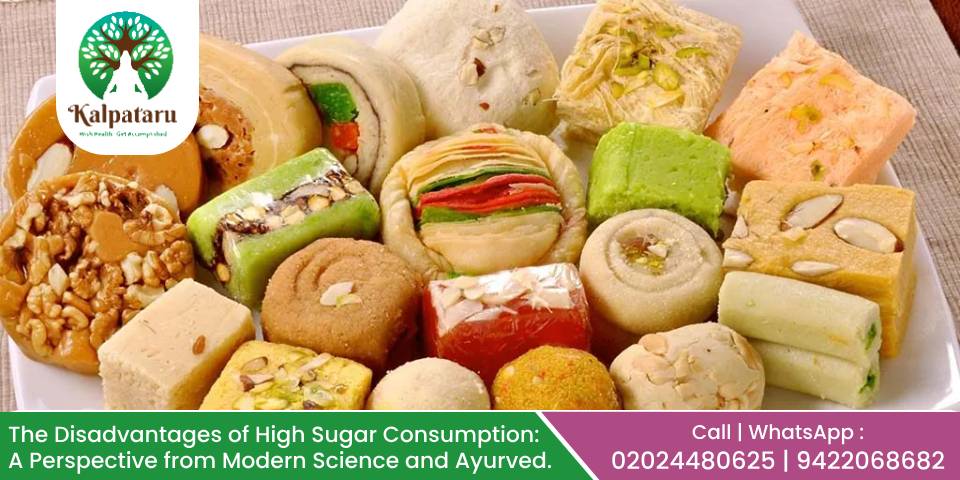
10Apr
The Disadvantages of High Sugar Consumption: A Perspective from Modern Science and Ayurved
Understanding the Role of the Sweet Taste: In the ancient tradition of Ayurveda, the taste is not merely a sensory experience but a fundamental aspect of health and well-being. Among the six recognized tastes, the sweet taste stands out for its nourishing qualities, attributed to a harmonious blend of the earth and water elements. From infancy to old age, the sweet taste plays a crucial role in promoting growth and sustaining bodily functions. The Importance of Moderation: While the sweet taste is essential for overall health, Ayurveda emphasizes the importance of moderation. Excessive consumption of sweet-tasting foods and substances can disrupt the delicate balance of energies within the body, leading to a range of health issues. It's crucial to appreciate the therapeutic properties of sweetness while being mindful of its potential drawbacks. Balancing Act: Sweetness and Health Ayurvedic texts acknowledge the therapeutic benefits of certain sweet-tasting medications, particularly in healing fractured bones and restoring equilibrium to the body's energies. Sweet taste brings satisfaction to both body and mind. However, when consumed in excess, sweetness can contribute to conditions such as obesity, diabetes, throat disorders, and even the formation of tumors. An imbalance in the Kapha dosha, associated with the elements of water and earth, can further compound health issues. The Need for Mindful Consumption: Despite the risks associated with excessive sweetness, it remains an integral part of a balanced diet. Children, the elderly, and pregnant women, in particular, require adequate levels of sweetness for optimal health. However, mindful consumption is key, ensuring that sweetness enhances rather than detracts from overall well-being. Striking a Balance: In Ayurveda, as in life, balance is paramount. By embracing the principles of moderation and mindfulness, individuals can harness the nourishing qualities of sweetness while mitigating its potential drawbacks. Through a holistic approach to diet and lifestyle, guided by the wisdom of Ayurveda, one can cultivate lasting health and well-being. Understanding the Harmful Effects of Sugar: Weight Gain: Excessive sugar consumption leads to obesity, a major risk factor for heart disease.Depression: Sugar can contribute to depression by affecting dopamine levels in the brain.Heart Disease: High sugar intake can lead to inflammation, elevated triglycerides, and increased blood pressure, all contributing to heart disease.Skin Issues: Sugar can worsen acne and accelerate skin aging due to increased oil production and collagen damage.Diabetes Risk: Sugar contributes to insulin resistance and obesity, increasing the risk of diabetes.Cancer: Sugar consumption may promote cell multiplication and inflammation, potentially raising cancer risk.Skin Aging: Sugar damages collagen and elastin, leading to wrinkles and sagging skin.Dental Cavities: Sugar is a primary cause of tooth decay and cavities.Joint Pain: Reduced sugar intake can alleviate joint pain, and excessive sugar is linked to an increased risk of arthritis.Fatty Liver: High sugar intake can contribute to fatty liver disease. Tips to Reduce Sugar Intake: Choose water, unsweetened beverages, or natural seltzer over sugary drinks.Foods with fresh fruits instead of added sugars.Opt for low-sugar cereals and snacks.Use natural nut butter instead of sweet spreads.Avoid sweetened alcoholic beverages.Focus on whole, fresh foods over processed options. Summary: In Ayurveda, the sweet taste, derived from a blend of earth and water elements, plays a vital role in nourishing the body and fostering growth. However, while sweetness is essential for overall health, excessive consumption can disrupt the body's balance, leading to various health issues. Ayurvedic texts acknowledge the therapeutic benefits of sweetness, but caution against overindulgence, which can contribute to obesity, diabetes, throat disorders, and imbalances in bodily energies. Despite these risks, sweetness remains integral to a balanced diet, particularly for children, the elderly, and pregnant women. By embracing moderation and mindfulness in consumption, individuals can harness the benefits of sweetness while safeguarding their health and well-being according to the principles of Ayurveda.Dr. Manoj Deshpande and Dr. Aparna Deshpande at Kalpataru Ayurvediya Chikitsalaya™ Clinic provide the best Ayurvedic Treatment for Psoriasis & various diseases in Pune, Maharashtra. For more information about our comprehensive treatment options, or to request an appointment with the best Ayurvedic Doctor in Pune, call +919422068682 / +919764837167 / 020-24480625 or Click on Book an Appointment.
Read More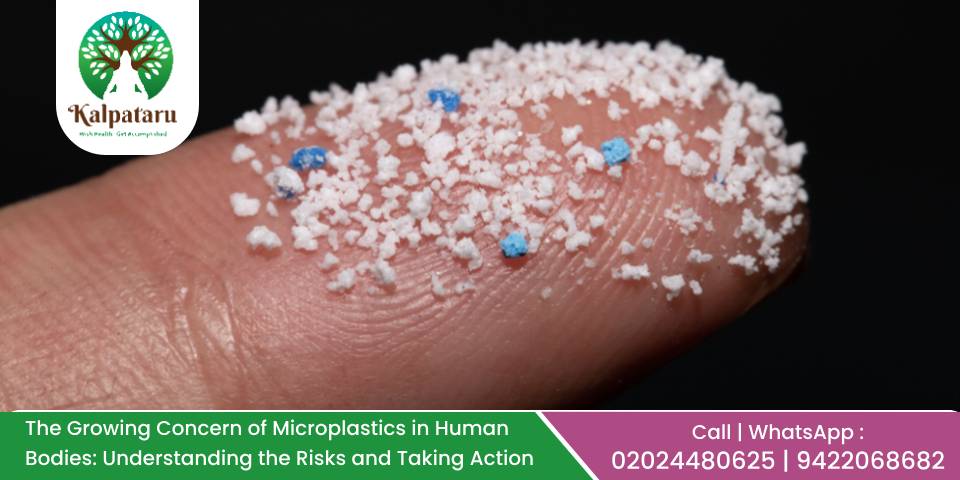
29Mar
The Growing Concern of Microplastics in Human Bodies: Understanding the Risks and Taking Action
Microplastics, minuscule plastic particles less than 5 millimeters in size, have infiltrated every corner of our environment, from the depths of oceans to mountain peaks, and even into our food and water supplies. However, perhaps the most alarming discovery is finding these microplastics within our bodies. While the long-term health effects are still being researched, there are concerning indications that these tiny pollutants could pose significant risks to human health. Plastic Contamination in Everyday Items: It has become increasingly common to use plastic in external celebrations and parties, where plastic serving plates are prevalent. When hot items are served on these plates, a portion of the plastic melts into the food. Additionally, various types of cold drinks are often stored in plastic bottles, which need to be continuously kept in a cold chain to maintain their freshness. However, sometimes these bottles are mishandled, exposed to heat, and release microplastic particles, including Bisphenol A, a molecule considered highly carcinogenic due to its cancer-causing properties, awareness about this issue is crucial.You may notice that even tea cups, which appear to be made of paper, often have a plastic laminate and coating inside, which can contaminate the beverage. Therefore, efforts should be made to encourage individuals, particularly students in schools, to carry their water in metal bottles instead of plastic ones. Repeated use of plastic bottles contributes to an increase in microplastic levels in the body over time. For more information and treatment modalities watch our informative video https://www.youtube.com/watch?v=kSXFrLOyxCYhttps://www.youtube.com/watch?v=t42m8jodF1Q&t=7s Understanding the Risks: Exposure to Harmful Chemicals: Microplastics have a remarkable ability to absorb and accumulate toxic substances such as heavy metals, pesticides, and industrial chemicals from their surroundings. When ingested, these microplastics release these toxins into our bodies, potentially leading to a range of health complications.Cellular Disruption: Studies have shown that microplastics can disrupt human cell function, leading to inflammation and even cell death. The full extent of these cellular disruptions and their long-term consequences remain to be fully understood.Endocrine Disruption: Certain plastics contain chemicals that can mimic hormones in the body, interfering with hormonal processes and potentially impacting development, metabolism, and reproduction.Increased Disease Risk: While still under investigation, there are concerns that microplastics may contribute to the development of chronic diseases such as cancer, obesity, and diabetes. How Microplastics Enter Our Bodies: Microplastics can infiltrate our bodies through various pathways:Ingestion: The primary route of exposure, microplastics can enter our bodies through contaminated food and water sources, leaching from plastic packaging and accumulating in seafood.Inhalation: Microplastics present in airborne dust, particularly in areas with high plastic pollution, can be breathed in.Skin Absorption: While less significant, microplastics may enter the body through the skin. Navigating Uncertainties and Taking Action: While research into the health impacts of microplastics is ongoing, there are proactive steps we can take to minimize exposure and protect our health:Reduce Plastic Use: Opt for reusable alternatives to reduce plastic consumption and subsequent microplastic contamination.Support Legislation: Advocate for policies that regulate plastic production and promote responsible plastic waste management.Stay Informed: Keep abreast of the latest scientific findings regarding microplastics and their potential health implications. Conclusion: The pervasive presence of microplastics demands a cautious approach to protect human health. While uncertainties remain, proactive measures such as reducing plastic usage and supporting legislative actions can mitigate risks. By staying informed and taking action, we can minimize exposure to microplastics and safeguard our health amid this environmental challenge.Dr. Manoj Deshpande and Dr. Aparna Deshpande at Kalpataru Ayurvediya Chikitsalaya™ Clinic provide the best Ayurvedic Treatment for Psoriasis & various diseases in Pune, Maharashtra. For more information about our comprehensive treatment options, or to request an appointment with the best Ayurvedic Doctor in Pune, call +919422068682 / +919764837167 / 020-24480625 or Click on Book an Appointment.
Read More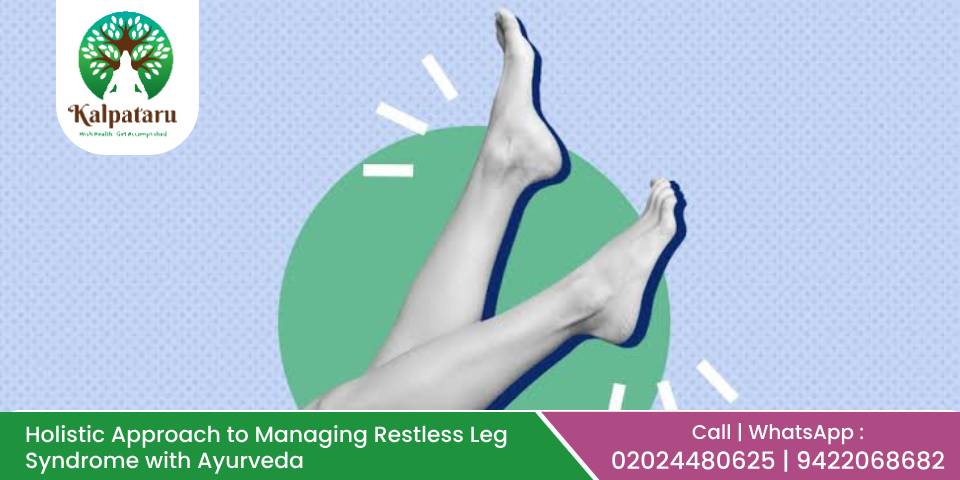
21Mar
Holistic Approach to Managing Restless Leg Syndrome with Ayurveda
Restless Leg Syndrome (RLS) can disrupt sleep and affect the quality of life for those who experience it. While conventional treatments may involve medications with potential side effects, Ayurveda offers a holistic approach to managing RLS naturally. In this blog, we'll explore Ayurvedic principles and remedies for alleviating the symptoms of RLS and promoting overall well-being. Understanding Restless Leg Syndrome from an Ayurvedic Perspective: In Ayurveda, Restless Leg Syndrome can be compared to the concept of Pindikodweshtan, where the aggravated Vata dosha imbalance disrupts the proper functioning of muscles and nerves, leading to disturbing movements and discomfort in the legs. This imbalance can be triggered by various factors, including stress, poor dietary habits, and irregular daily routines. When Vata dosha is aggravated, it can manifest as symptoms like restlessness, twitching sensations, and difficulty in relaxing, all of which are characteristic of RLS. Ayurvedic Management Strategies: Balancing Vata Dosha: Adopting a Vata-pacifying diet: Focus on warm, cooked foods that are nourishing and grounding, such as soups, stews, whole grains, and cooked vegetables. Avoid cold, dry, and processed foods, as they can aggravate Vata. Regular daily routine: Establishing a consistent daily schedule can help regulate Vata dosha. Aim to wake up and go to bed at the same time each day, and incorporate relaxation practices like meditation and gentle yoga into your routine. Herbal remedies: Ayurvedic herbs such as Ashwagandha, Brahmi, Shatavari and kalpas like Madhumaalini Vasant are known for their calming and nerve-strengthening properties. These herbs and formulations can help soothe the nervous system and alleviate symptoms of RLS when taken under the guidance of an Ayurvedic practitioner. Ayurvedic Therapies: Abhyanga (Ayurvedic Oil Massage): Regular self-massage with warm sesame oil or some siddha oils like sahachar tel, mashsaindhav oil can help pacify Vata dosha and promote relaxation. Focus on massaging the legs gently, paying attention to areas where you experience discomfort or tension. Panchakarma Therapy: Detoxification and rejuvenation treatments such as Shirodhara (warm oil pouring on the forehead) and Basti (medicated enema) can help balance Vata dosha and promote relaxation. Lifestyle Modifications: Avoiding addictive habits and excessive standing or sitting: Individuals with RLS should refrain from indulging in any addictive habits like smoking and tobacco and avoid standing for long periods or sitting in one place for too long, as these behaviors can worsen the condition. Moderate exercise: Engaging in moderate exercise can help alleviate symptoms of RLS. However, excessive or intense cardio or weight training exercises should be avoided as they can exacerbate leg pain. Some specific yogic postures such as Vajrasan , Sarwangasan are helpful to minimise pains and discomfort Elevating legs and gentle massage: Elevating the legs with a pillow before sleep and gently massaging them for five to ten minutes can provide relief from RLS symptoms. Nutritional Considerations: Balanced diet: Consuming a nutritious diet is essential for managing RLS. Ensure you are getting adequate vitamins and minerals through your diet, or consider supplements if deficiencies are present. Conclusion: Restless Leg Syndrome can significantly impact the quality of life, but Ayurveda offers a gentle and holistic approach to managing this condition. By addressing the underlying imbalances in the body and mind through diet, lifestyle modifications, and Ayurvedic therapies, individuals can find relief from RLS symptoms and experience greater overall well-being. However, it's crucial to consult with a qualified Ayurvedic practitioner before beginning any new treatment regimen to ensure personalized and effective care. With patience and dedication, Ayurveda can offer a path to restoring harmony and tranquility to the restless legs and the entire being.
Read More
19Mar
Preconception Care in Ayurveda: Cultivating Optimal Health for Future Generations
In the realm of Ayurveda, the journey towards parenthood begins long before conception itself. Rooted in ancient wisdom, Ayurveda offers a holistic approach to preconception care, focusing on harmonizing the mind, body, and spirit of both partners to create an optimal environment for conception and the birth of a healthy progeny. This extended blog further explores the multifaceted aspects of preconception care in Ayurveda, delving deeper into its practices and philosophies. Understanding Preconception Care in Ayurveda: Balancing Doshas: Central to Ayurvedic principles is the concept of doshic equilibrium – the balance of Vata, Pitta, and Kapha energies within the body. Imbalances in these doshas can disrupt reproductive health and fertility. Preconception care begins with identifying any doshic imbalances through pulse diagnosis (Nadi Pariksha) and assessing the individual constitution (Prakriti). Based on these assessments, personalized dietary recommendations, lifestyle modifications, and herbal formulations are prescribed to restore doshic balance and optimize reproductive health. Cleansing and Detoxification (Panchakarma): Panchakarma, the cornerstone of Ayurvedic detoxification therapy, holds immense significance in preconception care. This comprehensive purification process aims to eliminate accumulated toxins (ama) from the body, cleanse the reproductive channels, and enhance the receptivity of the reproductive tissues (Shukra dhatu). Customized Panchakarma protocols, including therapies such as Basti (enema), Vamana (emesis), and Virechana (purgation), are administered under the guidance of an Ayurvedic practitioner to prepare the body for conception and promote reproductive vitality. Nourishing Reproductive Tissues: In Ayurveda, the quality of reproductive tissues (Shukra dhatu) is considered paramount in ensuring a healthy progeny. Preconception care involves nourishing and strengthening these tissues through a combination of dietary modifications, herbal supplements, and rejuvenating therapies (Rasayana). Nutrient-dense foods such as organic fruits, vegetables, whole grains, and dairy products are recommended to support the optimal functioning of reproductive organs and enhance sperm and egg quality. Additionally, Ayurvedic formulations containing herbs like Ashwagandha, Shatavari, and Gokshura , Guduchi, kawach beej,Safed Musali, Trifala etc are prescribed to promote hormonal balance, improve libido, and enhance fertility. Managing Stress and Emotions: Ayurveda recognizes the profound influence of emotional well-being on reproductive health and fertility. Stress, anxiety, and negative emotions can create imbalances in the subtle energies (Prana) and disrupt the flow of vital life force (Ojas) within the body, affecting fertility. Preconception care emphasizes the importance of cultivating a positive mindset and managing stress through practices such as meditation, yoga, and pranayama (breathing exercises). These ancient techniques help alleviate stress, balance the nervous system, and create a conducive internal environment for conception to occur. Ayurvedic Herbs and Formulations: The rich pharmacopeia of Ayurveda offers a treasure trove of herbs and formulations renowned for their efficacy in enhancing fertility and promoting reproductive health. Ashwagandha (Withania somnifera), known as the "Indian ginseng," is revered for its adaptogenic properties, which help alleviate stress and enhance vitality. Shatavari (Asparagus racemosus) is celebrated as a rejuvenating herb for the female reproductive system, supporting hormonal balance and enhancing fertility. Similarly, Gokshura (Tribulus terrestris) is prized for its aphrodisiac properties, improving libido and sperm quality in men. These herbs, along with various Ayurvedic formulations, are tailored to individual needs to optimize fertility and increase the likelihood of conception. Timing of Conception: Ayurveda recognizes the significance of aligning conception with the natural rhythms of the body and the cosmos. The timing of conception (Garbhadhana) is carefully considered, taking into account factors such as the woman's menstrual cycle, planetary influences, and auspicious astrological timings (Muhurta). By aligning conception with the optimal cosmic energies, couples can enhance the chances of conceiving a healthy and auspicious progeny. Conclusion: Preconception care in Ayurveda offers a holistic pathway to parenthood by addressing the physical, emotional, and spiritual aspects of fertility. Kalpataru Ayurvediya Chikitsalaya™ stands as a trusted partner in your preconception journey, offering personalized interventions, expert guidance, and compassionate support to help you conceive a healthy progeny. Embrace the wisdom of Ayurveda and embark on your journey towards parenthood with confidence and vitality, knowing that you are in capable hands at Kalpataru Ayurvediya Chikitsalaya™.
Read More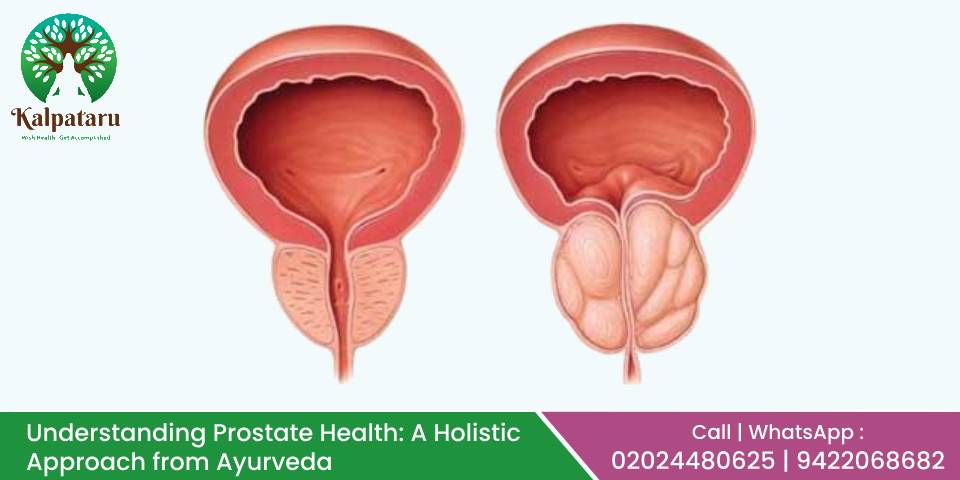
11Mar
Understanding Prostate Health: A Holistic Approach from Ayurveda
In the realm of men's health, the prostate gland plays a vital yet often overlooked role. In Ayurveda, this walnut-sized gland is referred to as the "Paurush Granthi," symbolizing its importance in male vitality. However, as men age, the prostate gland may undergo changes leading to various complications, highlighting the significance of holistic approaches to prostate health. The Prostate: Balancing Act of Aging As men age, the prostate gland may undergo enlargement, a condition known as benign prostatic hyperplasia (BPH). This enlargement can lead to urinary difficulties, such as increased frequency, urgency, or incomplete emptying of the bladder. Such symptoms can significantly impact quality of life, prompting individuals to seek medical intervention. Modern Diagnostic Tools and Ayurvedic Insights In modern medicine, the Prostate-Specific Antigen (PSA) test serves as a primary tool for prostate cancer screening. Elevated PSA levels may warrant further investigation, including digital rectal examination, to assess the size and condition of the prostate gland. However, it's essential to note that an enlarged prostate does not always indicate cancer but can be benign. Ayurveda: Harnessing Nature's Remedies Ayurveda offers a holistic approach to prostate health, focusing on natural remedies and lifestyle modifications. Herbal formulations such as Chandraprabha, Shilajit, Gokshura, and others have been traditionally used to support prostate function and alleviate symptoms associated with BPH. These herbs are known for their anti-inflammatory and diuretic properties, which may help reduce prostate swelling and improve urinary flow. Guggulu: Nature's Gift for Prostate Health Guggulu, derived from the resin of the Commiphora mukul tree, holds a special place in Ayurvedic medicine for its therapeutic benefits. Research suggests that Guggulu possesses anti-inflammatory and antioxidant properties, making it a valuable addition to prostate health formulations. Its ability to support healthy cholesterol levels further contributes to overall well-being. Panchakarma: Restoring Balance In Ayurveda, Panchakarma therapies play a pivotal role in detoxifying the body and restoring balance. Treatments such as Basti (medicated enema) and Virachana (therapeutic purgation) are particularly beneficial for prostate health. These therapies help eliminate toxins from the body, alleviate inflammation, and promote optimal functioning of the prostate gland. Empowering Prostate Health with Ayurveda While modern medicine offers surgical interventions for prostate-related issues, Ayurveda provides a gentler alternative rooted in nature's wisdom. By embracing Ayurvedic principles and incorporating herbal remedies, individuals can take proactive steps towards maintaining prostate health and overall well-being. For more information and treatment modalities watch our informative video https://www.youtube.com/watch?v=MVXklLEKfs4https://www.youtube.com/watch?v=eafpp6olPQ0&t=1s Conclusion: The journey to prostate health encompasses a blend of modern diagnostics and ancient wisdom. Through a holistic approach that integrates Ayurvedic principles, herbal remedies, and lifestyle modifications, men can nurture their prostate health and thrive at every stage of life. By embracing the synergy between modern medicine and Ayurveda, individuals can embark on a path towards vitality, balance, and longevity.Dr. Manoj Deshpande and Dr. Aparna Deshpande at Kalpataru Ayurvediya Chikitsalaya™ Clinic provide the best Ayurvedic Treatment for Psoriasis & various diseases in Pune, Maharashtra. For more information about our comprehensive treatment options, or to request an appointment with the best Ayurvedic Doctor in Pune, call +919422068682 / +919764837167 / 020-24480625 or Click on Book an Appointment.
Read More
29Feb
EU Stress: Positive Side of Stress
In the hustle and bustle of modern life, stress has become an unwelcome companion for many. However, what if we told you that not all stress is bad? In the ancient wisdom of Ayurveda, there exists a concept that aligns with this notion – EU stress, or positive stress. Let's delve into this idea from an Ayurvedic perspective and explore how it can be harnessed to promote overall well-being. Understanding Eustress in Ayurveda: In Ayurveda, stress is viewed as an imbalance in the doshas – Vata, Pitta, and Kapha – which are the fundamental energies that govern our physical and mental constitution. Eustress, therefore, can be seen as a state where these energies are stimulated positively, leading to increased vitality and resilience.Eustress manifests when we are engaged in activities that align with our inherent nature and purpose, encouraging growth, adaptation, and personal development. It is akin to the concept of "Utsaha" or enthusiastic effort in Ayurveda, where the mind and body are invigorated by positive challenges. Identifying Eustress in Daily Life: Ayurveda emphasizes the importance of self-awareness in recognizing the subtle shifts within our being. Here are some ways to identify eu stress from an Ayurvedic standpoint:Prana – The Vital Life Force: Eustress enhances the flow of prana, our vital life force, throughout the body. It leaves us feeling energized, inspired, and connected to our purpose.Agni – The Digestive Fire: When experiencing eustress, our agni, or digestive fire, remains balanced and efficient. We feel a sense of enthusiasm and motivation without experiencing digestive discomfort or fatigue.Ojas – The Essence of Vitality: Eustress nourishes our ojas, the subtle essence that governs immunity and overall vitality. It leaves us feeling resilient and capable of facing life's challenges with grace. Examples of eustress? You might benefit from some examples of eustress to help you identify it. Here are a few quick scenarios where you might experience eustress:Starting your dream jobTraveling to a new countryExam Preparation What makes eustress good? When we experience eustress, it can be a great motivator. But don't be fooled, it's still stress. Stress hormones like cortisol and adrenaline are still pumping through your body. Your heart rate can still race, and your hands can get sweaty. You're just excited as it's happening.Our eustress empowers us, which makes it good for developing our resilience. Our eustress helps us manage challenging obstacles and learn that we can overcome whatever's thrown our way. Then, when we face a new challenge, we're ready to tackle it head-on and come out stronger.It's good for us to learn that sustained action and effort create change. It changes how we develop a plan, adopts a growth mindset, and make things happen for ourselves. We see that we're capable of accomplishing things even stressful ones. Harnessing Eustress for Optimal Well-being: Ayurveda offers holistic practices to cultivate eustress and maintain harmony within the mind, body, and spirit. Here are some Ayurvedic strategies to harness the power of eustress:Align with Your Prakriti: Discover your unique constitution, or Prakriti, and engage in activities that resonate with your innate tendencies. Whether it's pursuing a creative endeavor or exploring new experiences, honor your authentic self.Cultivate Sattva: Embrace sattvic practices that promote clarity, tranquility, and positivity. Meditation, yoga, and mindful breathing can help cultivate a sattvic mindset, allowing eustress to flourish.Nourish with Rasayanas: Incorporate rejuvenating herbs and foods known as rasayanas into your daily routine to support vitality and resilience. Adaptogenic herbs like Ashwagandha and Shatavari can help buffer the effects of stress while enhancing overall well-being.Honor Rhythm and Routine: Establish a daily routine aligned with the natural rhythms of the day to promote balance and stability. Prioritize adequate rest, nourishing meals, and regular exercise to fortify the body against stressors.Practice Pranayama: Explore pranayama techniques such as Nadi Shodhana (alternate nostril breathing) and Bhramari (humming bee breath) to regulate the breath and calm the mind. Pranayama enhances pranic flow, fostering a state of eustress and mental clarity. Conclusion: In the tapestry of life, eustress serves as a vibrant thread that weaves together growth, resilience, and fulfillment. By embracing the wisdom of Ayurveda, we can harness the transformative power of eustress to cultivate vitality, purpose, and holistic well-being. Let us embark on this journey with open hearts and minds, embracing the positive stressors that propel us toward our highest potential.Dr. Manoj Deshpande and Dr. Aparna Deshpande at Kalpataru Ayurvediya Chikitsalaya™ Clinic provide the best Ayurvedic Treatment for Psoriasis & various diseases in Pune, Maharashtra. For more information about our comprehensive treatment options, or to request an appointment with the best Ayurvedic Doctor in Pune, call +919422068682 / +919764837167 / 020-24480625 or Click on Book an Appointment.
Read More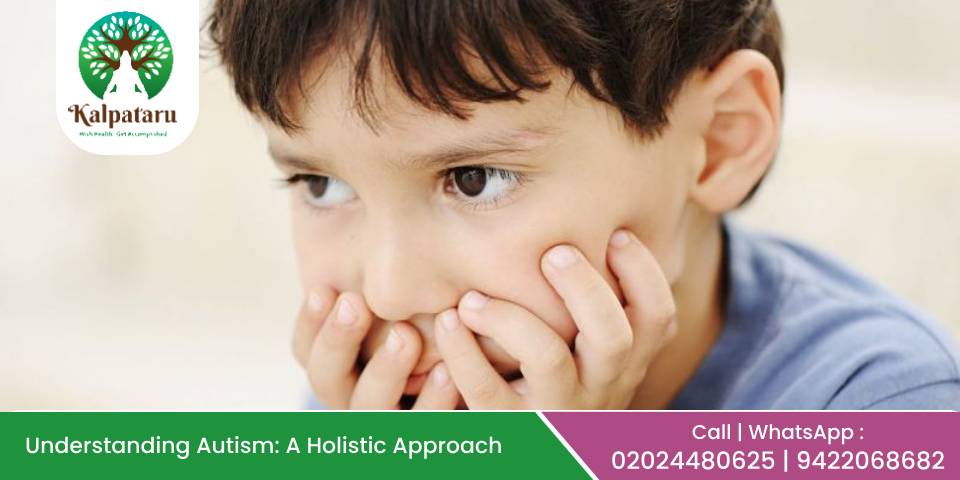
26Feb
Understanding Autism: A Holistic Approach
Autism, a neurodevelopmental disorder, manifests in various ways, impacting social interaction, communication, and behavior. As we delve into understanding autism, it's essential to explore its prevalence, seriousness, and potential treatments, including Ayurvedic approaches. What is Autism? Autism, also known as Autism Spectrum Disorder (ASD), is characterized by challenges in social interaction, communication, and repetitive behaviors. Individuals with autism may have unique strengths and differences in sensory processing. It's crucial to understand that autism is a spectrum disorder, meaning it affects individuals differently, ranging from mild to severe. Global Statistics: Prevalence: According to the World Health Organization (WHO), autism affects an estimated 1 in 160 children worldwide. However, recent studies suggest that the prevalence may be higher, with some reports indicating rates as high as 1 in 54 children in certain populations.Gender Disparities: Autism is diagnosed more frequently in boys than girls, with boys being approximately four times more likely to be diagnosed with ASD than girls. This gender disparity remains consistent across various regions globally. India Statistics: Estimated Prevalence: Studies suggest a prevalence of around 1 in 68 children in India. However, there's wide variation in estimates depending on the region. Early Signs and Importance of Early Intervention: While not always readily apparent, early signs of autism can appear in infancy or toddlerhood. These may include delayed speech and communication milestones, difficulty making eye contact, repetitive movements, and an intense focus on specific interests. Early intervention is crucial for supporting the development of these children and improving their future outcomes. The Seriousness of Autism: Many children are suffering from autism, a neurodevelopmental disorder that significantly impacts their social interaction, communication, and behavior. The seriousness of autism lies in its potential lifelong impact on individuals and families. Early intervention plays a crucial role in addressing the challenges posed by autism, as timely identification and support can lead to better outcomes in terms of cognitive, social, and emotional development. Without early intervention, children with autism may face difficulties in forming relationships, acquiring essential life skills, and achieving academic success. Therefore, raising awareness about the importance of early intervention and ensuring access to appropriate services is essential for improving the quality of life for individuals with autism and their families. Concept of Autism in Ayurveda: In Ayurveda, autism is understood as a disturbance in the balance of doshas (bioenergies) affecting the mind-body complex. While classical Ayurvedic texts may not directly mention autism, the principles of Ayurveda emphasize the interconnectedness of physical, mental, and emotional health.According to Ayurvedic philosophy, imbalances in the doshas, particularly Vata dosha, which governs movement and communication, can contribute to neurological and behavioral issues observed in autism. Ayurvedic approaches to autism focus on restoring balance and harmony through personalized diet, lifestyle modifications, herbal remedies, and therapeutic treatments aimed at caring the nervous system and enhancing overall well-being. Ayurvedic Treatment for Autism: Various Ayurvedic medications like ghee-based preparations such as Kumar Kalyan Ghrita, Brahmi Ghrita, etc., are used because ghee can aid in the absorption of nutrients and deliver medicines effectively to the brain. Additionally, herbs like Jatamansi, Shankhpushpi, Jyotishmati, Brahmi, etc., are also used. Some precious medicines like Abhrak Bhasma (made from mica), Suvarna Bhasma (gold), and Raupya Bhasma (silver), are reserved for severe cases.Diet and lifestyle are crucial because what we eat affects our brain and overall health. This is particularly important during pregnancy when avoiding stress, getting proper rest, having a balanced diet, maintaining mental peace, practicing yoga, meditation, music, or any other calming activity can reduce the risk of autism in future generations.Let's delve into the details of some key Ayurvedic treatments commonly used in the management of autism:Shirodhara: Shirodhara involves a continuous stream of warm, medicated oil poured over the forehead in a rhythmic manner. This soothing therapy helps calm the mind, reduce stress, and promote relaxation. In individuals with autism, Shirodhara can aid in improving focus, reducing anxiety, and enhancing sensory integration.Shiropichu: Shiropichu is a therapeutic procedure where medicated oil is applied to the scalp using a cotton pad or cloth. In autism, Shiropichu can contribute to improving cognitive function, reducing hyperactivity, and enhancing overall well-being.Shirolep: Shirolep involves the application of a herbal paste or pack on the scalp. In individuals with autism, Shirolep may aid in calming the mind, improving concentration, and boosting sensory sensitivities.Nasya: Nasya involves the administration of medicated oils or herbal preparations through the nasal passage. In autism, Nasya therapy can support cognitive function, enhance sensory processing, and alleviate symptoms related to congestion or allergies.Sarvang Abhyanga: Sarvang Abhyanga, or full-body massage, is a deeply relaxing and therapeutic practice in Ayurveda. In individuals with autism, Sarvang Abhyanga can help reduce muscle tension, improve sleep quality, and enhance overall sensory integration.Basti: Basti involves the administration of medicated enemas to cleanse and nourish the colon. In autism, Basti therapy can support gastrointestinal health, regulate bowel function, and promote overall detoxification and rejuvenation. For more information and treatment modalities watch our informative video https://www.youtube.com/watch?v=G20H8WL_xFw&t=14shttps://www.youtube.com/watch?v=z56vHmSsU0Q&t=4s Benefits of Ayurvedic Treatments for Autism: Reduces anxiety and stress Improves focus and attention span Enhances sensory integration Supports cognitive function and learning Reduces hyperactivity and impulsivity Promotes relaxation and better sleep quality Conclusion: Autism is a complex neurodevelopmental disorder that requires a holistic approach to understanding and management. Through awareness of its prevalence, recognition of early signs, and timely intervention, we can better support individuals and families affected by autism. Ayurveda offers valuable insights and therapeutic options, focusing on restoring balance and promoting overall well-being.Dr. Manoj Deshpande and Dr. Aparna Deshpande at Kalpataru Ayurvediya Chikitsalaya™ Clinic provide the best Ayurvedic Treatment for Psoriasis & various diseases in Pune, Maharashtra. For more information about our comprehensive treatment options, or to request an appointment with the best Ayurvedic Doctor in Pune, call +919422068682 / +919764837167/ 020-24480625 or Click on Book an Appointment.
Read More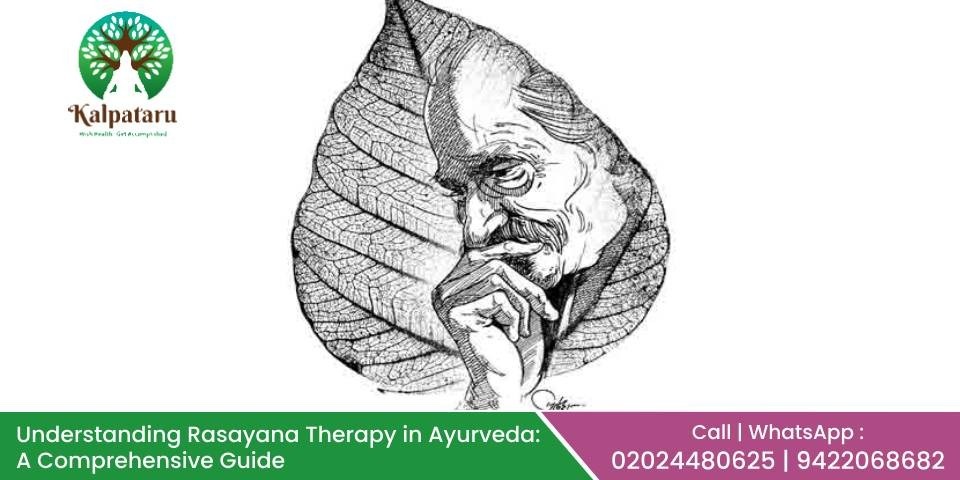
23Feb
Understanding Rasayana Therapy in Ayurveda: A Comprehensive Guide
Central to Ayurvedic philosophy is the concept of Rasayana therapy, a preventive healthcare approach aimed at enhancing longevity, vitality, and immunity. In this comprehensive guide, we delve into the principles, benefits, and significance of Rasayana therapy as elucidated in Ayurvedic texts. Rasayana: An Overview Rasayana, derived from the Sanskrit words 'rasa' meaning essence and 'ayana' meaning path, embodies the journey towards rejuvenation and vitality. It encompasses a wide array of medicines and lifestyle practices designed to nourish the body's tissues, promote longevity, and combat the effects of aging. According to Ayurvedic principles, Rasayanas are instrumental in maintaining optimal health, bolstering immunity, and preventing the onset of diseases.Rasayana holds a central position within Ashtang Ayurveda, the holistic system of traditional medicine. As one of its eight major components, Rasayana therapy is crucial not only for rejuvenation but also for supporting various branches of Ayurveda. Its role extends beyond standalone therapy, synergizing with other treatments to promote overall wellness and longevity. Rasayana is defined as those medicines (and non-medicines including conduct, lifestyle changes, behavior, etc.) which are helpful in gaining high quality tissue in optimum and desired quantity. Any medicine which has the below-mentioned qualities, is called as Rasayana -Delays ageingDestroys diseaseBestows longevityStouteningAphrodisiac Qualities of Rasayana: To qualify as a Rasayana, a substance or therapy must exhibit certain key attributes:Delaying Aging: Rasayanas possess the ability to retard the aging process at the cellular level, promoting youthful vigor and vitality.Disease Destruction: These therapeutic agents are adept at combating various diseases and disorders, bolstering the body's natural defense mechanisms.Bestowing Longevity: Rasayanas are renowned for their capacity to extend lifespan and promote overall well-being.Stoutening: Rasayanas strengthen the body's structural framework, including muscles, bones, and joints, imparting robustness and resilience.Aphrodisiac: Certain Rasayanas possess aphrodisiac properties, fostering sexual health and vitality. Benefits of Rasayana Therapy: The manifold benefits of Rasayana therapy extend beyond physical well-being to encompass mental, emotional, and spiritual dimensions. Some of the key advantages include:Longevity: Rasayanas promote longevity by rejuvenating the body's vital organs and systems, thereby enhancing overall lifespan.Enhanced Memory and Intelligence: These therapeutic modalities bolster cognitive function, sharpening memory, focus, and mental acuity.Optimum Health: Rasayanas optimize physiological functions, ensuring the harmonious functioning of bodily systems and organs.Youthfulness: By counteracting the effects of aging, Rasayanas help preserve youthful vigor, vitality, and appearance.Physical and Mental Strength: They imbue the body and mind with resilience, strength, and endurance, enabling individuals to navigate life's challenges with vigor.Radiance: Rasayanas promote inner vitality and external radiance, bestowing a healthy glow and luminosity to the complexion.Wholesome for Eyes: They enhance ocular health and vision, ensuring clarity of sight and visual acuity. Importance of Rasayanas: Rasayanas encompass a diverse range of therapeutic agents and practices, including:Immunity Modulators: Rasayanas enhance immune function, bolstering the body's natural defense mechanisms against infections and diseases.Anti-aging Formulations: These Rasayanas target age-related degenerative processes, promoting cellular rejuvenation and longevity.Preventive Care: Rasayanas aimed at preventing the onset of diseases by optimizing health and immunity.Disease Modifiers: Therapeutic agents that mitigate the progression of existing diseases and disorders, promoting healing and recovery.Tissue Strengtheners: Rasayanas that fortify the body's tissues, including muscles, bones, and joints, enhancing structural integrity and resilience.Rejuvenators: These Rasayanas rejuvenate the body and mind, restoring vitality, vigor, and youthful vitality.Longevity Enhancers: Rasayanas that promote longevity by optimizing physiological functions and preserving youthful vigor. For more information and treatment modalities watch our informative video https://www.youtube.com/watch?v=G_sHLLbs5H4&t=6shttps://www.youtube.com/watch?v=ApzkVxWaqJo&t=6s How Long Can Anti Aging Medicines Be Taken? Even though Rasayana medicines, such as Chyawanprash, are renowned for their rejuvenating properties and are often associated with anti-aging benefits in Ayurveda, it is advisable to limit their usage to a specific timeframe. While these medicines work to enhance longevity and promote overall health by revitalizing bodily tissues and organs, their prolonged use may not be necessary for everyone. It's essential to recognize that the need for anti-aging medicines varies among individuals and is contingent upon factors such as age, health condition, and lifestyle. While Rasayana medicines can certainly contribute to a longer and healthier life, they should be used judiciously and under the guidance of a qualified Ayurvedic practitioner. Swasthasya Urjaskara Or Swasthasya Ojaskaram Rasayanas are categorized under the classification of Swasthasya Urjaskara or Swastasya Ojaskaram within Ayurvedic medicine. Swasthasya Urjaskara pertains to substances and therapies that enhance, fortify, or enrich the quality and quantity of health in individuals who are already healthy. In essence, Rasayanas are beneficial not only for those seeking treatment but also for maintaining optimal health and preventing diseases by bolstering immunity. Swasthasya Urjaskara encompasses therapies aimed at sustaining good health and preventing illnesses by optimizing bodily functions. Alongside Rasayanas, another member of this category is Vrushya or Vajikarana, which includes aphrodisiacs and sexual health medicines. Together, these therapies aim to promote overall well-being, vitality, and resilience in individuals, irrespective of their current health status. Conclusion: In the holistic paradigm of Ayurveda, Rasayana therapy occupies a central position as a cornerstone of preventive healthcare and longevity. By harnessing the healing power of nature and adhering to time-tested principles, Rasayanas offer a holistic approach to wellness that encompasses the physical, mental, and spiritual dimensions of health. Incorporating Rasayana therapy into one's lifestyle can pave the way for a life of vitality, longevity, and radiant well-being.Dr. Manoj Deshpande and Dr. Aparna Deshpande at Kalpataru Ayurvediya Chikitsalaya™ Clinic provide the best Ayurvedic Treatment for Psoriasis & various diseases in Pune, Maharashtra. For more information about our comprehensive treatment options, or to request an appointment with the best Ayurvedic Doctor in Pune, call +919422068682 / +919764837167 / 020-24480625 or Click on Book an Appointment.
Read More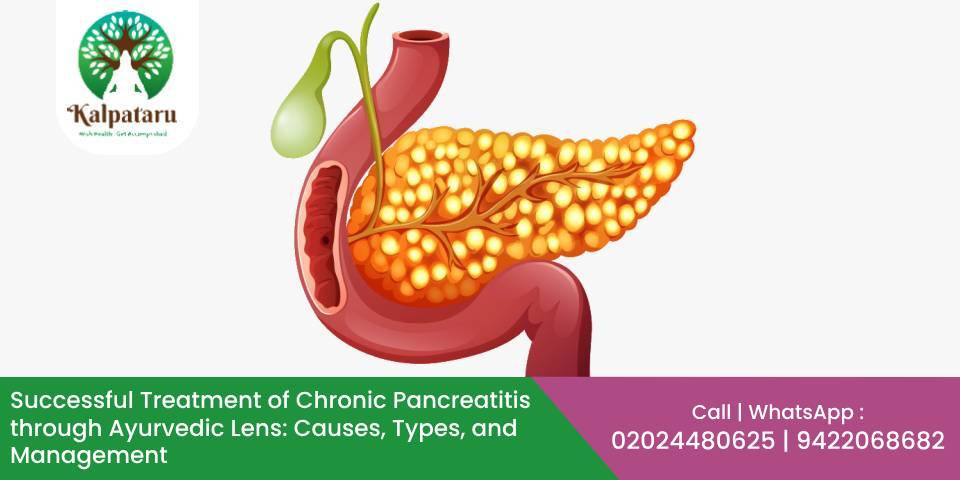
12Feb
Successful Treatment of Chronic Pancreatitis through Ayurvedic Lens: Causes, Types, and Management
Chronic pancreatitis is a debilitating condition characterized by inflammation and irreversible damage to the pancreas over time. In Ayurveda, this ailment is understood as a disturbance in the Agni (digestive fire) and is attributed to various factors that disrupt the balance of the body. Let's delve into the Ayurvedic perspective on chronic pancreatitis, exploring its types, underlying reasons, and the transition from acute to chronic stages. What is Chronic Pancreatitis? In Ayurveda, chronic pancreatitis can be correlated with"Pittaja Gulma," where Pitta dosha aggravation leads to the formation of a mass or tumor-like structure in the pancreas. This condition disrupts the normal functioning of the pancreas, impacting digestion, metabolism, and overall health. Types of Pancreatitis: Acute Pancreatitis: This is a sudden inflammation of the pancreas, often caused by small gallstones or excessive alcohol consumption. It typically resolves within a few days with proper treatment.Chronic Pancreatitis: Unlike acute pancreatitis, chronic pancreatitis is a persistent inflammation that gradually worsens over time. It can lead to permanent damage to the pancreas, affecting its ability to function properly. Reasons Behind Chronic Pancreatitis: Dietary Factors: Consuming excessive amounts of spicy, oily, and processed foods can aggravate pitta dosha, leading to inflammation in the pancreas.Alcohol Abuse: Excessive alcohol consumption is considered a major cause of chronic pancreatitis in Ayurveda. Alcohol aggravates pitta dosha and leads to the accumulation of ama in the pancreas.Smoking: According to Ayurveda, smoking disrupts the balance of doshas and contributes to the formation of ama, which can damage the pancreas over time.Chronic Stress: Stress is known to disturb the balance of doshas, particularly vata and pitta, leading to digestive problems and inflammation in the pancreas.Genetic Factors: Ayurveda also acknowledges genetic predispositions to certain diseases, including chronic pancreatitis. Individuals with a family history of pancreatic disorders may be more susceptible to developing chronic pancreatitis. Symptoms of Chronic Pancreatitis: Recognizing the symptoms of Chronic Pancreatitis is crucial for early diagnosis and intervention. Patients may experience persistent abdominal pain, nausea, vomiting, weight loss, and oily, foul-smelling stools. Moreover, the onset of diabetes and the formation of gallbladder stones are common complications associated with this condition. Transition from Acute to Chronic Pancreatitis: Untreated Acute Pancreatitis: If acute pancreatitis is not promptly treated or if the underlying causes are not addressed, it can progress to chronic pancreatitis.Continued Aggravation of Doshas: The repeated episodes of acute inflammation in the pancreas lead to a chronic imbalance of doshas, particularly pitta and vata, causing long-term damage to the organ.Accumulation of Ama: The incomplete digestion and metabolism of food, along with the toxic effects of alcohol and smoking, contribute to the accumulation of ama in the pancreas, exacerbating inflammation and damage. Ayurvedic Perspective and Treatment: Ayurveda, the ancient Indian system of medicine, offers a holistic approach to managing Chronic Pancreatitis. Ayurvedic treatment emphasizes dietary and lifestyle modifications tailored to each individual's constitution. Spicy, oily, and fatty foods are to be avoided, while stress management and regular sleep patterns are encouraged.Herbal remedies play a significant role in Ayurvedic treatment, aiming to improve digestion, reduce inflammation, and promote bowel movements. Shankh, Praval, Kapardika, Shukta, Sutshekhar, Sunth, and Avla are some of the herbs commonly used to alleviate symptoms and restore pancreatic function. For more information and treatment modalities watch our informative video https://www.youtube.com/watch?v=1NerYb4y7qkhttps://www.youtube.com/watch?v=vRfmFjriNRY&t=21s Conclusion: Chronic Pancreatitis is a complex condition that requires a multifaceted approach to management. While modern medicine offers symptomatic relief, Ayurvedic principles can complement conventional treatment by addressing the root cause and promoting overall well-being. By adopting a balanced lifestyle, following dietary guidelines, and incorporating herbal remedies, individuals with Chronic Pancreatitis can experience improved quality of life and better disease management. Always consult with healthcare professionals before making any significant changes to your treatment plan.Dr. Manoj Deshpande and Dr. Aparna Deshpande at Kalpataru Ayurvediya Chikitsalaya™ Clinic provide the best Ayurvedic Treatment for Psoriasis & various diseases in Pune, Maharashtra. For more information about our comprehensive treatment options, or to request an appointment with the best Ayurvedic Doctor in Pune, call +919422068682 / +919764837167 / 020-24480625 or Click on Book an Appointment.
Read More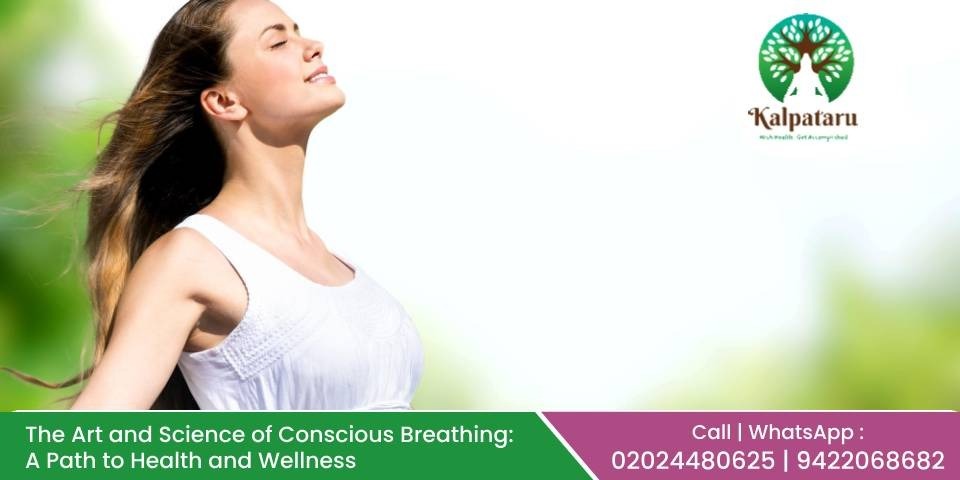
06Feb
The Art and Science of Conscious Breathing: A Path to Health and Wellness
In the hustle and bustle of modern life, where stress and anxiety seem to lurk around every corner, the simple act of breathing often gets overlooked. Yet, if we pause to consider it, breath is the one constant that accompanies us through every moment of our existence. In this blog, we delve into the profound impact of conscious breathing on our physical and mental well-being, drawing insights from ancient wisdom and contemporary research alike. The Natural Breath of Children: Observe a child at rest, and you'll notice something remarkable - their breathing is effortless, natural, and deeply rooted in the present moment. As they inhale, their belly rises, and as they exhale, it gently falls. This innate ability to breathe with ease is something we often lose as we grow older, weighed down by the complexities and stresses of adult life. Yet, it serves as a powerful reminder of the simplicity and effectiveness of conscious breathing. Ancient Wisdom and Modern Science: The significance of breathing has been recognized for millennia, with ancient practices such as yoga and pranayama placing a strong emphasis on breath control for physical and mental well-being. Patanjali, an ancient Indian sage, made significant contributions to understanding the importance of breath regulation, laying the foundation for further exploration into this field.Contemporary research has only served to reinforce what the ancients knew intuitively. Studies have shown that regulating our breath can have profound effects on our nervous system, leading to increased relaxation, improved focus, and enhanced emotional stability. This synergy between ancient wisdom and modern science highlights the timelessness and universality of the principles underlying conscious breathing. Breath as Medicine: Your breath is more than just air moving in and out of your lungs; it is a potent medicine for your body and mind. By consciously regulating our breath, we can tap into its healing potential and unlock a myriad of benefits. From reducing stress and anxiety to improving immune function and promoting overall well-being, the therapeutic effects of conscious breathing are undeniable.Many diseases are prevalent, such as psoriasis, asthma, PCOD, thyroid, cancer, hypertension, hair fall, acidity, or irritable bowel syndrome. Among these diseases, there is a major list in which mental disturbances lead to physical complaints. But in all these complaints, regulating breathing can be beneficial.Today's fast-paced life, many psychosomatic diseases occur because the mind is disturbed, and its effect is seen on the body. When the mind is disturbed, its effect or impression is on the neurons in your brain, and due to this your hormones get disturbed. When hormones get disturbed, your immunity gets affected. So, there's something known as the psycho-neuro-endocrino-immunological axis, which means all these factors are interconnected. Due to this, when the mind is disturbed, all these factors get affected, and various diseases are created on your immunity. Concious breathing calms down your mind. So all the further factors like nerves, hormones and immunity are positively affected by this concious breathing. The Power of Pace: The pace at which we breathe plays a crucial role in determining our quality of life. According to yogic philosophy, the number of breaths we take determines the length of our life. By indulging in shallow, rapid breaths, we inadvertently shorten our lifespan, whereas slower, deeper breaths have the opposite effect, promoting longevity and vitality. For more information and treatment modalities watch our informative video https://www.youtube.com/watch?v=FnwvubPTwMo&t=4shttps://www.youtube.com/watch?v=QrdUIaSwl78&t=6s Understanding Prana: The Life Force Energy Central to Ayurvedic philosophy is the concept of prana, often described as the life force energy that animates all living beings. Prana flows through the body via channels known as nadis, nourishing every cell and organ with vitality and vitality. Proper breathing plays a crucial role in regulating the flow of prana, ensuring its harmonious distribution throughout the body. The Role of Pranayama in Ayurvedic Healing: Pranayama, or yogic breathing exercises, form an integral part of Ayurvedic healing practices. These techniques harness the breath to cleanse, energize, and balance the body-mind complex. Regular practice of pranayama not only enhances physical vitality but also promotes mental clarity, emotional stability, and spiritual growth. Integrating Breath into Daily Life: Incorporating conscious breathing practices into our daily routines doesn't have to be complicated. Simple techniques like deep belly breathing, alternate nostril breathing, and mindful breathing can be seamlessly woven into our day-to-day activities, providing moments of calm and clarity amidst the chaos. Conclusion: In a world filled with constant distractions and pressures, the practice of conscious breathing offers a sanctuary of stillness and serenity. By tapping into the innate wisdom of our breath, we can cultivate a profound sense of well-being that permeates every aspect of our lives. So, take a deep breath, and let the journey to health and wellness begin.Dr. Manoj Deshpande and Dr. Aparna Deshpande at Kalpataru Ayurvediya Chikitsalaya™ Clinic provide the best Ayurvedic Treatment for Psoriasis & various diseases in Pune, Maharashtra. For more information about our comprehensive treatment options, or to request an appointment with the best Ayurvedic Doctor in Pune, call +919422068682 / +919764837167 / 020-24480625 or Click on Book an Appointment.
Read More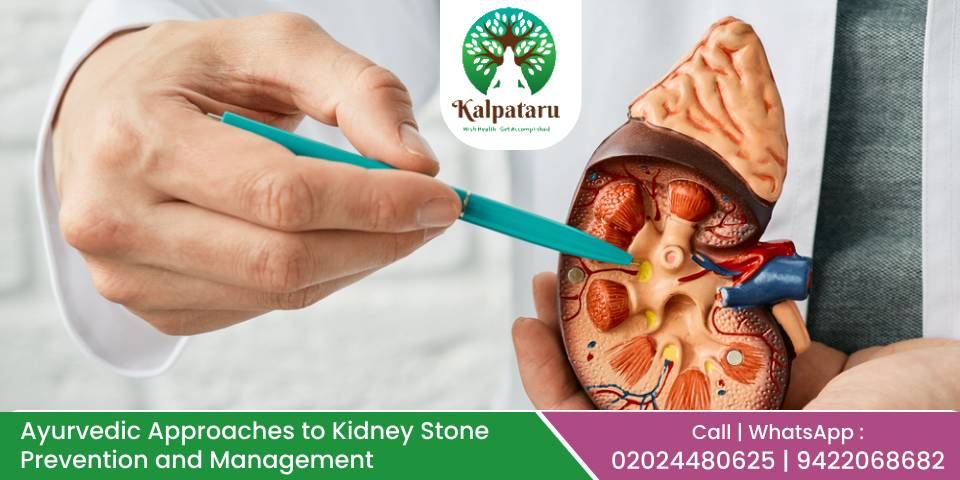
25Jan
Ayurvedic Approaches to Kidney Stone Prevention and Management
Kidney stones can be a painful and debilitating condition caused by the crystallization, concentration, and formation of stones due to excess minerals in the urine. In Ayurveda, the ancient Indian system of medicine, a holistic approach is taken to address this issue, emphasizing dietary modifications, herbal remedies, and lifestyle changes to promote kidney health. This comprehensive blog explores various Ayurvedic recommendations for managing and Kidney Stone Prevention. Promoting Regular Urination: One fundamental aspect of preventing kidney stones is the promotion of regular urination. This helps in avoiding crystallization and concentration of urine, reducing the chances of stone formation. Adequate water intake plays a crucial role in maintaining proper hydration, flushing out toxins, and preventing the build-up of minerals in the kidneys. Dietary Considerations: Certain dietary elements contribute to kidney stone formation, and Ayurveda provides insights into foods that can aid in prevention. Foods rich in citric acid, such as lemons and limes, are known for their ability to dissolve stones and increase urine citrate levels. Additionally, including vegetables like carrots and fruits like apples, grapes, and black currants, which are high in Vitamin A, proves advantageous. Herbs and Spices: Ayurveda recommends incorporating specific herbs and spices into the diet to support kidney health. Coriander, cumin, fenugreek, and mustard are considered beneficial. Additionally, the use of good quality ghee is suggested. These elements aid in digestion, balance the body's pH levels, and promote overall well-being. Ayurvedic Herbs and Treatments: Various herbs play a crucial role in Ayurvedic kidney stone management. Gokshura, Varuna (Crataeva nurvala), Punarnava, and Shilajit are known for their diuretic and stone-dissolving properties. Ayurvedic treatments like Panchakarma, specifically Basti (enema), are suggested for their effectiveness in cleansing and rejuvenating the kidneys. Foods to Avoid: Certain foods can contribute to excess alkalinity, increasing the risk of stone formation. Ayurveda advises avoiding dry fruits, spinach, tomatoes, excessive milk, bakery products, refined flour, and foods with high sugar content. Ayurvedic Remedies: Ayurvedic formulations, including pills, ghee, decoctions, and liquids, are available for kidney stone management. Gokshura, Varuna, Punarnava, and Shilajit are commonly recommended herbs for their diuretic and stone-dissolving properties. Panchakarma Therapies: Panchakarma therapies, especially Basti, are considered effective in Ayurveda for kidney stone management. These therapies help in detoxifying the body, balancing doshas, and promoting overall kidney health. Lifestyle Practices: Maintaining a healthy lifestyle, incorporating regular exercise, and staying adequately hydrated are crucial components of Ayurvedic kidney stone prevention. Balancing digestion and promoting regular urination are emphasized for overall well-being. Types of Kidney Stones: Calcium Oxalate Stones:Composition: These stones are the most common and are primarily made up of calcium oxalate.Causes: High levels of oxalate in the urine, often caused by certain foods, can contribute to the formation of these stones.Calcium Phosphate Stones:Composition: Composed of calcium and phosphate.Causes: Conditions like hyperparathyroidism and renal tubular acidosis can lead to the development of these stones.Uric Acid Stones:Composition: Primarily composed of uric acid.Causes: High levels of uric acid in the urine, often associated with a diet high in purines (found in certain meats and seafood), can lead to the formation of uric acid stones.Struvite Stones:Composition: Consists of magnesium, ammonium, and phosphate.Causes: Often associated with urinary tract infections that result in an alkaline urine environment conducive to struvite stone formation. For more information and treatment modalities watch our informative video https://www.youtube.com/watch?v=HSoEb6EfS-8&t=3shttps://www.youtube.com/watch?v=b2EdypRiwDc&t=1s Consequences of Ignoring Kidney Stones: Ignoring kidney stones can lead to several complications, emphasizing the importance of prompt diagnosis and treatment. Potential consequences include:Increased Pain and Discomfort: Kidney stones can cause intense pain as they move through the urinary tract. Ignoring symptoms may prolong this pain and discomfort.Obstruction of Urinary Tract: Larger stones may obstruct the urinary tract, leading to complications such as hydronephrosis (swelling of the kidney) and potential kidney damage.Risk of Infections: Blocked urine flow can create an environment conducive to bacterial growth, increasing the risk of urinary tract infections.Impaired Kidney Function: Chronic kidney stone formation and obstruction can contribute to impaired kidney function, potentially leading to kidney damage or failure over time.Recurrent Stones: Ignoring the underlying causes of kidney stones may result in recurrent stone formation, necessitating ongoing treatment.Complications during Pregnancy: Pregnant women with kidney stones may face an increased risk of complications, including preterm labor. Conclusion: Ayurveda provides a comprehensive and holistic approach to prevent and manage kidney stones. By adopting dietary modifications, incorporating specific herbs and spices, and considering lifestyle changes, individuals can promote kidney health and reduce the risk of stone formation. Consulting with an Ayurvedic practitioner for personalized guidance can further enhance the effectiveness of these approaches in maintaining optimal kidney function.Dr. Manoj Deshpande and Dr. Aparna Deshpande at Kalpataru Ayurvediya Chikitsalaya™ Clinic provide the best Ayurvedic Treatment for Psoriasis & various diseases in Pune, Maharashtra. For more information about our comprehensive treatment options, or to request an appointment with the best Ayurvedic Doctor in Pune, call +919422068682 / +919764837167 / 020-24480625 or Click on Book an Appointment.
Read More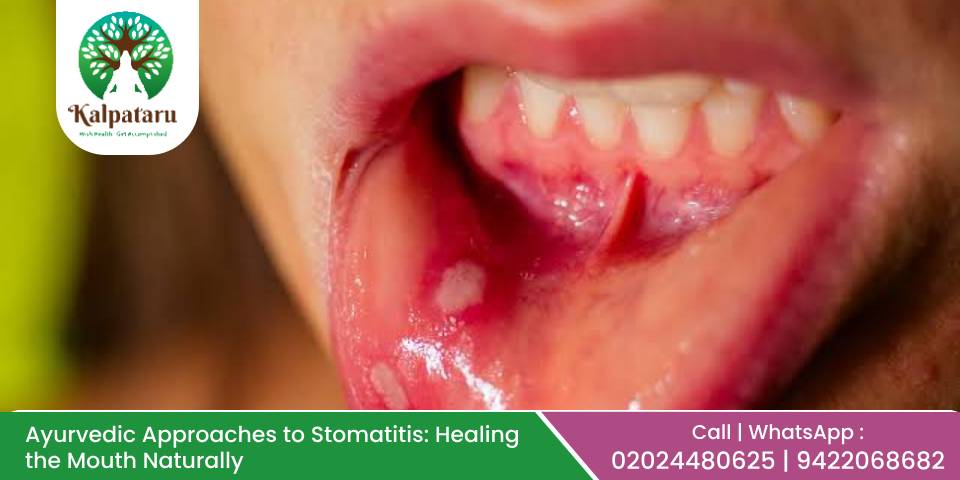
20Jan
Ayurvedic Approaches to Stomatitis: Healing the Mouth Naturally
Stomatitis, a condition characterized by inflammation and sores in the mouth, can significantly impact an individual's quality of life. In the realm of Ayurveda, the ancient Indian system of medicine, there are diverse and holistic approaches to treating Stomatitis, ranging from herbal pastes to Panchakarma and stress management. This blog explores these Ayurvedic methods and their potential benefits for individuals suffering from Stomatitis. Ayurvedic Medicinal Pastes (Lepa): Ayurveda places great emphasis on the healing properties of herbs. Medicinal pastes, or lepa, are crafted from herbs like Triphala, Jeshthamadh, Suwarn gairik and Daruharidra. These pastes can be topically applied to the affected areas in the mouth along with ghee or honey, promoting the healing of wounds and ulcers caused by Stomatitis. Gandoosha Treatment: Gandoosha is an Ayurvedic treatment that involves mouth rinsing with herbal extracts. This method aids in maintaining oral hygiene and promoting ulcer healing. One specific remedy involves preparing a decoction from various plants and applying it to the affected areas in the mouth, harnessing its wound-healing properties. Panchakarma for Chronic Stomatitis: Individuals grappling with severe or chronic Stomatitis, especially those with a Pitta constitution or warm nature, can benefit from Panchakarma named Virechan and Raktmokshan. This Ayurvedic detoxification procedure is tailored to the individual's needs, helping to eliminate toxins and restore balance to the body. Stress Management: Stress is identified as a significant factor in Stomatitis, and Ayurveda recognizes its impact on overall health. Counseling, maintaining a regular sleep schedule, and reducing stress through medications are crucial components of Ayurvedic treatment, especially for chronic cases. Dental Interventions: Dental issues, such as sharp teeth, can contribute to Stomatitis by causing injuries to the tongue or inner cheeks. Seeking dental advice for proper treatment is imperative in such cases to address the root cause of the problem. Digestive Health: Chronic colitis or infections in the digestive system can also contribute to Stomatitis. Ayurveda emphasizes maintaining proper digestion, reducing infections, and ensuring adequate nutrient intake for overall oral health. Nutritional Considerations: Deficiencies in essential nutrients like B-complex vitamins and iron can also contribute to Stomatitis. Addressing these deficiencies is essential to promote overall health and prevent oral issues. For more information and treatment modalities watch our informative video https://www.youtube.com/watch?v=q318SMZbhPU&t=4shttps://www.youtube.com/watch?v=yRa-HUTUPF4&t=2s Conclusion: Ayurveda offers a comprehensive and holistic approach to treating Stomatitis, encompassing herbal applications, Panchakarma, stress management, dental interventions, and digestive health. By embracing these natural and time-tested methods, individuals can not only find relief from Stomatitis but also enhance their overall oral well-being. Always consult with qualified Ayurvedic practitioners for personalized guidance and treatment plans. Up till now hundreds of patients of severe and chronic stamatitis are cured at Kalpataru Ayurvediya Chikitsalaya™ who were otherwise fighting to get it settled by adopting so many treatment modalities.Dr. Manoj Deshpande and Dr. Aparna Deshpande at Kalpataru Ayurvediya Chikitsalaya™ Clinic provide the best Ayurvedic Treatment for Psoriasis & various diseases in Pune, Maharashtra. For more information about our comprehensive treatment options, or to request an appointment with the best Ayurvedic Doctor in Pune, call +919422068682 / +919764837167/ 020-24480625 or Click on Book an Appointment.
Read More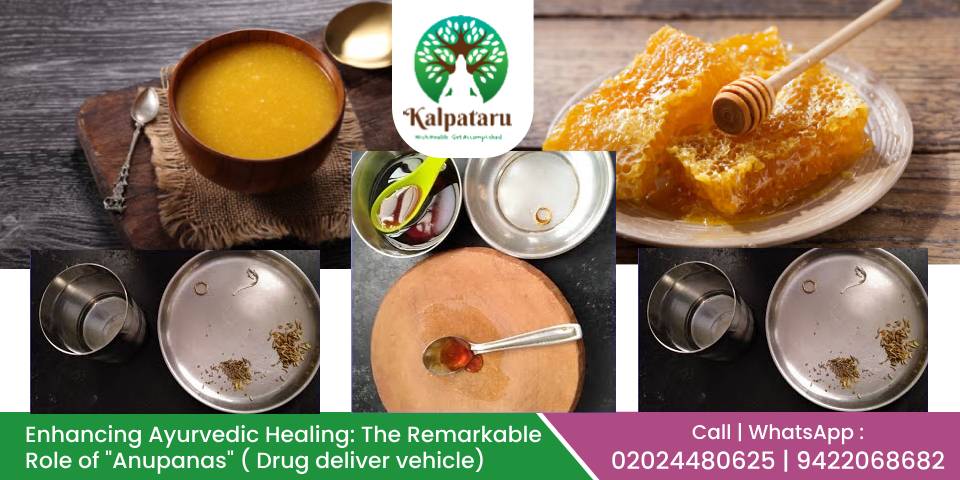
15Jan
Enhancing Ayurvedic Healing: The Remarkable Role of “Anupanas” (Drug Deliver Vehicle)
In the realm of Ayurveda, the ancient science of life and wellness, the concept of 'Anupana' plays a crucial role. Anupanas are specific carriers or vehicles that are used alongside medicines to maximize their effectiveness and cater to individual health conditions. In this blog, we will delve into the fascinating world of Anupanas and uncover how they enhance the potency and precision of Ayurvedic treatments. Understanding Anupanas: The Ayurvedic Art of Precision At its core, an Anupana is not just a medium to ingest medicine; it is a thoughtfully chosen substance that complements the medicine's properties. This synergistic combination ensures that the medicine is more effectively absorbed, directed to the appropriate bodily tissues, and balanced to prevent any adverse effects. Warm Water: The Catalyst for Digestive Harmony Many Ayurvedic medicines, especially those containing digestive stimulants like ginger, black pepper, and long pepper, are recommended to be taken with warm water. Warm water serves as an ideal Anupana for these ingredients as it enhances their digestion-boosting properties. The warmth aids in kindling the digestive fire ('Agni'), promoting efficient metabolism, and aiding in the detoxification process. Soothing Pitta with Dink(edible gum) When addressing conditions related to an aggravated Pitta dosha, such as acidity or stomach ulcers, a combination of dink (edible gum) with granulated sugar (khadi shakkar) is often prescribed. This blend not only cools and soothes the inflamed areas but also promotes healing. Honey: The Key to Cough Relief For respiratory ailments, particularly coughs, Ayurvedic medicines like Jeshthamadh (licorice), Talisadi Churna, Sitopaladi Churna, etc. are more effective when taken with honey.Honey acts as a natural soothing agent and expectorant, enhancing the medicine's ability to alleviate cough and clear the respiratory passages. Jaggery: A Sweet Trap for Parasites In the treatment of worms or parasites, the sweetness of jaggery (gud) is employed. The sweetness attracts the worms, making the medicine more palatable to them, thus ensuring a quicker and more effective treatment. Combating Side Effects of Long-term Medication: Long-term use of painkillers, steroids, or antibiotics can lead to heat or acidity accumulation in the body. In such cases, Ayurvedic practitioners often recommend Anupanas like decoctions of Coriander seeds to balance this excess heat and protect the body's internal environment. Radish Juice for Liver Ailments: In liver-related conditions, such as jaundice or liver inflammation, Anupanas like radish juice are used alongside medicines like Arogyavardhini Vati or Tamra Bhasma. This combination is specifically geared towards reducing inflammation and aiding the liver's functionality. Radish juice, with its detoxifying properties, works in harmony with the medicines to support liver health and aid in recovery. Swarna Jal for Cognitive Enhancement: In cases involving brain health, especially in children with conditions like mental retardation or cerebral palsy, autism Ayurvedic treatment often includes Anupanas like Swarna Jal or Swarna Siddha Jal (gold-infused water). Gold has been revered in Ayurveda for its properties that enhance cognitive functions and overall brain health, making it a valuable component in these treatments. Managing Menstrual Health: For women experiencing heavy menstrual bleeding, specific Ayurvedic formulations like Chandraprabha, Pushyanug Churna with Anupana of Jamun stem bark decoction are more effective than taking alone. This combination not only helps in reducing excessive bleeding but also in regulating menstrual flow, showcasing the importance of targeted Anupana selection in treating women's health issues. With these Anupana usage in our clinic we have been successful to avoid several Hysterectomy surgeries. For more information and treatment modalities watch our informative video https://www.youtube.com/watch?v=-9ZfeKjMzUE&t=7s Conclusion: The concept of Anupanas in Ayurveda is a testament to the precision and depth of this ancient medical system. By understanding and utilizing the right carriers or vehicles alongside medicinal substances, Ayurvedic practitioners can significantly enhance the effectiveness of treatments. This approach ensures that medicines are not only more efficient in their action but also balanced in their effects, providing a holistic solution to various health ailments. As we continue to explore and embrace the wisdom of Ayurveda, the role of Anupanas stands out as a crucial aspect of personalized and effective healthcare.Incorporating these principles into modern therapeutic practices could open new avenues for enhancing patient care and treatment outcomes, truly embodying the essence of holistic healing. In the realm of Ayurveda, the ancient science of life and wellness, the concept of 'Anupana' plays a crucial role. Anupanas are specific carriers or vehicles that are used alongside medicines to maximize their effectiveness and cater to individual health conditions. In this blog, we will delve into the fascinating world of Anupanas and uncover how they enhance the potency and precision of Ayurvedic treatments.Dr. Manoj Deshpande and Dr. Aparna Deshpande at Kalpataru Ayurvediya Chikitsalaya™ Clinic provide the best Ayurvedic Treatment for Psoriasis & various diseases in Pune, Maharashtra. For more information about our comprehensive treatment options, or to request an appointment with the best Ayurvedic Doctor in Pune, call +919422068682 / +919764837167 / 020-24480625 or Click on Book an Appointment.
Read More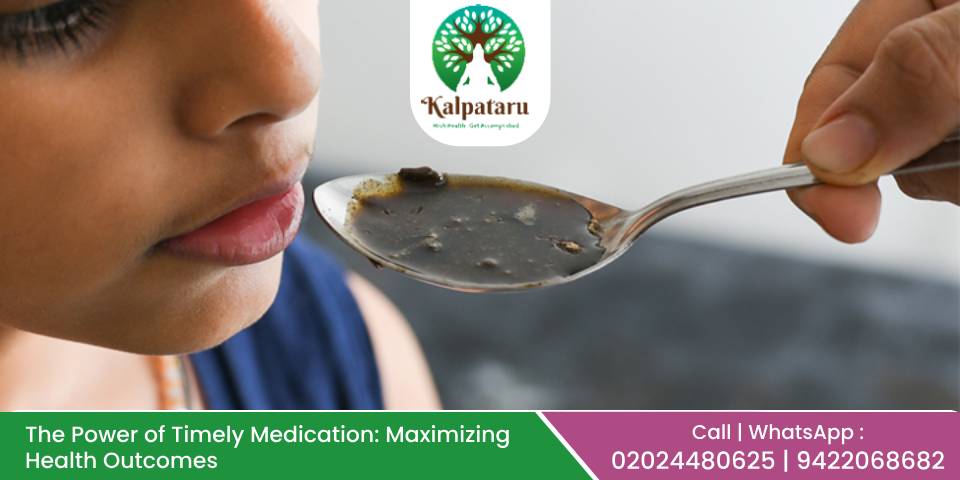
09Jan
The Power of Timely Medication: Maximizing Health Outcomes
In the realm of healthcare, adherence to medication schedules stands as a critical component in achieving optimal health outcomes. The simple act of taking prescribed medications on time can significantly impact an individual's well-being and pave the way for a healthier, more fulfilling life. In this blog, we delve into the importance of timely medication and how it plays a pivotal role in maximizing health outcomes. Understanding Timely Medication: When a healthcare professional prescribes medication, it is often accompanied by specific instructions regarding dosage and timing. Timely medication refers to the conscientious adherence to these instructions, ensuring that doses are taken at the prescribed times and intervals. Why Timely Medication Matters? Efficacy of Treatment: Adhering to prescribed medication schedules ensures that the therapeutic levels of the drug remain consistent in the body. This consistency is crucial for the medication to perform optimally and produce the intended therapeutic effects. Irregular intake or missed doses can hinder the treatment's efficacy, potentially reducing its effectiveness in managing a condition or illness.Disease Management: For chronic conditions such as diabetes, hypertension, or autoimmune disorders, strict adherence to medication schedules is paramount. Consistent medication intake can help control symptoms, prevent disease progression, and minimize complications, thereby enhancing the overall quality of life.Avoiding Complications: Missing doses or irregular medication schedules can lead to complications. For instance, in antibiotic treatments, inconsistent intake can contribute to antibiotic resistance, rendering the medication less effective in combating infections. Similarly, in conditions like epilepsy, irregular medication adherence can trigger seizures.Long-Term Health Benefits: Consistently following prescribed medication schedules not only addresses immediate health concerns but also contributes to long-term health benefits. It can reduce the risk of disease exacerbation, hospitalizations, and the need for more aggressive treatments, ultimately saving both time and resources. Overcoming Challenges in Adherence: While understanding the significance of timely medication is crucial, adhering to schedules can pose challenges for many individuals. Factors such as forgetfulness, complex dosing regimens, financial constraints, or side effects may hinder adherence. However, several strategies can help overcome these challenges:Set Reminders: Utilize alarm clocks, smartphone apps, or pill organizers to prompt medication intake.Simplify Regimens: Discuss simpler dosing schedules or alternative medications with your healthcare provider.Financial Assistance: Seek assistance programs or generics to alleviate financial burdens associated with medications.Open Communication: Discuss any concerns or side effects with your healthcare provider rather than discontinuing medication. For more information and treatment modalities watch our informative video https://www.youtube.com/watch?v=CobE8ntO2Zchttps://www.youtube.com/watch?v=OjOsnGVU3AY&t=1s Ayurvedic Principles and Medication Timing: Body Functions and Doshas: The body operates based on solar energy and is affected by three doshas: Vata (air), Pitta (fire), and Kapha (earth and water). Timing-wise, Kapha dosha prevails from 6 am to 10 am, Pitta dosha from 10 am to 2 pm, and Vata dosha from 2 pm to 6 pm. Evening also observes Kapha dominance from 6 pm to 10 pm.Medication and Dosha Influence: Medications taken during specific dosha periods work more effectively on the respective dosha imbalances. For example, treating Kapha imbalances should consider administering around 6 am or 10 pm when Kapha dosha is dominant. Likewise in pitta and Vat doshas Medication and Digestive Phases: Pre-meal medications predominantly work on Apana Vayu, affecting areas such as the uterus, colon, large intestine, urinary bladder, or the process of excretion.Medication and Nighttime: Medicines taken before sleep, known as swapn kal medications, work on aspects related to the brain, intelligence, or sleep.Medication Timing: Specific medicines are given intermittently or in acute conditions as needed. Medicines during meals are helpful for digestive issues like chronic diarrhea, irritable bowel syndrome, or ulcerative colitis, improving digestive power. Some medicines are best taken in the morning on an empty stomach, allowing quick absorption and producing favorable results without directly interacting with food.Tonics and Strengthening Medicines: Tonics or strengthening medicines work on an empty stomach to enhance the body's strength, immunity, and disease resistance.Gastric Medications: Given between meals, aid in conditions related to gastric discomfort, improving digestion and alleviating gas or stomach disturbances. Conclusion: Timely medication intake is a cornerstone of successful treatment plans and plays an integral role in optimizing health outcomes. By recognizing the importance of adhering to prescribed schedules and overcoming challenges in adherence, individuals can take charge of their health and work towards achieving better overall well-being.This organized version provides a clear breakdown of Ayurvedic principles related to doshas, medication timing, and the influence of medicines on different bodily functions and phases.Remember, the decision to adhere to medication schedules isn't just about following instructions; it's about taking proactive steps towards a healthier and more fulfilling life. Always consult with Ayurveda Specialist in Pune to create a personalized plan that suits your needs and ensures the best possible health outcomes.Dr. Manoj Deshpande and Dr. Aparna Deshpande at Kalpataru Ayurvediya Chikitsalaya™ Clinic provide the best Ayurvedic Treatment for Psoriasis & various diseases in Pune, Maharashtra. For more information about our comprehensive treatment options, or to request an appointment with the best Ayurvedic Doctor in Pune, call +919422068682 / +919764837167 / 020-24480625 or Click on Book an Appointment.
Read More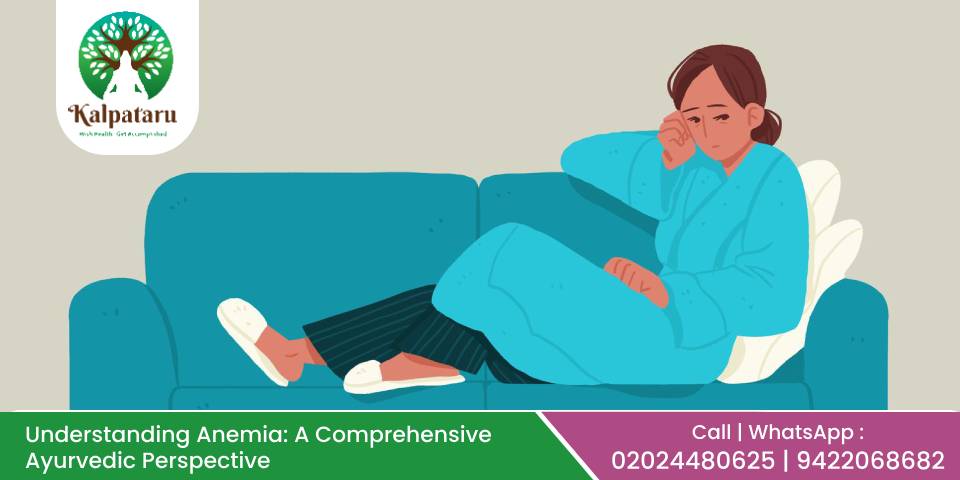
02Jan
Understanding Anemia: A Comprehensive Ayurvedic Perspective
Anemia, a condition characterized by a deficiency in red blood cells or hemoglobin in the blood, often leads to fatigue, weakness, and a decreased ability to carry oxygen to the body's tissues. While modern medicine provides various treatments, Ayurveda, the ancient Indian system of holistic healing, offers insightful perspectives and natural remedies to address anemia. Understanding Anemia in Ayurveda: Ayurveda views anemia as a result of imbalances in the body's three vital energies or doshas: Vata, Pitta, and Kapha. According to this ancient science, anemia primarily stems from imbalances in Pitta and can be influenced by poor digestion, weak agni (digestive fire), and improper diet. Causes according to Ayurveda: Agnimandhya (Weak Digestion): Poor digestion leads to inadequate absorption and assimilation of nutrients, including iron, causing anemia. Vitiation of Pitta Dosha: Pitta imbalance can cause an excessive heat that affects blood quality, leading to reduced hemoglobin levels. Dietary Factors: Inadequate intake of iron-rich foods, improper food combinations, and consumption of foods that aggravate Pitta can contribute to anemia. B12 in Diet: Vitamin B12 plays a crucial role in red blood cell production. Its deficiency can contribute to anemia as it is essential for the synthesis of hemoglobin. Worms in Children: Additional cause of anemia, especially in children, can be attributed to intestinal parasites or worms. These parasites can disrupt nutrient absorption, leading to deficiencies, including iron, contributing to anemia. Common symptoms of anemia include: Fatigue and Weakness: Persistent tiredness and a lack of energy are common signs of anemia due to decreased oxygen-carrying capacity in the blood.Hair Fall: Anemia can lead to hair loss or thinning as the body prioritizes vital functions over non-essential ones like hair growth due to inadequate oxygen supply.Pale or Yellowish Skin: Reduced hemoglobin levels can result in paleness or a yellowish hue to the skin due to diminished oxygenation.Shortness of Breath: Insufficient oxygen reaching body tissues may cause difficulty in breathing or shortness of breath, especially during physical exertion.Dizziness or Lightheadedness: Anemic individuals may experience dizziness or lightheadedness, often due to decreased oxygen supply to the brain.Irregular Heartbeat: Anemia can lead to irregularities in heart rate or rhythm as the heart works harder to compensate for reduced oxygen levels in the blood.Headaches: Inadequate oxygen supply to the brain may cause headaches, which can range from mild to severe in intensity.Loss of Appetite: Anemia can cause a decrease in appetite due to overall weakness and reduced energy levels. For more information and treatment modalities watch our informative video https://www.youtube.com/watch?v=acAJF5nsjOc&t=2shttps://www.youtube.com/watch?v=P6F8lruun5Q&t=123s Ayurvedic Approaches to Manage Anemia: Diet and Lifestyle Modifications: Balanced Diet: Emphasize foods rich in iron and nutrients, including leafy greens, beets, dates, figs, and soaked raisins. B12-Rich Foods: Include meat, fish, dairy, and fortified cereals for sufficient vitamin B12 intake. Pitta-Pacifying Diet: Consume Black resins, kharjur, clarified butter, figs, ragi to balance Pitta. Herbal Support: Incorporate herbs like Punarnava, Amalaki, and Guduchi known for their rejuvenating and blood-building properties. Proper Food Combining: Follow Ayurvedic principles of food combining to enhance digestion and nutrient absorption. Regular Exercise: Engage in moderate exercises like yoga, walking, or swimming to improve circulation and vitality. Ayurvedic Therapies and Remedies: Panchakarma: Detoxification therapies like Panchakarma can help balance doshas and improve overall health.Ayurvedic Formulations: Use herbal formulations like Navayasa Lauha, Lohasava, tapyadi loh, mandur to boost hemoglobin levels.Rasayana Therapy: Adopt rejuvenating therapies to enhance overall strength and immunity. Importance of Liver Treatment in Anemia: The liver plays a significant role in blood production and overall health. Ayurvedic treatments focusing on liver health can enhance hemoglobin levels. Herbs like Kutki and Bhringraj support liver function, aiding in the synthesis of blood components and ultimately increasing hemoglobin levels. Maintaining Hemoglobin Levels: For sustaining hemoglobin levels, consistent treatment and lifestyle modifications are essential. Ayurvedic practitioners often recommend a 3-6 month medication regimen, along with dietary and lifestyle changes, to ensure a gradual and sustainable improvement in hemoglobin levels. Conclusion: Anemia, as viewed through the lens of Ayurveda, is a condition rooted in imbalances within the body. By addressing digestive health, balancing Pitta dosha, and incorporating specific dietary habits, herbal remedies, and lifestyle changes, Ayurveda provides holistic methods to manage anemia naturally.It's crucial to consult an experienced Ayurvedic practitioner for personalized guidance and to determine the most suitable approach based on an individual's constitution and specific imbalances.By embracing Ayurvedic principles and practices, individuals experiencing anemia can foster balance within their bodies, supporting overall health and well-being.Dr. Manoj Deshpande and Dr. Aparna Deshpande at Kalpataru Ayurvediya Chikitsalaya™ Clinic provide the best Ayurvedic Treatment for Psoriasis & various diseases in Pune, Maharashtra. For more information about our comprehensive treatment options, or to request an appointment with the best Ayurvedic Doctor in Pune, call +919422068682 / +919764837167 / 020-24480625 or Click on Book an Appointment.
Read More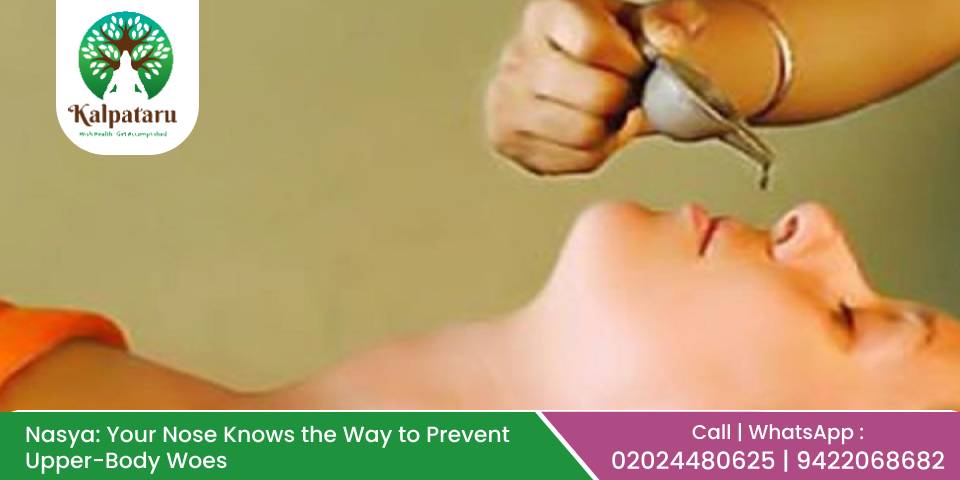
22Dec
Nasya: Your Nose Knows the Way to Prevent Upper-Body Woes
In the ancient wisdom of Ayurveda, the nose isn't just for sniffing. It's a gateway to health, particularly for the region above the shoulders – your head, neck, and everything in between. Enter Nasya, a therapeutic practice involving the administration of medicated oils, powders, or herbal juices through the nasal passage. It's more than just a nasal drip; it's a powerful preventive tool against a surprising range of ailments plaguing your upper body. Why the Nose? Ayurveda views the nose as a direct channel to the head, bypassing the digestive system and acting as a delivery express for potent medicines. These medicines directly interact with the delicate membranes lining the nasal passages, stimulating nerve endings and influencing the functioning of vital organs like the brain, eyes, ears, and sinuses. Preventing a Spectrum of Upper-Body Woes: Here's how Nasya can shield you from various upper-body concerns:Respiratory woes: Say goodbye to sniffles, sneezes, and coughs! Nasya helps clear congestion, strengthen the respiratory system, and boost immunity, making you less susceptible to colds, flu, and allergies.Headaches and Migraines: The targeted action of Nasya on the nervous system can ease tension headaches and even alleviate the excruciating grip of migraines.Sinus issues: Struggling with sinusitis? Nasya works wonders to drain congested sinuses, reduce inflammation, and prevent future flare-ups.Eye and ear troubles: Blurred vision, ringing in the ears, and other sensory issues can find relief through Nasya, thanks to its ability to improve circulation and soothe irritated tissues.Brainpower boost: Beyond physical benefits, Nasya is said to enhance cognitive function by improving memory, focus, and clarity of thought. For more information and treatment modalities watch our informative video https://www.youtube.com/watch?v=9Fl_lvE9NEwhttps://www.youtube.com/watch?v=gXkxIXfYK3g&t=3s A Tailored Approach: Remember, one size doesn't fit all when it comes to Nasya. Different formulations are prescribed based on your individual needs and constitution. For instance, someone with a "Kapha" dominant prakriti (body type) might receive hot potency herbs to balance their heavier tendencies, while a "Pitta" dominant individual might receive soothing ghee to calm their fiery nature. Finding Your Nasya Guru: While some may be tempted to DIY this ancient practice, it's crucial to seek guidance from a qualified Ayurvedic practitioner like Dr. Manoj Deshpande. They will assess your needs, recommend the appropriate formulations, and administer the Nasya safely and effectively. Embrace the Wellness Path: Nasya is more than just a drop in the nose; it's a step towards holistic wellness. By incorporating this preventive approach into your life, you could be strengthening your upper body's defenses, alleviating existing issues, and even enhancing your mental clarity. Remember, listening to your nose could be the key to unlocking a healthier, happier you!Ready to explore the magic of Nasya? Connect with Kalpataru Ayurvediya Chikitsalaya today and embark on a journey of nasal wellness!
Read More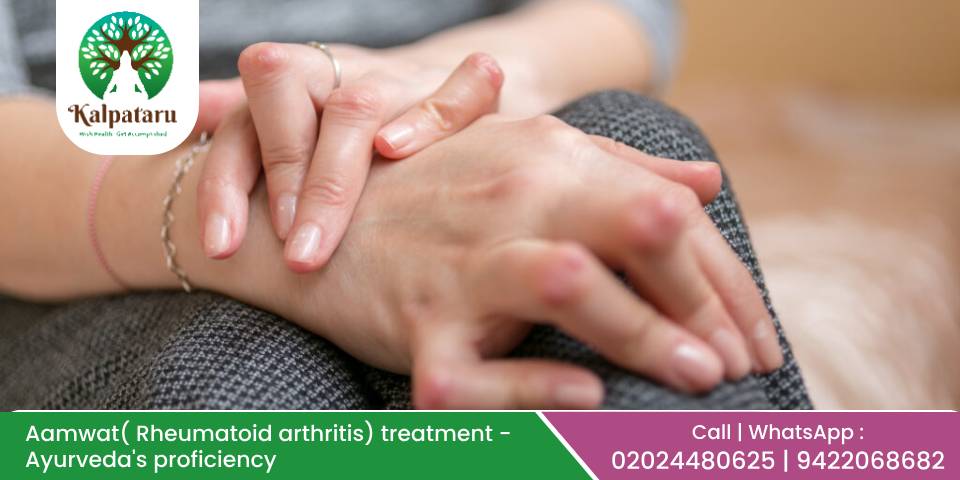
15Dec
Aamwat( Rheumatoid arthritis) treatment – Ayurveda’s proficiency
Rheumatoid Arthritis, known as "Aamvata" in Ayurveda, presents a unique perspective on this prevalent joint ailment. Ayurveda, an ancient Indian holistic healing system, views Aamvata as an imbalance stemming from weakened digestive fire( Agnimandya as it's terminology in ayurved), leading to joint inflammation and discomfort. Let's delve deeper into this age-old wisdom to understand its causes, treatments, and preventive measures. Understanding Aamvata: In Ayurveda, 'Aam' arises from impaired digestion, forming a sticky toxin that triggers joint inflammation, swelling, pain, and stiffness. This condition doesn't discriminate by age, impacting people across generations. The process of correcting this imbalance starts with improving digestive fire( Agni) to reduce the production of 'Aam.' Ayurvedic Treatments: Ayurvedic remedies focus on enhancing digestive fire, using medications like Gokshuradi Guggulu, Guduchi, Rasna, and Apamarg and so many more according to the condition, status, severity of the disease. Among these, garlic stands out for its remarkable properties in managing Aamvata effectively. Additionally, fasting during the initial stages and consuming specific herbal formulations aid in alleviating symptoms. Therapies for Relief: Ayurvedic therapies like Swedana (sweating therapy) play pivotal roles. Swedan with hot sand poultice gives instant pain relief. Leech application helps reduce inflammation and pain. Furthermore, herbal pastes offer relief by targeting swelling and discomfort in affected joints. Ayurveda vs. Modern Medications: While modern medications ( Pain killers sulfasalazines, methotrexate, biologicals) provide relief, they may have adverse effects on vital organs like kidneys and the liver. In contrast, Ayurvedic treatments aim to restore internal balance, correct misguided immunity, and reduce reliance on painkillers through therapies like Basti (enema-based treatment). Dietary Recommendations: Ayurveda emphasizes dietary modifications to prevent exacerbating Aamvata. Avoiding cold water, winds, excessively dry or cold foods, and specific items like sour fruits and fried foods, cereals producing gases such as Rajma, chhola etc can significantly aid in managing the condition. For more information and treatment modalities watch our informative video https://www.youtube.com/watch?v=HIoVd8JVf7A&t=1shttps://www.youtube.com/watch?v=nfEyLBj9rOM&t=21s Conclusion: Exploring Ayurvedic principles in managing Rheumatoid Arthritis offers a holistic perspective, focusing on restoring balance within the body, reducing symptoms, and enhancing overall well-being. Embracing these ancient insights into daily life can effectively alleviate the impact of Rheumatoid Arthritis and improve one's quality of life. Understanding Aamvata through the lens of Ayurveda provides valuable insights into comprehensive approaches to managing and preventing this debilitating condition. Integrating these holistic practices into our routines can lead to relief and better management of Rheumatoid Arthritis.Dr. Manoj Deshpande and Dr. Aparna Deshpande at Kalpataru Ayurvediya Chikitsalaya™ Clinic provide the best Ayurvedic Treatment for Psoriasis & various diseases in Pune, Maharashtra. For more information about our comprehensive treatment options, or to request an appointment with the best Ayurvedic Doctor in Pune, call +919422068682 / +919764837167/ 020-24480625 or Click on Book an Appointment.
Read More
07Dec
The Ayurvedic Perspective: Unveiling the Health Hazards of Fast Eating
In the hustle and bustle of modern life, the vision of fast everything has permeated every aspect, including our eating habits. Dr. Manoj Deshpande, a renowned Ayurvedic Doctor in Pune, Maharashtra, sheds light on the health risks associated with fast eating . In a world where time is of the essence, understanding the effect of our eating habits on our health becomes important. Let's delve into the wisdom of Ayurveda and explore the intricate connection between fast eating and its possible health hazards. The Ayurvedic Approach to Health: Ayurveda, an ancient system of medicine rooted in Indian tradition, views health as a pleasant balance between the body, mind, and spirit. According to Ayurveda, each person has a unique constitution, or dosha, comprising Vata, Pitta, and Kapha. Dr. Manoj Deshpande emphasizes the importance of aligning our lifestyle, including our eating habits, with our individual dosha to sustain optimal health. The Significance of Mindful Eating: In Ayurveda, eating is not just a physical act but a holistic experience that involves the mind and spirit. Dr. Deshpande advocates for mindful eating, emphasizing the significance of savoring each bite, being present during meals, and appreciating the nourishment our food provides. Fast eating disrupts this mindful approach, leading to a cascade of health problems such as bloating, gas, indigestion, constipation, diarrhea, irreversible bowel syndrome (IBS), obesity, and diabetes. Digestive Fire and Agni: According to Ayurveda, the digestive fire or Agni plays a key role in breaking down food, extracting nutrients, and eliminating waste. Dr. Deshpande explains how fast eating hinders the proper functioning of Agni. When we consume food rapidly, the digestive system works to keep up, resulting in incomplete digestion, malabsorption of nutrients, and the assemblage of toxins in the body. Impact on Dosha Balance: Each dosha has its own unique qualities, and fast eating can upset the delicate balance between Vata, Pitta, and Kapha. Dr. Manoj Deshpande points out that people with a dominant Vata dosha may experience increased anxiety and restlessness, while those with a predominant Pitta dosha might suffer from digestive diseases and acidity. Kapha people may witness weight gain and sluggishness due to improper digestion. Weight Management and Fast Eating: In the era of instant gratification, fast eating has become synonymous with comfort. However, Dr. Deshpande highlights the paradox that exists in this approach, especially concerning weight management. Contrary to popular belief, fast eating may contribute to weight gain as the body fails to signal fullness promptly. Over time, this can lead to overeating and the accumulation of excess weight. Gut Health and Fast Eating: The gut, often referred to as the "second brain" in Ayurveda, is deeply connected to our overall well-being. Dr. Manoj Deshpande explains how hurried consumption of food negatively impacts gut health. The gut microbiota, responsible for maintaining a healthy digestive system, can be disrupted by fast eating, potentially leading to conditions such as irritable bowel syndrome (IBS), constipation, or diarrhea. Fast eating habit can lead to obesity, overeating, hypertension , indigestion, hyperacidity also Mind-Body Connection: Ayurveda emphasizes the intricate connection between the mind and body. Dr. Deshpande explains that fast eating not only affects physical health but also affects mental well-being. The hurried pace at which we consume meals can contribute to stress, anxiety, and an overall sense of disconnection from the present moment. This, in turn, can impact our mental clarity and emotional balance. For more information and treatment modalities watch our informative video https://www.youtube.com/watch?v=pXmw_Hl34KI&t=1shttps://www.youtube.com/watch?v=Ltye_7D4zPo&t=1s Ayurvedic Tips for Mindful Eating: To counter the detrimental effects of fast eating, our Ayurveda specialist, Dr. Manoj Deshpande offers practical Ayurvedic tips for cultivating mindful eating habits. These include:Eat in a Calm Environment: Create a peaceful and calm environment for meals. Avoid distractions such as TV or electronic devices and focus on the act of eating.Chew Thoroughly: Ayurveda emphasizes the significance of chewing food thoroughly to support digestive function. Chewing activates enzymes in saliva, initiating the breakdown of food before it reaches the stomach.Follow a Routine: Establish a regular eating routine to sync with the body's natural rhythms. Ayurveda suggests that eating at consistent times each day supports digestion and overall well-being.Be Mindful of Portion Sizes: Pay attention to portion sizes and listen to your body's hunger and fullness cues. Avoid overeating by giving your body the time it requires to register satiety.Choose Nutrient-Dense Foods: Opt for whole, nutrient-dense foods that are smoothly digestible. Ayurveda promotes a balanced diet that aligns with individual constitutions and seasonal variations.Choose fresh, whole foods: Prioritize fresh, whole foods over processed and packaged options. Whole foods provide crucial nutrients and fiber, supporting overall health.Cook with love: Save time cooking meals at home. Cooking with love and intention improves the prana (life force) in the food, making it more nutritious and satisfying.Listen to Your Body: Tune into your body's signals of hunger and satiety. Eating in response to genuine hunger and stopping when you feel satisfied is a fundamental principle in Ayurveda.Dr. Manoj Deshpande, a renowned Ayurvedic doctor, recommends the following Ayurvedic practices to help prevent the health risks of eating fast:Abhyanga: This is a self-massage using warm oil. It allows for improved circulation, reduces stress, and promotes relaxation.Nasya: This is the approach of administering oil or herbal decoctions to the nostrils. It helps to clear congestion, improve sinus health, and enhance mental clarity.Pranayama: This is a breathing technique that helps to calm the mind and body. Conclusion: At Kalpataru Ayurvediya Chikitsalaya™, the best ayurvedic clinic in Pune, specialist Dr. Manoj Deshpande's Ayurvedic insights into the health risks of consuming fast food provide a compelling perspective on the deep connection between diet and well-being. By aligning our eating habits with the principles of Ayurveda, we can not only improve our physical well-being but also foster a harmonious balance between the mind, body, and spirit in the fast-paced world we inhabit.
Read More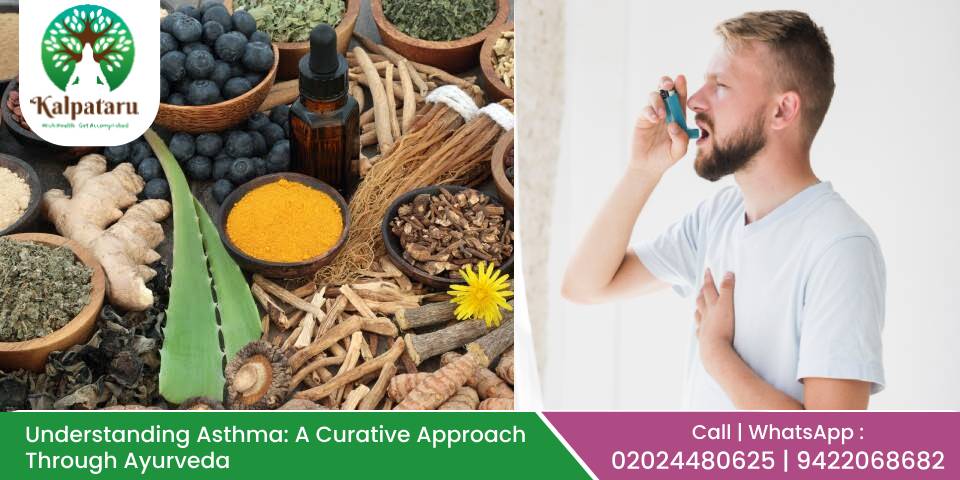
04Dec
Understanding Asthma: A Curative Approach Through Ayurveda
As the seasons change, school-going children often return home on cold, rainy days with symptoms like cold, cough, and low fever. For some, these symptoms persist, leading to exacerbated asthma—a condition marked by inflamed airways, tightened muscles, and stubborn mucus production, causing breathlessness and discomfort. Modern Insights into Asthma: Conventional medicine uses tests like lung function tests, X-rays, and allergy assessments for asthma diagnosis. Treatments include antiallergic medications, antibiotics, steroids, and bronchodilators aimed at alleviating symptoms and preventing asthma attacks. Ayurvedic Perspective on Asthma: Ayurveda attributes asthma to imbalances in Vata and Kapha doshas, emphasizing the role of digestion and Agni in triggering this condition. Dietary adjustments, such as avoiding excess dairy and seafood, and having lighter dinners before sunset, are recommended. Lifestyle Factors and Allergies: Ayurveda highlights lifestyle factors impacting asthma, including poor bathroom habits and allergies to certain foods, preservatives, dust, smoke, and strong odors, contributing significantly to asthma attacks. For more information and treatment modalities watch our informative video https://www.youtube.com/watch?v=ybpa5cn5K8Yhttps://www.youtube.com/watch?v=UOWDqTjHvho Ayurvedic Management of Asthma: Ayurvedic approaches involve widening airways through massages using sesame oil and rock salt, specific herbal medicines during attacks, and Basti treatments that introduce warm oil into the colon to alleviate symptoms.Strengthening Lung Health: Focusing on lung health, Ayurveda suggests medicinal herbs like Lakshya, Vidrum, Abhrak, and Pimpli to bolster respiratory function, reducing vulnerability to allergies and respiratory issues.Dietary Recommendations: Asthma management involves dietary adjustments, including honey consumption for throat soothing and infection prevention, along with foods like bark, amaranth, dry fruits, and specific soups to reduce phlegm and boost immunity.Lifestyle Modifications and Exercise: Comprehensive lifestyle changes, coupled with regular exercise, strengthen immunity, reduce Kapha doshas, and improve lung and heart stamina, effectively managing asthma symptoms.Dr. Manoj Deshpande and Dr. Aparna Deshpande at Kalpataru Ayurvediya Chikitsalaya™ Clinic provide the best Ayurvedic Treatment for various diseases in Pune, Maharashtra including Ayurvedic Treatment For Psoriasis. For more information about our comprehensive treatment options, or to request an appointment with the best Ayurvedic Doctor in Pune, call +919422068682 / +919764837167 / 020-24480625 or Click on Book an Appointment.
Read More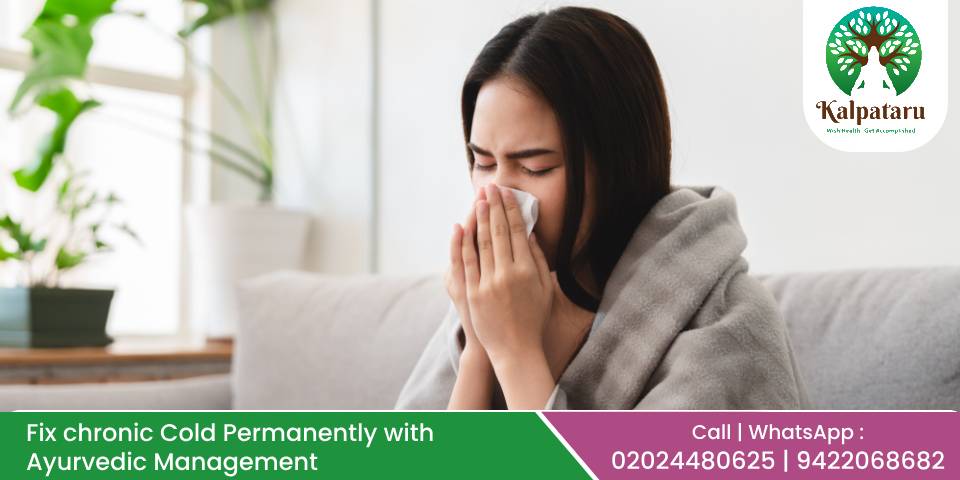
27Nov
Fix chronic cold permanently with ayurvedic management
Running nose, difficulty in breathing, sneezing, itching in nose and ears are some of the symptoms of chronic and allergic cold. Inspite of taking antiallergic, decongestant medicines along with antibiotics, the relief is temporary for many of the patients. For them ayurvedic treatment is proved to be a boon. Ayurvedic not only give symptomatic relief but treats the disease from its root. So recurrence is avoided. Need of any surgical intervention is avoided as well. Ayurvedic medicines boost immunity of respiratory system . So frequent cold is avoided.Chronic cold, a persistent condition characterized by nasal congestion, runny nose, and discomfort, can be significantly influenced by seasonal changes. Ayurveda, the ancient holistic healing system, emphasizes the correlation between nature's cycles and our health. Understanding how different seasons impact the body's doshic balance is crucial in managing chronic cold effectively. Seasonal Influence on Chronic Cold: Winter : During winter, the Vata dosha tends to increase, potentially aggravating symptoms of chronic cold. The cold and dry air can cause nasal passages to become dry and congested, intensifying discomfort.Ayurvedic Strategies for Winter:Nasya: This nasal therapy involves applying medicated oils such as sesame or ghee into the nasal passages to lubricate and soothe.Warm, Nourishing Foods: Including soups, stews, and herbal teas helps pacify Vata and strengthens immunity.Abhyanga (Oil Massage): Regular oil massage with sesame oil helps maintain warmth and moisture in the body. Spring (Vasant Ritu): In spring, Kapha dosha may accumulate, potentially exacerbating chronic cold symptoms. Increased moisture and pollen in the air can trigger allergies and congestion.Ayurvedic Strategies for Spring:Light and Warm Foods: Favouring lighter, warm foods and incorporating pungent spices like ginger, black pepper, and cloves helps clear congestion.Herbal Remedies: Trikatu, a combination of ginger, black pepper, and long pepper, is beneficial in alleviating Kapha-related symptoms.Regular Exercise: Engaging in physical activities stimulates circulation and prevents stagnation. Summer (Grishma Ritu): The Pitta dosha can aggravate inflammation and chronic cold symptoms during summer. High temperatures can intensify nasal discomfort.Ayurvedic Strategies for Summer:Cooling Foods: Consumption of cooling foods like khas, mint, and coriander helps balance Pitta.Hydration: Staying well-hydrated with water and fresh fruit juices prevents dryness and soothes the respiratory system.Avoiding Excessive Sun Exposure: Preventing overexposure to the sun and opting for calming activities like meditation or yoga is beneficial. Monsoon (Varsha Ritu): The humid atmosphere during the monsoon can exacerbate Kapha-related symptoms of chronic cold.Ayurvedic Strategies for Monsoon:Light and Warm Diet: Consuming light, warm, and easily digestible foods is recommended.Warming Spices: Incorporating spices like cinnamon, turmeric, and cloves helps counteract dampness.Maintaining Hygiene: Staying dry and maintaining personal hygiene prevents infections and complications. For more information and treatment modalities watch our informative video https://www.youtube.com/watch?v=nsa7ET97HA4 Ayurvedic Lifestyle Practices for Seasonal Adaptation: Dinacharya (Daily Routine): Adjust daily routines according to seasonal changes, emphasizing practices that balance the predominant dosha. Prioritize adequate rest and sleep to support the body's natural healing processes.Ritucharya (Seasonal Regimen): Follow Ritucharya guidelines to modify diet, lifestyle, and self-care practices according to the season to maintain balance.Yoga and Pranayama: Practice yoga asanas and pranayama techniques suitable for each season to harmonize the body and mind.Herbal Remedies: Consult with an Ayurvedic practitioner for specific herbs.Dr. Manoj Deshpande and Dr. Aparna Deshpande at Kalpataru Ayurvediya Chikitsalaya™ Clinic provide the best Ayurvedic Treatment for Psoriasis & various diseases in Pune, Maharashtra. For more information about our comprehensive treatment options, or to request an appointment with the best Ayurvedic Doctor in Pune, call +91 9422068682 / +919764837167 / 020-24480625 or Click on Book an Appointment.
Read More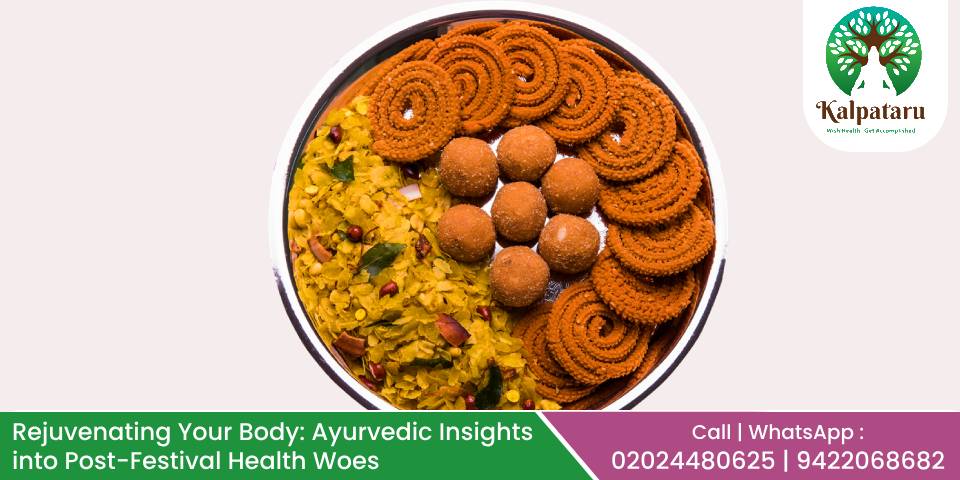
21Nov
Rejuvenating Your Body: Ayurvedic Insights into Post-Festival Health Woes
The festive season, a time of joyous celebration and indulgence, often leaves us brimming with memories and, unfortunately, a few health challenges. While reveling in festivities, it's easy to lose track of moderation, leading to digestive discomfort, fatigue, and weakened immunity afterward. Ayurveda, the ancient science of wellness, offers valuable insights and solutions to restore balance and vitality Post-Festival Health. Digestive Distress: One of the most common issues post-festivals is digestive upset. Irregular eating habits, consuming high calorie rich and heavy foods, and overeating can disturb the digestive fire (agni). This disruption leads to bloating, indigestion, acidity and sluggishness.Ayurvedic Solution: To pacify aggravated digestion, opt for easily digestible foods like cooked vegetables, whole grains like rice or jowar and herbal teas. Incorporate spices like ginger, cumin, and fennel to aid digestion. Triphala, an Ayurvedic herbal formula, can help regulate bowel movements and detoxify the system gently. To set the digestive fire to correct state, have food in less quantity. Avoid fried food stuffs. Avoid maida , sweets and heavy to digest food items like paneer etc. Avoid refrigerated food which is capable of suppressing your digestive fire. Try to eat freshly prepared food both the times. Have good sleep so as to boost your immune system . Avoid non veg food , alcohol . Depleted Energy Levels: After days of merry-making, exhaustion often sets in. Late nights, irregular sleep patterns, and excessive physical or mental exertion during celebrations can leave us feeling drained.Ayurvedic Solution: Focus on restorative practices like early bedtime, meditation, and gentle yoga stretches. Nourish your body with nutrient-rich foods like fresh fruits, nuts, and seeds. Ashwagandha, an adaptogenic herb, can help revitalize the body and alleviate stress-induced fatigue. Weakened Immunity: Frequent exposure to crowds and changes in weather during festivals can compromise the immune system, making us susceptible to infections.Ayurvedic Solution: Strengthen your immunity with herbal formulations like Chyawanprash, rich in antioxidants and immune-boosting herbs. Consume warm, freshly cooked meals and stay hydrated with herbal teas or warm water to flush out toxins. For more information and treatment modalities watch our informative video https://www.youtube.com/watch?v=43ka40EyFfs&t=74s Detoxification and Rejuvenation: Post-festival detoxification aids in clearing accumulated toxins (ama) from the body, restoring vitality and enhancing overall well-being.Ayurvedic Solution: Consider a short-term detox regimen with a mono-diet of kitchari (a blend of rice and lentils) or undertake Panchakarma, an Ayurvedic detoxification therapy, under the guidance of a qualified practitioner. This helps in rejuvenating the body and balancing doshas (biological energies). Balancing Doshas: Ayurveda emphasizes the balance of doshas—Vata, Pitta, and Kapha—within the body. Festivals often disturb this equilibrium, leading to various health issues.Ayurvedic Solution: Incorporate practices aligned with your predominant dosha to restore balance. For example, Vata types may benefit from warm, unctuous grounding foods and routines. Pitta individuals can favor cooling, soothing foods, and Kapha types may benefit from stimulating and invigorating practices. Conclusion: Implementing these ancient yet effective Ayurvedic practices recommended by Kalpataru Ayurvediya Chikitsalaya™ not only promotes Post-Festival Health but also instills enduring habits for a healthier lifestyle.As you bid farewell to the festivities, entrust Kalpataru Ayurvediya Chikitsalaya™ to guide you toward holistic rejuvenation and wellness, allowing you to savor the joys of everyday life with renewed vitality and balance.
Read More
11Nov
Celebrating Dhanteras: Embracing Health on Dhanvantari Jayanti
Diwali, the festival of lights, brings with it a unique day of celebration in India known as Dhanteras. On this auspicious occasion, the medical community in the country rejoices in the spirit of Dhanvantari Jayanti, venerating the God of Ayurveda and the physician of the gods, bhagvan Dhanvantari. The Mythical Tale of Dhanvantari's Birth: The narrative begins with the irate Durvasa Rishi cursing Indra, causing chaos in Devaloka. To restore balance, the gods decided to churn the ocean, using Mandara Mountain and the serpent Vasuki. From this cosmic endeavor emerged various treasures, both benevolent and malevolent. Notable among them were the Halahal poison, Varuni, the Kaustubha gem, the Parijata tree, Kalpavriksha, Kamadhenu, and, of course, Lakshmi. Amidst these treasures, Dhanvantari emerged from the ocean, carrying a pot of amrita, the nectar of immortality. Symbolism in Dhanvantari's Four Hands: Dhanvantari is depicted with four hands, each holding a symbolic item shedding light on the path to holistic health.The Conch (Shankha): Representing the sky element, it symbolizes sound. According to Panchabhuta Chikitsa, a health system founded by Late A. W. Datar Shastriji, a balanced sky element contributes to overall well-being. Dhanvantari suggests that aligning the sky element within our bodies promotes good health.The Discus (Chakra): With 108 spokes, this chakra mirrors the time cycle in the Rig Veda. Ayurveda emphasizes the significance of proper timing in maintaining good health. Dhanvantari advises that adhering to the right practices at the right time contributes to overall well-being.The Jalauka (Leeche): It's a water creature, it is a vital tool for bloodletting ( Raktmokshan panchkarma treatment) in Ayurveda. Dhanvantari underscores the importance of pure blood for overall health, as Ayurveda's treatments are rooted in the health of the blood element.The Pot of Amrita: Establishing the sky element and maintaining a healthy blood element lead to the elixir of health, represented by the pot of amrita. Dhanvantari guides that achieving balance in these elements results in overall well-being. The Legacy of Dhanvantari in Ayurveda: Another Dhanvantari, the son of King Dhanv from Kashi, played a pivotal role in shaping Ayurveda. Bestowed with knowledge from Rishi Bharadwaj, he created eight branches of Ayurveda, known as Ashtanga Ayurveda. Sushrutacharya, his disciple and hailed as the Father of Surgery, shared surgical principles that still command respect in modern surgical medical literature. For more information and treatment modalities watch our informative video https://www.youtube.com/watch?v=PHqAYNu7lk4&t=6s Celebrating National Ayurveda Day: As we celebrate Dhanteras and Dhanvantari Jayanti, let us embrace the teachings of Dhanvantari, worshiping with devotion and singing praises to the health-bestowing deity. In doing so, we invite the blessings of Dhanvantari for a life filled with well-being and good health.This special day holds not only cultural significance but is also recognized as National Ayurveda Day, reinforcing the importance of traditional medicine in promoting holistic health. May the wisdom of Ayurveda continue to guide us towards a healthier and harmonious existence. Summary: Dhanteras, the second day of Diwali, is observed in India as Dhanvantari Jayanti, dedicated to the God of Ayurveda. The celebration traces back to a mythological tale of cosmic churning, unveiling treasures and the emergence of Dhanvantari with the elixir of immortality. Depicted with four symbolic items, Dhanvantari imparts valuable lessons: the conch signifies the sky element, the discus emphasizes proper timing, the Jaluka underscores the importance of pure blood, and the pot of amrita represents holistic health.Jay DhanwantariJay Ayurveda!!!
Read More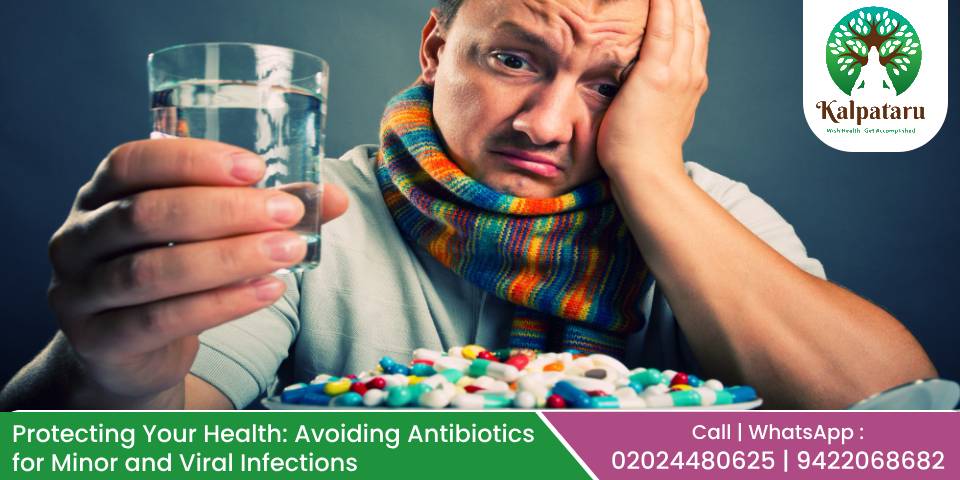
02Nov
Protecting Your Health: Avoiding Antibiotics for Minor and Viral Infections
In today's fast-paced world, it's easy to reach for antibiotics as a quick fix for common illnesses like colds, coughs, sore throats, and fevers. However, it's important to understand that antibiotics are primarily effective against bacterial infections, and many of these everyday ailments are caused by viruses. Overuse of antibiotics not only contributes to antibiotic resistance but can also weaken your immune system. In this blog, we'll explore the reasons to avoid antibiotics for minor and viral infections and provide alternative, natural remedies that can help you on your path to recovery. Antibiotics for Viral Infections: First and foremost, it's essential to realise that antibiotics are not effective against viral infections. Conditions like the common cold, the flu, and most cases of sore throats are caused by viruses. Taking antibiotics for these illnesses is not only ineffective but can lead to unwanted side effects and contribute to the development of antibiotic-resistant superbugs. Natural Remedies for Common Ailments: Coughs: Instead of relying on antibiotics, consider turning to nature's remedies. High-quality honey is a soothing and effective treatment for a nagging cough. It can help relieve irritation and provide relief without the need for antibiotics. Sore Throats: Gargling with warm saltwater or sipping on warm water can help alleviate the discomfort of a sore throat. Honey, with its natural antibacterial properties, can also provide relief. Fevers: Fever is your body's way of fighting infection, so it's not always necessary to suppress it with medications like paracetamol. You should only consider fever-reducing medication if your fever exceeds 100 degrees Celsius or if it's really being difficult for you to tolerate that temperature. Otherwise, rest, maintain warmth, consume warm soup, and eat a light diet to support your body's natural defenses.Colds: The saying, "If you take medicine for a cold, it will be cured in 7 days. If you don't take medicine for a cold, it will be cured on its own in 7 days," holds some truth. Instead of relying on medications, natural remedies like applying a ginger-cardamom paste to your forehead and nose can provide relief from cold symptoms.Read about: Ayurvedic treatment for psoriasis For more information and treatment modalities watch our informative video https://www.youtube.com/watch?v=rrbh7XbqV7M&t=13shttps://www.youtube.com/watch?v=gItGHhnkrns&t=3s Here are some facts and statistics regarding antibiotic resistance in India: High Antibiotic Consumption: India is one of the world's largest consumers of antibiotics. Approximately 40% of these antibiotics is used inappropriately, such as for viral infections or without proper prescription.Rising Antibiotic Resistance: The misuse and overuse of antibiotics in India have contributed to a significant increase in antibiotic resistance. Bacterial infections that were once easily treatable are becoming more challenging to manage.Hospital-Acquired Infections: Hospital-acquired infections, including those caused by antibiotic-resistant bacteria, are a major concern in India's healthcare system. These infections can lead to prolonged hospital stays, increased healthcare costs, and higher mortality rates.Tuberculosis (TB) and Antibiotic Resistance: India has a high burden of drug-resistant tuberculosis (DR-TB), which is challenging to treat and control. The emergence of multi-drug-resistant (MDR) and extensively drug-resistant (XDR) TB strains is a significant public health threat.Impact on Child Health: Antibiotic resistance can be particularly harmful to children. In India, where childhood illnesses are prevalent, antibiotic resistance can complicate the treatment of common infections, such as pneumonia and urinary tract infections.Limited New Antibiotics: The development of new antibiotics has slowed down, and there are limited treatment options for some drug-resistant infections. This makes it crucial to preserve the effectiveness of existing antibiotics.Economic Burden: Antibiotic resistance imposes a substantial economic burden on healthcare systems, as it leads to longer hospital stays, increased healthcare costs, and a greater need for advanced treatments.Government Initiatives: The Indian government has initiated efforts to address antibiotic resistance, including the National Action Plan on Antimicrobial Resistance (NAP-AMR) to promote responsible antibiotic use and surveillance of resistance.By understanding the limitations of antibiotics and the consequences of their misuse, individuals can take steps to protect their health and contribute to addressing the critical issue of antibiotic resistance, particularly in India.Dr. Manoj Deshpande and Dr. Aparna Deshpande at Kalpataru Ayurvediya Chikitsalaya™ Clinic provide the best Ayurvedic Treatment for various diseases in Pune, Maharashtra. For more information about our comprehensive treatment options, or to request an appointment with the best Ayurvedic Doctor in Pune, call +91 9422068682 / +919764837167 / 020-24480625 or Click on Book an Appointment.
Read More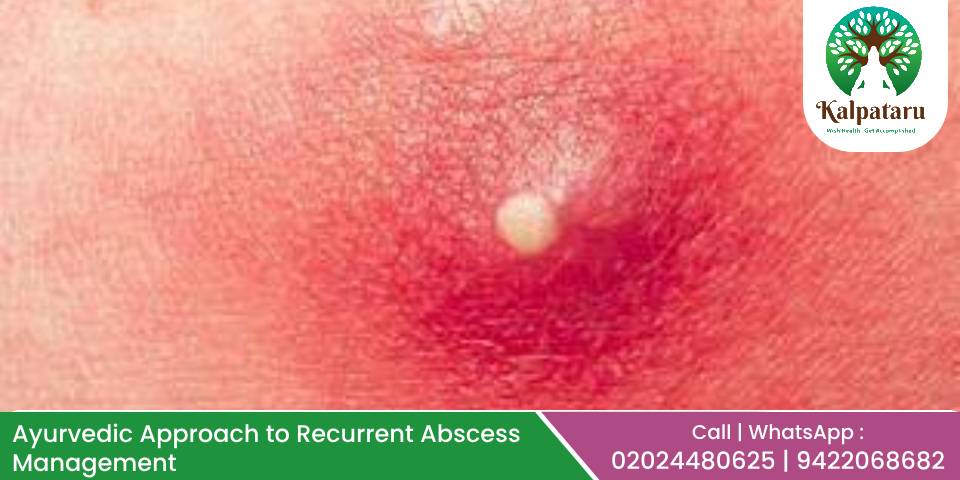
30Oct
Ayurvedic Approach to Recurrent Abscess Management
Recurrent abscesses can be a painful and frustrating problem for many individuals, particularly those with a disposition towards heat and low immunity. This issue is often exacerbated in individuals with diabetes and tends to become more prominent during the sweltering heat of summer and October. While it may be tempting to deal with abscesses manually, such as bursting them with a needle or pressing them, it's important to avoid such actions, especially when the abscess is immature. These actions can lead to further infection and complications.Abscesses can appear in various areas of the body, including the armpits, thighs, hips, anal and vaginal regions, dental sites, and areas around hair roots. Specific types of abscesses, such as fistulae, pilonidal sinuses, or perianal abscesses, can occur in regions related to defecation. To effectively manage and prevent recurrent abscesses, Ayurveda offers a holistic approach that focuses on identifying the root causes of these recurrent infections. This blog will explore the Ayurvedic approach to managing recurrent abscesses. Understanding the Causes: Ayurveda emphasizes the importance of finding the underlying causes of recurrent abscesses. Several factors can contribute to their recurrence, including:Diet: Consuming spicy and salty foods can increase the body's heat, making it prone to abscesses.Lifestyle: Staying up late, stress, and inadequate sleep can weaken the immune system, making the body susceptible to infections.Previous Illnesses: Conditions that induce heat in the body, such as measles, chickenpox, or jaundice, can leave residual heat, increasing the likelihood of abscesses. The Treatment Approach: Ayurvedic treatment for recurrent abscesses aims to heal them at an immature stage, preventing the development of mature abscesses. Mature abscesses can be more painful and may lead to deeper infections. The treatment methods include:Poultices and local application of herbs ie Leo: Local applications of ingredients like Moringa, Triphala, Panchvalkala, or other herbal formulations can help reduce inflammation and prevent abscesses from maturing.Bloodletting (Rakta Mokshana): Bloodletting, a vital Panchakarma treatment, involves drawing blood from a vein or applying leeches (Jalauka) near the abscess. Leeches have a unique ability to absorb impurities, toxins, and deep-seated infections, preventing the spread of infection and promoting the subsiding of the abscess. This treatment can often be a non-surgical alternative to abscess management.Oral Medications: Ayurvedic medicines such as Shilajit, Guggul, Nimbasal, Manjishta, and Sariva can be taken orally to reduce the likelihood of recurrent abscesses. These medications help in balancing the body's internal heat and strengthening the immune system. For more information and treatment modalities watch our informative video https://www.youtube.com/watch?v=YJxtmZjCd9Q Conclusion: Recurrent abscesses can be both painful and frustrating for those affected. Ayurveda offers a holistic approach to address this issue by identifying and addressing the root causes. Avoiding impulsive actions like manually bursting immature abscesses is crucial to prevent further complications. By adopting Ayurvedic treatments, including bloodletting, local applications, and oral medications, many individuals have experienced long-lasting relief from recurrent abscesses without the need for surgery. A balanced diet, a healthy lifestyle, and Ayurvedic remedies can help individuals maintain a state of equilibrium within the body, reducing the chances of recurrent abscesses and promoting overall well-being.
Read More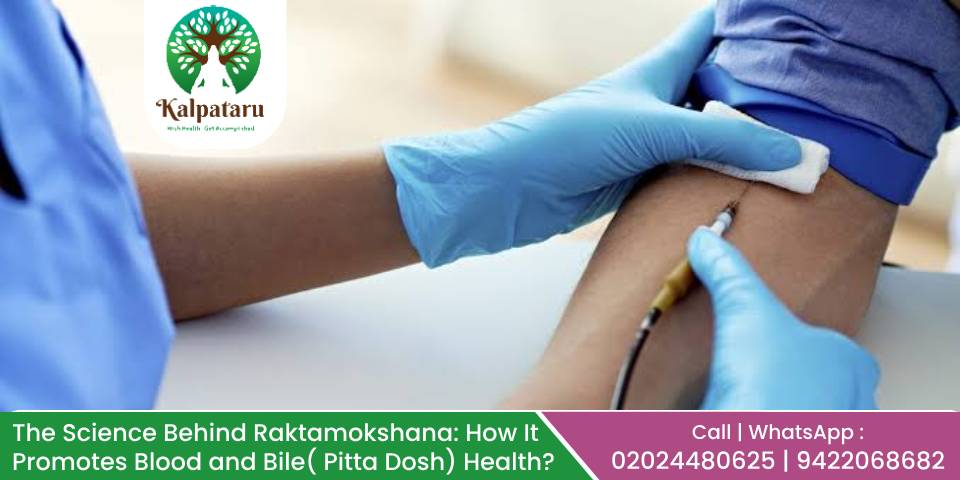
21Oct
The Science Behind Raktamokshana: How It Promotes Blood and Bile( Pitta Dosh) Health?
October is the month when there is natural surge in heat and blood impurities in our body. Ancient scholars of ayurveda being aware of this thing, advised to let go the blood outside the body by means of Raktamokshan - a novel panchkarm treatment . So it is advisable for every individual to undergo this panchkarm therapy so as to avoid blood originated ailments.In the world of Ayurveda, Raktamokshana is a therapeutic procedure that has been used for centuries to promote overall health and well-being by addressing blood and bile disorders. At Kalpataru Ayurvediya Chikitsalaya™, our team of expert Ayurvedic practitioners, led by Dr. Manoj Deshpande and Dr. Aparna Deshpande, are dedicated to providing comprehensive and reliable health solutions to patients. In this blog, we will explore the science behind Raktamokshana and how it effectively promotes blood and bile health. This age-old Ayurvedic technique offers a holistic approach to various health concerns, ranging from skin problems to joint pain, and even conditions like migraine headaches and recurrent abscesses. Understanding Raktamokshana: Raktamokshana is a term in Ayurveda that refers to the removal of blood containing impurities from the body. This procedure is rooted in the belief that many health issues, including those related to the skin, joints, and overall well-being, are often linked to an imbalance in Pitta and Raktdosha (blood-related factors). By performing Raktamokshana, Ayurvedic practitioners aim to correct these imbalances, leading to a variety of health benefits. Key aspects of Raktamokshana: Purification of Blood: The main objective of Raktamokshana is to purify the blood by removing impurities or vitiated elements. According to Ayurvedic principles, many health issues are believed to be associated with imbalances in the blood, known as Rakta Dosha. These imbalances can lead to various diseases and discomfort. Types of Raktamokshana: Shastra (Surgical) Raktamokshana: This method involves the use of surgical instruments, such as needles or lancets, to puncture a vein or blood vessel. This is typically performed by skilled Ayurvedic practitioners.Anushastra (Non-surgical) Raktamokshana: In this approach, non-invasive methods are used to encourage the removal of impure blood. Leech therapy (Jalauka Avacharana) is a well-known form of non-surgical Raktamokshana. Leeches are applied to the skin, and they naturally draw blood. This method is considered less invasive than surgical Raktamokshana. Precautions and Aftercare: Raktamokshana should be performed by qualified Ayurvedic practitioners in a clean and sterile environment. After the procedure, patients are usually advised to rest and follow dietary and lifestyle recommendations to support the healing process and maintain the benefits of Raktamokshana. Advantages of Raktamokshana: The advantages of Raktamokshana extend far beyond the treatment of specific conditions. This ancient Ayurvedic procedure offers a holistic approach to maintaining and promoting overall health. Some of the key benefits include:Pimple Management: Raktamokshana can help in managing and preventing pimples by detoxifying the blood and reducing Pitta imbalances.Skin Disease Treatment: Various skin diseases, including eczema and psoriasis, can be effectively managed through Raktamokshana due to its blood purification properties.Joint Pain Relief: Raktamokshana provides relief from joint pain conditions like osteoarthritis, rheumatoid arthritis, and gout.Hair Regrowth in Alopecia Areata: For individuals with alopecia areata, Raktamokshana can stimulate hair regrowth by enhancing blood circulation in the affected areas.Migraine Headache Management: By regulating blood flow, Raktamokshana helps in reducing the frequency and intensity of migraine headaches.Preventing Recurrent Abscesses: Individuals prone to recurrent abscesses can benefit from Raktamokshana, which purifies the blood and minimizes impurities. For more information and treatment modalities watch our informative video https://www.youtube.com/watch?v=y38cLYd0re4https://www.youtube.com/watch?v=KZrXUIm7nkQ&t=4s Conclusion: Raktamokshana is a time-tested Ayurvedic therapy that offers a holistic approach to health and wellness by addressing blood and bile disorders. It is a versatile procedure that can benefit individuals suffering from a wide range of conditions, from skin issues and joint pain to migraine headaches and recurrent abscesses, herpez etc. At Kalpataru Ayurvediya Chikitsalaya™, our expert Ayurvedic doctors, Dr. Manoj Deshpande and Dr. Aparna Deshpande, provide personalized treatment plans that may include Raktamokshana to help you achieve optimal health and well-being. Ayurveda, with its ancient wisdom and modern applications, is here to guide you on your journey to a healthier, happier life.
Read More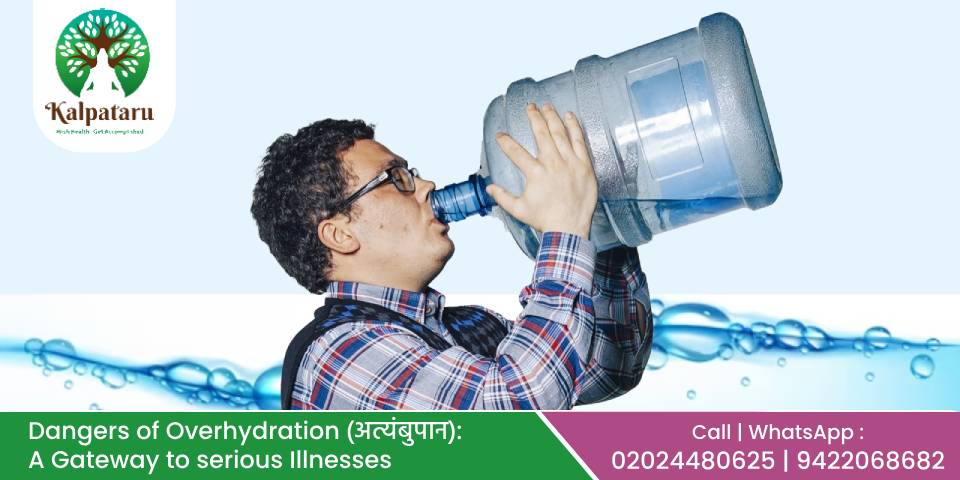
13Oct
Dangers of Overhydration: A Gateway to Serious Illnesses
In the holistic realm of health and well-being, where the whispers of ancient wisdom intertwine with modern science, Kalpataru Ayurvediya Chikitsalaya™ has emerged as a trusted heaven. Nestled in Pune, PCMC, and Navi Mumbai, this Ayurvedic sanctuary, under the expert guidance of Dr. Manoj Deshpande and Dr. Aparna Deshpande, has garnered acclaim for its comprehensive and reliable health solutions. The Water-Health Connection: Water, often referred to as the elixir of life, is the cornerstone of our well-being. Its role in maintaining bodily functions, from facilitating nutrient transport to regulating temperature, cannot be overstated. However, this symbiotic relationship with water demands a delicate equilibrium. Understanding Excess: The first step in comprehending the potential perils of water consumption lies in understanding what constitutes excess. The commonly touted "8x8 rule" recommending eight 8-ounce glasses of water per day is a good baseline, but individual requirements vary based on factors like age, activity level, and climate.Going beyond these limits can lead to a condition known as hyponatremia, where the balance of electrolytes, especially sodium, is disrupted. Contrary to the popular belief that more water is always better, an excess can strain the kidneys and, paradoxically, lead to dehydration. Impact on the Body: Renal Strain: Excessive water intake puts a strain on the kidneys, which are responsible for filtering waste from the blood to form urine. The kidneys maintain a delicate balance, and Dangers of overhydration is potentially leading to complications.Electrolyte Imbalance: Sodium, potassium, and other electrolytes are crucial for nerve and muscle function. Dilution of these essential elements due to excessive water can disrupt cellular functions, leading to symptoms ranging from nausea to seizures.Cellular Swelling: When there's an excess of water in the bloodstream, it can enter cells, causing them to swell. While most cells can regulate this swelling, the brain is enclosed in the skull, limiting its ability to expand. This can result in increased intracranial pressure, a serious condition. For more information and treatment modalities watch our informative video https://www.youtube.com/watch?v=pyWiIVdrRw4&t=2s The Role of Ayurveda: Ayurveda, the ancient Indian system of medicine, provides unique insights into the balance between water and health. According to Ayurveda, individual constitutions, or doshas (Vata, Pitta, and Kapha), play a crucial role in determining the appropriate water intake. Dr. Manoj Deshpande and Dr. Aparna Deshpande, with their deep knowledge of Ayurveda, offer personalized advice based on these principles.Vata Dominance: Those with a predominant Vata constitution may require more fluids to balance their inherent dryness.Pitta Predominance: Pitta types, on the other hand, need to be cautious about excess water to prevent aggravating their natural heat.Kapha Constitution: Kapha individuals, characterized by earth and water elements, benefit from maintaining a moderate water intake to avoid congestion and sluggishness. Personalized Approaches to Wellness: The hallmark of Kalpataru Ayurvediya Chikitsalaya™ lies in its patient-centric approach. Each individual is unique, and so are their health needs. The experienced doctors at the clinic take the time to understand the intricacies of a person's constitution, lifestyle, and existing health conditions.Thirst as a Guide: Instead of adhering rigidly to generic water intake guidelines, the emphasis is on listening to the body. Thirst, a natural mechanism, serves as a guide for when and how much water one needs.Balancing Doshas: The Ayurvedic doctors at Kalpataru Ayurvediya Chikitsalaya™ craft bespoke treatment plans that align with Ayurvedic principles, ensuring that water consumption complements an individual's doshic balance. Conclusion: Thers is separate topic in Ayurveda on effects of excess water intake and their repurcations. Excess water is supposed to extinguish normal Agni ( digestive capacity). That further leads to development of many kaf dosh dominated diseases such as diabetes, hypertension, obesity , cold , asthma and so on. One research has been done in an Ayurvedic institute on relation between excess water intake and it's hazardous effects on health. In that research most of the patients of diabetes were found to have excess water intake habit.In the pursuit of health, the journey often requires navigating through the delicate balance of seemingly simple elements like water. Excessive water consumption, once perceived as a harmless habit, can unfold a cascade of health issues. The wisdom of Ayurveda, combined with the personalized care offered by Kalpataru Ayurvediya Chikitsalaya™, presents a holistic approach to maintaining this balance.The key takeaway is not a one-size-fits-all approach but a nuanced understanding of individual needs. By embracing this perspective, individuals can embark on a journey towards optimal health, where the elixir of life is sipped in harmony with the body's unique symphony.
Read More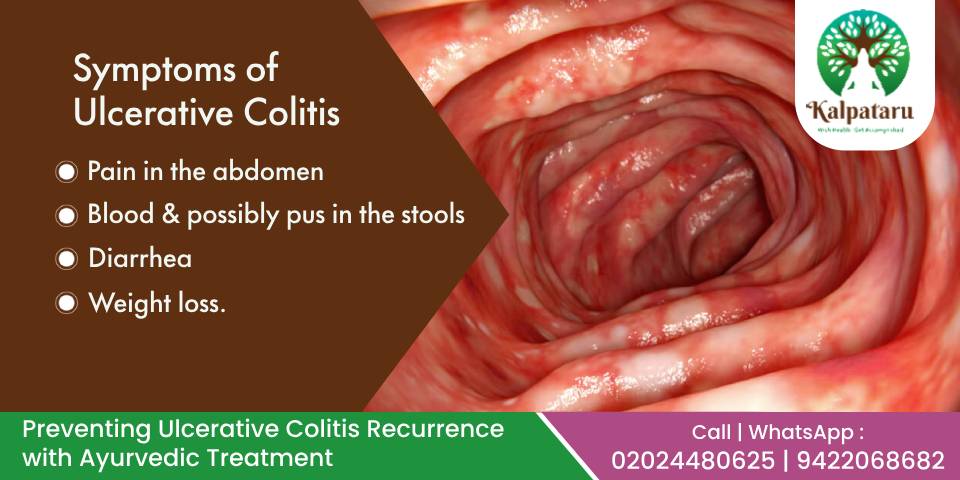
10Oct
Preventing Ulcerative Colitis Recurrence with Ayurvedic Practices
Ulcerative Colitis (UC) is a chronic inflammatory bowel disease that affects millions of individuals worldwide, that can cause discomfort, pain, and a reduced quality of life for those who suffer from it. While modern medicine has made significant strides in managing Ulcerative Colitis symptoms, preventing its recurrence remains a challenge. Ayurveda, the ancient system of natural healing from India, offers a holistic approach to not only managing Ulcerative Colitis but also preventing its recurrence and promoting overall well-being. In this blog, we will explore how Ayurvedic practices, as advocated by Dr. Manoj Deshpande, can play a crucial role in achieving lasting relief from Ulcerative Colitis. What is Ulcerative Colitis? Ulcerative Colitis is characterized by inflammation and ulcers in the inner lining of the colon and rectum. Its signs can be debilitating, including abdominal pain, diarrhea, rectal bleeding, and fatigue. Managing these symptoms is crucial, but equally important is preventing relapse and maintaining a healthy gut. Ayurvedic Insights into Ulcerative Colitis: Dr. Manoj Deshpande, a renowned Ayurvedic Doctor in Pune, Maharashtra, emphasizes that Ulcerative Colitis is primarily caused by an imbalance in the body's doshas, specifically the Pitta and Vata doshas. Dr. Manoj Deshpande is treating Ulcerative Colitis and involves restoring this balance through personalized dietary modifications, lifestyle changes, and herbal remedies.Balancing Pitta Dosha: Pitta dosha represents fire( Agni) component in the body. Excessive Pitta can cause inflammation, a common feature of UC. Dr. Deshpande suggests cooling herbs like aloe Ushir, coriander, and licorice to pacify Pitta and reduce inflammation.Calming Vata Dosha: Vata dosha, governs movement in the body. Imbalanced Vata can lead to irregular bowel movements and pain. Ayurvedic oils, gentle massages, and warm, easily digestible foods can assist in balancing Vata, promoting overall gut health. For more information and treatment modalities watch our informative video https://www.youtube.com/watch?v=30m5NiTTYHE&t=55s Preventing Ulcerative Colitis Recurrence: Ayurvedic Practices: Here are some Ayurvedic practices that Dr. Manoj Deshpande suggests for preventing ulcerative colitis recurrence:1) Dietary Modifications: Dr. Deshpande emphasizes the importance of an individualized diet plan. People with Ulcerative Colitis can benefit from following Ayurvedic dietary approaches. Some suggestions include:-Avoid spicy, greasy, and processed foods that can worsen inflammation.-Favoring easily digestible foods such as cooked vegetables, rice, and well-cooked lentils.-Incorporating anti-inflammatory spices like turmeric and ginger into your meals.2) Stress Management: Ayurveda recognizes the strong connection between the mind and the gut. Chronic stress can trigger Ulcerative Colitis episodes. Dr. Deshpande advocates for regular meditation, yoga, and breathing exercises to manage stress and promote emotional well-being.3) Herbal Supplements: Ayurvedic herbs play a crucial role in preventing UC recurrence. Dr. Deshpande often prescribes formulations containing Nagarmotha, Suwarn gairik, jatifal, Shunthi, bilwfal etc.to his patients. These herbs have anti-inflammatory and gut-soothing properties, aiding in long-term management.4) Lifestyle Changes: Adequate sleep and a consistent daily routine are critical in Ayurveda. Dr. Deshpande suggests his patients maintain a regular sleep schedule and engage in light exercises like walking to boost overall health.Ayurvedic Lifestyle Modifications:-Yoga and Pranayama: Regular yoga asanas and pranayama (breath control) exercises improve digestion, relieve stress, and improve overall well-being. Incorporating these practices into daily routines can significantly contribute to preventing Ulcerative Colitis recurrence.-Oil Pulling: This ancient Ayurvedic method involves swishing oil in the mouth to improve oral and gut health. By removing toxins from the body, oil pulling can support the recovery process and prevent relapses.-Abhyanga (Self-Massage): Abhyanga, or self-massage with warm, herbal oils, can pacify aggravated doshas and promote relaxation. Massaging the abdomen with specific oils can ease digestive issues and minimize inflammation in the colon.5) Panchakarma: In severe cases, Dr. Deshpande may suggest Panchakarma, an Ayurvedic detoxification procedure that helps remove toxins from the body balance the doshas, and improve overall health, which may contribute to preventing UC recurrence. Specialised basti( Ayurvedic retention enema) is administered so as to heal the ulcers in colon. This is a very effective panchkarm treatment for ulcerative colitis6) Consultation with an Ayurvedic Practitioner: It's crucial to work with a qualified Ayurvedic practitioner who can evaluate your individual constitution (Prakriti) and imbalances (Vikriti) to create a personalized treatment plan.7) Regular Follow-up: Dr. Manoj Deshpande advises regular follow-up appointments to monitor your improvement and make required adjustments to your Ayurvedic regimen. Conclusion: Ayurvedic practices can be an effective way to help prevent Ulcerative Colitis recurrence. By following a healthy diet, making lifestyle changes, and using herbal remedies, you can reduce your risk of having a flare-up.If you're struggling with Ulcerative Colitis, consulting with an experienced Ayurvedic practitioner like Dr. Manoj Deshpande may be a step towards a healthier and more comfortable life. By embracing Ayurveda, individuals with Ulcerative Colitis can enhance their quality of life and reduce the risk of recurrent flare-ups.
Read More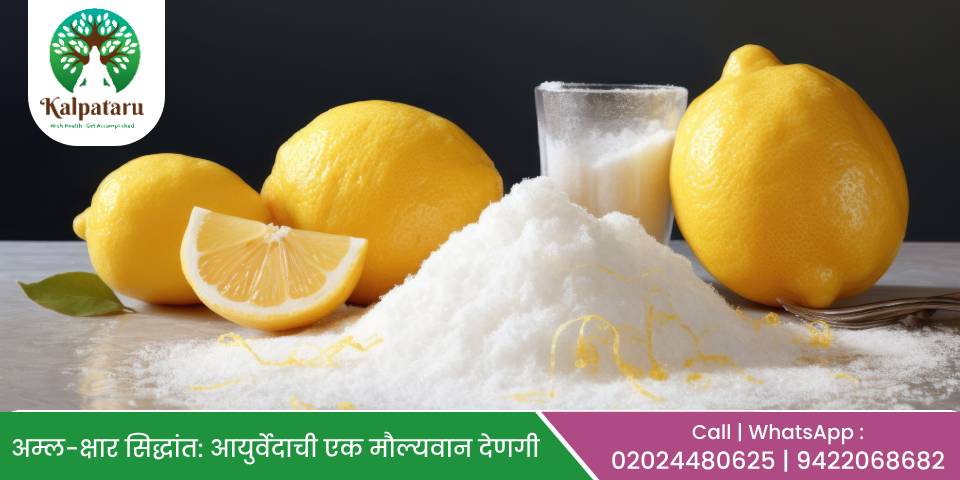
06Oct
अम्ल-क्षार सिद्धांत: आयुर्वेदाची एक मौल्यवान देणगी
अम्ल क्षार सिंद्धांत हा पांचभौतिक चिकीत्सेतील म्हणजेच आयुर्वेदातील एक अत्यंत महत्वाचा सिद्धांत आहे. अगदीच याचे घरगुती उदाहरण द्यायच जर म्हटलं तर लिंबू सरबत बनवताना नेहमी पारंपारिक पद्धतीने बनवतो त्यापेक्षा लिंबू आणि मीठ एकत्र केले आणि मग त्यात पाणी साखर या गोष्टी जर मिसळ्या तर लिंबू सरबत ची चव जास्त छान होते. त्याचप्रमाणे श्रीखंड बनवताना चक्का जो असतो त्याच्यामध्ये जर सुंठ टाकली आणि मग त्याचे श्रीखंड बनवले तर ते श्रीखंड आपल्याला बाधत नाही, कारण इथे अम्ल क्षार सिंद्धांत काम करतो. अम्ल आणि क्षार म्हणजे काय ? आम्लता आणि क्षारता या दोन गोष्टी आयुर्वेदा मध्ये सांगितलेल्या आहेत त्याविषयी आपण माहिती पाहू. ढोबळमानाने आपल्याला शाळेत माहित असते की acid आणि alkali या दोन गोष्टी ज्यावेळेस एकत्र येतात तेव्हा त्यातून reaction होते आणि neutral असा pH असलेला घटक त्यातून तयार होतो तर हे ढोबळ उदाहरण परिपूर्ण नाही, परंतु साधारणतः हे आपण वापरू शकतो व त्यातून आम्ल क्षार सिंद्धांत समजून घेऊ शकतो. तर याची मूळ उत्पप्ती आयुर्वेदामध्ये मद्यपान मुळे शरीरावर झालेले परिणाम घालवण्यासाठी वेगवेगळे क्षार वर्णन केले आहेत त्यातून या सिंद्धांताची सुरुवात गुरुवर्य कै. आत्माराम वामन दातार शास्त्री नी केली. पांचभौतिक चिकीत्सेतील आम्ल क्षार सिद्धांत हे प्रकृती ठरवणे, औषधे निर्माण करणे किंवा रोगाची सम्प्राप्ति मांडणे त्याप्रमाणे ऋतुचर्या, दिनचर्या या सर्व गोष्टींमध्ये हा सिंद्धांत आपल्याला अत्यंत उपयुक्त ठरतो तर त्याची आपण माहिती पाहूया.थोडक्यात आम्लता म्हणजे ज्यामध्ये द्रवत्व जास्त असते किंवा ज्यामध्ये पृथ्वी आणि आपमहाभूताचे गुण जास्त असतात आणि तेज महाभुत अल्प प्रमाणात असते असा जो पदार्थ असतो तो आम्लधर्मी समजला जातो आणि ज्याच्यामध्ये पाचन हा गुण जास्त आहे, किंवा उष्णता तीक्ष्णता असे गुण जास्त आहेत हा क्षार धर्मी समजला जातो. त्याच्यामध्ये द्रवत्व कमी असते. तर आपल्या शरीरासाठी उत्तम आरोग्यासाठी आम्ल आणि क्षार या दोन्ही तत्वांची जरुरी असते आणि त्यांचे एकत्रीकरण योग्य प्रमाणामध्ये जेव्हा होईल तेव्हा आपल्याला उत्तम आरोग्य लाभते. आम्ल आणि क्षार यांच्या एकत्रीकरणातून एक प्रकारचे माधुर्य तयार होते कि जे आपल्या शरीराला उत्तम बल, स्थैर्य, रोगप्रतिकारशक्ती देत असते. आयुर्वेद आणि आम्ल-क्षार सिद्धांत: प्रकृती आम्ल क्षार सिंद्धांतांनुसार ठरवावी हा आयुर्वेदामध्ये आदेश आहे. तर ज्या व्यक्तींचा रक्तधातू मातेच्या उदरामध्ये असताना जुलै, ऑगस्ट आणि सप्टेंबर या महिन्यामध्ये झालेला असतो त्यांची प्रकृती ही आम्लधर्मीय असते आणि ज्या व्यक्तींचा रक्तधातू मातेच्या उदरामध्ये असताना मार्च, एप्रिल, मे महिन्यामध्ये झालेले असतील तर त्यांची प्रकृती हि क्षारधर्मीय असते . याचा उपयोग चिकित्सा करताना आपल्या वैद्याला होत असतो. त्याचप्रमाणे आम्लधर्मीय प्रकृती आणि क्षारधर्मीय प्रकृती या जर समजल्या तर त्या व्यक्तीला कुठले घरगुती पदार्थ हे जास्त खायला परवानगी द्यावी, कुठले पदार्थ त्याने सिमीत करावे हा पथ्य आणि अपथ्य विचार यातून चांगला लक्षात येतो. तर उदाहरण द्यायचे झाले तर ज्यांची आम्लधर्मीय प्रकृती असते त्याला नेहमी विपरीत इचछा म्हणजे आम्लधर्मच्या विपरीत म्हणजे क्षारधर्म, तर त्या व्यक्तीला नेहमी मीठ जास्त लागणे किंवा मिरची, तिखट, मसालेदार , चटपटीत पदार्थ खायची जास्त आवड असते, त्यांना चहा ही गोष्ट जास्त आवडते तर ज्यांची क्षारधर्मी प्रकृती असते त्या लोकांना ताक, भात, किंवा लिंबूसरबत, पाणीदार पदार्थ किंवा थंड पदार्थ किंवा सरबत यांची आवड जास्त असते. अधिक माहितीसाठी आणि उपचार पद्धतींसाठी आमचा माहितीपूर्ण व्हिडिओ पहा https://www.youtube.com/watch?v=-OTQpYL_F04 आम्ल आणि क्षार यांचे शरीरातील कार्य: वेगवेगळया प्रकारचे जे दुग्धवर्ग जसे की दूध, ताक, दही या सगळ्या गोष्टी त्याचप्रमाणे आपण पीत असलेले पाणी, अनेक प्रकारची फळे, आमसूल, चिंच, या सगळ्या गोष्टी आम्लधर्मीय पदार्थांमध्ये येतात, तर मिरची, लसूण, आले, मसाल्याचे पदार्थ, मोहरी इ. सगळ्या गोष्टी क्षार धर्मा मध्ये येतात. तर आपल्या आहारामध्ये नेहमी या दोन्ही गोष्टींचे संतुलन असले म्हणजे आपली प्रकृती उत्तम राहतेचिकित्सेतील उदाहरण द्यायचे झाले तर जास्त दूध पिल्यामुळे जर जुलाब चालू झाले तर आम्लधर्म हा शरीरामध्ये वाढलेला असतो आणि त्यावेळेस क्षारधर्मीय चिकित्सा ही वैद्याला करावी लागते. म्हणून सुंठी सारखं औषध जर वापरले तर तर हा आजार बरा होतो. त्याचप्रमाणे उलट बघायला गेले तर मसालेदार गोष्टी खाल्यामुळे छातीत जळजळ होणे, पित्त वाढणे यासारख्या गोष्टींमध्ये क्षार धर्मीच्या विरुद्ध काम करणारा आम्ल धर्म जो असतो त्यासाठी ज्येष्ठमधासारखे औषध किंवा सुवर्ण गैरीक सारखं औषध वापरले तर तो आजार जातो. यापद्धतीने तारक मारक विचार हा आम्ल आणि क्षार धर्मीच्या माध्यमातून केला जातो.सृष्टीचे पण तसेच आहे.आपण जेव्हा ऋतूंचा विचार करतो तेव्हा ग्रीष्म ऋतू मध्ये क्षार धर्म जास्त असतो, त्यानंतर वर्षा ऋतूमध्ये आम्ल धर्म जास्त असतो, पुन्हा शरद ऋतू मध्ये उष्णता वाढते, नंतर आरोग्यदायक असा हेमंत आणि शिशीर ऋतू असतो. त्यानंतर पुन्हा उन्हाळा सुरु होतो. तर या पद्धतीने आम्ल आणि क्षार हे एकापाठोपाठ येतात आणि सृष्टीचे आणि पर्यायाने सर्व जीवसृष्टीचे देखील पालन पोषण या आम्ल क्षार सिद्धांताच्या आधारे होत असते.आयुर्वेदाचा मुख्य हेतू हा स्वास्थ टिकवणे हा आहे, आणि ते जर आपल्याला व्यवस्थित टिकवायचे असेल तर आम्ल आणि क्षार सिद्धांताची माहिती ही आपण करून घ्यावी, आपल्या वैद्याकडून आपली प्रकृती तपासून घ्यावी, आणि त्याप्रमाणे आपल्या आहारविहारमध्ये केलेले बदल हे आपल्याला स्वास्थ देण्यासाठी नक्की उपयुक्त ठरू शकतात.अधिक माहितीसाठी Dr. Manoj Deshpande यांना त्वरीत संपर्क करा आणि आमच्या सर्वसमावेशक उपचार पर्यायांबद्दल अधिक माहितीसाठी किंवा पुण्यातील सर्वोत्तम आयुर्वेदिक डॉक्टरांच्या भेटीची विनंती करण्यासाठी, +91 9422068682 / +919764837167 / 020-24480625 वर कॉल करा किंवा अपॉइंटमेंट बुक करा वर क्लिक करा.
Read More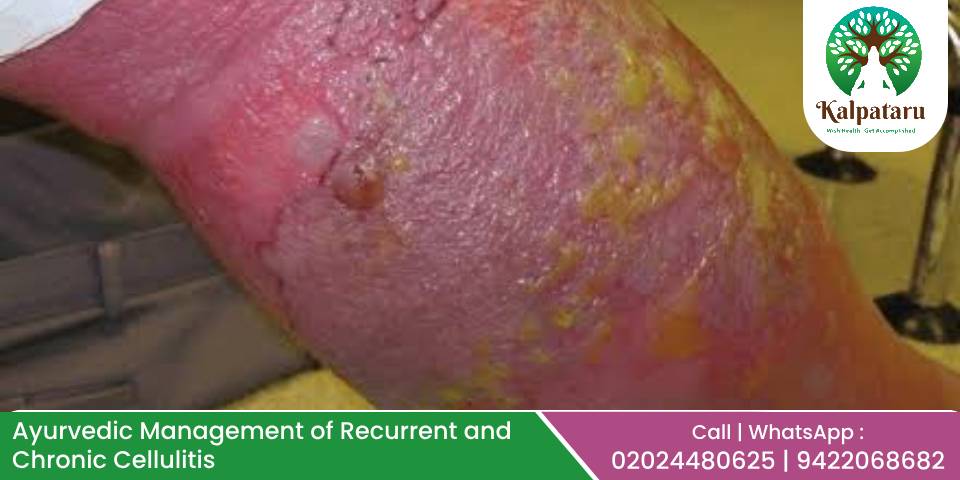
23Sep
Ayurvedic Management of Recurrent and Chronic Cellulitis
Cellulitis, a painful and potentially dangerous skin infection, affects millions of individuals worldwide. While conventional medicine offers effective treatments for acute cellulitis, recurrent and chronic cases can be challenging to manage and, if neglected, may lead to severe consequences like the amputation of affected body parts. At Kalpataru Ayurvediya Chikitsalaya™ clinic in Pune, Dr. Manoj Deshpande offers a holistic and natural approach to managing cellulitis, focusing on balancing the body's energies, stimulating overall health, and preventing such dire outcomes. Understanding Cellulitis in Ayurveda: In Ayurveda, cellulitis is referred to as an imbalance between three doshas . This imbalance disrupts the natural equilibrium of the skin, leading to inflammation, pain, and infection. If neglected, cellulitis can escalate, potentially requiring amputation of the affected body part. What is Recurrent and Chronic Cellulitis? Recurrent and chronic cellulitis is a condition characterized by frequent recurrences or incomplete healing of cellulitis. Poor circulation, a weakened immune system, and underlying medical conditions like diabetes and obesity can contribute to its persistence. Statistical Data on Cellulitis: To provide a better understanding of cellulitis, let's consider some statistical data:Global Incidence: According to the World Health Organization (WHO), cellulitis affects millions of people worldwide each year, posing a substantial healthcare burden.Recurrence Rates: Research published in the Journal of Dermatology indicates that around 30% of individuals who experience an initial cellulitis episode may have a recurrence within three years.Severity and Neglect: Neglected cellulitis can lead to severe complications, surgery including the need for amputation in some cases. Timely and appropriate management is crucial to prevent such outcomes. Ayurvedic Causes of Cellulitis: Ayurveda attributes cellulitis to imbalances in 3 doshas along with the accumulation of toxins (ama) in the body.Low vyadhikshamatwa( immunity) is also one of the causes of cellulitis. These imbalances disrupt skin health and can lead to infections. Ayurvedic management aims to address these root causes. Ayurvedic Management of Recurrent and Chronic Cellulitis: Now, let's delve into the Ayurvedic approach to managing recurrent and chronic cellulitis, incorporating the suggested treatments and therapies:Dietary Recommendations: Ayurvedic practitioners evaluate patients' diets and lifestyles. Research indicates that a diet rich in anti-inflammatory foods, such as fresh vegetables and fruits, can help reduce inflammation and support healing.Herbal Remedies: Ayurveda offers various herbs with anti-inflammatory and antibacterial properties. Studies have shown that specific herbs like neem and turmeric can strengthen the immune system and aid in infection control.Panchakarma: Research demonstrates that Panchakarma therapies, such as Virechana (purgation therapy) and Basti (enema therapy), can effectively remove toxins from the body and improve overall health. These therapies are customized based on individual needs.Lifestyle Modifications: Studies have indicated that lifestyle changes, including stress management and regular exercise, can enhance overall well-being and prevent cellulitis recurrence.External Therapies: Ayurvedic oils and poultices, including treatments like Dhaavan (washing), Vranshodhan (wound cleansing), and Vranropana (wound healing), have been shown to reduce inflammation and promote skin healing.Blood Purification: Ayurvedic herbs like Manjishta, Sariva, Vakeri , jitsaya and Chopchini aid in blood purification, crucial for managing cellulitis and preventing complications.Leech Application: In certain cases, leech therapy may be employed to improve circulation and assist in the healing process.Yoga and Meditation: Statistical data supports the benefits of yoga and meditation in reducing stress and strengthening the immune system.Hygiene and Skin Care: Proper hygiene and skincare practices are essential in preventing recurrent cellulitis. Ayurvedic skincare products may be beneficial.Consultation and Follow-up: Regular consultations and follow-up care are crucial for monitoring progress and adjusting treatment plans as needed. For more information and treatment modalities watch our informative video https://www.youtube.com/watch?v=pL8RAaQBRPU Conclusion: Dr. Manoj Deshpande's holistic Ayurvedic approach to managing recurrent and chronic cellulitis offers a natural alternative to conventional treatments, with a focus on preventing severe complications like amputation. Statistical data underscores the prevalence of cellulitis and the effectiveness of Ayurvedic strategies in preventing recurrences and improving quality of life. If you or a loved one are dealing with cellulitis, consulting with an experienced Ayurvedic practitioner like Dr. Manoj Deshpande can be a valuable step towards healing and long-term well-being. Remember, Ayurveda emphasizes not only treating the condition but also enhancing overall vitality and health.
Read More
16Sep
Slow is better than fast… Food, habit, work, and more
In our fast-paced modern world, it appears like speed is of the essence. We rush through our meals, our daily habits, and our work, often neglecting the profound wisdom of ancient traditions like Ayurveda. Dr. Manoj Deshpande, a seasoned Ayurvedic Doctor in Pune, Maharashtra, emphasizes the significance of embracing slowness in different aspects of our lives. Let's delve into the Ayurvedic perspective on the concept that 'slow is better than fast' when it comes to food, habits, work, and more. Food: Savor the Flavors and Digest with Ease In Ayurveda, the process of eating is considered as critical as the food itself. The saying "slow is better than fast" finds its perfect embodiment in Ayurvedic dining. Here's how:Eat slowly and mindfully: Ayurveda considers food not just as sustenance but as a powerful tool for healing and nourishing the body and mind. Dr. Deshpande suggests that chew your food thoroughly and savor each bite. This will help your body to digest your food properly and absorb all of the nutrients. Moreover, fast eating can disrupt the digestive process, leading to various health issues.Choose fresh, whole foods over processed foods: Processed foods are usually high in harmful fats, sugar, and salt. They can also be hard to digest.Cooking with Love: Cooking at home utilizing fresh ingredients and preparing meals with love and intention can improve the prana (life force) in the food, making it more nutritious and satisfying.Regular Meal Times: Establishing regular meal times and sticking to them helps keep a balanced digestive fire (Agni). Erratic eating schedules can disrupt agni, leading to various health problems. Habit: Cultivate Mindful Routines In Ayurveda, daily habits or "dinacharya" are a vital part of maintaining balance. Slowing down and paying attention to these habits can significantly impact our health:Set realistic goals for yourself. Don't try to do too much too quickly. Break down your dreams into smaller, more manageable steps.Take breaks throughout the day: Get up and move around every 20-30 minutes to avoid getting too fatigued.Say no to responsibilities that you don't have time for: It's okay to say no to individuals and things that are not a priority for you.Mindful Breath: Combine pranayama (breathing exercises) into your daily routine. These strategies can help reduce stress and improve mental clarity.Mindful Movement: Engaging in slow, gentle forms of exercise such as yoga or marshal arts benefits to balance the body and mind while promoting flexibility and strength. Work: Balance and Rest are Vital In the modern earth, we often equate success with busyness. However, Ayurveda guides us that balance and rest are equally important:Set limits between your work life and your personal life: Avoid checking work emails and messages outside of work hours.Mindful Breaks: Taking short breaks to stretch, breathe, or practice mindfulness throughout the workday can improve focus and creativity. Get up and move around, or do something that you enjoy.Delegate tasks when possible: This will free up your time so that you can focus on the most crucial things.Seasonal Awareness: Remember the changing seasons and adjust your work and lifestyle accordingly. Ayurveda emphasizes that our conditions vary with the seasons, and adjusting to these changes helps overall well-being.Stress: Find healthy ways to relax and de-stress. This could include yoga, meditation, listening to music, or spending time in nature.Avoid negative individuals and situations: Surround yourself with positive people who support you.Take care of your physical health: Eat a healthy diet, get regular exercise, and get enough sleep.Spend time in nature: Spending time in nature has been shown to have a number of health advantages, including reducing stress, improving mood, and boosting the immune system.By following these tips, you can start to slow down and live a more balanced and healthy life. For more information and treatment modalities watch our informative video https://www.youtube.com/watch?v=dGkjpUYUZcw&t=2shttps://www.youtube.com/watch?v=ELfAiiTJyG4&t=7s Here are some additional benefits of slowing down in the Ayurvedic view: Improved digestion: When we eat slowly and chew our food thoroughly, we allow our digestive system to do its job properly. This can lead to enhanced digestion, reduced bloating, and adequate absorption of nutrients.Reduced stress: When we're rushed and worried, our bodies produce more cortisol, the stress hormone. Cortisol can have a negative impact on our health, leading to a variety of issues, including weight gain, fatigue, and anxiety. Slowing down can help to reduce stress levels and enhance our overall well-being.Increased awareness: When we slow down and pay attention to the present moment, we become more aware of our thoughts, feelings, and bodily senses. This can lead to a deeper understanding of ourselves and our connection to the world around us.Greater appreciation: When we slow down and savor our experiences, we're more likely to enjoy the good things in life. This can lead to a more joyful and fulfilling existence.If you're looking to improve your health and well-being, consider slowing down and embracing the Ayurvedic principle that slow is better than fast. Here are some data that support the benefits of slow living: 1) A study published in the journal Nature Medicine found that individuals who lived slower lives had a lower risk of death from all causes.2) A study published in the journal BMC Public Health found that people who lived slower lives had a lower chance of developing chronic diseases such as heart illness, stroke, and diabetes.3) A study published in the journal Frontiers in Psychology found that people who lived slower lives reported higher levels of joy and well-being.4) A study published in the journal PLOS One found that individuals who walked slowly lived longer than those who walked quickly.5) A study published in the journal Science found that individuals who spent more time in nature had lower levels of stress and anxiety.6) A study published in the journal Nature Neuroscience found that people who took breaks throughout the day to meditate were more productive and had better mental function.These studies indicate that slow living may be one of the best things we can do for our health and well-being. Conclusion: In a world that often values speed and efficiency, Dr. Manoj Deshpande's Ayurvedic perspective reminds us that slow is often better than fast. When we slow down, we give our bodies and minds more time to rest and repair themselves. This leads to better health, well-being, and happiness. By embracing the Ayurvedic perspective on slow food, habits, and work, we can cultivate a deeper connection with ourselves and the world around us. So, let us take a moment to slow down, savor life's moments, and find harmony in the rhythms of nature. After all, in the eyes of Ayurveda, slow is truly better than fast.
Read More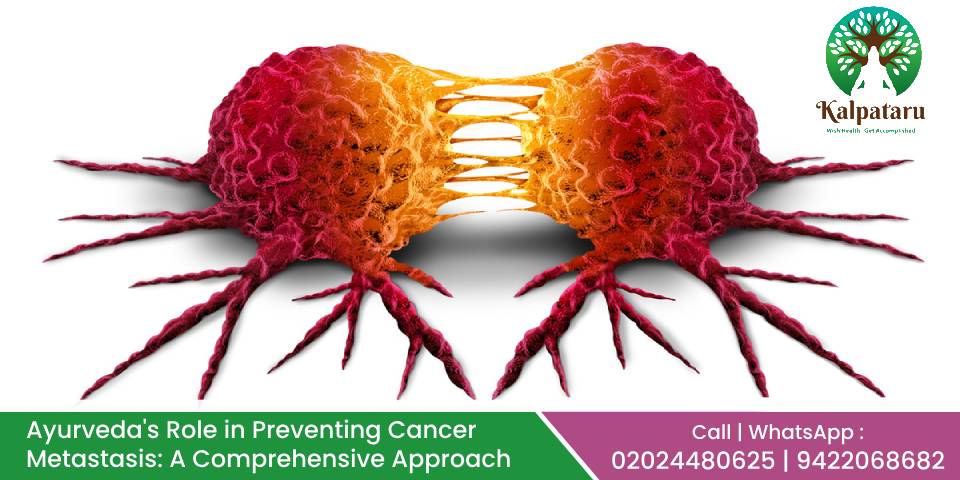
08Sep
Ayurveda’s Role in Preventing Cancer Metastasis: A Comprehensive Approach
Cancer, a dreaded disease that affects millions of lives worldwide, presents an enormous challenge to medical science. While modern medicine has made significant strides in cancer treatment, the prevention of metastasis remains a formidable task. Metastasis occurs when cancer cells spread from the primary tumor to other parts of the body, leading to more severe and often incurable forms of the disease. In this blog, we will explore how Ayurveda, with its holistic approach to health and well-being, can play a vital role in preventing cancer metastasis. Understanding Cancer Metastasis: Metastasis is the process by which cancer cells travel through the bloodstream or lymphatic system to other parts of the body, where they form secondary tumors. This ability of cancer to spread makes it a deadly disease. Preventing metastasis is crucial for improving cancer outcomes and increasing the chances of successful treatment. Prevalence of Cancer in India: Cancer is a significant public health concern in India, with an increasing incidence over the years.According to the Indian Council of Medical Research (ICMR), the estimated number of new cancer cases in India is projected to reach around 13.9 lakh (1.39 million) by 2025. Metastatic Cancer Cases: Metastatic cancer refers to cancer that has spread from its primary site to other parts of the body. Metastasis is a common occurrence in many types of cancer, and it often signifies an advanced stage of the disease. Common Types of Metastatic Cancers: Breast cancer, lung cancer, colorectal cancer, prostate cancer, and stomach cancer are some of the common cancer types known to metastasize . Ayurvedic Approach to Preventing Metastasis: Ayurveda, an ancient system of medicine originating in India, takes a holistic approach to health and emphasizes the balance of the body, mind, and spirit. When it comes to preventing cancer metastasis, Ayurveda offers several valuable insights and approaches:Dietary Modifications: Ayurveda recognizes the importance of diet in maintaining overall health and preventing diseases, including cancer. Ayurvedic dietary recommendations aim to strengthen the immune system and reduce inflammation, which can help prevent the spread of cancer cells. At Kalpataru Ayurvediya Chikitsalaya™, some dietary foodstuffs are advised to stop for avoiding metastatic changes. These include dairy products, sweet food stuff, bakery items, deep-fried food items, and food prepared with preservatives. Patients are encouraged to consume freshly prepared food at home that too in moderate quantities.Herbal Remedies: Ayurveda employs a wide range of herbs and botanicals with known anti-inflammatory, antioxidant, and immune-boosting properties. These herbs can be incorporated into treatment plans to support cancer patients and potentially inhibit the metastatic process. Herbs such as Guduchi, Marich, Tulasi, and Turmeric posses antineoplastic, selective cytotoxic, and anti-angiogenesis properties which in turn obstruct the metastasis pathway in the body.Detoxification: Ayurvedic therapies such as Panchakarma like mrudu virechan, nasy, and Matra basti focus on detoxifying the body, removing toxins, and restoring balance. Detoxification can enhance the body's natural defenses against cancer and reduce the risk of metastasis. Patients are encouraged to join support groups. Having some hobbies or enjoying laughter is of great use.Yoga and Meditation: Stress is a known factor that can promote the progression of cancer. Ayurveda recommends practices like yoga and meditation to reduce stress and improve overall well-being, thereby indirectly aiding in the prevention of metastasis. There are several research papers showing relation between meditation and increased immunity. Immunity is the key point in avoiding metastasisLifestyle Changes: Ayurveda encourages patients to make lifestyle changes that support their overall health. This includes getting regular exercise, maintaining a healthy sleep schedule, and managing stress.Individualized Treatment: Ayurveda recognizes that every person is unique, and the treatment approach should be tailored to each individual's constitution and specific health needs. This personalized approach can address the underlying causes of cancer and its potential to metastasize.Long-Term Wellness: Ayurveda is not just about treating diseases; it's about promoting long-term wellness and preventing illnesses. Patients who follow Ayurvedic principles often experience improved vitality and resilience, reducing the risk of cancer recurrence and metastasis. For more information and treatment modalities watch our informative video https://www.youtube.com/watch?v=eE56i6kxdGY&t=10s Conclusion: Preventing metastasis in cancer is a complex and challenging task, but Ayurveda's holistic approach to health and well-being offers valuable tools and insights in this battle. The personalized care and expertise provided by clinics like Kalpataru Ayurvediya Chikitsalaya™ in Pune, PCMC, and Navi Mumbai ensure that patients receive comprehensive Ayurvedic treatments tailored to their specific needs. By embracing Ayurveda alongside conventional cancer treatments, individuals can enhance their chances of preventing metastasis and achieving better overall health and quality of life. Remember, while Ayurveda can be a supportive element in cancer care, it should always be integrated with the guidance of qualified medical professionals.At Kalpataru Ayurvediya Chikitsalaya™ many cancer patients do consult us after completing their primary treatment by means of Chemo and radiation. We have succeeded in preventing metastasis in those patients in future. They are enjoying a quality life after taking ayurvedic management.
Read More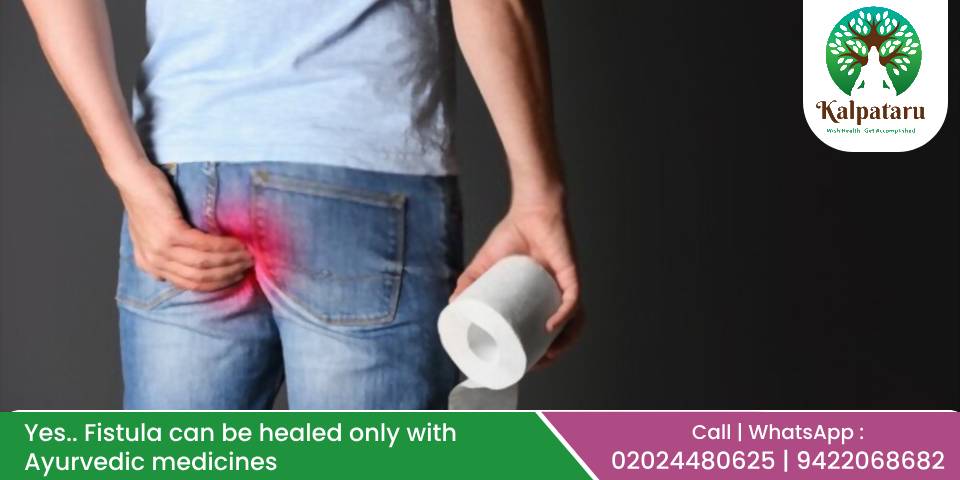
02Sep
Healing Anal Fistula Naturally: Ayurvedic Approaches and Remedies
Are you or a loved one grappling with the discomfort and pain of Fistula in Ano? Seeking an alternative, holistic approach to healing? Look no further. In this blog, we will delve into the world of Ayurveda and explore natural remedies and treatments for Fistula in Ano, while highlighting the expertise of Kalpataru Ayurvediya Chikitsalaya™ in Pune.Fistula in Ano is a painful condition where an abnormal tunnel forms between the anal canal and the skin near the anus. It can cause discomfort, discharge, and recurrent infections. Conventional treatments often involve surgery, but Ayurveda offers a natural and holistic approach to address this issue. Anal Fistula can be categorized into different types based on doshic imbalances: Shataponaka: This type is associated with Vata dominance. Excessive consumption of dry, astringent, spicy, and pungent foods can lead to the formation of boils in the anal region.Ushtragreeva: Dominated by Pitta dosha, this type is triggered by the intake of spicy and hot substances. It results in blood-filled or oozing blisters around the anus with a distinctive smell.Parisraavi: Kapha dosha predominance characterizes this type. Intake of cold beverages and oily foods can aggravate Kapha dosha, leading to the formation of larger, stable boils that mature gradually and discharge pus with mild pain.Shambookavarta: In this type, all three doshas (Vata, Pitta, and Kapha) are aggravated, resulting in the formation of multicolored blisters around the anal region.Unmargi: This type is typically caused by external factors like injury or pricks from objects like needles or nails. Small abrasions in the perianal region worsen due to poor dietary habits. Causes of Anal Fistula: Anal fistula often develops as a consequence of prior abscesses, infections, or trauma in the anal area. Chronic discharge of pus or stool from the skin opening can contribute to its formation. Other factors that may lead to anal fistula include Crohn's Disease, Inflammatory Bowel Disease, cancer, diverticulum disease, radiotherapy, and tuberculosis. Symptoms of Anal Fistula: Anal fistula presents several distressing symptoms, including:Persistent throbbing pain, especially aggravated while sitting.Discharge of pus and blood.Constipation or pain during bowel movements.Fever. For more information and treatment modalities watch our informative video https://www.youtube.com/watch?v=GUdDjtdUp5A&t=3shttps://www.youtube.com/watch?v=1rEjmAZLK2E&t=13s Ayurvedic Remedies for Anal Fistula at Kalpataru Ayurvediya Chikitsalaya™ Kalpataru Ayurvediya Chikitsalaya™, a renowned Ayurvedic clinic in Pune, offers effective herbal remedies for natural treatment of anal fistula. Their Fistula Care Pack comprises meticulously prepared herbal remedies that strictly adhere to Ayurvedic principles. These remedies are:100 percent pure, natural, and herbal,safe to use without causing any side effects.Recurrence inspite of receiving good medication and surgical options is the real concern for many patients of fistula in ano. In Kalpataru Ayurvediya Chikitsalaya™ by means of rasayan , vranshodhan , vranropan chikitsa recurrence is avoided. That too only with oral herbal medication. Uptill now it was the notion that only surgery can treat fistula cases. But this has been proved wrong in Kalpataru Ayurvediya Chikitsalaya™ by giving permanent solutions to so many patients of fistula with only herbal oral medicationThe experienced Ayurvedic doctors, Dr. Manoj Deshpande and Dr. Aparna Deshpande, provide personalized treatment plans for anal fistula patients, focusing on holistic healing and addressing the root cause of the condition rather than just its symptoms.If you're seeking a natural approach to healing anal fistula and achieving optimal health, Kalpataru Ayurvediya Chikitsalaya™ Centre is the trusted choice in Pune. Contact them today to embark on your journey toward a healthier and happier life through the power of Ayurveda.
Read More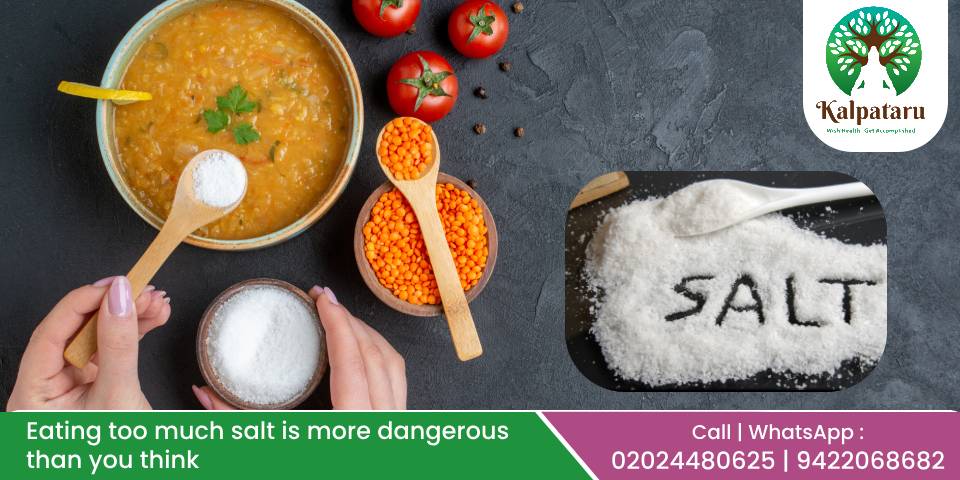
28Aug
Eating too much salt is more dangerous than you think
In the fast-paced world of modern healthcare, ancient traditions like Ayurveda continue to provide timeless insights into maintaining our well-being. Among its many pearls of wisdom, Ayurveda places a significant emphasis on diet and nutrition. One essential aspect is the balance of salt intake for optimal health. In this blog, we delve into the importance of salt in our diet, provide statistical data, highlight potential disadvantages, and offer Ayurvedic tips and precautions to strike the right balance. Understanding the Role of Salt: Salt, or "lavana" in Ayurveda, plays a crucial role in maintaining bodily functions. Sodium, a key component of salt, is essential for nerve transmission, muscle contraction, and maintaining fluid balance. However, like any element, balance is the key. Too much or too little sodium can disrupt the delicate equilibrium in our bodies. Statistical Insights: According to the World Health Organization (WHO), the average global salt consumption is far above the recommended levels. The recommended daily salt intake is around 5 grams (less than a teaspoon), yet the global average is nearly double that amount. Excessive salt intake has been linked to a higher risk of hypertension, cardiovascular diseases, and stroke. In fact, it is estimated that reducing salt intake could prevent millions of deaths each year. Diseases Caused by High Salt Intake: Hypertension: High salt intake is a known contributor to hypertension (high blood pressure). This condition significantly increases the risk of heart diseases, stroke, and kidney problems.Cardiovascular Diseases: Excessive sodium can lead to the narrowing and hardening of arteries, potentially leading to heart attacks and other cardiovascular complications.Stroke: High blood pressure resulting from excessive salt consumption can increase the risk of stroke, which occurs when blood supply to the brain is compromised.Kidney Issues: The kidneys play a crucial role in regulating sodium levels. Too much salt can strain the kidneys, leading to reduced function over time. Ayurvedic Tips for Balanced Salt Intake: Choose Natural Sources: Opt for natural, unprocessed foods that contain moderate levels of salt. Fresh fruits and vegetables, whole grains, and lean proteins are excellent choices.Herbal Alternatives: Ayurveda offers various herbs and spices that enhance flavor without the need for excessive salt. Turmeric, cumin, coriander, and fennel can be great alternatives.Mindful Cooking: During meal preparation, use minimal salt and let individuals adjust the seasoning according to their taste. This prevents over-salting.Hydration: Drinking adequate water helps flush out excess sodium from the body, maintaining a healthy balance. Precautions to Keep in Mind: Read Labels: Be vigilant about reading food labels. Many processed foods contain hidden sodium.Limit Processed Foods: Highly processed foods like chips, canned soups, and instant noodles often contain excessive salt. Limit their consumption.Moderation is Key: While salt is necessary, moderation is crucial. A little goes a long way in terms of flavor and bodily functions. For more information and treatment modalities watch our informative video https://www.youtube.com/watch?v=elPXnQc-cV8&t=102s Conclusion: Ayurveda's emphasis on maintaining balance in all aspects of life extends to our dietary choices. Balancing salt intake is not just about flavor; it's about nurturing our bodies for optimal health. By incorporating Ayurvedic wisdom, along with modern scientific insights, we can make informed choices that support our well-being. Remember, health is a journey, and each step towards a balanced life is a step towards holistic wellness, supported by clinics like Kalpataru Ayurvediya Chikitsalaya™.Ayurveda widely describes some hazardous effects of consuming salt( Lawan taste) in excess quantity as follows - Skin and hair diseases, amlpitta( hyperacidity), inflammation, rakt dushti, loss of virility and sperm potency.In short, quantity of salt in daily diet should be minimal.Nowadays, most of the outside food prepared in restaurants is loaded with excess salt just for enhancing taste. So everyone must be vigilant on salt intake on daily basis. Bad effects of excess salt consumption are beyond our thinking.Switching to rock salt in place of regular table salt ( marine source) is a good option .
Read More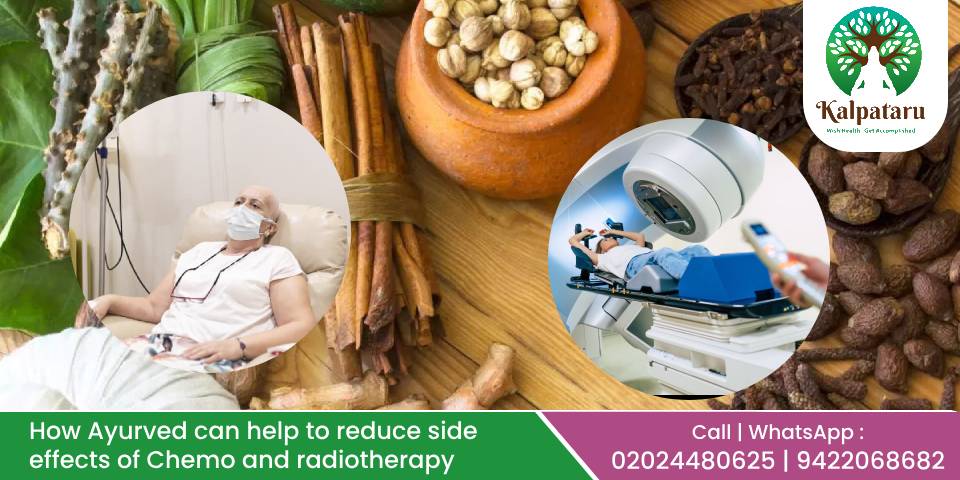
21Aug
How Ayurved can help to reduce side effects of Chemo and radiotherapy
The journey through cancer treatment is undeniably challenging, especially when it involves chemotherapy and radiotherapy. Chemotherapy and radiotherapy are two of the most common therapies for cancer. While they can be useful in killing cancer cells, they can also have several side effects, including nausea, vomiting, fatigue, hair loss, anaemia , constipation, insomnia, mouth sores etc.Ayurveda, the ancient Indian system of medicine, can assist to reduce these side effects and enhance the quality of life for cancer patients. How Does Ayurveda Work? Ayurveda is based on the belief that health is a state of balance between the three doshas: vata, pitta, and kapha. Chemotherapy and radiotherapy can disrupt this balance, leading to side effects. Ayurveda can help to restore harmony by using herbs, diet, and lifestyle changes. Specific Ayurvedic Treatments for Chemotherapy and Radiotherapy Side Effects: Ayurvedic treatments for the side effects of chemo and radiotherapy can aid to restore balance to the doshas and enhance the patient's overall well-being. Some of these treatments include:Herbal medicines: There are several herbs that can help to reduce the side effects of chemo and radiotherapy. These include ginger, turmeric, licorice, Guduchi, Shatavari, Triphala, ashwagandha, aamalaki, chandan, Sariwa, Suwarngairik, kutaki,neemb etc.Diet and Nutrition: A healthy diet is crucial for supporting the body during cancer treatment. Ayurveda places great emphasis on dietary choices tailored to individual doshas. During cancer treatment, the proper diet can significantly influence recovery. Dr. Manoj Deshpande's team at Kalpataru Ayurvediya Chikitsalaya™ designs personalized diet plans that optimize nutrition, strengthen the immune system, and counteract treatment-induced weight loss. Diet is designed in such a way that it boosts immunity and give strength to fight cancer and also helps to avoid metastasis.Yoga and meditation: Yoga and meditation can help to relieve stress, improve sleep, and strengthen the immune system. Patience, positivity and great deal of will power are the most necessary things during cancer treatment. Yoga can surely help to achieve these things by means of various aasanas, pranayam , mudra etc.Panchakarma: Panchakarma is a group of certain Ayurvedic treatments that cleanses the body and removes toxins. It can help reduce the side effects of chemo and radiotherapy. These treatments not only alleviate physical symptoms but also promote emotional well-being. Panchkarm like virechan , basti , raktamokshan, shirodhara may help in various conditions followed by cancer medications.It is critical to note that Ayurveda is not a substitute for traditional cancer treatment. However, it can be a complementary treatment that can help to improve the patient's quality of life. For more information and treatment modalities watch our informative video https://www.youtube.com/watch?v=UFUl8dquJUE Here are some specific examples of how Ayurveda can help to reduce the side effects of chemo and radiotherapy: Nausea and vomiting: Ginger is a well-known cure for nausea and vomiting. It can be taken as a tea, tincture, or capsule.Many ayurvedic medicines are prepared by using ginger.Fatigue: Ashwagandha is an adaptogenic herb that can help to reduce fatigue. It can be taken as a tea, tincture, or tablet.Hair loss: Amla is a fruit that can help to prevent hair loss. It can be taken as a juice, powder, or capsule.Mouth sores: Licorice can aid to soothe mouth sores. It can be taken as a tea or capsule.Many bhasm preparations such as Moti, Suwarn, Vidrum,Makshik, Abhrak are utmost important while tackeling side effects of Chemo and radiotherapy .If you are considering using Ayurveda to help reduce the side effects of chemo and radiotherapy, it is important to talk to your doctor first. They can help you to develop a treatment plan that is safe and useful for you. Here are some additional tips for using Ayurveda to ease the side effects of chemo and radiotherapy: Choose a skilled Ayurvedic practitioner.Make sure that the herbs and supplements that you are taking are safe for you to use.Start with small doses and gradually increase them as tolerated.Monitor your symptoms closely and report any differences to your doctor.Ayurveda can be a good complementary therapy for individuals undergoing chemo and radiotherapy. By working with a skilled Ayurvedic practitioner, you can find methods to reduce the side effects of these treatments and improve your overall well-being. About Kalpataru Ayurvediya Chikitsalaya™: Kalpataru Ayurvediya Chikitsalaya™ is a leading Ayurvedic clinic in Pune, Maharashtra. We have been providing comprehensive Ayurvedic therapies for a variety of conditions, including cancer for over 25 years. Our team of experienced Ayurvedic practitioners Dr. Manoj Deshpande & Dr. Aparna Deshpande can help you to create a personalized treatment plan that is right for you. We are committed to provide our patients with the highest quality of care.If you are considering using Ayurveda to help reduce the side effects of chemo and radiotherapy, we encourage you to contact us. We would be happy to discuss your personal needs and develop a treatment plan that is right for you.Contact us today to learn more about how Ayurveda can help you. Contact Us: To learn more about how Ayurveda can help you to reduce the side effects of chemotherapy and radiotherapy, please contact us today. We would be happy to answer any questions you have and enable you to get started on your journey to better health.
Read More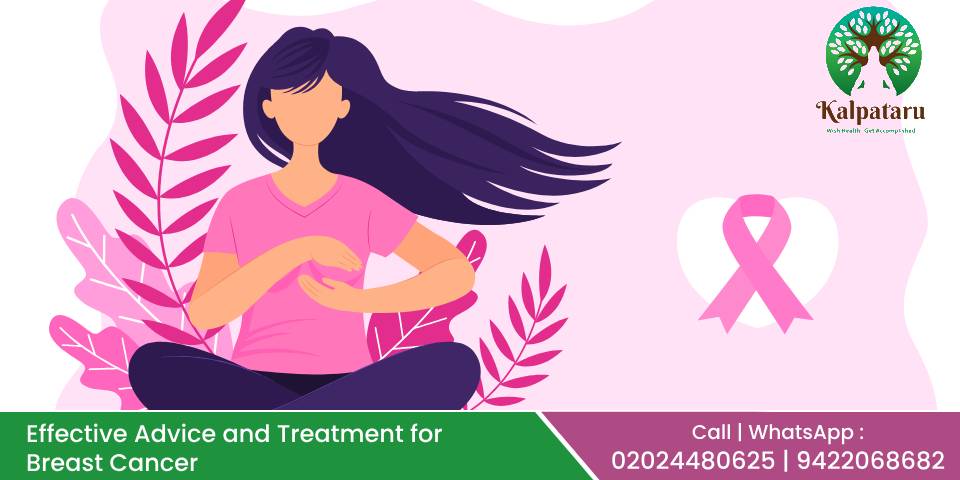
12Aug
Effective Advice and Treatment for Breast Cancer
In the realm of holistic health, Ayurveda has emerged as a beacon of hope and healing. Amid the vast array of health concerns, breast cancer stands as a formidable challenge that affects numerous lives. In India, where Ayurveda has deep historical roots, the Kalpataru Ayurvediya Chikitsalaya™ has been a trusted panacea for individuals seeking comprehensive health solutions. In this blog, we will delve into effective Ayurvedic advice and treatment options for breast cancer, shedding light on this approach's potential benefits. Understanding Breast Cancer and its Statistics in India Breast cancer is a type of cancer that originates in the breast cells, typically forming in the milk ducts or lobules. In India, breast cancer is alarmingly prevalent, with statistics indicating that it is the most common cancer among women. This disease knows no boundaries, affecting both urban and rural populations. Early detection and personalized treatments can significantly impact survival rates. Causes of Breast Cancer The exact causes of breast cancer remain multifaceted, often involving a complex interplay of genetic, hormonal, and environmental factors. While genetics can play a role, lifestyle choices, exposure to toxins, hormonal imbalances, and age are also contributing factors. Identifying Symptoms : Awareness is crucial in the battle against breast cancer. Common symptoms include the presence of a lump or mass in the breast, changes in breast size or shape, pain, tenderness, skin changes, and nipple discharge. Regular self-examinations and clinical screenings are vital for early detection. Self-Check Up : Performing a self-breast examination at home is a simple yet effective way to monitor your breast health. Look for any changes in size, shape, texture, or appearance. If you notice any abnormalities, seek medical attention promptly. Ayurvedic Treatment Options : Boosting Immunity: Ayurveda places great emphasis on strengthening the body's natural defenses. Herbal formulations, balanced nutrition, and a healthy lifestyle can enhance your immunity, aiding your body in combating cancer cells. Chemotherapy Support : Ayurveda offers therapies that can mitigate the side effects of chemotherapy, such as nausea, fatigue, and weakened immunity. Herbal remedies can play a pivotal role in alleviating discomfort. Ojovardhak Therapy : This Ayurvedic therapy focuses on rejuvenating and replenishing the body's vitality. Through specialized treatments and nourishing herbs, Ojovardhak aims to restore energy and vitality, aiding the body's healing process. Lifestyle Changes : Ayurveda underscores the significance of maintaining a balanced lifestyle. This involves adopting a wholesome diet, regular exercise, and adequate sleep to create an environment conducive to healing. Managing Mental Stress : Emotional well-being is paramount. Ayurveda offers mindfulness practices, meditation, and herbal remedies that can alleviate mental stress and promote a positive mindset during the challenging journey of cancer treatment. So many herbs like turmeric, tulasi, vidang, chitrak, bhallatak are proved to have a significant role in halting metastasis which is always a nightmare for patients. So many research papers are available on these topics.Avoiding sugary products, bakery products, refrigerated food, processed food , dairy products is proved to be very useful for avoiding recurrence in cancer. This is our experience at the Best Ayurvedic Clinic in Pune, Maharashtra, Kalpataru Ayurvediya Chikitsalaya™ with several breast cancer patients who are now enjoying disease free state even after 7- 8 years from initial diagnosis . For more information and treatment modalities watch our informative video https://www.youtube.com/watch?v=mpBUStuNTL0 Conclusion: Breast cancer is a battle that demands comprehensive care and a holistic approach. Kalpataru Ayurvediya Chikitsalaya™ has been a beacon of hope in this regard, offering personalized attention and tailored treatments. By combining the wisdom of Ayurveda with modern medical practices, patients can embark on a journey toward healing, armed with increased immunity, reduced side effects, and enhanced well-being. Remember, early detection and a multidimensional treatment strategy are key to overcoming breast cancer's challenges and moving towards a healthier future.
Read More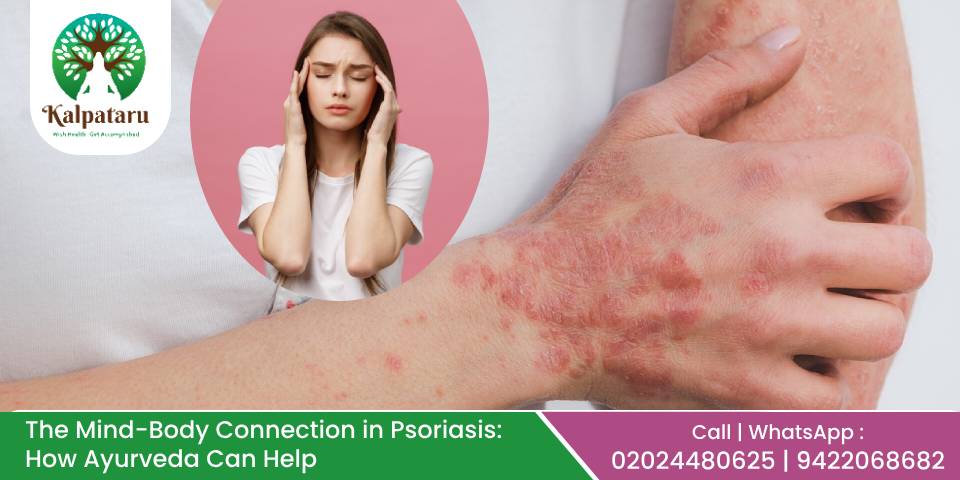
05Aug
The Mind-Body Connection in Psoriasis: How Ayurveda Can Help
Psoriasis is a chronic skin condition that affects approximately 2-3% of the global population. Characterized by red, itchy, and scaly patches on the skin, psoriasis can have a profound impact on a person's physical and emotional well-being. Traditional medicine often treats psoriasis solely as a skin disorder, but recent studies have highlighted the significant role that the mind-body connection plays in its development and management.In this blog, we will explore the mind-body connection in psoriasis and how Ayurveda, an ancient holistic healing system, can offer effective support for those dealing with this condition. What is psoriasis? Psoriasis is an autoimmune skin disorder in which the immune system mistakenly attacks healthy skin cells, causing them to multiply rapidly. This rapid cell turnover leads to the formation of thick, scaly patches that can be painful, itchy, and embarrassing for those affected. The exact cause of psoriasis is not fully understood, but factors like genetics, environmental triggers, and a compromised immune system are believed to play a role. The mind-body connection in psoriasis: Growing evidence suggests that psychological factors, such as stress, anxiety, and depression, can trigger or exacerbate psoriasis flare-ups. Stress can weaken the immune system and cause inflammation, which may aggravate psoriatic symptoms. Moreover, the emotional toll of living with a visible skin condition can lead to a negative impact on self-esteem and overall quality of life.Psoriasis can often be exacerbated by family conflicts, stress, and financial challenges, leading to an increase in its severity. Such factors can play a role in both triggering the condition and worsening its complications. Therefore, effective management of psoriasis necessitates a comprehensive approach that focuses on mitigating mental stress and providing necessary psychological support. Establishing a strong support system within the family is essential in this regard. By implementing these measures, we can better address the impact of external stressors on the disease and promote overall well-being for those affected by psoriasis.Psoriasis is a condition that significantly impacts both the physical and mental well-being of patients, leading to disruptions in their social lives. Engaging in simple activities like socializing with friends, visiting relatives, or even wearing casual clothing like T-shirts and shorts becomes a challenge for those suffering from psoriasis. The distressing stares and judgments from others further exacerbate their emotional state, causing them to experience feelings of despair. Hence, providing essential psychological support during the treatment of psoriasis becomes of paramount importance to help individuals cope with the challenges posed by this condition. How Ayurveda can help: Ayurveda, an ancient system of medicine originating from India, views health as a balance between the mind, body, and spirit. By addressing the root cause of the disease and not just its symptoms, Ayurveda offers a comprehensive approach to managing psoriasis. Let's explore the Ayurvedic perspective on psoriasis and how it can help restore harmony to the mind and body. Ayurvedic Perspective on Psoriasis: According to Ayurveda, psoriasis is primarily caused by an imbalance of the three doshas - Vata, Pitta, and Kapha. These doshas are the fundamental energies that govern all physiological and psychological functions in the body.Vata: Responsible for movement and circulation.Pitta: Responsible for metabolism and digestion.Kapha: Responsible for structure and lubrication.Imbalances in these doshas can manifest in various ways, including skin disorders like psoriasis. Ayurvedic Treatments for Psoriasis: Get the best ayurvedic treatment for psoriasis:Panchakarma therapy: Panchakarma is a series of detoxification and purification treatments that help remove accumulated toxins from the body. These therapies, including massages, herbal steam baths, and enemas, can be highly beneficial in reducing inflammation and improving skin health.Herbal remedies: Ayurveda utilizes a wide range of herbs with potent anti-inflammatory and immune-modulating properties. Neem, Turmeric, Aloe Vera, Manjistha, Sariwa, Chopchini are some of the herbs commonly used to manage psoriasis symptoms.Yoga and meditation: Stress is a significant trigger for psoriasis flare-ups. Yoga and meditation can help reduce stress, improve immune function, and promote overall well-being. For more information and treatment modalities watch our informative video https://www.youtube.com/watch?v=8yYSJDmRZSw How to incorporate Ayurveda into your psoriasis treatment plan: Consult an experienced Ayurvedic practitioner like Dr. Manoj Deshpande to assess your dosha imbalances and create a personalized treatment plan.Embrace a balanced diet that includes fresh fruits, vegetables, whole grains, and herbal teas while avoiding spicy and oily foods.Shirodhara- in this treatment, medicated oil or buttermilk or decoction is poured on forehead in a systematic manner. During this therapy negative hormones like cortisol are reduced and positive hormones like serotonin and endorphones are released in brain. These hormones are having stress bursting and anti-inflammatory properties.Consider Panchakarma therapy to detoxify your body and reduce inflammation.Incorporate stress-reducing practices like yoga and meditation into your daily routine.Use Ayurvedic herbal remedies, both topically and internally, to support skin health and immune function. Conclusion: Incorporating Ayurveda into your psoriasis treatment plan can offer a holistic and effective approach to managing this chronic skin condition. By addressing the mind-body connection and balancing the doshas, Ayurveda aims to alleviate symptoms and improve the overall quality of life for individuals with psoriasis.
Read More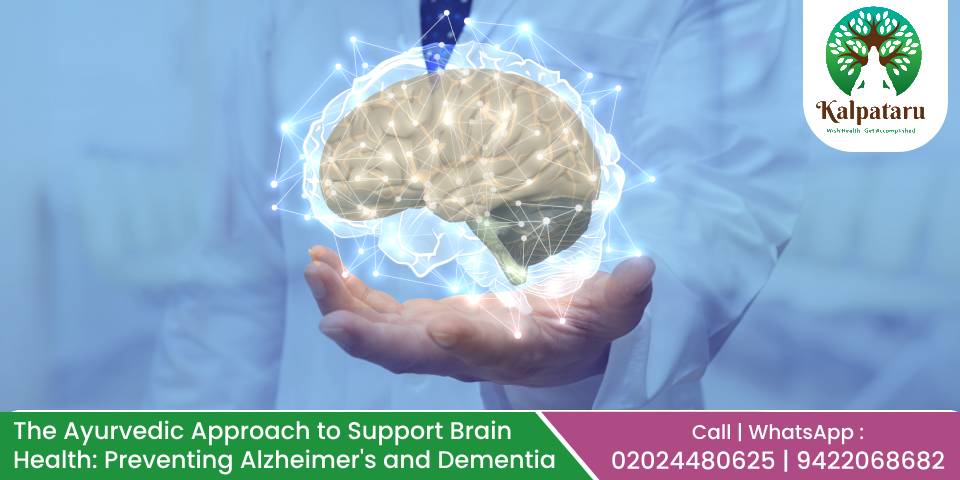
29Jul
The Ayurvedic Approach to Support Brain Health: Preventing Alzheimer’s and Dementia
As we age, one of our primary concerns is sustaining optimal brain health. With the prevalence of neurodegenerative conditions such as Alzheimer's and dementia on the rise, it has become more vital than ever to explore holistic approaches to support and protect our cognitive function. One such time-tested and natural method is Ayurveda, an ancient Indian system of medicine that offers a comprehensive approach to nurturing overall well-being, including brain health. In this blog, we will delve into the Ayurvedic approach to preventing Alzheimer's and dementia and discover how combining these practices into our lives can lead to enhanced brain health and vitality. Important facts and figures about Alzheimer's disease: Alzheimer's disease is the seventh leading cause of death in IndiaAlzheimer's kills more than breast cancer & prostate cancer combined.More than 5 million people in India are living with Alzheimer's diseaseThe cost of caring for people with Alzheimer's disease in India is estimated to be $15 billion per year. This cost is expected to rise to $45 billion by 2050.Alzheimer's and dementia deaths have increased by 16% during the COVID-19 pandemicBy 2050, this number is projected to rise to nearly 14.1 millionThe average age of onset for Alzheimer's disease in India is 65 years old.Women are more likely than men to be diagnosed with Alzheimer's disease in IndiaThe risk of developing Alzheimer's disease increases with age, but it can also occur in younger people.It is the most common cause of dementia in IndiaThe risk of developing Alzheimer's disease is higher in India than in other countries, due to factors such as diabetes, hypertension, and low education levels.There is no cure for Alzheimer's disease, but there are ayurvedic treatments that can help to slow the progression of the disease. Some of the most commonly used Ayurvedic Herbs: Ayurveda believes that a healthy brain is one that is balanced and in harmony with the rest of the body. When the doshas are balanced, the brain is able to work optimally and safeguard itself from damage.There are a number of Ayurvedic herbs that have been shown to have healthful effects on brain health. Some of the most well-known include:Brahmi (Bacopa monnieri): This herb is known for its memory-boosting and anti-stress outcomes.Ashwagandha (Withania somnifera): This adaptogenic herb can assist to enhance cognitive function and decrease stress.Gotu kola (Centella Asiatica): This herb has been shown to enhance circulation and memory.Turmeric (Curcuma longa): This spice has strong antioxidant and anti-inflammatory properties that can aid to protect the brain from damage. Ayurvedic Techniques for Brain Health: Eating a healthy diet: Ayurvedic practitioners believe that the food we eat has a direct effect on our brain health. They suggest eating a diet that is rich in fruits, vegetables, whole grains, and healthy fats. These foods provide the nutrients that the brain requires to function at its best.Managing stress: Stress can have a negative influence on brain health. Ayurveda recommends finding healthy ways to address stress, such as yoga, meditation, and spending time in nature.Getting enough sleep: Sleep is crucial for brain health. When we don't get adequate sleep, our brains don't have a chance to rest and restore themselves. Ayurveda advises getting 7-8 hours of sleep per night.Meditation and Yoga: Regular exercise in meditation and yoga can significantly decrease stress, which is a known factor in brain health decline. Both techniques promote relaxation, improve focus, and improve brain plasticity.Oil Massage (Abhyanga): Regular oil massages, mainly with sesame and coconut oil, not only promote relaxation but also help promote nerve function and enhance blood circulation to the brain.Brain Exercises: Engaging in puzzles, memory games, and activities that challenge the brain can assist keep it sharp and active.* Shirodhara is a very wonderful tool from Ayurveda that can minimise detoriation of dementia to a large extent. Nasya( Nasal administration of some herbal oil is also indicated in ayurveda for neurological ailments .Ayurveda offers a holistic approach to brain health that can help to prevent Alzheimer's and dementia. By following the principles of Ayurveda, you can help to keep your brain healthy and sharp as you age. For more information and treatment modalities watch our informative video https://www.youtube.com/watch?v=0uZbGeUYqwI Here are some additional tips for supporting brain health with Ayurveda: Practice mindfulness: Mindfulness is the technique of paying awareness to the present moment without judgment. This can assist to relieve stress and enhance focus.Spend time in nature: Spending time in nature has been shown to have a number of advantages for brain health, including decreasing stress and enhancing cognitive function.Connect with others: Social interaction is important for brain health. Staying connected with friends and family can aid to keep your mind sharp and active.Learn something new: Learning new things can help to keep your brain active and engaged. This could involve taking a class, reading a book, or learning a new skill.Socialize: Social interaction is vital for brain health. Staying connected with friends and family can aid to relieve stress, improve mood, and boost cognitive function.Give back: Volunteering or giving back to your community can also be beneficial for brain health. This can assist to ease stress, enhance mood, and give you a sense of purpose.By following these tips, you can help to support your brain health and decrease your risk of Alzheimer's and dementia. Conclusion: As we notice an alarming rise in neurological disorders worldwide, adopting traditional approaches like Ayurveda becomes imperative in our journey to maintain brain health and prevent disorders like Alzheimer's and dementia. Our Ayurvedic Doctor in Pune, Maharashtra, Dr. Manoj Deshpande expertise in Ayurveda emphasizes the importance of lifestyle changes, dietary changes, and herbal supplements in promoting brain health. By combining these Ayurvedic principles into our lives, we take a significant step towards nurturing our minds and leading fulfilling, cognitively vibrant lives. Remember, consulting a qualified Ayurvedic Doctor in Pune is crucial to tailor treatments based on individual needs, ensuring optimal brain health and overall well-being.
Read More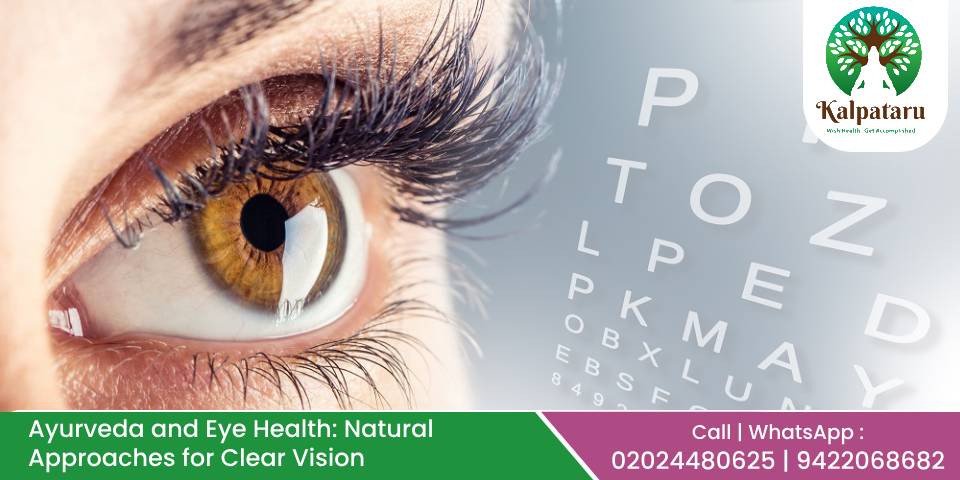
15Jul
Ayurveda and Eye Health: Natural Approaches for Clear Vision
In today's digital age, our eyes are constantly exposed to scree, TVs, pollution, and other environmental factors that can strain and impact their health. While modern medicine offers effective treatments for various eye conditions, Ayurveda, an ancient holistic healing system from India, provides valuable insights and natural remedies for maintaining and improving eye health. Ayurveda focuses on achieving balance and harmony in the body, mind, and spirit, and its principles can be applied to support healthy vision. In this blog, we will explore Ayurvedic practices and remedies that promote eye health and offer natural solutions for common eye problems. Understanding Ayurvedic Principles: Ayurveda views the eyes as a window to the soul and considers them a reflection of one's overall health. According to Ayurveda, eye problems occur due to imbalances in the doshas, which are the three fundamental energies in the body: Vata, Pitta, and Kapha. Each dosha governs specific functions and qualities, and an imbalance can lead to different eye disorders. Ayurveda aims to restore balance by identifying the root cause of the problem and addressing it holistically. Ayurvedic Practices for Eye Health: Netra Tarpana (Eye Rejuvenation): Netra Tarpana is a nourishing therapy that involves filling a dough well around the eyes with warm, medicated ghee (clarified butter). This process helps lubricate the eyes, reduces dryness, and improves vision. This is a very simple yet very effective remedy to tackle problems arised to prolonged exposure to blue rays derived from electronic gadgets. Symptoms like pain in the eye, dryness, itching in the eyes is reduced to a large extent after performing Netra tarpan an eye soothing therapy.Eye Exercises: Ayurveda suggests various eye exercises to strengthen eye muscles, improve blood circulation, and reduce strain. These exercises include palming (covering the eyes with palms), blinking, rotational eye movements, and focusing on distant and nearby objects alternately.Triphala Eye Wash( Netra Dhavan): Triphala, a traditional Ayurvedic formulation made from three fruits (amla, haritaki, and bibhitaki), is known for its antioxidant and anti-inflammatory properties. Using a Triphala eye wash can help cleanse the eyes, relieve redness, and soothe irritation.*Padabhyang- Foot massage is very soothing helpful to tackle some eye complaints.Ayurvedic Diet: A balanced diet plays a vital role in maintaining overall health, including eye health. Ayurveda recommends including foods rich in vitamin A (carrots, spinach, sweet potatoes), omega-3 fatty acids (fatty fish, flaxseeds, chia seeds), and antioxidants (berries, green leafy vegetables) to support healthy vision.Herbal Supplements: Ayurveda utilizes a range of herbal supplements that promote eye health. Herbs like Amla (Indian gooseberry), Saffron, Triphala, Jyeshthmadh, Manjishtha, Haritaki erc are known for their beneficial effects on the eyes. These supplements may help improve vision, reduce inflammation, and protect against age-related eye disorders.Lifestyle Adjustments: Ayurveda emphasizes the importance of lifestyle habits in maintaining eye health. This includes avoiding excessive screen time, taking regular breaks during prolonged visual tasks, protecting the eyes from harsh sunlight and environmental pollutants, and ensuring sufficient sleep and rest. For more information and treatment modalities watch our informative video https://www.youtube.com/watch?v=B5oRswlu170 How Kalpataru Ayurvediya Chikitsalaya™ Can Help? Kalpataru Ayurvediya Chikitsalaya™, led by Dr. Manoj Deshpande and Dr. Aparna Deshpande, offers comprehensive Ayurvedic treatments for various ailments. With over 26 years of experience, they provide personalized care and tailored treatment plans for conditions like Psoriasis, Piles & fissure, eczema, spondylosis, cancer, leucoderma, kidney stone, urticaria, arthritis, and more. Their holistic approach focuses on addressing the root cause of the problem using natural and herbal medicines, ensuring optimal therapeutic benefits without harmful side effects. Patients can trust in their expertise and experience for effective Ayurvedic solutions. Summary: Ayurveda offers a holistic approach to eye health by focusing on restoring balance and harmony within the body. By incorporating Ayurvedic practices, herbal remedies, and lifestyle adjustments, we can nurture our eyes and promote clear vision. However, it's essential to consult a qualified Ayurvedic practitioner before initiating any new treatments or remedies, especially if you have pre-existing eye conditions. Remember, maintaining good eye health is not limited to a single approach; it requires a comprehensive lifestyle that prioritizes self-care, mindful practices, and a balanced approach to overall well-being.
Read More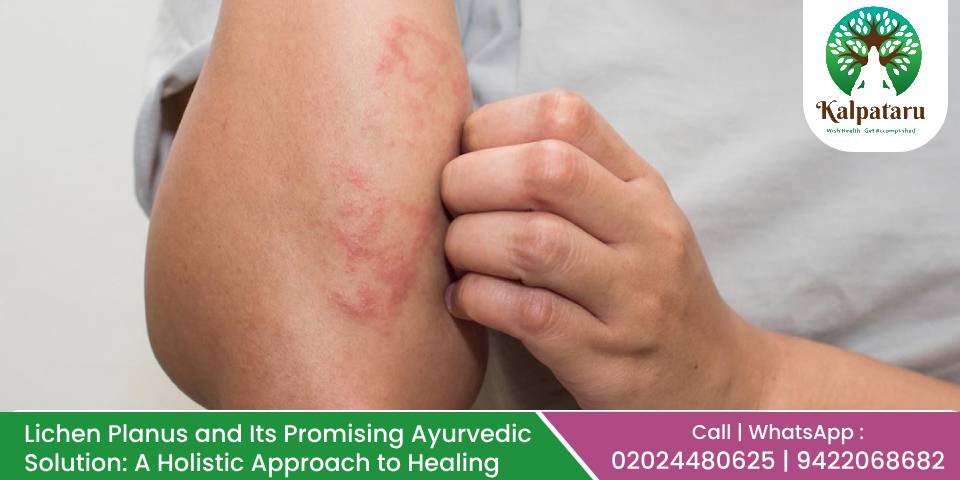
07Jul
Lichen Planus and Its Promising Ayurvedic Solution: A Holistic Approach to Healing
Lichen planus is a chronic inflammatory skin condition that affects millions of individuals worldwide. It is characterized by the appearance of itchy, flat-topped, purplish bumps or lesions on the skin, mucous membranes, scalp, and nails. While the exact cause of lichen planus remains unknown, it is believed to be an autoimmune disorder that occurs when the immune system mistakenly attacks healthy cells.In the pursuit of effective remedies for lichen planus, Ayurveda has emerged as a promising holistic approach that aims to address the root cause of the condition and provide long-lasting relief. Kalpataru Ayurvediya Chikitsalaya™, with its renowned Ayurvedic doctors, Dr. Manoj Deshpande and Dr. Aparna Deshpande, has established itself as a trusted destination for individuals seeking comprehensive and reliable Ayurvedic solutions. Understanding Lichen Planus in Ayurveda: According to Ayurveda, lichen planus is classified as a "Kushtha"( In ayurvedic terminology every skin disease is broadly called as kustha)disorder, primarily associated with an imbalance of the "Pitta" and "Vata" doshas. The accumulation of toxins, known as "Ama," weakens the immune system and disrupts the body's natural equilibrium, leading to the manifestation of skin lesions and other symptoms. Ayurvedic Treatment Approach: Detoxification and Purification (Panchakarma): Panchakarma, a cornerstone of Ayurvedic therapy, involves the systematic removal of toxins from the body. The treatment includes procedures like Virechana (therapeutic purgation) and Vamana (therapeutic emesis) to eliminate Ama and restore the balance of doshas. These processes not only help in the detoxification of the body but also rejuvenate the immune system.Herbal Medications: Ayurvedic herbs play a vital role in managing lichen planus. The experienced Ayurvedic doctors at Kalpataru Ayurvediya Chikitsalaya™ prescribe herbal formulations tailored to individual needs. Some commonly used herbs for lichen planus include Neem (Azadirachta indica), Giloy (Tinospora cordifolia), Turmeric (Curcuma longa), Manjistha etc. These herbs possess anti-inflammatory, immunomodulatory, and skin-healing properties, providing relief from itching, reducing inflammation, and promoting the regeneration of healthy skin cells.Diet and Lifestyle Modifications: Ayurveda emphasizes the importance of a balanced diet and lifestyle modifications in managing lichen planus. Patients are advised to avoid spicy, sour, and fried foods, as well as alcohol and tobacco. Instead, they are encouraged to consume fresh fruits, vegetables, and whole grains. Additionally, stress management techniques such as yoga, meditation, and regular exercise are recommended to promote overall well-being and support the healing process.External Therapies: External therapies are an integral part of Ayurvedic treatment for lichen planus. Local application of medicated oils, ointments, and pastes can help soothe the skin, reduce itching, and promote the healing of lesions. Panchakarma procedures like "Takradhara" (pouring medicated buttermilk) and "Avagaha Swedana" (herbal steam baths) are also beneficial in providing symptomatic relief. For more information and treatment modalities watch our informative video https://www.youtube.com/watch?v=8NHCbCeor0Y&t=2s Conclusion: Lichen planus can be a distressing condition, but Ayurveda offers a promising holistic solution that goes beyond mere symptom management. The approach of Kalpataru Ayurvediya Chikitsalaya™, guided by the expertise of Dr. Manoj Deshpande and Dr.Aparna Deshpande, focuses on addressing the underlying imbalances in the body, detoxification, and promoting overall well-being. By combining personalized Ayurvedic treatments, herbal medications, diet modifications, and lifestyle adjustments, patients can experience significant relief from the symptoms of lichen planus and support the healing process.It is important to note that Ayurvedic treatments should be undertaken under the guidance and supervision of qualified Ayurvedic doctors, as they have the knowledge and expertise to tailor treatment plans according to individual needs. If you or someone you know is struggling with lichen planus, consider exploring the holistic approach of Ayurveda and consulting with experienced Ayurvedic practitioners to find a personalized solution that works best for you.Remember, Ayurveda aims not only to alleviate the symptoms but also to promote overall well-being and restore balance to the body, mind, and spirit. With the right guidance and dedication, lichen planus can be managed effectively, allowing individuals to regain control of their health and lead a fulfilling life.Final tips- Dietary management like restricting dairy products, bakery products, junk food is of utmost importance. With holistic management by ayurveda, we can stop the need of consuming steroids on local and systemic use.
Read More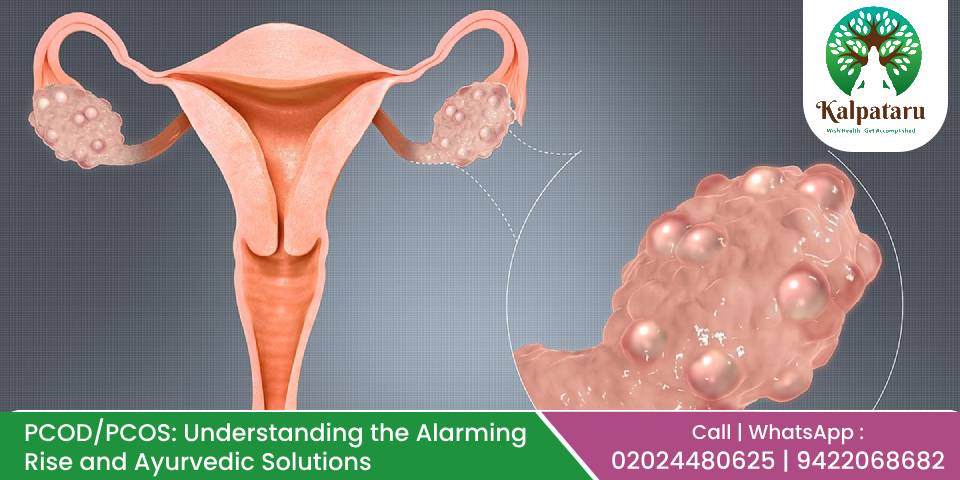
29Jun
PCOD/PCOS: Understanding the Alarming Rise and Ayurvedic Solutions
Polycystic Ovary Syndrome (PCOS) sometimes synonymly known as Polycystic Ovary Disease (PCOD), is a hormonal disorder and metabolic disorder affecting a significant number of women worldwide. This condition has been on the rise at an alarming speed in recent years, posing a serious health concern. In this blog, we will explore why PCOD/PCOS is becoming increasingly prevalent and how Ayurveda, with its holistic approach, offers effective solutions to manage and alleviate the symptoms. At Kalpataru Ayurvediya Chikitsalaya™, renowned Ayurvedic doctors Dr. Manoj Deshpande and Dr. Aparna Deshpande have successfully treated numerous PCOD/PCOS patients, providing hope and relief. Understanding PCOD/PCOS: PCOD/PCOS is a complex endocrine disorder characterized by hormonal imbalances, irregular menstrual cycles, multiple cysts in the ovaries, and symptoms like weight gain, acne, excessive hair growth( hirsuitism), and infertility. While the exact cause of PCOD & PCOS remains elusive, several factors contribute to its prevalence. Factors contributing to the rise of PCOD/PCOS: Sedentary Lifestyle: The modern sedentary lifestyle, with long hours of sitting and lack of physical activity, plays a significant role in the increase of PCOD/PCOS cases. Lack of exercise affects hormonal balance, metabolism, and insulin resistance.Stress and Poor Sleep: Stress has become an unavoidable part of today's fast-paced life. High-stress levels and inadequate sleep disrupt the delicate hormonal balance in the body, leading to PCOD/PCOS.Unhealthy Dietary Habits: Consumption of processed foods, sugary treats, refined carbohydrates, and unhealthy fats contributes to weight gain and hormonal imbalances, exacerbating PCOD/PCOS symptoms. Ayurvedic Perspective on PCOD/PCOS: Ayurveda, the ancient holistic healing system, offers profound insights into the causes and treatment of PCOD/PCOS. According to Ayurveda, PCOD/PCOS occurs due to an imbalance in the doshas (energetic forces) Vata, Pitta, and Kapha. The root cause lies in impaired digestion and metabolism, leading to the accumulation of toxins (ama) and disturbance in the reproductive system. Ayurvedic Treatment for PCOD/PCOS at Kalpataru Ayurvediya Chikitsalaya™: At Kalpataru Ayurvediya Chikitsalaya™, Dr. Manoj Deshpande and Dr. Aparna Deshpande have extensive experience in treating PCOD/PCOS patients using Ayurvedic principles and natural therapies. Their personalized treatment plans aim to address the underlying imbalances and restore harmony to the body.Panchakarma Detoxification: Panchakarma therapies, including Virechana (therapeutic purgation), Vamana (therapeutic vomiting), and Basti (medicated enema), help eliminate toxins, restore hormonal balance, and rejuvenate the body.Herbal Medicines: The doctors prescribe customized herbal formulations such as kantiprabha, aarogywardhini, Jingi sharadi etc. to regulate hormones, improve metabolism, and promote healthy ovarian function. These natural remedies have no harmful side effects and support the body's healing process.Diet and Lifestyle Modifications: A crucial aspect of Ayurvedic treatment for PCOD/PCOS involves adopting a healthy diet and lifestyle. The doctors at Kalpataru Ayurvediya Chikitsalaya™ provide dietary guidelines, stress management techniques, and recommend regular exercise to manage weight, improve hormonal balance, and reduce symptoms. For more information and treatment modalities watch our informative video https://www.youtube.com/watch?v=mUY49M1wwOU Summary: The rising prevalence of PCOD or PCOS calls for attention and effective solutions. Ayurveda, with its holistic approach, provides a ray of hope for those struggling with this hormonal disorder. At Kalpataru Ayurvediya Chikitsalaya™, under the expert guidance of Dr. Manoj Deshpande and Dr. Aparna Deshpande, patients can find comprehensive Ayurvedic treatments that address the root cause of PCOD/PCOS, helping them restore hormonal balance, manage symptoms, and enhance overall well-being. Embrace the wisdom of Ayurveda and embark on a journey towards a healthier, happier life!
Read More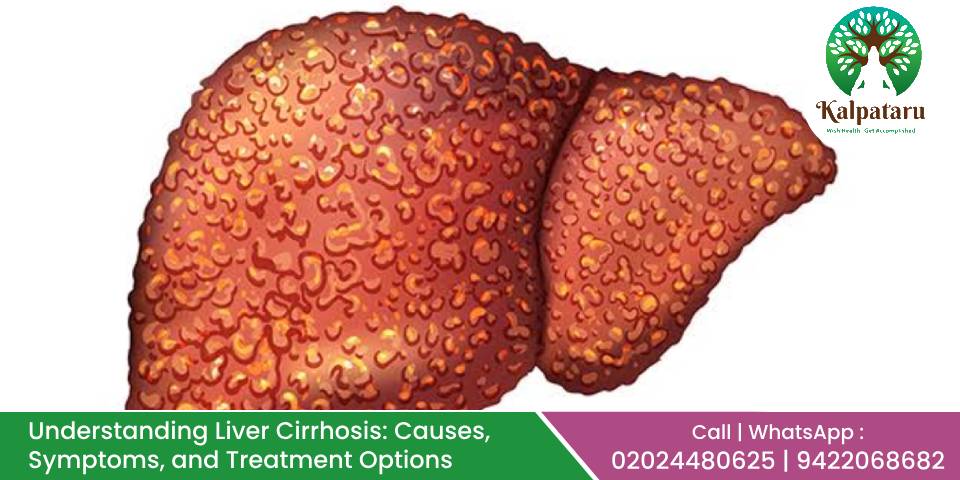
19Jun
Understanding Liver Cirrhosis: Causes, Symptoms, and Treatment Options
Liver cirrhosis is a serious disorder characterized by progressive scarring of the liver tissue, leading to impaired liver function. While conventional medicine provides several treatment options, Ayurveda, the ancient Indian system of medicine, offers holistic approaches to managing liver cirrhosis. In this blog, we will explore the causes, symptoms, risk factors, and diagnosis of liver cirrhosis, as well as delve into Ayurvedic treatments that can support liver health and promote overall well-being. What is Liver cirrhosis? Liver cirrhosis is a chronic and progressive liver disease characterized by the scarring and damage of liver tissue. In cirrhosis, healthy liver cells are gradually replaced by scar tissue, which disrupts the normal structure and function of the liver. Over time, this scarring can impede the liver's ability to perform its essential functions, leading to serious complications. Causes of Liver Cirrhosis: Liver cirrhosis can develop due to various factors, including: Chronic alcohol abuse: Extreme and prolonged alcohol consumption can harm liver cells, leading to inflammation and scarring. Viral infections: Chronic viral hepatitis B or C infections can cause liver inflammation and subsequent cirrhosis. Non-alcoholic fatty liver disease (NAFLD): Accumulation of fat in the liver, often associated with obesity, insulin resistance, and metabolic syndrome, can move to cirrhosis. Autoimmune diseases: Certain autoimmune conditions, such as autoimmune hepatitis, can trigger chronic liver inflammation, eventually leading to cirrhosis. Genetic disorders: Hereditary disorders like Wilson's disease and hemochromatosis can disrupt liver function and contribute to cirrhosis. Symptoms of Liver Cirrhosis: Liver cirrhosis may exemplify the following symptoms: Fatigue and weakness Jaundice (yellowing of the skin and eyes) Abdominal pain and swelling Nausea and loss of appetite Weight loss Easy bruising and bleeding Itchy skin Fluid retention and swelling in the legs (edema) Mental confusion and forgetfulness Risk Factors for Liver Cirrhosis: Certain factors improve the risk of developing liver cirrhosis, including: Chronic alcohol abuse Chronic viral hepatitis B or C infection Obesity and unhealthy lifestyle Diabetes and metabolic syndrome Family history of liver disorder Exposure to certain toxins and chemicals Long-term use of certain medicines Age (cirrhosis becomes more common as people age) Diagnosis of Liver Cirrhosis: Healthcare professionals employ various diagnostic procedures to confirm liver cirrhosis, including: Medical history and physical examination: Evaluating signs and risk factors, along with a detailed examination of the abdomen and other relevant areas. Blood tests: Assessing liver function, measuring levels of liver enzymes, and bilirubin, and evaluating for viral hepatitis markers. Imaging tests: Ultrasound, computed tomography (CT) scan, or magnetic resonance imaging (MRI) can provide detailed images of the liver, identifying cirrhosis and associated complications. Liver biopsy: A small tissue sample is taken from the liver for microscopic examination, allowing for an accurate diagnosis and assessment of liver damage. How Kalpataru Ayurvediya Chikitsalaya™ Ayurvedic Doctors Treat Liver Cirrhosis? Kalpataru Ayurvediya Chikitsalaya™ is a well-known Ayurvedic clinic in Pune, Maharashtra that specializes in providing holistic healthcare solutions, including the treatment of liver cirrhosis. The clinic follows traditional Ayurvedic principles and offers personalized treatment strategies tailored to each patient's unique needs & the professional Ayurvedic Dr. Manoj Deshpande follows a comprehensive method to manage and alleviate the signs of liver cirrhosis and improve overall liver health. Here's an overview of how Ayurvedic doctors at Kalpataru Ayurvediya Chikitsalaya™ approach the treatment of liver cirrhosis include: Herbal remedies: Ayurvedic Dr. Manoj Deshpande often prescribes specific herbal formulations or medications to support liver function and promote liver health. These formulations may contain herbs like Kutki (Picrorhiza kurroa), Punarnava (Boerhavia diffusa), Bhumyamalaki (Phyllanthus niruri), Falatrikadi and Arogyavardhini Vati. These herbs are believed to have hepatoprotective properties and can help detoxify and rejuvenate the liver. Diet and Lifestyle Modifications: Ayurvedic Dr. Manoj Deshpande emphasize the importance of a balanced diet and lifestyle modifications in managing liver cirrhosis. Dietary advice may include avoiding alcohol, spicy and oily foods, and processed or fried foods. Instead, a diet rich in fresh fruits, vegetables, whole grains, and lean proteins may be recommended. Lifestyle changes may include regular exercise, stress management methods, and maintaining a healthy weight. Panchakarma: Panchakarma, a purification and detoxification treatment in Ayurveda, may be used to support liver health in patients with liver cirrhosis. Panchakarma treatments like Virechana (therapeutic purgation) and Basti (medicated enema) may be used to destroy toxins, improve digestion, and restore balance to the body. Yoga and Breathing Exercises: Certain yoga asanas (postures) and pranayama (breathing exercises) may be recommended to improve liver function, ease stress, and promote overall well-being. Practices like Bhujangasana (cobra pose), Dhanurasana (bow pose), and Kapalabhati (skull-shining breath) can be beneficial. Ayurvedic Medications: Ayurvedic Dr. Manoj Deshpande may prescribe specific medicines or formulations to address the underlying causes and signs of liver cirrhosis. These medicines are usually tailored to the individual's constitution and condition. Ayurvedic formulations: Certain Ayurvedic formulations like Punarnavadi kashay, Triphala, and Arogyavardhini Vati are commonly used to sustain liver function and help in managing liver disorders. If you or someone you know is seeking treatment for liver cirrhosis, consult with a qualified Ayurvedic doctor or healthcare professional for a thorough evaluation and personalized treatment approach Conclusion: Liver cirrhosis is a serious condition that requires appropriate medical care and lifestyle changes. Ayurveda offers a holistic approach to support liver health, combining herbal remedies, dietary changes, detoxification therapies, and stress management techniques. If you or someone you know is dealing with liver cirrhosis, it is essential to consult with the best Ayurvedic Doctor in Pune, Maharashtra, to develop a comprehensive treatment plan tailored to individual needs. Remember, early detection, proper management, and a holistic approach can contribute to a better quality of life for individuals with liver cirrhosis. Timely taken treatment with proper guidance of expert ayurved physician can help you to avoid need of liver transplant in future for having serious progressive liver cirrhosis.
Read More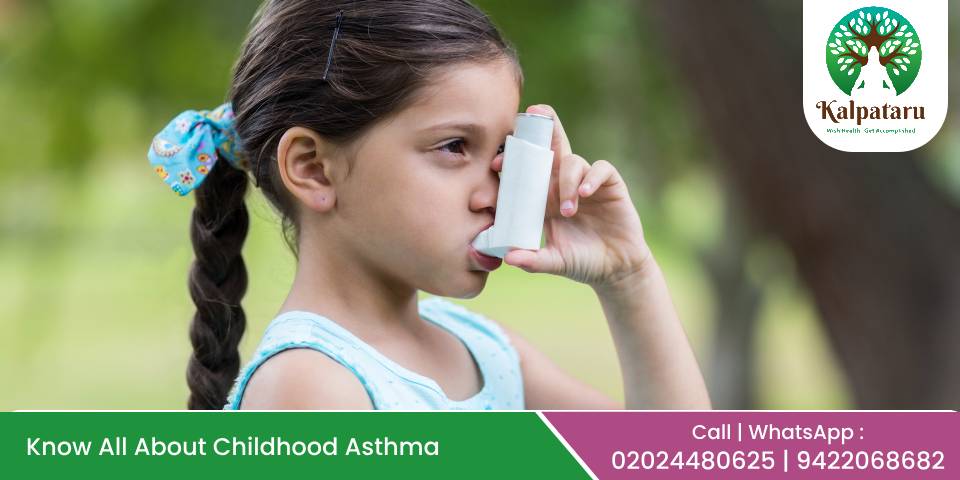
12Jun
Know All About Childhood Asthma
What is Childhood Asthma? Childhood asthma is a chronic respiratory condition characterized by inflammation and narrowing of the airways, leading to recurrent episodes of wheezing, coughing, shortness of breath, and chest tightness in children. It is one of the most common chronic diseases in childhood, affecting millions of children worldwide. It can cause significant distress and impact a child's quality of life. However, this disorder can be treated and managed successfully with Ayurveda! Ayurveda, an ancient Indian system of medicine, offers a holistic and natural approach to managing childhood asthma. In this blog, we will explore the causes, symptoms, and diagnosis of childhood asthma, along with Ayurvedic treatment for Childhood Asthma that can help alleviate its effects. What are the causes of Childhood Asthma? The exact causes of childhood asthma are not fully understood. Here are some factors that are known to contribute to the development of childhood asthma: Genetic predisposition Allergens: Allergens such as dust mites, pollen, mold, pet dander, and certain foods can trigger asthma symptoms Environmental triggers Respiratory infections Premature birth Obesity Hygiene Hypothesis Sensitive immune system Weather changes & cold air What are the symptoms of Childhood Asthma? Identifying the symptoms of childhood asthma is crucial for early intervention and effective management. Some common symptoms include: Recurrent wheezing: A high-pitched whistling sound during breathing, especially during exhalation. Frequent coughing: Mostly at night or in response to physical activity, cold air, or exposure to triggers. Shortness of breath: Children may experience difficulty catching their breath or complain of chest tightness. Chest congestion: A sense of heaviness or pressure in the chest due to excess mucus production. Fatigue and reduced stamina: Asthma can cause fatigue and limit a child's ability to participate in physical activities. If your child exhibits any of these symptoms, it is important to consult an Ayurveda specialist in Pune for a proper evaluation and diagnosis. How to Diagnosis of Childhood Asthma? The diagnosis of childhood asthma involves a combination of medical history, physical examination, and lung function tests. Here are the steps typically involved in diagnosing childhood asthma: Medical History: Dr. Manoj Deshpande will ask questions about the child's symptoms, including the frequency, duration, and triggers of coughing, wheezing, shortness of breath, and chest tightness. They will also inquire about any family history of asthma or allergies, as well as the child's medical history, including past respiratory infections or hospitalizations. Physical Examination: The doctor may listen for wheezing sounds in the lungs and evaluate overall respiratory health. Lung Function Tests: Spirometry and peak flow meter tests assess lung function and measure the amount of air a child can exhale forcefully. Monitoring symptoms: Keeping a record of symptoms, their frequency, and triggers can assist in diagnosis and treatment planning. Other Tests: Additional tests may be ordered to rule out other conditions that can cause similar symptoms, such as chest X-rays, allergy testing, or blood tests. How Kalpataru Ayurvediya Chikitsalaya™ Ayurvedic Doctors Treat Childhood Asthma? Kalpataru Ayurvediya Chikitsalaya™ is a renowned Ayurvedic clinic in Pune, Maharashtra that specializes in providing holistic healthcare solutions, including the treatment of childhood asthma. The clinic follows traditional Ayurvedic principles and offers personalized treatment plans tailored to each child's unique needs & the experienced Ayurvedic Dr. Manoj Deshpande follows a comprehensive approach to manage and alleviate the symptoms of asthma in children. Here's an overview of how Ayurvedic doctors at Kalpataru Ayurvediya Chikitsalaya™ approach the treatment of childhood asthma: Comprehensive Consultation: The Ayurvedic doctors at Kalpataru Ayurvediya Chikitsalaya™ begin by conducting a detailed consultation to understand the child's medical history, symptoms, and triggers. This helps them determine the underlying imbalances in the body and customize the treatment accordingly. Prakriti Assessment: Ayurveda believes that each person has a unique constitution or "Prakriti." By determining the child's prakriti, the Ayurvedic doctor can customize the treatment plan to address their specific needs. Herbal remedies: Ayurvedic doctors at Kalpataru Ayurvediya Chikitsalaya™ prescribe herbal medicines like Adhatoda vasica (Vasaka), Glycyrrhiza glabra (Yashtimadhu), and Curcuma longa (Turmeric), Ringani, behads that have anti-inflammatory, bronchodilator, and immune-modulating properties that can help reduce bronchial inflammation and improve breathing and boost the child's immune system. Dietary and Lifestyle Modifications: Kalpataru Ayurvediya Chikitsalaya™ places great emphasis on the role of diet and lifestyle in managing asthma. Doctors provide often provide dietary and lifestyle recommendations to support the management of childhood asthma. This may include avoiding trigger foods, incorporating specific herbs and spices into the diet, practicing breathing exercises (pranayama), and maintaining a healthy lifestyle. Panchakarma Therapy: Panchakarma is a detoxification and rejuvenation therapy in Ayurveda. Depending on the child's condition, the doctors may recommend specific Panchakarma procedures like Vamana (therapeutic vomiting), Virechana (therapeutic purgation), or Nasya (nasal administration of medicines) to eliminate toxins, improve respiratory health, and strengthen the respiratory system. Follow-up and Monitoring: After the initial treatment, regular follow-up sessions are scheduled to monitor the child's progress and make any necessary adjustments to the treatment plan. The Ayurvedic doctors at Kalpataru Ayurvediya Chikitsalaya™ provide ongoing support and guidance to ensure the best possible outcome for the child's asthma management. Conclusion: Childhood asthma can significantly impact a child's quality of life, but with the right approach to treatment, it is possible to manage and alleviate symptoms effectively. Ayurveda offers a holistic approach that addresses the underlying causes of asthma, focusing on restoring balance and promoting overall well-being. Kalpataru Ayurvediya Chikitsalaya™ is a leading Ayurvedic clinic in Pune, India that specializes in Ayurvedic Treatment for Childhood Asthma in Pune, Maharashtra. If your child is struggling with Asthma, consider seeking out the natural and effective treatments offered by Ayurveda and Kalpataru Ayurvediya Chikitsalaya™. For specific information about how Kalpataru Ayurvediya Chikitsalaya™ in Pune treats childhood asthma, it is best to reach out to the clinic directly or visit their website to learn more about their services, treatment approaches, and expertise in pediatric asthma management.
Read More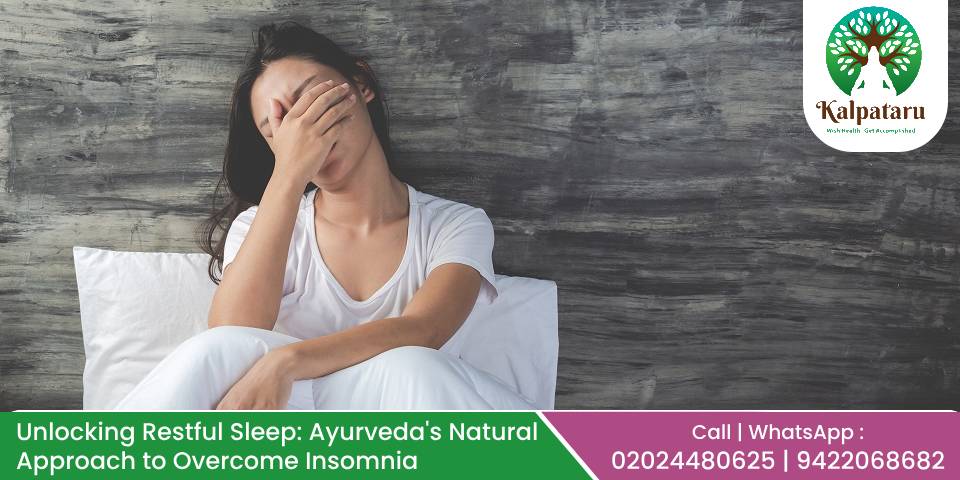
03Jun
Unlocking Restful Sleep: Ayurveda’s Natural Approach to Overcome Insomnia
In today's fast-paced world, sleep has become a precious commodity, and insomnia has become a common struggle for many. The constant battle to fall asleep or stay asleep can have a significant impact on our overall well-being. Fortunately, Ayurveda, the ancient Indian system of medicine, offers a natural and holistic approach to addressing insomnia. In this blog post, we will explore the concept of insomnia, its impact on health, its common causes, and how Ayurveda, with the expertise of Kalpataru Ayurvediya Chikitsalaya, can help unlock restful sleep and rejuvenation. What is Insomnia? Insomnia is a sleep disorder characterized by difficulty falling asleep, staying asleep, or both. It can leave individuals feeling tired, irritable, and unable to function optimally during the day. Lack of restful sleep affects various aspects of our lives, including physical health, mental well-being, and overall quality of life. The Impact of Insomnia on Health: Insomnia can have far-reaching consequences on our health and well-being. It weakens the immune system, impairs cognitive function, contributes to mood disorders, and increases the risk of chronic conditions such as hypertension, diabetes, and obesity and so many ailments. Adequate sleep is crucial for our body's rejuvenation and repair processes, making insomnia a matter of serious concern. Causes of Insomnia: Understanding the causes of insomnia is vital for effective treatment. Common factors include stress, anxiety, irregular sleep schedules, poor sleep hygiene, excessive mental or physical stimulation before bed, and imbalances in the body's energy systems according to Ayurveda - Vata, Pitta, and Kapha doshas. Identifying the underlying causes is essential for developing a personalized treatment plan. Ayurvedic Treatment for Insomnia: Ayurveda provides a holistic and natural approach to address insomnia and promoting restful sleep. At Kalpataru Ayurvediya Chikitsalaya, experienced Ayurvedic doctors utilize time-tested treatments to address the root causes of insomnia. Shirohara- Pouring medicated oil on hirehead in a systematic manner Padabhyang- foot massage with medicated oil or ghee. Shirolep - Applying a paste of some herbal powders. Using some precious herbs having natural sedative and stress bursting properties such as Jatamansi, Brahmi, Shankhpushpi, Tagar etc.
Read More
22May
Understanding Osteoporosis: Ayurvedic Insights and Natural Remedies
Osteoporosis is a common bone disease that affects millions of people worldwide. In this blog, we will delve into the details of osteoporosis from an Ayurvedic perspective and explore natural remedies that can help prevent and manage this condition. We will also introduce Kalpataru Ayurvediya Chikitsalaya™, a renowned Ayurvedic clinic dedicated to promoting holistic health and well-being. What is Osteoporosis? Osteoporosis is a condition characterized by low bone density and structural deterioration of bone tissue, leading to increased fragility and susceptibility to fractures. It often goes unnoticed until a fracture occurs. The word "osteoporosis" originates from the Greek words "osteo" meaning bone and "porosis" meaning porous or brittle. Symptoms of Osteoporosis: Early stages of osteoporosis may not exhibit any noticeable symptoms. However, as the condition progresses, the following symptoms may occur:Back pain caused by collapsed or fractured vertebraeLoss of height over timeFractures that occur easily, even with minor trauma Causes of Osteoporosis: Several factors contribute to the development of osteoporosis. Some of the key causes include:Age: Bone mass naturally decreases as we age, making older adults more susceptible to osteoporosis.Hormonal changes: Women experience a significant decrease in estrogen levels during menopause, which accelerates bone loss.Nutritional deficiencies: Inadequate intake of calcium, vitamin D, and other essential nutrients can weaken bones.Sedentary lifestyle: Lack of exercise and physical activity can lead to decreased bone density.Family history: A family history of osteoporosis increases the risk of developing the condition. Ayurvedic Prevention and Management of Osteoporosis: Ayurveda, the ancient Indian system of medicine, offers valuable insights and natural remedies for preventing and managing osteoporosis. Here are some Ayurvedic approaches to promoting bone health:Balanced Diet: Ayurveda emphasizes the importance of a nutritious diet to maintain bone strength. Including calcium-rich foods like dairy products, leafy greens, sesame seeds, and almonds can help nourish the bones.Herbal Supplements: Ayurvedic herbs like Ashwagandha, Padmkashthsa, egg shell bhasma, Shatavari, and Guggulu, Guduchi are known for their bone-strengthening properties. These herbs can be consumed in the form of powders, capsules, or herbal preparations prescribed by an Ayurvedic practitioner.Panchakarma: Ayurvedic detoxification therapies, such as Panchakarma, can help eliminate toxins from the body, improve digestion, and enhance the absorption of essential nutrients for bone health.Yoga and Exercise: Practicing yoga asanas and engaging in weight-bearing exercises can help improve bone density and overall strength. Specific yoga poses like Tadasana (Mountain Pose) and Vrikshasana (Tree Pose) are beneficial for bone health. For more information and treatment modalities watch our informative video https://www.youtube.com/watch?v=4HjbrUjTv2k When to See a Doctor: While Ayurvedic remedies can be effective in preventing and managing osteoporosis, it is crucial to consult a healthcare professional, especially if you experience the following:Severe or prolonged back painFrequent fractures or bone injuriesSudden height lossAny other concerning symptoms related to bone healthVisit Kalpataru Ayurvediya Chikitsalaya™: Kalpataru Ayurvediya Chikitsalaya™: For those seeking comprehensive and reliable health solutions, Kalpataru Ayurvediya Chikitsalaya™ stands as a trusted name in the field of Ayurveda. With clinics located in Pune, PCMC, and Mumbai, this renowned establishment offers exceptional care and therapeutic interventions for a wide range of health concerns.The success of Kalpataru Ayurvediya Chikitsalaya™ can be attributed to the expertise and dedication of Dr. Manoj Deshpande and Dr. Aparna Deshpande, distinguished Ayurvedic doctors with over 26 years of experience. Their personalized attention and bespoke treatment plans ensure that each patient receives the most suitable care, tailored to their specific medical requirements.In Kalpatru Ayurvediya chikitsalaya™, bone density camps are regularly arranged. Patients having osteopenia or osteoporosis are scrutinized and given special diet and lifestyle plans. Their bone density tests are repeated after 3 to 6 months. In most patients, osteoporosis is found to improve on machine scales.
Read More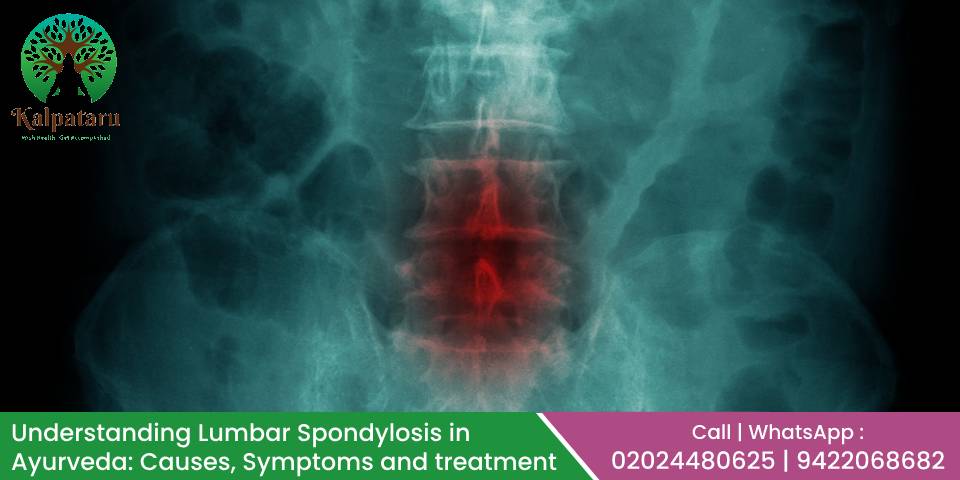
10May
Understanding Lumbar Spondylosis in Ayurveda: Causes, Symptoms and treatment
Lumbar spondylosis is a common medical condition that affects the lower back region. It is caused by degenerative changes in the spine that occur due to aging, lifestyle factors, and various other reasons. Ayurveda, the ancient Indian system of medicine, has a holistic approach for treating lumbar spondylosis. In this blog, we will discuss the causes, symptoms, and treatment of lumbar spondylosis from an Ayurvedic perspective. Causes of Lumbar Spondylosis: In Ayurveda, lumbar spondylosis can be correlated to "Kati Shoola". The condition is caused by an imbalance of the Vata dosha, which is responsible for movement and coordination in the body. When the Vata dosha is aggravated, it causes dryness and stiffness in the joints and muscles of the lower back, leading to lumbar spondylosis.Other causes of lumbar spondylosis in Ayurveda include:Sedentary lifestylePoor postureExcessive physical activityObesityAge-related degenerationLack of proper nutritionPsychological stress Symptoms of Lumbar Spondylosis: The symptoms of lumbar spondylosis include:Lower back painStiffness in the lower backNumbness or tingling sensation in the legsWeakness in the legsDifficulty in walking or standing for long periodsReduced range of motion in the lower backMuscle spasms in the lower back Diagnosis of Lumbar Spondylosis: In Ayurveda, the diagnosis of lumbar spondylosis is based on a comprehensive assessment of the patient's medical history, physical examination, and Ayurvedic pulse diagnosis.During the physical examination, the Ayurvedic doctor will assess the patient's posture, range of motion, and any areas of tenderness or pain in the lower back. The doctor will also use Ayurvedic pulse diagnosis to identify any imbalances in the Vata dosha.In some cases, the doctor may also recommend imaging tests such as X-rays or MRI scans to confirm the diagnosis and rule out any other underlying medical conditions. Treatment of Lumbar Spondylosis in Ayurveda: Ayurvedic treatment for lumbar spondylosis aims to restore the balance of the Vata dosha and promote healing of the affected tissues. The treatment typically includes a combination of Ayurvedic medicines, diet and lifestyle modifications, and therapeutic procedures such as Panchakarma.At Kalpataru Ayurvediya Chikitsalaya™, our team of highly experienced Ayurvedic doctors offers customized treatment plans based on the individual needs of each patient. Our treatments include:Ayurvedic medicines: We prescribe a combination of Ayurvedic medicines that help to reduce inflammation, alleviate pain, and promote tissue healing. These medicines are made from natural herbs and do not cause any side effects.Diet and lifestyle modifications: We provide personalized dietary recommendations and lifestyle modifications that help to reduce the aggravation of the Vata dosha and promote healing of the affected tissues. These modifications include specific foods to avoid and incorporate into the diet, as well as exercises and yoga postures that can help to strengthen the lower back muscles.Panchakarma: We offer Panchakarma, a series of therapeutic procedures that help to detoxify the body, reduce inflammation, and promote healing of the affected tissues. The procedures include Abhyanga, Swedana, Virechana, Basti, and Nasy . Tiktksheer basti made up of Somme bitter herbs, milk and ghee is having wonderful curative property.Herbs having Prithwi mahabhut predominance such as Padmak, Khadir , Mandur bhasma are having potent bone health boosting properties which in turn help heal the spine issues within very short time.If you are experiencing symptoms of lumbar spondylosis, or have a history of back injuries, we encourage you to schedule an appointment with Kalpataru Ayurvediya Chikitsalaya™ to explore the benefits of Ayurvedic treatment. Our team of highly experienced Ayurvedic practitioners is committed to helping patients achieve optimal health and wellness through the power of Ayurveda.If taken sincerely , ayurvedic medicine and therapies can definitely avoid need of surgical intervention especially in case of prolapsed intervertebral disc. For more information and treatment modalities watch our informative video https://www.youtube.com/watch?v=p-0F-ndQVs0&t=1s
Read More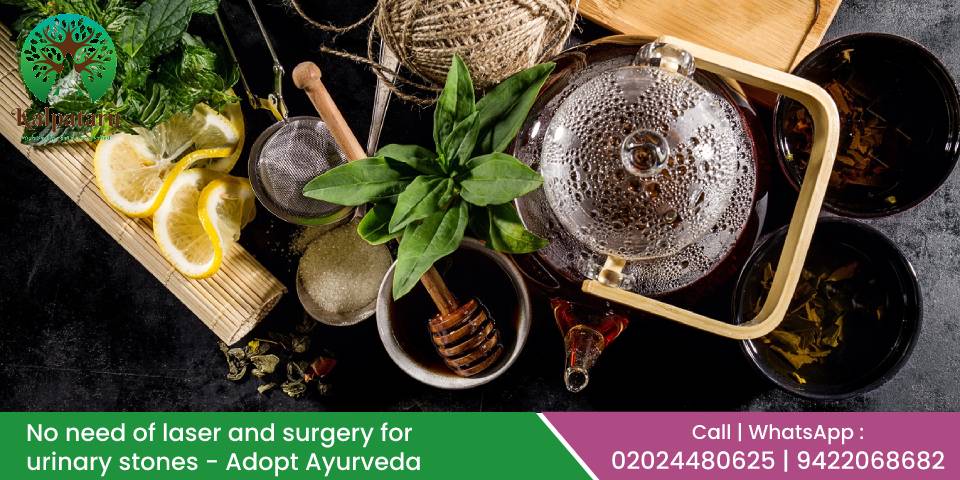
30Apr
No need of laser and surgery for urinary stones – Adopt Ayurveda
Urinary stones, also known as kidney stones or renal calculi, are solid masses made up of crystals that form in the urinary tract. These stones can range in size from a grain of sand to a golf ball and can cause severe pain and discomfort when passing through the urinary system. While surgery and laser treatments are commonly used to remove these stones, Ayurveda offers a natural and effective approach to treating urinary stones without the need for invasive procedures. Causes of Urinary Stones: Urinary stones are formed when certain substances in the urine, such as calcium, oxalate, and uric acid, become concentrated and crystalize. The exact cause of urinary stones is not always clear, but there are several factors that can increase the risk of developing them. These include: Dehydration: Not drinking enough water can lead to concentrated urine, which can increase the risk of urinary stones. Diet: Eating a diet high in salt, sugar, and animal protein can increase the risk of urinary stones. Family history: A family history of urinary stones can increase the risk of developing them. Medical conditions: Certain medical conditions, such as gout and inflammatory bowel disease, can increase the risk of urinary stones. Medications: Some medications, such as diuretics and antacids, can increase the risk of urinary stones. Types of Urinary Stones: There are several types of urinary stones, each with their own unique characteristics. The most common types of urinary stones include: Calcium stones: These are the most common type of urinary stone and are made up of calcium oxalate or calcium phosphate. Uric acid stones: These are formed when the urine is too acidic and can be caused by a diet high in purines. Struvite stones: These are formed in response to an infection in the urinary tract and can grow quickly. Cystine stones: These are rare and are caused by a genetic disorder that causes the kidneys to excrete too much cystine. Risk Factors for Urinary Stones: In addition to the causes and types of urinary stones, there are several risk factors that can increase the likelihood of developing them. These include: Age: The risk of urinary stones increases as a person gets older. Gender: Men are more likely to develop urinary stones than women. Race: Caucasians are more likely to develop urinary stones than people of other races. Obesity: Being overweight or obese can increase the risk of urinary stones. Certain medical conditions: Certain medical conditions, such as diabetes and high blood pressure, can increase the risk of urinary stones. Signs and Symptoms of Urinary Stones: The symptoms of urinary stones can vary depending on the size and location of the stone. Some common signs and symptoms of urinary stones include: Pain: The most common symptom of urinary stones is pain, which can range from mild to severe and may come and go. Nausea and vomiting: Some people with urinary stones may experience nausea and vomiting. Blood in the urine: Urinary stones can cause blood to appear in the urine. Frequent urination: Some people with urinary stones may experience an increased urge to urinate. Difficulty urinating: Urinary stones can make it difficult to urinate, and in some cases, can cause urinary retention. Ayurveda Approach to Urinary Stones: Ayurveda, the ancient Indian system of medicine, offers a natural and effective approach to treating urinary stones. Urinary Stones – Adopt Ayurveda. Ayurvedic treatments focus on balancing the body's doshas, or energies, and using natural remedies to promote overall health and well-being. Some common Ayurvedic treatments for urinary stones include: Herbal remedies: Ayurvedic herbal remedies, such as punarnava, gokshura, and shilajit, kulattha, Varun can be used to dissolve urinary stones and prevent their formation. These herbs work by promoting urine flow, reducing inflammation, and breaking down the crystals that form stones. Diet and lifestyle changes: Adopting a healthy diet and lifestyle can also help prevent urinary stones. Ayurveda recommends drinking adequate quantity of water to stay hydrated, avoiding foods that are high in salt, sugar, and animal protein, and engaging in regular physical activity. Panchakarma: Panchakarma is an Ayurvedic detoxification treatment that involves a series of cleansing and rejuvenating therapies. This treatment can help remove toxins from the body and improve overall health, which can help prevent the formation of urinary stones. Kalpataru Ayurvediya Chikitsalaya™: Kalpataru Ayurvediya Chikitsalaya™ is a renowned Ayurvedic clinic in India that specializes in the treatment of urinary stones and other urological disorders. The clinic is staffed by experienced Ayurvedic doctors and offers a range of natural treatments and therapies that are tailored to each patient's individual needs. Some of the treatments offered at Kalpataru Ayurvediya Chikitsalaya™ include: Herbal remedies: The clinic offers a range of herbal remedies that are specifically formulated to dissolve urinary stones and prevent their formation. Panchakarma: The clinic offers a range of Panchakarma therapies that are designed to detoxify the body and promote overall health. Diet and lifestyle counseling: The doctors at Kalpataru Ayurvediya Chikitsalaya™ provide personalized diet and lifestyle counseling to help patients adopt healthy habits that can prevent the formation of urinary stones. Yoga and meditation: The clinic also offers yoga and meditation classes, which can help reduce stress and promote overall well-being. Summary: Urinary stones are a common condition that can cause severe pain and discomfort. While surgery and laser treatments are commonly used to remove these stones, Ayurveda offers a natural and effective approach to treating urinary stones without the need for invasive procedures. Kalpataru Ayurvediya Chikitsalaya™ is a leading Ayurvedic clinic in India that specializes in the treatment of urinary stones and other urological disorders. If you are struggling with urinary stones, consider seeking out the natural and effective treatments offered by Ayurveda and Kalpataru Ayurvediya Chikitsalaya™.
Read More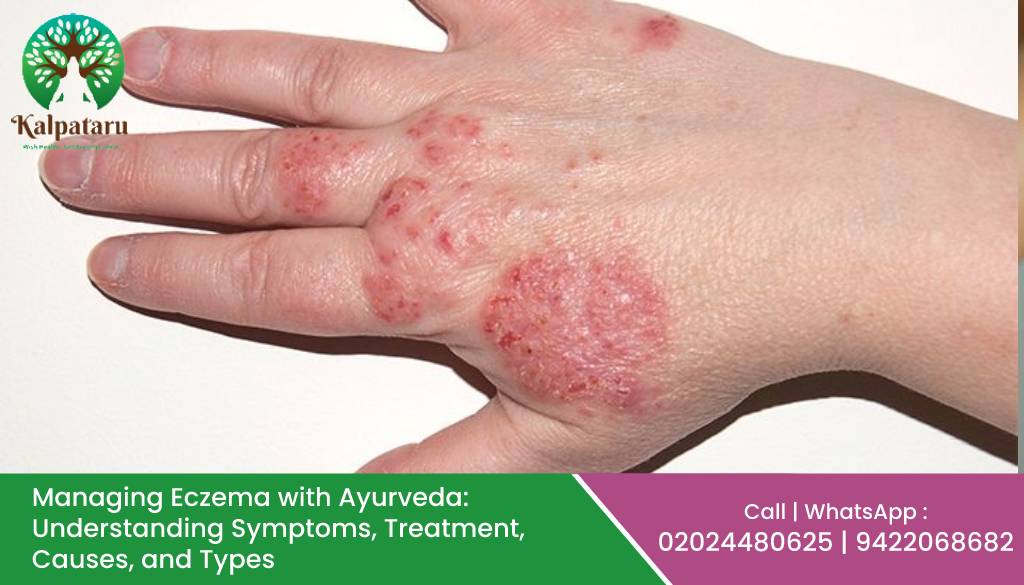
27Apr
Managing Eczema with Ayurveda: Understanding Symptoms, Treatment, Causes, and Types
Eczema, also known as atopic dermatitis, is a chronic skin condition that affects millions of people worldwide. It can cause redness, itching, and scaling of the skin, and can be quite uncomfortable and embarrassing. While there is no cure for eczema, Ayurvedic medicine can help manage the symptoms and prevent flare-ups giving very long-lasting recoveryAt Kalpataru Ayurvediya Chikitsalaya™, we specialize in the treatment of skin disorders like eczema using natural remedies and Ayurvedic principles. In this blog post, we will discuss the symptoms, causes, types, and treatment of eczema from an Ayurvedic perspective. Symptoms of Eczema: Eczema can affect any part of the body but is most common on the hands, feet, face, and scalp. Symptoms may vary from person to person but typically include:Red, inflamed skinDry, scaly patchesIntense itchingCrusty, oozing bumpsThickened, leathery skinThese symptoms can be quite distressing and can affect a person’s quality of life. In some cases, eczema can also lead to secondary infections, which can be even more serious. Causes of Eczema: The exact cause of eczema is unknown, but it is believed to be related to a combination of genetic and environmental factors. Some of the common triggers include:Allergens such as dust mites, pet dander, and pollenIrritants such as soaps, detergents, and harsh chemicalsStress and anxietyHormonal changesCertain foods such as dairy, wheat, and eggs Types of Eczema: There are several different types of eczema, including:Atopic dermatitis: This is the most common type of eczema and often begins in childhood. It can be triggered by allergens and can run in families.Contact dermatitis: This type of eczema is caused by an allergic reaction to an irritant, such as poison ivy, nickel, or certain chemicals.Nummular dermatitis: This type of eczema appears as coin-shaped patches of red, scaly skin.Seborrheic dermatitis: This type of eczema affects the scalp and causes flaking, itching, and redness.Ayurvedic Treatment for Eczema Ayurvedic medicine offers a holistic approach to managing eczema. Our approach is to identify the root cause of the condition and treat it from within, rather than just treating the symptoms on the surface. Some of the Ayurvedic remedies we use for eczema treatment include: Herbal remedies: We use a variety of herbal remedies to help soothe and heal the skin, including neem, aloe vera, turmeric, manjistha,sariva, Trifala, kutki, patol etcDiet and lifestyle changes: We recommend making changes to your diet and lifestyle to help reduce inflammation and boost your immune system. This may include avoiding certain foods, getting regular exercise, and reducing stress.Panchakarma: This is a detoxification process that helps remove toxins from the body and improve overall health. It can be especially helpful for those with chronic skin conditions like eczema. These panchkarmaa include virechan, agnikarma, leech application etcYoga and meditation: These practices can help reduce stress and anxiety, which can trigger eczema flare-ups.At Kalpataru Ayurvediya Chikitsalaya™, we believe that the key to Managing Eczema with Ayurveda is to take a holistic approach to healing. By addressing the root cause of the condition and treating it with natural remedies, we can help you achieve lasting relief from your symptoms.If you’re looking for a natural and effective way to manage your eczema, come see us at Kalpataru Ayurvediya Chikitsalaya™. Our experienced practitioners will work with you to create a personalized treatment plan that addresses your unique needs and goals.If you’re ready to take control of your eczema and improve your quality of life, contact us at Kalpataru Ayurvediya Chikitsalaya™ today. Our team of experienced practitioners is here to help you achieve optimal health and wellness using natural, holistic remedies. For more information and treatment modalities watch our informative video https://youtu.be/xvgmz1g0M_U
Read More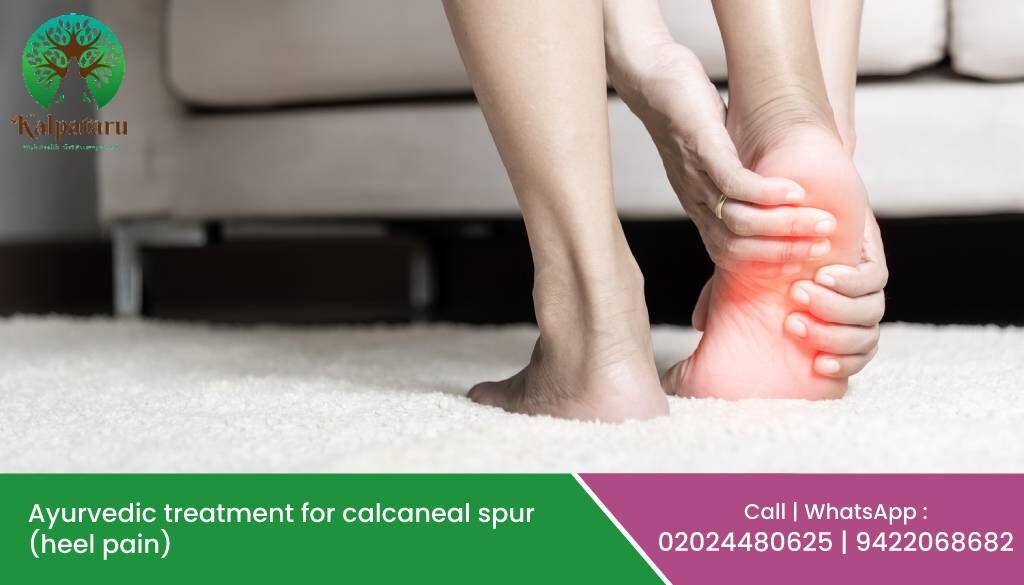
20Apr
ayurvedic treatment for calcaneal spur (heel pain)
Kalpataru Ayurvediya Chikitsalaya™ offers holistic and natural treatment options for various health conditions. One such condition is a calcaneal spur, which can cause immense discomfort and pain in the heel. Dr. Manoj Deshpande is a renowned and experienced Ayurvedic doctor in Pune who offers effective and personalized Ayurvedic treatment for heel pain. WHAT IS CALCANEAL SPUR? A calcaneal spur, also known as a heel spur, is a bony growth that occurs on the underside of the heel bone. It is often associated with plantar fasciitis, a condition that causes inflammation of the plantar fascia, a thick band of tissue that runs along the bottom of the foot. WHAT HAPPENS WITH YOUR FOOT? When you walk or stand, the plantar fascia experiences tension and stress. Over time, this can cause small tears in the tissue, leading to inflammation and pain. The body responds to this by depositing calcium at the site of the injury, which can eventually result in the formation of a calcaneal spur. CAUSATIVE FACTORS FOR CALCANEAL SPUR: There are several factors that can increase the risk of developing calcaneal spur, including:Repeated stress on the heel bone due to walking, running or jumpingPoor foot posture or biomechanicsWearing ill-fitting shoesBeing overweight or obeseCertain medical conditions such as arthritis or diabetes SYMPTOMS: The most common symptom of the calcaneal spur is pain in the heel, especially when walking or standing for long periods. The pain is often described as a sharp, stabbing sensation that can be severe enough to affect daily activities. The first walk after getting up in the morning is often very painful DIAGNOSIS: To diagnose calcaneal spur, a doctor will perform a physical examination of the foot and may also order imaging tests such as X-rays or MRIs. These tests can help confirm the presence of a calcaneal spur and rule out other conditions that may cause similar symptoms. TIPS TO RELIEVE PAIN: Several self-care measures can help relieve pain and discomfort associated with the calcaneal spur, including:Resting the affected foot and avoiding activities that aggravate the painApplying ice packs to the affected area for 10-15 minutes at a time, several times a dayWearing supportive shoes with cushioned soles and good arch supportDoing stretching exercises for the plantar fascia and calf musclesLosing weight if overweight or obese TREATMENT AT KALPATARU AYURVEDIYA CHIKITSALAYA™: Kalpataru Ayurvediya Chikitsalaya™ offers personalized treatment options for calcaneal spur based on the patient’s individual needs and condition. Treatment may include:Ayurvedic medications and herbal formulations to reduce inflammation and painPanchakarma therapies such as Abhyanga, Swedana, and Basti, leech applications detoxify the body and improve circulation* Special procedure known as Agnikarm ( Cauterisation) is a quick fix for heel painSpecific exercises and stretches to strengthen the foot muscles and improve postureDietary and lifestyle modifications to support healing and prevent a recurrenceThe experienced Ayurvedic doctors and therapists at Kalpataru Ayurvediya Chikitsalaya™ work closely with patients to develop a customized treatment plan that addresses the root cause of calcaneal spur and promotes overall health and well-being. For more information and treatment modalities watch our informative video https://www.youtube.com/watch?v=O4qSt-Fy5e4 CONCLUSION: A calcaneal spur can cause significant pain and discomfort, but Ayurveda offers effective and natural treatment options that can provide long-term relief. Kalpataru Ayurvediya Chikitsalaya™ is a renowned Ayurvedic clinic in Pune that offers personalized and holistic treatment for calcaneal spur. With the help of experienced doctors and therapists, patients can find relief from pain and improve their overall health and well-being.If ignored this heel pain can run chronic for years together. So don’t neglect heel pain, don’t just rely on suppressing pain painkillers, but heal it from the root with the wisdom of Ayurveda.
Read More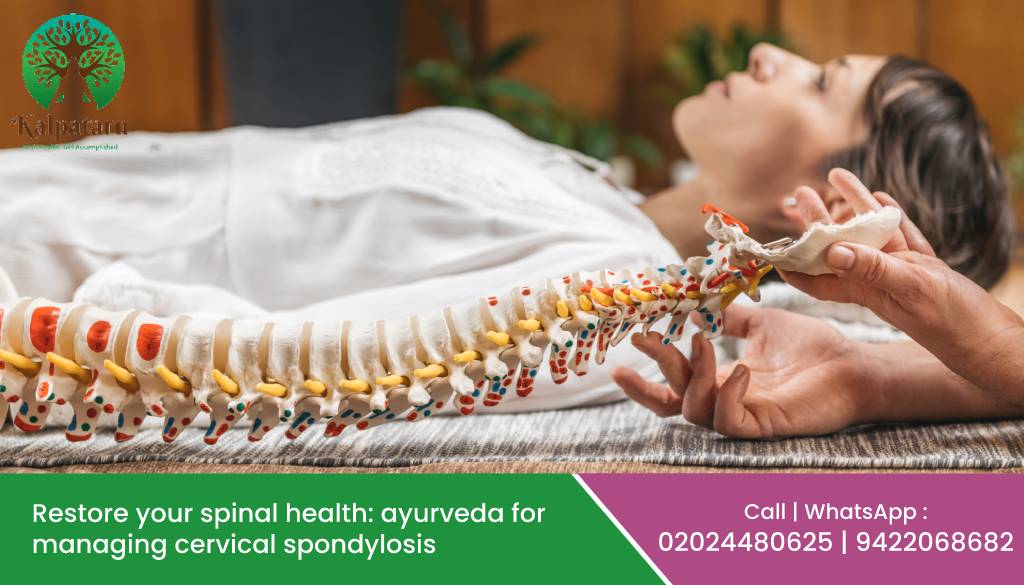
09Apr
restore your spinal health: ayurveda for managing cervical spondylosis
Cervical Spondylosis is a degenerative disorder that affects the cervical spine (neck region) of the body. It is a common condition that occurs due to wear and tear of the bones, cartilage, and discs in the neck, leading to chronic pain, stiffness, and discomfort. While cervical spondylosis can occur at any age, it is more common in older adults.At Kalpataru Ayurvediya Chikitsalaya™ (KAC), we offer effective Ayurvedic treatments and therapies for managing cervical pain and Restore Your Spinal Health. Why Does Cervical Spondylosis Occur? Cervical spondylosis occurs due to degeneration of the cervical spine, which is caused by various factors such as aging, injuries, and lifestyle habits. With aging, the discs in the cervical spine lose water content, causing them to become thinner and less flexible, which can lead to stiffness and pain. Injuries to the neck, such as whiplash or falls, can also cause cervical spondylosis. Poor posture, lack of exercise, and being overweight are other factors that can contribute to this condition. Causes: The causes of cervical spondylosis include:Age-related wear and tear of the cervical spineInjuries to the neck, such as whiplash or fallsPoor posture and lack of exerciseBeing overweight or obeseGenetics Signs & Symptoms: The causes of cervical spondylosis include:Age-related wear and tear of the cervical spineInjuries to the neck, such as whiplash or fallsPoor posture and lack of exerciseBeing overweight or obeseGenetics How Ayurveda can help? Ayurveda offers natural and holistic treatments for managing cervical pain and promoting overall spinal health. At KAC, we offer a range of Ayurvedic treatments and therapies for cervical spondylosis, including:Panchakarma therapy: This therapy involves a series of detoxifying treatments to remove toxins from the body and promote healing. Panchakarma therapy can help reduce inflammation, improve circulation, and promote relaxation.Herbal medicines: Ayurvedic herbs such as padmkashtha, Laksha, Guggulu, and mandir are having anti-inflammatory and pain-relieving properties. They can help reduce inflammation and pain in the neck, promoting healing and reducing discomfort. These herbs strengthen bones and surrounding spinal musclesYoga and meditation: Practicing yoga and meditation can help reduce stress and tension, which can contribute to cervical spondylosis. Yoga can also help improve flexibility and range of motion in the neck.Diet and lifestyle modifications: Eating a healthy and balanced diet, getting regular exercise, and maintaining good posture can help prevent and manage cervical spondylosis. For more information and treatment modalities watch our informative video https://www.youtube.com/watch?v=NvLoIV0skDg Conclusion: Cervical spondylosis is a common condition that can cause chronic neck pain, stiffness, and discomfort. While it can be managed with modern medical treatments, Ayurveda offers natural and holistic treatments that can help promote spinal health and reduce pain and discomfort. At Kalpataru Ayurvediya Chikitsalaya™ (KAC), we offer effective Ayurvedic treatments and therapies for managing cervical pain and promoting overall spinal health. If you are experiencing neck pain or stiffness, contact us today to learn more about our Ayurvedic treatments for cervical spondylosis.At KAC, a novel therapy known as Agnikarm is performed which can save even the need for surgical intervention. Vedhan is another effective treatment modality. Manya Basti is a treatment of choice in cervical spodylisis.
Read More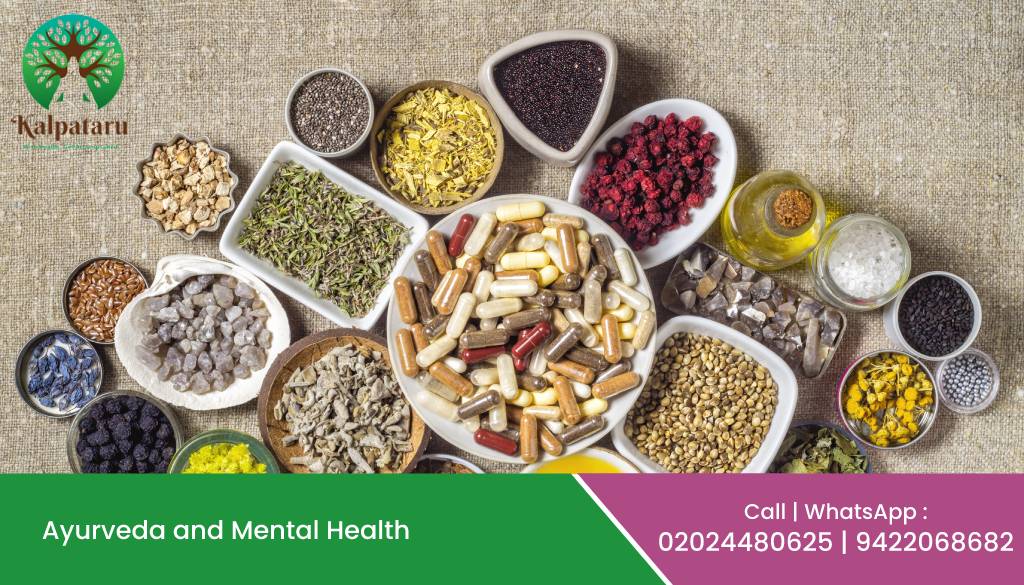
31Mar
Ayurveda and mental health
Ayurveda, the ancient Indian system of medicine, has always placed a strong emphasis on the mind-body connection. According to Ayurveda, mental health is an integral part of overall health, and mental and emotional imbalances can have a significant impact on physical health. Ayurveda recognizes that the mind is composed of three basic qualities or gunas: Sattva, Rajas, and Tamas, and that imbalances in these gunas can lead to mental health problems. In this article, we will explore these gunas and how they relate to mental health. Sattva: The Quality of Purity, Harmony, and Balance Sattva is the highest of the three gunas, and it is associated with qualities such as purity, clarity, balance, and harmony. When we are in a state of Sattva, our minds are clear, our emotions are balanced, and our thoughts are positive. We feel peaceful, content, and in harmony with ourselves and the world around us. Sattva is also associated with spiritual growth and higher consciousness. According to Ayurveda, cultivating Sattva is essential for achieving optimal mental and physical health. Practices such as meditation, yoga, and pranayama can help us cultivate Sattva by quieting the mind, calming the emotions, and increasing self-awareness. Rajas: The Quality of Activity, Passion, and Movement Rajas is the quality of activity, passion, and movement. When Rajas is in balance, we feel energetic, enthusiastic, and motivated. We are able to accomplish our goals and pursue our passions with enthusiasm and vigor. However, when Rajas becomes excessive or unbalanced, it can lead to mental health problems such as anxiety, restlessness, and insomnia. Excessive Rajas can cause the mind to become overactive, leading to racing thoughts, irritability, and impatience. To balance Rajas, Ayurveda recommends practices such as regular exercise, engaging in creative pursuits, and maintaining a healthy daily routine. Tamas: The Quality of Inertia, Darkness, and Inactivity Tamas is the quality of inertia, darkness, and inactivity. When Tamas is in balance, it can be a useful quality, helping us to rest, relax, and rejuvenate. However, when Tamas becomes excessive or unbalanced, it can lead to mental health problems such as depression, lethargy, and a lack of motivation. Excessive Tamas can cause the mind to become dull, leading to a lack of interest in life, apathy, and a sense of hopelessness. To balance Tamas, Ayurveda recommends practices such as regular exercise, spending time in nature, and avoiding foods that are heavy or difficult to digest. Kalpataru Ayurvediya Chikitsalaya™: Enhancing Mental Health Through Ayurveda At Kalpataru Ayurvediya Chikitsalaya™, we are committed to promoting mental health through Ayurveda. Our team of experienced Ayurvedic practitioners can help you identify imbalances in the gunas and develop a personalized treatment plan to restore balance and promote optimal mental health. We offer a range of Ayurvedic treatments and therapies to support mental health, including meditation, yoga, Ayurvedic massage, and herbal remedies. We also provide personalized dietary recommendations and lifestyle advice to help you maintain balance and promote optimal mental health. * Shirodhara- it’s a very unique treatment to calm your stressful mind. In this therapy, lukewarm medicated oil prepared from brahmi, jatamansi, and shankhpushpi is poured on the forehead in a specialized way. This is so soothing that most of the patients fall asleep while undergoing this therapy. Prior to this, whole body and head massage is done. Many psychosomatic diseases like hypertension, insomnia, migraine, etc are well treated with this Shirodhara treatment. * Nasya- in this procedure medicated oil is instilled in the nostrils. This helps reduce many psychological ailments
Read More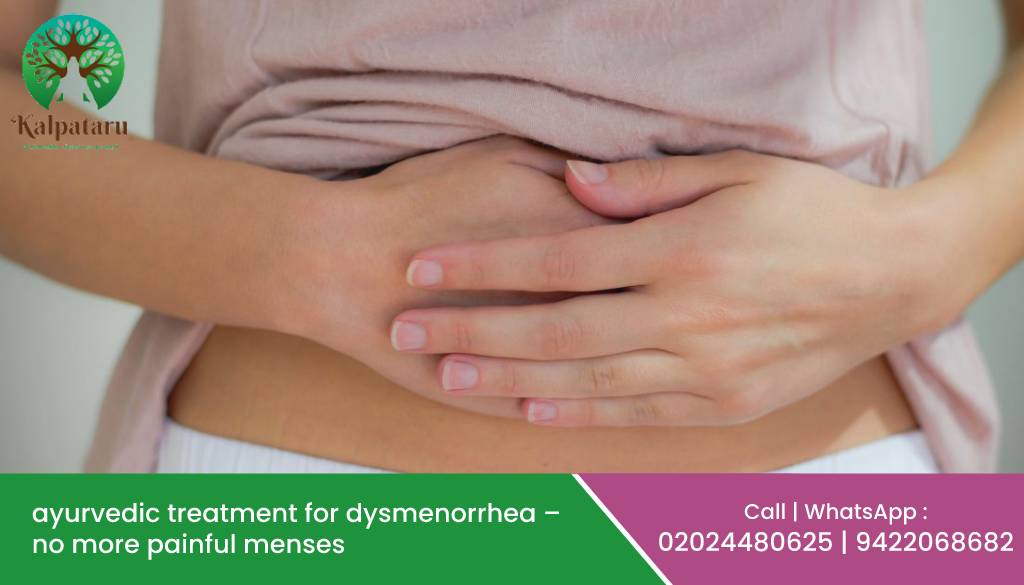
01Mar
Ayurvedic Treatment For Dysmenorrhea – No More Painful menses
Dysmenorrhea, or painful menstruation, is a common condition experienced by many women and girls during their menstrual cycle. It can range from mild discomfort to severe pain and can interfere with daily activities. While conventional medicine offers painkillers and hormonal treatments to manage the symptoms, Ayurveda, the ancient Indian system of medicine, offers a more natural approach to alleviate the symptoms of dysmenorrhea.Ayurveda believes that dysmenorrhea is caused by an imbalance in the three doshas namely Vata, Pitta, and Kapha, which can be corrected by adopting a healthy lifestyle, following a balanced diet, and using natural remedies.Here are some Ayurvedic treatment for dysmenorrhea: Herbal remedies: Ayurveda uses a variety of herbs to treat dysmenorrhea. Some of the commonly used herbs include:Aloe vera, Ashoka, Lodhra, Manjistha, Sariva, Dashmoola, etc. These medicines correct hormonal imbalances. Also, these medicines control derrahnged Vat dosh. Diet: Eating a balanced diet can help prevent dysmenorrhea and reduce its symptoms. Here are some dietary recommendations:Increase your intake of fruits and vegetables: Fruits and vegetables are rich in antioxidants and nutrients that can help reduce inflammation and pain.Reduce your intake of processed foods: Processed foods are high in sugar, salt, and unhealthy fats that can increase inflammation and worsen the symptoms of dysmenorrhea.Include healthy fats in your diet: Healthy fats, such as those found in nuts, seeds, and fatty fish, can help reduce inflammation and pain.Avoid caffeine and alcohol: Caffeine and alcohol can increase inflammation and worsen the symptoms of dysmenorrhea. Lifestyle Changes: Ayurveda recommends adopting healthy lifestyle habits to prevent and manage dysmenorrhea. Here are some lifestyle changes you can make:Exercise regularly: Regular exercise can help improve blood flow and reduce inflammation in the body. Practicing yoga or going for a walk during your menstrual cycle can help alleviate the symptoms of dysmenorrhea.Practice relaxation techniques: Stress can worsen the symptoms of dysmenorrhea. Practicing relaxation techniques such as meditation, deep breathing, and yoga can help reduce stress and alleviate the symptoms of dysmenorrhea.Massage: Massaging the lower abdomen with warm oil can help reduce pain and inflammation in the uterus. Use sesame oil, almond oil, or coconut oil for the massage.Practice good sleep hygiene: Getting enough sleep and following a regular sleep schedule can help reduce stress and improve overall health. Ayurvedic Therapies: Ayurveda offers several therapies that can help alleviate the symptoms of dysmenorrhea. Some of these therapies include:Abhyanga: Abhyanga is an Ayurvedic massage technique that involves applying warm oil to the body. It can help reduce pain and inflammation in the body.Shirodhara: Shirodhara is an Ayurvedic therapy that involves pouring warm oil on the forehead.Basti: in this treatment around 50 ml of lukewarm oil is put inside your body through the anal canal. This process pacifies Vat dosh. According to the Ayurvedic perspective, there is no pain without the aggravation of Vat dosh. Giving basti treatment 5 days prior to M.C. cures dysmenorrhea. For more information and treatment modalities watch our informative video https://www.youtube.com/watch?v=wNzhTFHiICYhttps://www.youtube.com/watch?v=thmBi8831f8 Conclusion: Dysmenorrhea can be a debilitating condition for many women. While conventional medicine offers painkillers and hormonal treatments to manage the symptoms, Ayurveda offers a more natural approach to alleviate the symptoms of dysmenorrhea. By adopting a healthy lifestyle, following a balanced diet, and using natural remedies and therapies, women can alleviate the pain and discomfort associated with dysmenorrhea. However, it’s important to consult with a qualified Ayurvedic practitioner before starting any new treatment regimen, as individualized care is essential in Ayurveda. With the help of Ayurveda, women can find relief from dysmenorrhea and experience a healthier, happier menstrual cycle.A casual approach towards dysmenorrhea is not a good practice as it can lead to many troublesome diseases in the future such as PCOD, obesity, infertility, etc.Consult with Dr. Aparna Deshpande to get your dysmenorrhea cured.
Read More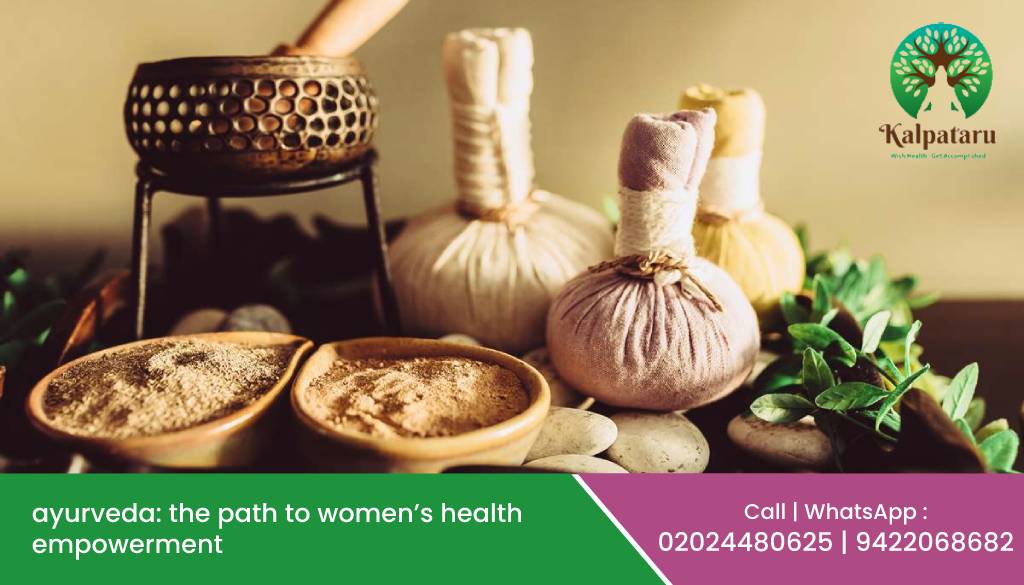
01Mar
Ayurveda: The Path to Women’s Health Empowerment
Ayurveda is not just a system of medicine, it’s a lifestyle that empowers women to achieve optimal health and well-being. With its personalized approach to healthcare and emphasis on self-care, stress reduction, and healthy eating habits, Ayurveda offers women the tools they need to take charge of their lives and thrive. In this blog, we’ll explore how Ayurveda can help women on their journey to greater health empowerment. One of the key principles of Ayurveda is that every person is unique and has their constitution or dosha. There are three doshas in Ayurveda: Vata, Pitta, and Kapha. Understanding your dosha can help you make choices about diet, exercise, and lifestyle that are best for your individual needs. This personalized approach to health can be empowering for women, who may have unique health concerns that require personalized attention. Ayurveda also recognizes the important role that women play in the health of their families and communities. Women are often the primary caregivers in their families and are responsible for maintaining the health and well-being of their loved ones. Ayurveda empowers women by giving them the tools and knowledge they need to take care of themselves and their families. Ayurveda also emphasizes the importance of self-care and stress reduction. Women often face a lot of stress in their lives, whether it is from work, family, or other responsibilities. Ayurvedic practices such as massage, Shirodhara, nasya, and yoga meditation can help women reduce stress and improve their overall well-being. These practices can also help women connect with their inner selves and find a sense of balance and harmony in their lives. Ayurveda also promotes healthy eating habits and encourages women to eat a balanced diet that is tailored to their individual needs. This can be especially important for women who may have unique nutritional needs during different stages of their lives, such as during pregnancy or menopause. Ayurvedic dietary guidelines can help women make choices that support their health and well-being. In addition to promoting physical health, Ayurveda also recognizes the importance of emotional and spiritual health. Women are often expected to be caretakers and may neglect their own emotional needs in the process. Ayurveda encourages women to take time for themselves and engage in activities that promote emotional well-being, such as journaling, spending time in nature, or practicing gratitude. Some Best Practices For Women For Their Daily Routine Ayurveda offers a plethora of practices that women can incorporate into their daily routines to promote optimal health and well-being. Here are some of the best Ayurvedic practices that women can perform daily: Wake up early: Ayurveda recommends waking up before sunrise, which helps align the body’s natural rhythms and promotes overall health. Oil pulling: Swishing coconut or sesame oil in your mouth for a few minutes daily can help remove toxins and promote oral health. Tongue scraping: Scraping the tongue with a copper tongue scraper every morning can help remove toxins and improve digestion. Self-massage: Massaging the body with warm oil before bathing can help improve circulation, reduce stress, and promote overall well-being. Meditation: Practicing meditation for even a few minutes every day can help reduce stress, improve mental clarity, and promote emotional well-being. Yoga: Practicing yoga regularly can help improve flexibility, strength, and balance, and promote overall health and well-being. Drinking herbal tea: Drinking herbal tea in the morning can help stimulate digestion and flush toxins from the body. Mindful eating: Eating mindfully and choosing fresh, whole foods that are in season can help promote optimal digestion and overall health. Undergoing whole body massage with steam bath: this therapy promotes detoxification and helps to increase skin health. It’s a powerful stress buster also Shirodhara ,takradhara: pouring warm oil or medicated burttermilk on forehead after proper head massage gives you very soothing feeling. It helps to minimise negative hormones from your body.So many psycosomatic diseases like hypertension, insomnia, obesity, migraine , hair fall are well controlled by this novel therapy. By incorporating these Ayurvedic practices into your daily routine, you can experience greater health empowerment and overall well-being. Various treatment modalities are available at Kalpataru Ayurvediya chikitsalaya™ for women for her every ailment starting from irregularities in M.C. to menopause Dr. Aparna Deshpande at KAC is in charge of all gynecological cases. Conclusion: Ayurveda offers many benefits for women, including personalized health care, stress reduction, and empowerment. By embracing the principles of Ayurveda, women can take charge of their health and well-being and live happier, healthier lives. Whether you are a busy working mom or a retiree enjoying your golden years, Ayurveda can help you achieve optimal health and wellness.
Read More
24Feb
Ayurvedic Remedies for Digestive Health: Tips for a Healthy Gut
Digestive problems are a typical issue that affects many people. Some of the most common digestive disorders include constipation, diarrhea, bloating, gas, Hyperacidity, colitis, ulcers, gastritis, appendicitis, ulcerative colitis, and stomach cramps. These problems can be caused by a variety of factors, including poor diet, stress, and unhealthy lifestyle choices. Fortunately, Ayurvedic medicine provides useful remedies for improving digestive health and promoting a healthy gut. In this blog, we will discuss Ayurvedic remedies for digestive health, including tips for maintaining a healthy gut. What is Ayurvedic Medicine? Ayurvedic medicine is a holistic system of medicine that originated in India thousands of years ago. It is based on the thought that every person has a unique constitution, which is determined by their dosha. There are three doshas – Vata, Pitta, and Kapha – and each person has a unique combination of these doshas. Ayurvedic medicine aims to restore balance to the doshas and improve overall health. Ayurvedic Remedies for Digestive Health Triphala: Triphala is a popular Ayurvedic remedy for digestive health. It is a combination of three fruits – haritaki, bibhitaki, and amla – that work together to enhance digestion and nurture a healthy gut. Triphala is known for its laxative effect, which can help relieve constipation and promote regular bowel movements. It also helps to improve the absorption of nutrients and reduce inflammation in the digestive tract. Ginger: Ginger is a powerful Ayurvedic remedy for digestive health. It has anti-inflammatory properties that can help reduce inflammation in the digestive tract and improve digestion. Ginger can also help to relieve nausea and vomiting, which are common digestive problems. You can consume ginger in various forms, such as ginger tea, ginger ale, or by adding fresh ginger to your food. Ajwain: Ajwain, also known as carom seeds, is a famous Ayurvedic remedy for digestive health. It has anti-inflammatory and antibacterial properties that can support to improve digestion and reduce inflammation in the digestive tract. Ajwain can also help to relieve gas, bloating, and indigestion. You can consume ajwain in various forms, such as ajwain water or by adding it to your food. Fennel: Fennel is another popular Ayurvedic remedy for digestive health. It has anti-inflammatory and antioxidant properties that can help to improve digestion and reduce inflammation in the digestive tract. Fennel can also help to relieve gas, bloating, and indigestion. You can consume fennel in various forms, such as fennel tea or by adding fennel seeds to your food. Trikatu: Trikatu is a combination of three spices – ginger, black pepper, and long pepper – that are used in Ayurvedic medicine to improve digestion and promote a healthy gut. Trikatu can help to relieve indigestion, bloating, and gas. It can also improve the absorption of nutrients and reduce inflammation in the digestive tract. Suvarna-Gairika: Suvarna-Gairika is a unique Ayurvedic remedy that is made from a blend of gold and red ochre. It is known for its ability to improve digestion and promote overall health. Suvarna-Gairika helps to reduce inflammation in the digestive tract, improve appetite, and relieve constipation. Guduchi: Guduchi, also known as Tinospora cordifolia, is an Ayurvedic herb that is commonly used for digestive health. It helps to reduce inflammation in the digestive tract, improve appetite, and relieve constipation. Guduchi is also known for its immune-boosting properties. Black Resins: Black resins, or shilajit, is an Ayurvedic remedy that is known for its ability to improve digestion and promote overall health. It helps to reduce inflammation in the digestive tract, improve appetite, and relieve constipation. Black resins are also rich in minerals and other nutrients that can support digestive health. Yashtimadhu: Yashtimadhu, or licorice root, is an Ayurvedic herb that is commonly used for digestive health. It helps to reduce inflammation in the digestive tract, improve appetite, and relieve constipation. Yashtimadhu is also known for its soothing and cooling properties, making it helpful for reducing acidity and heartburn. Clove: Clove is a popular Ayurvedic remedy for digestive health. It helps to reduce gas, bloating, and indigestion. Clove is also known for its anti-inflammatory and analgesic properties, making it helpful for reducing pain and inflammation in the digestive tract. Cinnamon: Cinnamon is an Ayurvedic spice that is commonly used for digestive health. It helps to reduce gas, bloating, and indigestion. Cinnamon is also rich in antioxidants, which can help to reduce oxidative stress in the digestive tract. Cardamom: Cardamom is an Ayurvedic spice that is commonly used for digestive health. It helps to reduce gas, bloating, and indigestion. Cardamom is also known for its anti-inflammatory and anti-bacterial properties, making it helpful for reducing inflammation and promoting a healthy digestive environment. Tips for a Healthy Gut: In addition to Ayurvedic remedies, there are several lifestyle changes you can make to promote a healthy gut. Here are some tips: Eat a healthy diet A healthy diet is essential for maintaining a healthy gut. Make sure to include plenty of fiber-rich foods, such as fruits, vegetables, and whole grains, in your diet. These foods help to promote healthy digestion and regular bowel movements. Avoid processed foods, fried foods, and foods high in sugar and fat, as these can disrupt the balance of bacteria in your gut. Stay hydrated: Drinking plenty of water is important for maintaining a healthy gut. Water helps to keep things moving through your digestive system and prevents constipation. Make sure to drink a sufficient quantity of water per day. Manage stress: Stress can have a negative impact on your gut health. When you’re stressed, your body produces hormones that can disrupt the balance of bacteria in your gut. Practice stress-reducing activities, such as yoga, meditation, or deep breathing exercises, to help manage stress and promote a healthy gut. Exercise regularly: Regular exercise can help to promote healthy digestion and regular bowel movements. It also helps to reduce stress and improve overall health. Aim for at least 30 minutes of moderate-intensity exercise, such as brisk walking or cycling, each day. Get enough sleep: Getting enough sleep is important for maintaining a healthy gut. When you don’t get enough sleep, it can disrupt the balance of bacteria in your gut and cause digestive problems. Aim for 7 hours of sleep per night. Avoid smoking and excessive alcohol consumption: Smoking and excessive alcohol consumption can have a negative impact on your gut health. These habits can cause inflammation in the digestive tract and disrupt the balance of bacteria in your gut. If you smoke, consider quitting. If you drink alcohol, do so in moderation. Ayurvedic Treatment in Pune - Kalpataru Ayurvediya Chikitsalaya™ If you are looking for Ayurvedic treatment in Pune, Kalpataru Ayurvediya Chikitsalaya™ is a leading Ayurvedic clinic in Pune that provides a wide range of Ayurvedic treatments, including treatments for digestive health. Dr. Manoj Deshpande is the best Ayurvedic specialist in Pune, with years of experience in treating a variety of health issues using Ayurvedic medicine. Conclusion: Ayurveda treats digestive disorders with some novel panchakarma therapies such as Vaman ( therapeutic emesis) Virechan( Medicated purgation), and Basti ( medicated enema). The digestive system is the backbone of all systems. If it is deranged then any disease can arise in the future. Maintaining a healthy gut is essential for overall health and well-being. Ayurvedic medicine provides effective remedies for improving digestive health and promoting a healthy gut. By following these tips and incorporating Ayurvedic remedies into your daily routine, you can improve your digestive health and promote a healthy gut. For the best Ayurvedic treatment in Pune, visit Kalpataru Ayurvediya Chikitsalaya™ and consult with Dr. Manoj Deshpande, the best Ayurvedic specialist in Pune.
Read More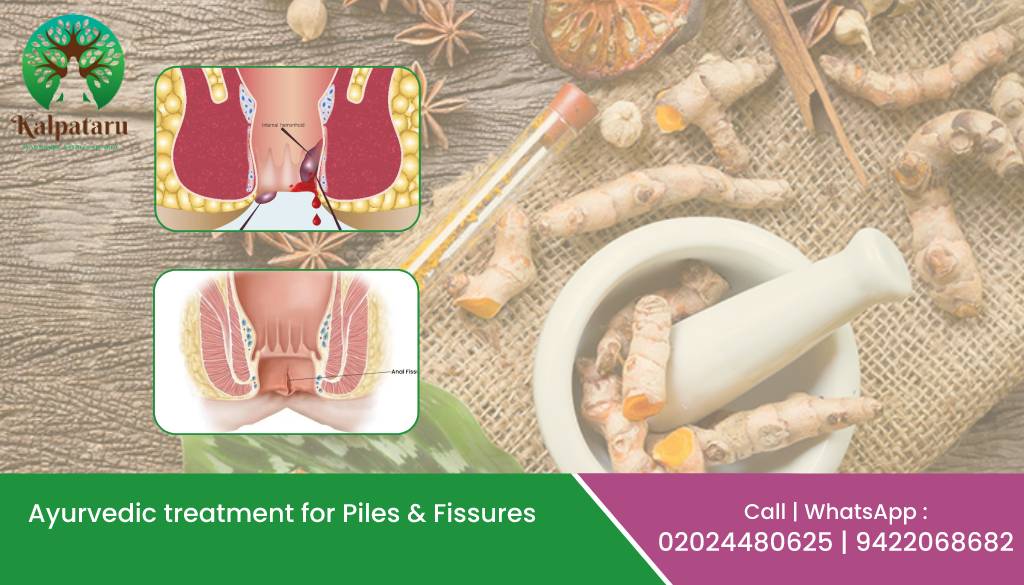
31Jan
Ayurvedic Treatment For Piles & Fissures
If you are suffering from piles or fissures, then you have come to the right place. Here, I will be discussing Ayurvedic Treatment For Piles & Fissures. Ayurveda is an ancient Indian science that has been practiced for centuries. Ayurvedic treatment is known for its effectiveness in treating various diseases and ailments. Piles and fissures are a very common problem, especially in India. However, there is no need to worry as Ayurvedic treatment can help you get rid of these problems. In this blog, We will be sharing with you some of the best Ayurvedic Treatment For Piles & Fissures. So, if you are looking for an effective and natural way to treat your piles or fissures, then this blog is for you! Types Of Ayurvedic Treatment For Piles And Fissures: There are a number of different ayurvedic treatment options for piles and fissures. Some of the most popular and effective options include: Anuvasana Basti: This is a treatment in which ayurvedic oil is used in enema form. This helps to reduce pain, inflammation, and bleeding. Herbal remedies: There are many different herbal remedies that can be used to treat piles and fissures. Some of the most popular include trifala, daruhalad, nakeshar,Suvarna gairik, mochras, sarjras, black resins, chinchalawan oil. These herbs are known for their anti-inflammatory and healing properties, and can help to soothe the symptoms of piles and fissures. Leech application: very useful in painful thrombosed piles. Anuloman: This therapy ensures smooth passage of stools without any irritation to the anal region. Sitz bath: the patient is asked to sit in medicated water for 10 – 15 min for reducing inflammation and pain in the anal area. Benefits Of Ayurvedic Treatment For Piles And Fissures: Ayurveda has many Benefits for treating piles and fissures. Some of the key benefits are: Ayurveda is a holistic system of medicine that addresses all aspects of a person’s life, from dietary advice to the treatment of major diseases. Ayurveda is safe and effective for the treatment of piles and fissures. Ayurveda can be used to treat both external and internal piles and fissures. Ayurveda is a natural treatment and does not cause any side effects. Ayurveda is affordable and easy to follow. Ayurveda can be used to prevent and treat piles and fissures. If you are suffering from piles or fissures, it is advisable to seek the help of an Ayurvedic practitioner for the best possible treatment. Kalpataru Ayurvediya Chikitsalaya™ offers a safe and effective ayurvedic solution to the problem and can be used to prevent and treat piles and fissures. Thousands of patients with piles and fissures have availed of ayurvedic treatment from Kalpataru Aayurvediya chikitsalaya™ with a successful outcome. They never needed to undergo surgical intervention.
Read More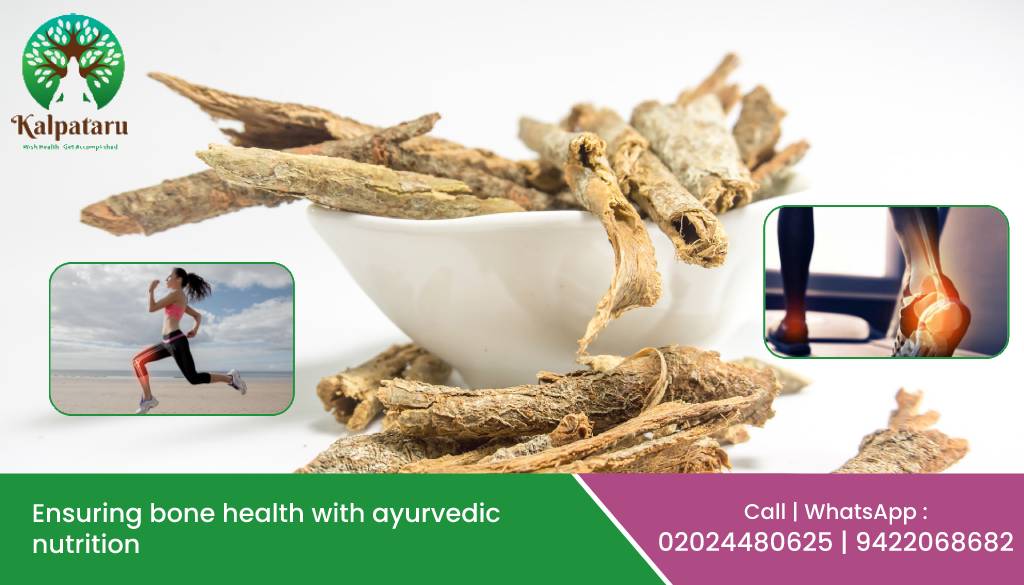
18Jan
Ensuring Bone Health with Ayurvedic Nutrition
As we age, it becomes increasingly important to take care of our bones. One way to promote bone health is through ayurvedic treatment. Ayurveda is a traditional Indian system of medicine that has been used for centuries to promote overall health and well-being. One of the main goals of ayurvedic treatment is to restore balance within the body. This is done by assessing the individual’s constitution, or Prakriti, and prescribing treatments and therapies that are specifically tailored to that person. Bone Health with Ayurvedic Nutrition includes dietary modifications, herbal remedies, and massage therapy. By following an ayurvedic diet and taking herbal supplements, you can help improve bone density and reduce the risk of fractures. Massage therapy can also help increase circulation and stimulate bone growth. Causes Of Bone And Joint Diseases Lack of exercise and too much exercise, both are responsible for bone and joint injuries Unhealthy junk and fast food Sedentary lifestyle Stress and excessive work pressures Untimely eating habits. Bad sitting postures Excessive travelling Obesity Hereditary causes Ayurvedic Tips For Better Bone Health If you’re looking for ways to ensure better bone health, you’re not alone. Millions of people around the world are looking for ways to improve their bone health and researchers are constantly looking for new and better ways to improve bone density and reduce the risk of fractures. But did you know that Ayurveda has been providing tips for better bone health for centuries? Ayurveda is a 5,000-year-old system of medicine that is still popular today. Ayurveda is based on the belief that the body is made up of five elements: earth, water, fire, air, and ether (pruthwi, aap, tej,vayu,aakash). Each of these elements is associated with a particular dosha, or body type. Ayurveda recommends different diets and lifestyles for each dosha and there are a number of Ayurvedic tips for better bone health. The most important Ayurvedic tip for better bone health is to eat a balanced diet. This means eating a variety of healthy foods from all the food groups. It’s important to perform the proper exercise. Other Ayurvedic tips for better bone health include: Eat plenty of calcium-rich foods. Calcium is essential for strong bones, so make sure you are eating plenty of calcium-rich foods like dairy products, leafy greens, ragi, amaranth( rajgira) ,edible gum and nuts. Avoid processed foods. Processed foods are bad for your bones, as they are often high in sugar and unhealthy fats. Instead, focus on eating whole, unprocessed foods. Staying hydrated is important for your overall health and it is especially important for keeping your bones healthy. Get plenty of exercise. Exercise is essential for keeping your bones strong. Try to get at least 30 minutes of exercise each day. Practice yoga. Yoga is a great way to improve your bone health. It helps to encourage healthy circulation, which is important for keeping your bones healthy and strong. Try to avoid drinking too much alcohol. Alcohol can leach calcium from your bones, making them weaker and more susceptible to breaking. Avoid smoking. Smoking is bad for bones, as it speeds up the natural aging process. Kalpataru Ayurvediya Chikitsalaya™ (KAC): Ensuring Your Bone Health Bones hold your body together and are essential for movement. They are also the site for mineral storage. Bone health is critical for people of all ages. Maintaining strong bones throughout life can help prevent osteoporosis and other bone-related problems in the future. Kalpataru Ayurvediya Chikitsalaya™ (KAC) is a well-known and trusted ayurvedic ortho treatment center in Pune. The center is run by Dr. Manoj Deshpande and Dr. Aparna Deshpande, They are experienced Ayurvedic doctors in Pune. They are practicing Ayurveda for over two decades and have helped thousands of people achieve better bone health. At KAC, Dr. Manoj Deshpande and his team use Ayurveda to treat a wide range of bone-related problems. The center offers a variety of treatment options, including: Panchakarma: This is a detoxification and rejuvenation treatment that helps remove toxins from the body and rejuvenate the tissues. It is especially beneficial for treating bone and joint problems. Internal Medicine: This involves the use of herbal medicines to treat bone and joint problems. It is a safe and effective treatment method that helps improve bone health and reduces pain and inflammation. Massage: Ayurvedic massage is a traditional treatment that helps improve blood circulation and remove toxins from the body. It is beneficial for treating bone and joint problems. KAC is the best place to go for Ayurvedic ortho treatments in Pune. The center has a team of experienced and qualified doctors who can help you achieve better bone health. Diseases treated with great success in KAC Rheumatoid arthritis Osteoporosis Lumbar and cervical spondylosis Osteoarthritis Frozen shoulder Knee-elbow-heel pain Avascular necrosis Psoriatic arthritis
Read More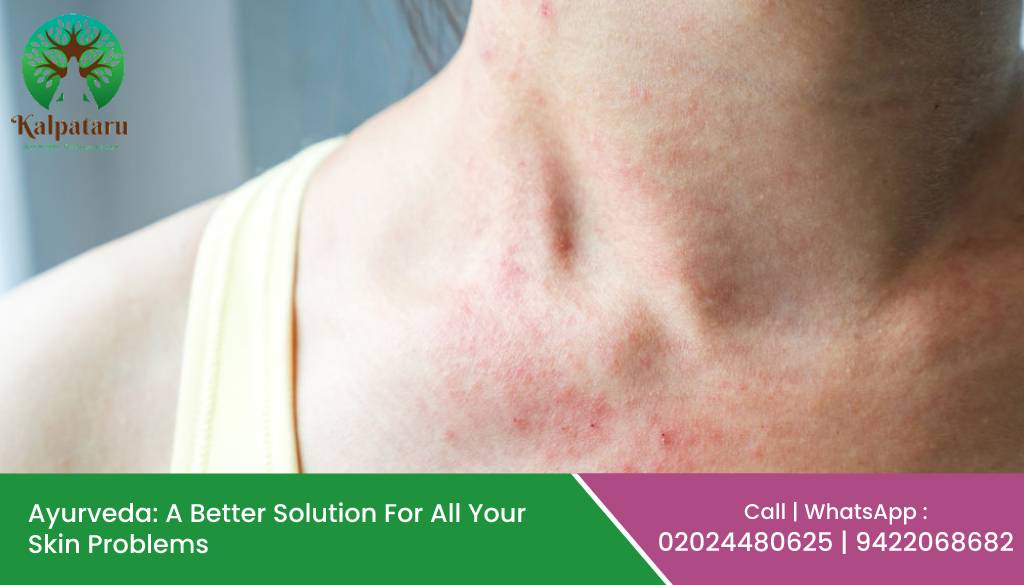
21Dec
Ayurveda: A Better Solution For All Your Skin Problems
If you are one of those people who is fed up with trying all kinds of chemical-laden products for your skin problem, then it’s time you switch to ayurvedic treatments. Ayurveda is not only the oldest form of healthcare but is also the most effective one. It has been used for centuries to treat all types of skin diseases like Urticaria, psoriasis, eczema, dermatitis, acne, etc. When it comes to skin diseases, there is no one-size-fits-all solution. But ayurvedic treatments offer a personalized approach that is tailored to your unique skin type. This is why Ayurveda: A Better Solution For All Your Skin Problems. So, if you are looking for a better way to treat your skin problem, look no further than Ayurveda. Ayurvedic Treatments For Your Skin Ayurveda is one of the oldest and most holistic forms of medicine. It is based on the belief that good health and wellness depend on a balance between the mind, body, and spirit. Ayurveda believes that the skin is the largest and most important organ of the body. It is a reflection of our overall health and well-being. Skin problems are often the first sign that something is out of balance in the body. There are many different types of ayurvedic treatments for skin problems. The most common are herbs, oils, and other natural substances that are applied to the skin. Herbs are often used to treat skin problems. Common herbs that are used include turmeric, neem, licorice, Guduchi, sariva, manjistha, nagarmotha, lodhra and aloevera etc. These herbs can be taken internally or applied externally. Oils are another common ayurvedic treatment for skin. Common oils that are used include coconut oil, sesame oil, neem oil, almond oil and flax seed oil. These oils can be applied externally or taken internally. Other natural substances that are often used in ayurvedic skin treatments include ghee, honey, and yoghurt. These substances can be applied externally or taken internally. Ayurvedic skin treatments are safe and effective. They can be used to treat a wide variety of skin problems. Is Ayurvedic Treatment Beneficial For Skin Anti Aging? This is the most common question asked by our patients. There is some evidence to suggest that ayurvedic skin treatment may be effective for anti-aging. A study published in 2016 found that an ayurvedic skin treatment called abhyanga, which involves massaging the body with oil, can increase collagen production and improve skin elasticity. Another study published in 2010 found that Ayurvedic skin treatment can improve skin moisture and reduce the appearance of wrinkles. Ayurvedic skin treatment is also thought to have anti-inflammatory and antioxidant effects, which may protect the skin from damage caused by free radicals. Despite the promising results of these studies, more research is needed to confirm the efficacy of ayurvedic skin treatment for anti-aging. If you’re considering using ayurvedic skin treatment for this purpose, it’s important to speak to a qualified healthcare practitioner to ensure it’s appropriate for you. Note From Kalpataru Ayurvediya Chikitsalaya™ Most of the skin problems are the result of the accumulation of toxins in the body. Ayurveda provides a complete detoxification program that eliminates toxins from the body and improves overall health. Kalpataru Ayurvediya Chikitsalaya™ is one of the best ayurvedic skin treatment centers in Pune, Navi Mumbai, and Chinchwad that offers a variety of ayurvedic treatments for all types of skin problems. The treatments are provided by experienced Ayurvedic doctors who have in-depth knowledge of Ayurvedic principles. The center offers a wide range of treatments for all types of skin problems, including acne, wrinkles, dark spots, pigmentation, and stretch marks. The treatments are 100% natural and are very effective in providing relief from the symptoms of skin problems. Kalpataru Ayurvediya Chikitsalaya™ is the best place to get ayurvedic treatment for all types of skin problems. The treatments are very effective and provide long-lasting results.
Read More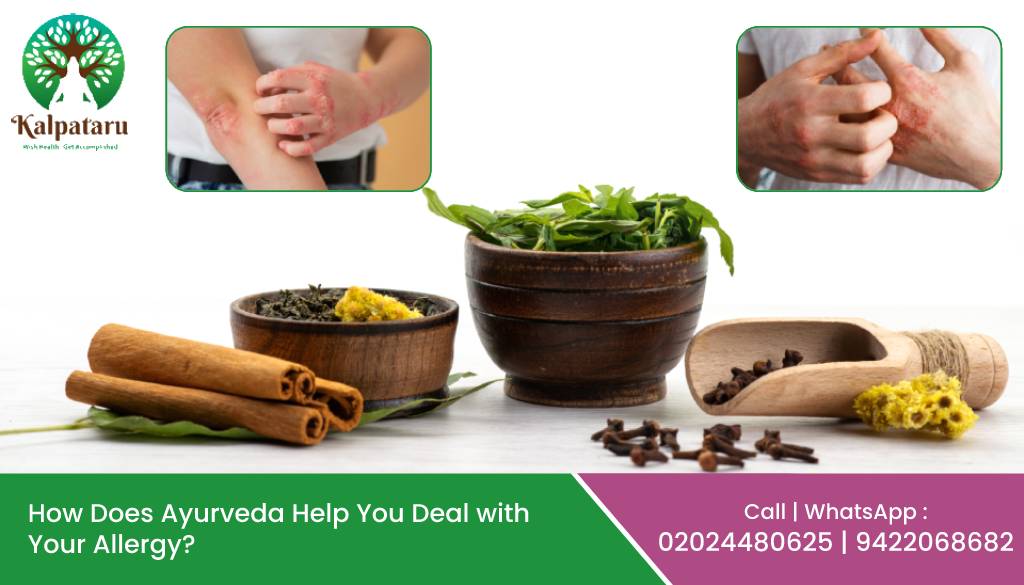
14Dec
Ayurvedic Treatment for Allergy – How Does Ayurveda Help You Deal with Your Allergy
Allergies are one of the most common health problems in the world. If you’re one of the millions of people who suffer from allergies, you know how miserable they can be. Luckily, there is a natural way to treat allergies called Ayurveda. Ayurveda is an ancient Indian system of medicine that has been used for thousands of years to treat a variety of health problems. Ayurveda originated in India and is based on the principle of balancing the mind, body, and soul. Ayurveda is a holistic approach to medicine that takes into account the whole person, not just the symptoms of the disease. There are many Ayurvedic clinics around Pune, and one of the best is the Kalpataru Ayurvediya Chikitsalaya™ in Pune. At Kalpataru, you can get Ayurvedic Treatment for Allergy for all types of allergies, including food allergies, environmental allergies, and seasonal allergies. So if you’re looking for a natural way to treat your allergies, Ayurveda may be the answer for you. Ayurvedic Treatment For Food Allergy Food allergy is a common problem these days. A lot of people are suffering from it. Though there are many treatments available for it, Ayurveda is the most effective one. Ayurvedic treatment for food allergy involves the use of natural herbs and spices. These herbs and spices are known to possess anti-allergic properties. The most important herb used in Ayurveda is turmeric. Turmeric is a very effective anti-inflammatory agent. It is also a very good antioxidant. Thus, it helps in reducing the inflammation caused by food allergies. Another important herb used in the treatment of food allergies is ginger. Ginger is very effective in treating allergies. It helps in reducing the histamine levels in the blood. Histamine is responsible for causing allergic reactions. Apart from these, there are many other herbs and spices which are very effective in treating food allergies. Some of these include fenugreek, cumin, coriander, etc. Ayurvedic treatment for food allergies is very effective. It not only helps in reducing the symptoms but also helps in preventing the occurrence of allergies. Ayurvedic Treatment For Environmental Allergy If you are one of the many people who suffer from environmental allergies, you know how difficult it can be to cope with this condition. Environmental allergies are caused by exposure to things in the environment like pollen, dust, and pet dander. While there is no cure for environmental allergies, there are treatments that can help you manage the symptoms. Ayurveda is one of the oldest and most popular forms of treatment for environmental. Ayurveda is has been used for thousands of years to treat a wide variety of health conditions. Ayurveda is holistic, which means that it considers the whole person, not just the symptoms of the disease. There are many Ayurvedic treatments for environmental allergies that can help to manage the symptoms. Some of the most common treatments are herbal remedies, dietary changes, and yoga. Herbal remedies can help to reduce inflammation and congestion, while dietary changes can help to reduce the number of allergens that you are exposed to. Yoga can help to improve your overall health and well-being, which can help to reduce the symptoms of environmental allergies. If you are looking for an effective and holistic treatment for environmental allergies, consider Ayurveda. Ayurvedic treatment for seasonal allergy Seasonal allergies are a common problem that can be effectively treated with Ayurveda. It is important to seek the advice of an experienced Ayurvedic doctor to get the best possible treatment. There are several effective Ayurvedic treatments for seasonal allergies. One of the most popular is Nasya, which involves the administration of medicated oil through the nostrils. This helps to clear the nasal passages and prevent the entry of allergens into the body. Some classical preparations such as Talisadi, Sitopaladi, and Rajanyadi churn are also used for respiratory allergies with wonderful results. Other effective treatments include taking herbs such as ginger, turmeric, and licorice. These herbs help to reduce inflammation and improve the function of the immune system. Ayurvedic treatment for seasonal allergies is often very effective, and it is important to seek the advice of an experienced Ayurvedic doctor in Pune to get the best possible treatment. Ayurvedic treatment for Skin allergy Skin allergies such as urticaria, and allergic dermatitis are on the rise nowadays. With thorough history taking and careful analysis of lifestyle the root causes are identified and with accurate medication these allergic conditions are permanently cured at KAC. Note From Kalpataru Ayurvediya Chikitsalaya™ Pune Kalpataru Ayurvediya Chikitsalaya™ is established 25 years back having three branches – Pune, PCMC, and Mumbai. It is one of the best and most experienced Ayurvedic clinic in Pune. Our clinic offers Ayurvedic treatment for all kinds of allergies, from simple inhalant allergies to food allergies and seasonal allergies. Our team of experienced Ayurvedic doctors, led by Dr. Manoj Deshpande and Dr. Aparna Deshpande, is able to diagnose the root cause of your allergy and prescribe the most effective Ayurvedic treatment for you. Our clinic has a proven track record of successfully treating allergies of all kinds. All the medicines dispensed to the patients are prepared at their own pharmacy of Kalpataru Ayurvediya Chikitsalaya™ with strict pharmacopeia. If you are suffering from an allergy, you may visit our clinic for a consultation. Our team of experts will help you get relief from your allergy symptoms and restore your health and vitality. ALLERGY IS NOT JUST SUPPRESSED BUT CURED FROM THE ROOT.
Read More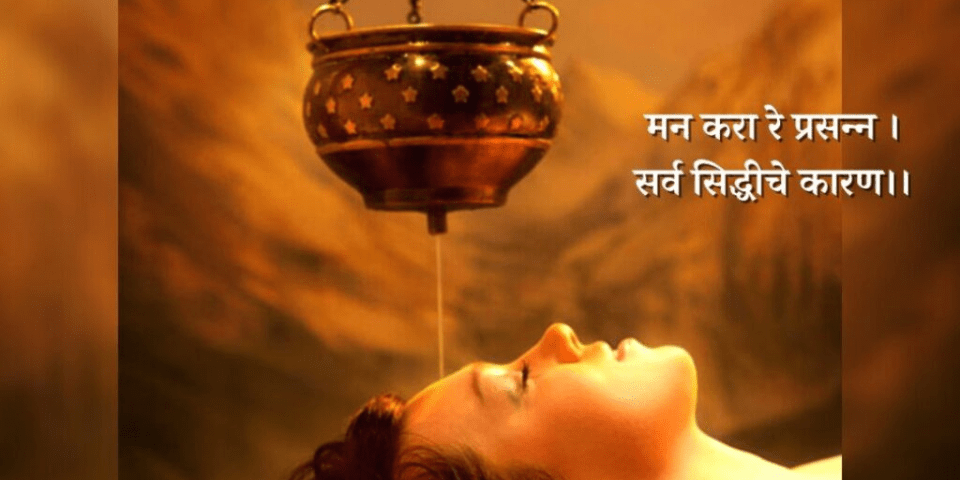
13Oct
Tips for psychological wellbeing by Dr Manoj Deshpande
पराकोटीचा उपभोगवाद, तथाकथित फास्ट लाईफस्टाईल, स्वकेंद्रित विचारसरणी, जीवघेणी स्पर्धा, इंटरनेट – सोशल मीडियाचा अत्यधिक वापर यामुळे सध्या मानसिक ताणतणाव, नैराश्य, चिंता,, निद्रानाश हे विकार मोठ्या प्रमाणावर बोकाळले आहेत. आजकाल दवाखान्यातही सकृतदर्शनी शारीरिक दिसणाऱ्या अनेक विकारांचे मूळ हे अस्वस्थ मनःस्थिती, ताणतणाव यातच दिसून येते. वैद्यकशास्त्रात अशा मनोकायिक आजारांची( Psycosomatic disorders) मोठी यादी आहे. उदा. निद्रानाश, डोकेदुखी, अपचन, रक्तदाब , मधुमेह, थायरॉईड, स्थौल्य, कँसर, पाठ कंबर दुखी, अंग दुखी, सोरायसिस, इसब इ. अनेक अनेक त्वचा विकार इ. म्हणूनच मनस्वास्थ्य हे उत्तम आरोग्याची गुरुकिल्ली आहे असे म्हंटले तर अतिशयोक्ती ठरू नये. आयुर्वेदामध्ये मनो रोगाची चिकित्सा सांगताना अनेक प्रभावी उपचार सांगितले आहेत. 1. आयुर्वेदामध्ये मनो रोगाची चिकित्सा सांगताना अनेक प्रभावी उपचार सांगितले आहेत. 2. शिरोधारा :- कोमट औषधी तेलाची कपाल परदेशी धार सोडणे. या प्रक्रियेमुळे मेंदूतून उपयुक्त अशा संप्रेरकांची उत्पत्ती जास्त होते व नकारात्मक संप्रेरकांची पातळी कमी होते 3. तक्रधारा :- शिरोधारा प्रमाणेच असणाऱ्या या प्रक्रियेत तेलाऐवजी औषधी ताकाचा वापर केला जातो. शिरोधारा उपक्रमामुळे रुग्ण हा थेरेपी टेबल वरच झोपतो हा नेहमीचा अनुभव आहे. मानसिक ताण तणाव जन्य अनेक विकारांमध्ये ही हुकमी चिकित्सा आहे. 4. नस्य :- नासा हि शिरसो द्वारम् । अशी आयुर्वेदात उक्ती आहे. नासिकेवाटे दिलेली अनेक द्रव्ये, सिद्ध तेले अथवा घृत या माध्यमातून दिल्यास चिंता, नैराश्य, इंद्रिय ग्रहणशक्ती कमी होणे , विस्मरण, चंचलता इ. विकारात उपयुक्त ठरतात. याला नस्य असे म्हणतात. 5. बस्ति :- पचनातील बिघाडामुळे झालेली अपान वायूची विकृती ही प्राणवायूलाही पुढे जाऊन बिघडवते व त्यामुळे अनेक शिरोविकार, मानसविकार होतात. अशा वेळी गुद मार्गाद्वारे काढा, तेल स्वरूपात द्रव्य आत सोडणे या प्रक्रियेद्वारे मनोरोगांवर नियंत्रण मिळवता येते.याला बस्ती चिकित्सा म्हटले जाते.यावरही खूप मोठ्या प्रमाणावर संशोधन होत आहे. 6. मन या इंद्रियांमध्ये व्याधी उत्पत्ती होत असली तरी वात-पित्त-कफ या त्रिदोषातील असंतुलन हेच त्याला कारणीभूत असते. त्यामुळे त्यांच्यातील साम्यावस्था प्रस्थापित केल्यास मनोविकार शमतात. 7. रक्तात संचित झालेली अनेक विषारी द्रव्ये (toxins) ही सुद्धा मेंदू व मन यांच्या कार्यप्रणालीत बिघाड निर्माण करतात. त्यामुळे रक्त शुद्धी चे उपाय महत्त्वाचे ठरतात. 8. आश्वासन आणि समुपदेशन:- मनोविकार ग्रस्त रुग्णाला विश्वासात घेऊन कधी रागावून तर कधी गोंजारून, विविध क्लृप्त्या-तंत्रे वापरून त्या आजारातून बाहेर येण्याबाबत आश्वासन आणि समुपदेशन औषधोपचाराइतकेच महत्त्वाचे असतात. मन स्वास्थ्यासाठी काही महत्त्वाच्या उपयुक्त टिप्स :- स्वीकार- सर्वप्रथम आपण जसे आहोत त्याचा स्वीकार करावा,आदर करावा. निसर्गाने प्रत्येकाला काही खूबी,वैशिष्ट्ये, वेगळेपणा देऊन पाठवलेले असते. आपल्यातील चांगल्या गुणांवर लक्ष केंद्रित करून त्यांचा विकास करावा. मग इतर काही त्रुटी, दुर्गुण (जे सर्वांमध्येच काही प्रमाणात असतातच) हळूहळू फिके पडू लागतात. कृतज्ञता – जे काहीसे अपयश, अपमान, कमतरता असतील त्यापेक्षा पूर्वी मिळालेले यश, मान, कौतुक यांचे स्मरण ठेवावे. ज्यांना अतिगंभीर आजार, वैगुण्य आहेत तसेच ज्यांच्यावर संकटांचे पहाड कोसळून ते उध्वस्त झाले आहेत त्यांच्यापेक्षा आपण कितीतरी बऱ्या अवस्थेत आहोत याचे स्मरण ठेवावे. म्हणजे मग आपल्या बाबतीतील कमालीची नकारात्मकता कमी होते. अवास्तव खर्च, उधळपट्टी, स्पर्धा- असूयेतून होणाऱ्या गोष्टी टाळाव्यात. त्यातून क्षणिक आनंद वाटला , अहंकार सुखावला तरी पुढे अनेक अवघड परिस्थिती निर्माण होऊन विविध मनोरोगांचा प्रवेश होतो. काहीतरी छंद कला जोपासावी - प्रत्येकाच्या आयुष्यात कधी ना कधी तरी कठीण प्रसंग येतात. तसेच रोजच्या रहाटगाडग्याच्या आयुष्यामुळेही कंटाळा, उबग, त्रागा होतो. त्यावर छंद हे उत्तम टॉनिक आहे. इंडॉर्फिन, सिरोटोनिन अशी अनेक चांगली संप्रेरके यातून मेंदूत स्त्रवतात. त्याने जीवनाला उभारी येते. आशादायक वातावरण निर्माण होते. निखळ मैत्री - विशेषतः कोरोना काळात मैत्रीची महती सर्वांनाच लक्षात आली असेल. केवळ आजारपणात एकमेकाला मदत करण्यापुरते मर्यादित नाहीतर मानसिक आधार देणे, मन मोकळे करायला हक्काची जागा असणे, एकत्र येऊन काही कार्यक्रम – करमणूक – हास्यविनोद करणे या सर्वांसाठी मित्र हे अत्यंत महत्त्वाचे ठरतात. आपल्या मनातील शल्य कोणापाशी बोलताच न येणे व त्यात कुढून कुढून विविध मनोविकारांची मालिका सुरू होणे हे दुर्दैव अनेकांच्या नशिबी येते. हास्य - वेदनेवरची फुंकर म्हणजे हास्य! हसण्याच्या प्रक्रियेमध्येही मेंदूत अनेक चांगले बदल होतात. सकारात्मक, उत्साहवर्धक, वेदनानिवारक गुणधर्माचे संप्रेरक( endorphins) तयार होतात. Norman Cousins या लेखकाने अत्यंत गंभीर अशा संधीवातावर फक्त उत्तम विनोदाने कशी मात केली याविषयीचे पुस्तक खूपच रंजक आहे. ही विनोदाची ताकद आहे. जीवनातील संकटांकडे खुल्या दिलाने पाहण्याची मानसिकता विनोदाने तयार होते. निसर्गाशी जवळीक - यामुळे तथाकथित भौतिक गोष्टींवरील अतिव प्रेम, आसक्ती कमी होते. निसर्गाची भव्यता – दिव्यता माणसाला नम्र, कृतज्ञ बनवते. सहली, picnics, पर्वतारोहण याने शारीरिक क्षमता वाढते, उत्साह दुणावतो. आपलाच आपल्याप्रतीचा आदर वाढतो. मोकळी हवा, प्रकाश, पाऊस, पाणी, वारा यामुळे मेंदूलाही तरतरी येते. उपकरणांवरील अवलंबित्व कमी करणे - वारंवार उत्तेजना देणारे व्हिडिओ पहाणे, सतत समाज माध्यमांवर सक्रिय राहणे, त्यातून होणारे हेवेदावे गैरसमज याला अंत नाही. यामुळे मेंदूला व्यसन निर्माण करणाऱ्या डोपामाइन या संप्रेरकाचा मेंदूत जणू पूरच येतो. वास्तविक हे विधायक कामांसाठी उपयुक्त असणारे हार्मोन , पण जास्त मात्रेत खूप त्रासदायक ठरते. त्यामुळे मेंदूला – मनाला छोट्या छोट्या गोष्टीतून आनंद मिळणे बंद होते. त्यामुळे त्याला दैनंदिन जीवन रटाळ, कंटाळवाणे वाटते. मग प्रत्येक वेळी आनंदी, उत्साही राहण्यासाठी मोबाईल पाहणे, तोच तोच कन्टेन्ट पाहणे जणू सक्तीचे होते. अनेक मनोविकारांना यातून सुरुवात होते. म्हणून गरजेपुरताच इंटरनेटचा वापर करणे हे फार महत्त्वाचे आहे. वाचनासाठी प्रत्यक्ष पुस्तक वाचणे हे कधीही श्रेयस्कर! परोपकार,निरपेक्ष मदत - खरे पाहता परोपकार हा वेगळ्या पद्धतीने पाहिल्यास आपल्यावरच उपकार असतो. एखाद्याला निरपेक्ष मदत करताना मेंदूमध्ये खूप चांगले बदल घडतात. वृत्ती उत्साही, आनंदी राहील अशी संप्रेरके तयार होतात. आपलीच प्रतिमा आपल्या मनात उजळून निघते. त्यातून व्यक्तिमत्व विकास होतो.आपण कोणाच्या भल्यासाठी उपयोगी पडतो ही भावना स्वप्रतीमा सुधारण्यासाठी खूप उपयोगी असते. व्यायाम – प्राणायाम – दीर्घश्वसन – ध्यान - व्यायामाने हृदय – फुफ्फुसाचे आरोग्य सुधारते. मेंदूला रक्त पुरवठा करणाऱ्या रक्तवाहिन्या खुल्या राहतात. मेंदूला भरपूर पोषक तत्वे, प्राणवायूचा पुरवठा होतो. योग – प्राणायामाने एकाग्रता सुधारते. मेंदूतील parasympathetic nervous system (शांतता, सृजनशीलता,समाधान, आनंद, इ. संबंधित) सक्रिय होते. भावना विषयक गोष्टींचे नियंत्रण करणारी लिंबिक सिस्टीम चांगली कार्य करते. नैराश्य, चिंता यांचे परिणाम कमीत कमी होतात. कोणत्याही बाह्य वस्तू – परिस्थितीवर अवलंबून नसलेला असा आनंद निर्माण होतो. दीर्घश्वसन – ध्यान याने भय, नकारात्मकता, चिंता, धास्ती( phobia) कमी होते. विशेष म्हणजे रोगप्रतिकारशक्तीमध्ये चांगलीच सुधारणा होते. मन – मेंदू – संप्रेरके – व्याधिक्षमत्व (psyco- neuro- endocrino- immunological axis)असा एकमेकांशी संबंध असतो. पोषण - संतुलित आहार,सात्विक आहार, आहारात पालेभाज्या, फळे, कच्चा आहार , सुका मेवा, शास्त्रोक्त पद्धतीने बनवलेले गाईचे साजूक तूप यांचा समावेश खूप उपयुक्त ठरतो. फास्ट फूड, जंक फूड, साखरेचा – तेलाचा अती वापर याने मेंदू व पर्यायाने मनाचीही हानी होते. आहार हा ताजा पुरेशा प्रमाणात (जास्त तर अजिबात नको), चौरस, षड्रस युक्त (गोड, आंबट, खारट, तिखट, कडू, तुरट यांचे योग्य संतुलन) असणे हे फार महत्त्वाचे आहे, फायद्याचे आहे. एवढे सांभाळूनही काही अपरिहार्य कारणाने मानसिक विकार झाले तरी त्यात काहीही न्यूनगंड न बाळगता मोकळेपणाने बोलणे, औषधोपचार करून घेणे हे महत्त्वाचे असते. वेळेत केलेले उपाय पुढील अनेक गंभीर आजारांना नियंत्रित करू शकतात. तर एवढे महत्त्व आहे मनाच्या आरोग्याचे! म्हणूनच समर्थांनी प्रत्यक्ष मनासाठी मनाचे श्लोक’रचले. मन एव मनुष्याणाम् कारणं बंधमोक्षयो: । असे हे आपले परम सखा – मित्र मन जणू विद्युत उर्जेप्रमाने आहे. विजेचा विधायक नियंत्रित सुरक्षित पद्धतीने वापर केला तर ती घरातील अंधकार दूर करून घर प्रकाशमान करेल पण जर निष्काळजीने वापरली तर घर भस्मसात करेल. सुनियंत्रित , सुचलित मनाने मोक्षासारखे भव्य – दिव्य फळ मिळेल आणि बेताल – सैराट वृत्तीने अनेक बंधनांमध्ये संकटांमध्ये अडकेल. Choice Is Your’s!!! डॉ मनोज म देशपांडे कल्पतरू आयुर्वेदीय चिकित्सालय, 545, नारायण पेठ, पुणे.
Read More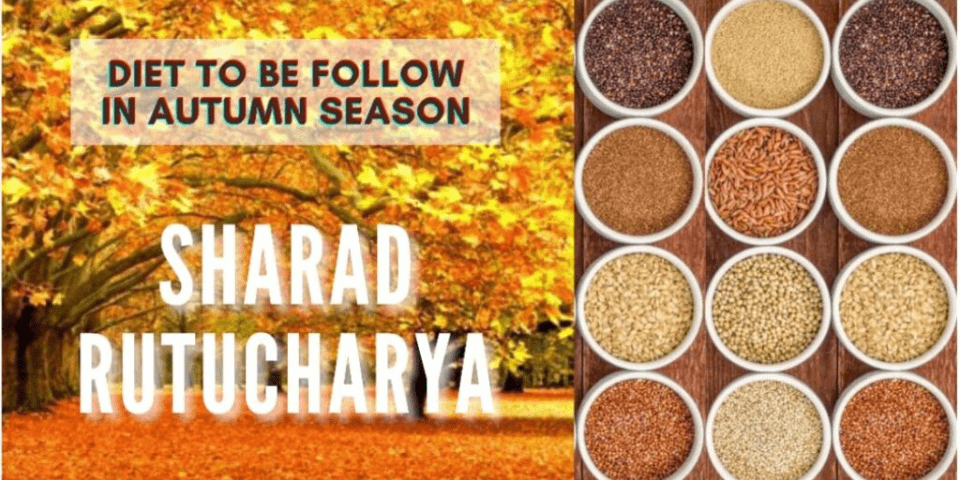
07Sep
Sharad Rutucharya
According to Ayurveda, the Sharad Rutucharya rate falls during the Hindu months of Bhadrapad and Ashwin. It is the season from mid-September to November. It is the rutu of Dakshinayan. Sharad rutu marks the transition from summer to winter. In Sharad rutu, the sky is covered with blue and white clouds. The Earth is a little muddy. The incisive rays of the sun fall on Earth. The hot sun rays in Sharad rutu exaggerate the Pitta dosh which is already accumulated in the body in Varsha rutu. Because of the hot sun rays in Sharad rutu, the water in rivers, ponds, etc. gets detoxified and becomes pure and clean. In Sharad rutu, the prevalent rasa is Lavan and mahabhutas are Apa and Agni. The strength of an individual stays medium. In Sharad rutu, the gratification of Vaat dosh happens, Pitta dosh is vitiated and the movement of Agni increases. So to pacify Pitta dosh and keep the Agni in normal condition we should follow a proper diet and lifestyle. Diet in Sharad rutu :- • Foods having madhur (sweet) and tikta (bitter) taste, and of light (light to digest) and cold properties should be eaten. • Foods having the properties to pacify the Pitta dosh are advised. • Wheat, green gram, nectar, sugar sweet, Patol (Tricosanthes dioxide), and meat of animals in dry areas should be included in the diet. •Avoid hot, spicy food in Sharad rutu. • Meal of aquatic creatures, curds, fats, and oils should be avoided. Lifestyle in Sharad rutu :- • As the sunrays are hot in Sharad rutu, to keep the body cold it is advised to wear garlands of flowers and pearls. • Dress up with light-coloured and clean clothes. • Cosume the cooling rays of the moon in the late evening. • Napping during the day, exposure to sunlight, and excessive eating should be avoided in Sharad rutu. Diseases aggravated in this season are stomatitis, piles & fissures in the ano, hyperacidity, certain skin ailments, etc. Panchkarm advised in this season are Virechan (planned purgation) and raktmokdhsn(bloodletting).
Read More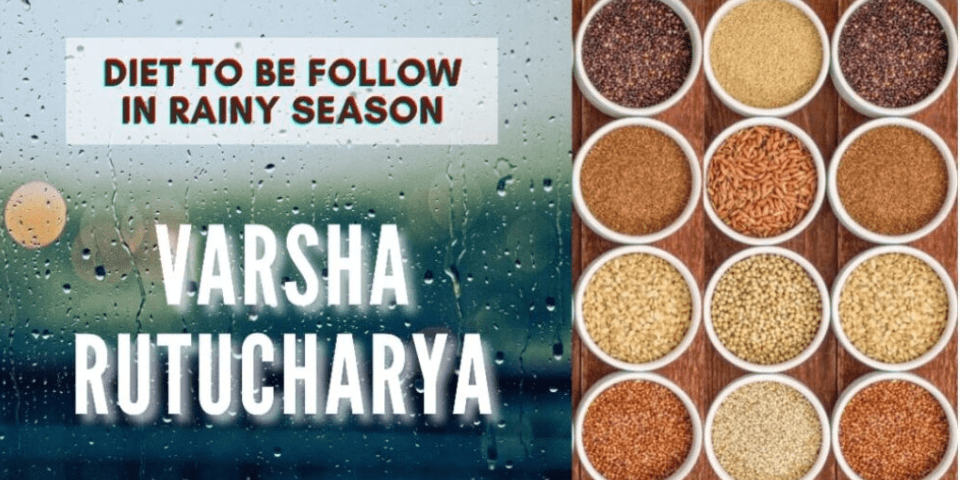
02Sep
Varsha Rutucharya
In India, the rainy season starts in June and continues till September. Between this period, according to Ayurveda two rutus ( seasons ) occur – Varsha rutu and Sharad Rutu. In Varsha Rutucharya, it rains all over India. The rivers, ponds, etc. are filled with water. The sky is covered with clouds and rains occur without thunderstorms. This rutu falls in Dakshinayan and the general body strength of an individual is weak. ‘Agni’ means digestion capacity is ‘Manda'(weak). So we should follow a specific Diet and Lifestyle in this season. The predominant Rasa and Mahabhuta in this season are Amla rasa and Jala mahabhuta. DIET IN VARSHA RUTU :- In Varsha Rutucharya, water in wells, and ponds is heavy to digest and as Agni is weak, metabolism is sluggish. To keep our metabolism in a good state, we must follow some changes in diet. Due to the change in climate in Varsha rutu, all 3 doshas – Vaat, Pitta, and Kapha get vitiated. So to balance these doshas and strengthen the Agni one should follow a proper diet — • Drink warm water. It’s better to drink Sunthi siddha jala this season. • Drink warm soups of olden grains • Consume light and fresh foods prepared using oldened grains. • Include rice, jowar, wheat, ragi, moong dal, ginger, garlic, and cow’s ghee in your food. • Consume small pieces of ginger and rocksalt before food. • Eat warm food and avoid raw food, fresh fruits, and salads. • Avoid drinking excess water and other drinks. • Reduce the use of leafy vegetables. • Instead of whole mutton and chicken, prefer soups. LIFESTYLE IN VARSHA RUTU :– • Avoid getting wet in rain. • Avoid daytime sleeping as it hampers digestion. • Keep the clothes and surroundings dry and clean. • Also keep the body dry. Fungal infections attack wet areas. Viral infection also attacks when the temperature is low. • Mild to moderate exercise is advised. PANCHAKARMA :- PANCHAKARMA:- Basti karma is advised in Varsha rutu.
Read More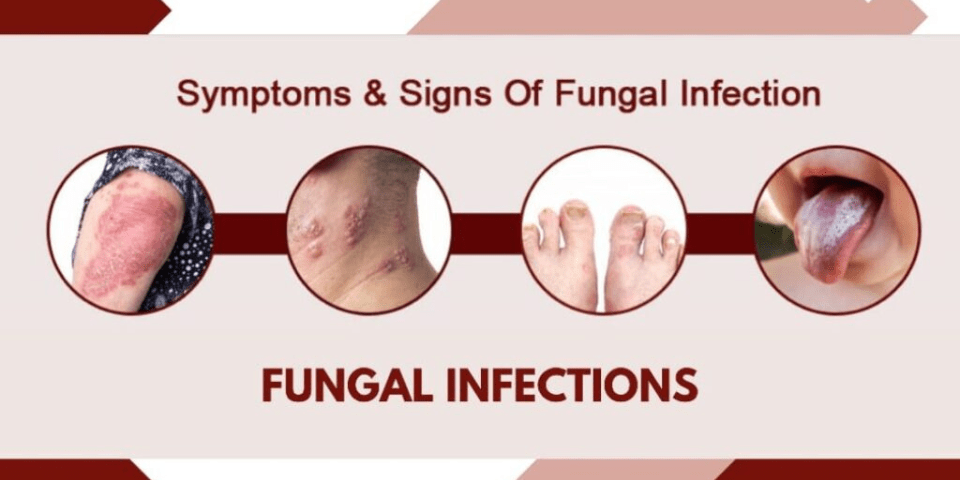
20Aug
fungal infections
A fungal infection, also called mycosis, is a skin disease caused by a fungus. There are millions of species of fungi. They live in the dirt, on plants, on household surfaces, and on our skin. Sometimes they can lead to skin problems like rashes or bumps. Fungal infection is one of the most contagious infections. According to its infection area on the body, various types are described. Such as Tinea capitis (on the head ), Tinea barbae ( in beard ), Oral thrush ( oral cavity ), Intertrigo ( on skin folds such as the armpit ), Tinea cruris ( around genitals, inguinal area ), Athlete foot, Dhobi itch, etc. SYMPTOMS:- Fungal infection might cause ● Irritation ● Scaly skin ● Redness ● Itching ● Swelling ● Blisters CAUSES:- The fungi grow best in warm, moist places. They are often found in humid places. FUNGAL INFECTION … AYURVEDIC ASPECT… DADRU Dadru is one of the common skin diseases mentioned in Ayurveda. In modern science, the clinical manifestation of dadru is closely similar to a local fungal infection which is affecting up to 15% of the population. Excessive severe itching and red patches are common symptoms found. Causes:- Unhygienic habits, use of dirty clothes, wrong habits of eating, excessive milk and milk products, junk food, bakery products, low immunity, etc. TREATMENT:- Ayurvedic treatments and somebody detoxification procedures have the capacity to treat any sort of fungal infection with any chronicity. In Kalpataru Ayurvediya Chikitsalaya™ (KAC), many patients have experienced the benefits of effective ayurvedic treatment for fungal infections. Ayurvedic treatment – A) Antifungal (krumighna) medicines — eg. Vidanga, Palash, Triphala, Bhallatak etc. B) Prakruti-vighat — eg. Chaturthak C) Raktashuddhikar medicines – eg. Manjishtha, Daruhalad D) Ointments containing raktashuddhikar, antifunal medicines like Gandhak, Daruhalad. E) Apunarbhav — follow dietary regime prescribed by ayurvedic vaidya. PANCHAKARMA:- 1. Raktamokshan ( Blood letting ) 2. Planned laxation ( Virechan ) 3. Modified Agnikarma with RF machine. 4. Don” ts — Wet clothing, incomplete course of medicines, over-the-counter steroid-containing creams, junk – fast food, unhygienic conditions, excessive sweat. 5. Do’s — Nutrition diet, completing proper treatment, immunity-boosting, washing clothes in hot water, etc.
Read More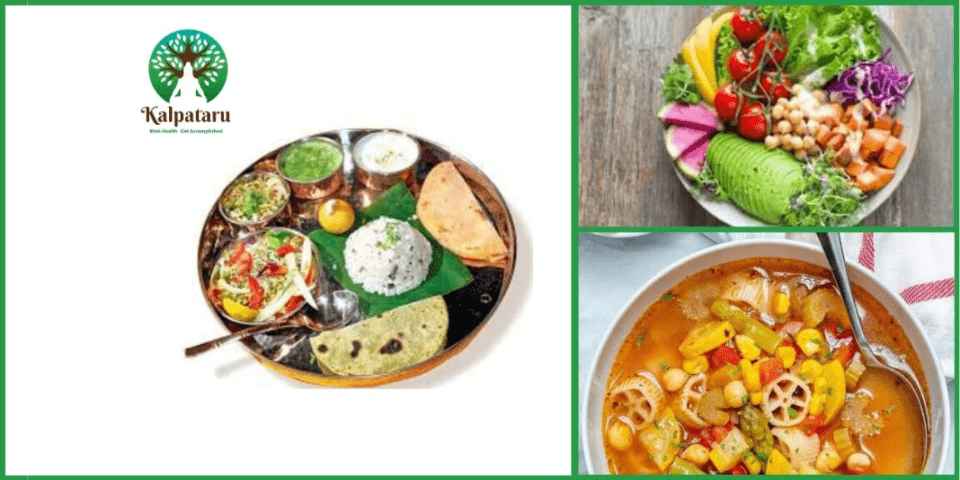
20May
let’s defeat covid – part 2
WE LEARNT ABOUT SMS ( SOAP, MASK , SOCIAL DISTANCE ) AND THEIR IMPORTANCE IN THE LAST BLOG. BY FOLLOWING SMS, WE CAN AVOID TO GET INFECTED. There is one more important factor to avoid any infection — that is Our Immunity. If we are healthy, our immunity is good, we are able to avoid infection or if we get infected, we can fight against the infections and get rid of it. For good immunity, Healthy Diet and Exercise are the main contributors. IN THIS BLOG, WE WILL DISCUSS HEALTHY DIET हितमशनियात् मितमशनियात्। स्निग्धमशनियात् उष्णमशनियात्।। This means whatever we eat … it should be Wholesome, it should be in the right quantity, it should be having good fat insufficient quantity, it should be warm while eating that is freshly cooked. Ideal timings of taking food – Breakfast 8:00 to 8:30 AM Lunch 12:00 to 12:30 PM Dinner 8 to 8:30 PM ● Raw food should be in adequate quantity. ● Evening snacks should contain green tea and a fruit. ● Overeating must be avoided. ● Refrigerated food should be avoided. ● Strict control on Sugar Salt and Maida. ● All sort of dry fruits are source of good fat. ● As far as possible, organic food should be consumed. ● Food products with preservatives should be avoided. ● Adequate quantity of proteins must be included in the diet.
Read More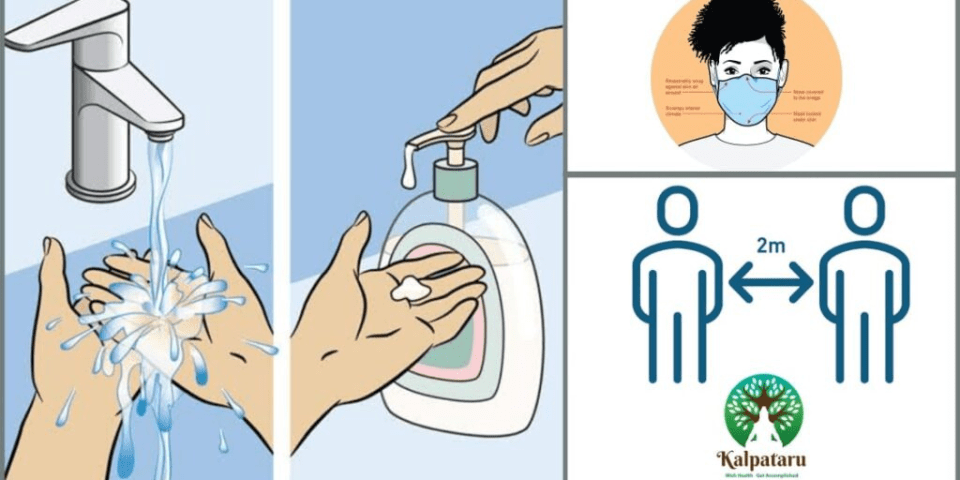
15May
let’s defeat covid
Effective Tips To Avoid CORONA Infection Since March 2020, we are fighting with COVID 19 caused by the novel Coronavirus. According to a recent declaration, it is a viral infection that spreads through the air(Airborne). In India Corona patients are increasing day by day and many times situation is out of control. Indian Govt., state Govts. , all medical institutes are trying very hard …. Still, these efforts are not sufficient. So, it is our duty to try not to get infected and stay fit Here are some effective tips to avoid CORONA infection and stay healthy…. 1. Soap :– To avoid infection our hands, as well as a whole body, should be clean. Therefore whenever we come home from outside, wash your hands thoroughly with soap for 20 seconds. When you come home after doing your full-day office duty, take a bath. Apply the soap all over the body. Keep yourself always clean. We can use sanitizer also to keep our hands clean. At the entrance of our home and office sanitizing facility should be compulsory. 2. Mask :– It is a VVIMP tip. As the infection spreads through the air and it enters our body through the nose or mouth, it should be covered by a mask strictly. Mask works as a shield. When we go out if by chance we come in contact with a Corona patient and we are wearing a mask chances of getting infected are very less. The Mask should be three-layered. If you don’t have, wear two Masks at a time. Mask should be of perfect fitting. The nose, mouth, and chin should be covered properly. Don’t use a loose mask. There are various options of masks in the market such as N95, surgical masks, three layered masks, k95 masks, etc. Select the proper mask according to your profession and duration of exposure. 3. Social Distance :– दो गज की दूरी … है बहुत जरुरी As the Corona infection spreads from one person to other, please avoid going out without any sufficient reason. If it is necessary to go out, we must keep at least 3 feet distance from other persons. When you are talking with someone, keeping distance is of utmost importance. In some houses, cleaning workers and maids come from outside. Ask those persons to wear mask compulsory while working. Their hand sanitization before entering the home should be mandatory. These are the simple things that we can do easily to avoid Corona infection. In the next blog, let’s learn what should be the proper diet to gain immunity against corona infection
Read More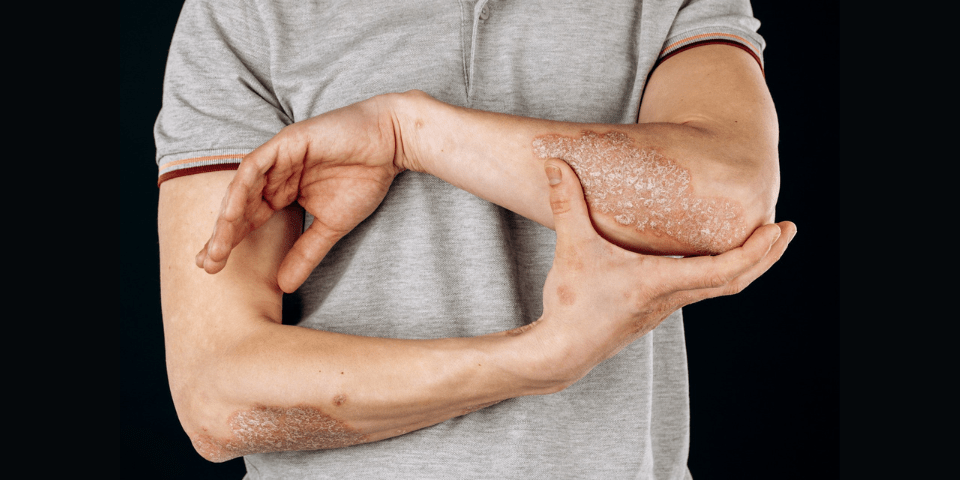
19Mar
Eczema made easy by Ayurveda
Eczema is a condition wherein patches of skin become inflamed, itchy, cracked, and rough. Some types can also cause blisters. It is also commonly known as atopic dermatitis. MILLIONS OF INDIANS SUFFER FROM THIS DISEASE EVERY YEAR. MANY OF THEM CARRY THIS CONDITION LIFELONG. CAUSES THE MAJOR CAUSES FOR ECZEMA ARE – •PERSONAL AND FAMILY HISTORY •SKIN HISTORY •COLD WEATHER CONDITIONS LIKE DRYNESS •CONTACT WITH CHEMICALS •EMOTION AND STRESS •WRONG DIETARY HABITS This is the case of Eczema where the patient was suffering from the hardness of skin, increased thickness, severe itching, cracking of the skin, and sometimes bleeding after itching. The patient was suffering from Eczema for the last 10 years along with diabetes and hyperacidity. After trying so many modalities with unsatisfied results she came to know about our clinic Kalpataru Ayurvediya Chikitsalaya™ (KAC) by her daughter staying in Japan. Before one month she came to our Clinic and started the Ayurvedic treatment. In Kalpataru Ayurvedic Chikitsalaya™(KAC) after in-depth history taking radical and Research-oriented treatments are offered. After in-depth check the medicines given to the patient are having the properties of blood purification, anti-allergic, antipruritic, immune-modulating, skin-soothing, stress management, etc. These medicines include oral medicines, ointments, oils, etc. Some Panchakarmas like raktamokshan, practician are also done according to the disease condition The advice on dietary changes and Lifestyle management is the backbone of KAC’s treatment. The pictures show three stages 1- when the patient arrived for the first time 2 – after 15 days of medication 3 – after 30 days of medication. Who can now say that Ayurvedic medicines work slowly?
Read More
02Jan
health is wealth
Ayurveda is the sub-vedic stream of Atharvaveda, which is influential in maintaining the health of healthy people(health is wealth). Today, Ayurveda is coming up as a potent cure for many challenging ailments, but earlier it was slightly forgotten due to the Mughal and British invasions, loss of intellectual literature and archives, ignorance from government bodies, comparatively lesser funds allotted to Ayurvedic development than modern medicine and lots of other reasons. Even in this age of painkillers, steroids, and antibiotics, ayurveda is standing tall with its indigenous way of diagnosis, on the pillars of Panchabhoutik Theory, Shadras Theory, and Panchakarma treatments since 700 BC. Ayurveda is the most ancient science among the group of allopathy, naturopathy, homeopathy, magnetotherapy, and so on. It is getting acknowledged in 20 to 25 countries other than India. It has proven to be effective and has the power to eradicate the disease from its roots, not only on stereotypic ailments like arthritis, asthma, and hyperacidity but also on diseases that seem to be nightmares to modern medicine, like psoriasis, colitis, and hepatitis, heart diseases, fistula, diabetes, paralysis, allergies, respiratory tract infections, optical ailments, insomnia and many more. Many surgical procedures that are considered necessary by modern medicine can be prevented by ayurvedic treatments. DIETARY MALPRACTICES Good health-Sampurna Aarogya is necessary to attain economic stability, working efficiency, focus, and ultimately salvation(Dharma-artha-kaam-moksha). Even though many people know this, the current society is not so keen on the maintenance of health. Many new diagnostic methods and methodologies are being devised and developed day by day, but the rate of increase in the number of patients is also attaining new peaks. The heart diseases which were seen in ages 50-60 earlier are today diagnosed at young ages too. There is an alarming increase in the number of diabetes patients in the young generation and in children. There are no limits to cases of depression and mental stress. Really, is this social progress? The causative agents of cancer, asthma, arthritis, skin diseases, and many other conditions can seldom be assessed with the help of tests, but the principal causes of diseases are the wrong food habits and lifestyle we unknowingly follow in day-to-day life. The “so-called” modern lifestyle has led to the inculcation of many bad practices in today’s life, especially that of the youth. This generation frequently wants to skip their lunch and instead have a pizza or a burger. Also, drinking water along with it seems like old ways to people, instead of modernizing and having a coke. This is occasionally okay, but many people have let it become their daily routine. No one has the time to think about how this junk food is torturous to our body and how unknowingly we ingest a huge excess of calories and harmful contentsToday, staying up late at night and following haphazard work schedule is considered as the best way of life. Only infants sleep at around 9-10 pm, all else go to bed late, at 12 or 1 am. , consequently waking up late at 8 or 9 am. Staying up late increases PITTADOSH, WAATADOSH in our body. All ailments arise due to increased heat in our bodies. Digestion is disrupted. The consequences don’t appear immediately, but in time, staying up late gives rise to hyperacidity, buccal ulcers, constipation. Constipation is the source of many other diseases. Waking late also leads to avoiding exercises. When we blindly copied the junk food and fast life of the westerners, we simply and conveniently left out their urge and dedication towards fitness and exercise. In America, 50 to 60% of people exercise daily on the contrary to less than 10% in India. It’s not that in the earlier days there were no diseases, no epidemics, but there was quite a less rate of people getting ill. People were more inclined to stave off diseases and use fewer medicines in day to day life. People from all houses knew the scientific ways and information about diet. GRANNY’S WAYS were revered back then. The value of health was well understood. That’s why we see in the ancient literature like Charak, Sushrut, Wagbhat that more attention is given to knacks of prevention of diseases. The seasonal regime [HEMANT, SHISHIR, VARSHA, VASANT, GREESHM AND SHARAD and the diet to be followed during these seasons] and the daily regime [right from MALAVISARJAN(defecation), DANTADHAVAN(dental cleansing) in the morning to NIDRA(sleep), MAITHUN(sex), all viewed through the lens of WAAT-PITTA-KAFA and the scientific reduction of the disease prevalence, dietary sciences, etc. provide an explicit explanation which still holds true since 5000BC. We see that day by day, microbes are getting immune to the newest kinds of medicines. Microbes are not paying heed to those antibiotics which were considered to be their dreads, like penicillin, streptomycin, and quinine. We should not consider the excessive use of antibiotics and the ability of microbes to resist them the only reason, but the loss of immunity of mankind ever since we evolved is also a prominent cause of increasing diseases. In these cases and plenty of others, Ayurveda has many advantages. Apart from being totally devoid of side effects, treatment administered by an expert ayurvedic doctor not only temporarily cures the symptoms of a disease; it totally eradicates the disease from its roots. Ayurveda is comprised of eight branches, namely- KAYA(medicine), BALA(pediatrics), GRAHA(psychiatry), URDHWANGA(e.n.t.), SHAYLA(surgery), DANSHTRA(toxicology), JARA(geriatrics), WRISHAAN(eugenics). This proves that Ayurveda also has different branches right from the beginning. Ayurveda has recently shown very encouraging results in Chikungunya, in Gujarat. Centuries ago, the Bhaavaprakash Sanhita had stated that severe pyrexia(fever) as seen as a symptom in chikungunya, is caused due to mosquitoes. This book also has symptoms that 100% match those seen in this disease. Thus, in a nutshell, Ayurveda is a capable alternative to many minds-boggling and grave diseases
Read More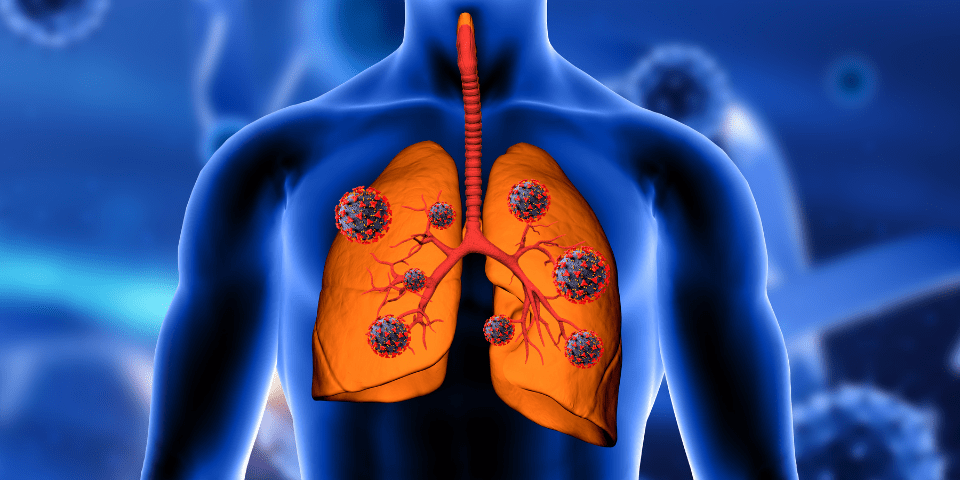
17Aug
Ayurvedic Cure for Respiratory Problems
Problems related to the Respiratory System Long-term cold, increase in the size of nose bone and cartilage, clots, increase in the size of adenoid glands, tonsillitis, pharyngitis, long-term cough, asthma, pediatric asthma, etc. Reasons Well-known reasons- increased contact with pollution, dust, and smoke; strong odors, hereditary reasons, etc. From the lens of Ayurveda- the habit of eating sweets after meals, overuse of cold and heavy-to-digest foodstuffs in meals, untimely meals, doing the opposite of hunger status, heavy mental stress, drinking excess water, overuse of milk and milk products(especially in children), bakery products, constipation causing products, etc. According to Ayurveda, even though colds, coughs, and asthma are diseases of the respiratory tract, their roots are deep within the stability of our digestive system, diet, immunity, etc. A permanent cure for these disorders is not possible if other factors are not compilable. Treatment Many medicines like SITOPALADI CHURNA, SHWAS KUTHAR, ADULSA decoction, BRITHWAT CHINTAMANI etc. But, the exact usage and duration of different medicines for different situations is only determinable by a vaidya. It is equally important to derive a relation between the birth date of the patient and the DOSHAS related to the contemporary season. Also, the PANCHA KARMAS are performed to benefit the medicines. The following dos and don’ts are necessary to be followed. Don’ts Curd, buttermilk, milk products, excess water after meals, immediate sleep after lunch or dinner, overeating, frequent eating, overuse of cold food, use of perfume, chinese-punjabi food, overexposure to cold, regular swimming, new grains etc. Do’s Warm and fresh food, early dinner, drinking warm water after meals, eating TAMBOOL, using dry fruits over custard apples, bananas, etc. Regularly use edibles like figs, black-dried grapes, dried dates, etc. In case of obligation, use sheep’s milk. Daily use of honey, garlic, raw onions, MOONG, mutton soup, puffed maize, etc. Regular massage is beneficial for the elderly and children. Regular NASYA is advised. Exercises Easy and regular exercise enhances immunity, and strength, and increases tidal capacity. Exercise keeps the respiratory tract clean and free. SURYA NAMASKAR, PAWANMUKTASANA, SARWANGASANA, HALASANA, PASCHIMOTTANASANA, MATSYASANA, KHECHARI MUDRA, etc. yogic asanas are important in order to stave off the ailment in the future. Accurate Ayurveda treatment and dietary dos and don’ts are sure to help prevent and heal chronic respiratory conditions. Note: This article has been authored by the practitioner for informational purposes only. It is a must to consult a practicing professional before using/ taking any medicines.
Read More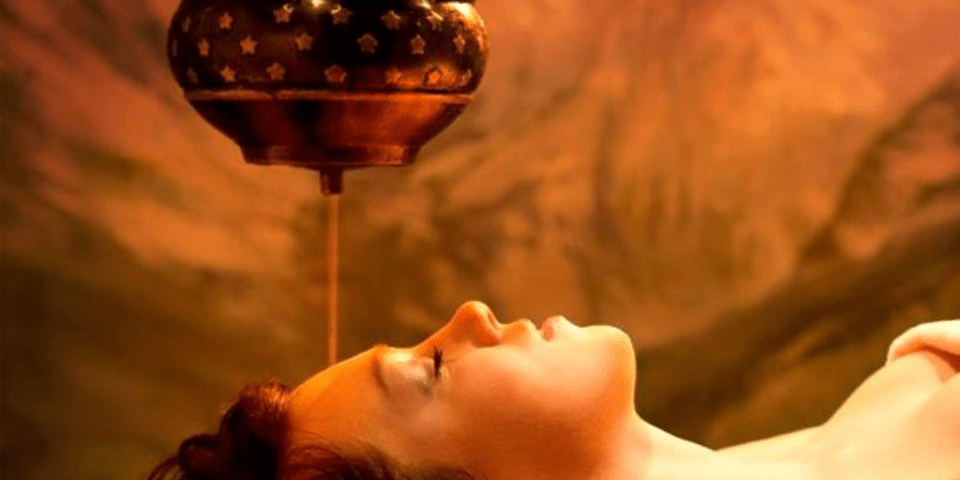
02Aug
Abhyang
Massaging the whole body with oil is called ABHYANG in Ayurveda. The complex machine of our human body, when massaged with oil in the ABHYANG procedure, halts the degeneration of its parts and extends its life. Hence, regular ABHYANG is necessary in order to maintain and protect our health and increase bodily strength. Odd movements of our body, trauma, and errors in posture cause different WAATA disorders. ABHYANG ensures the eradication of these. Regular ABHYANG increases strength and hence the duration of work. Skin appears young. Skin tone improves. Wrinkles and dryness in the skin disappear. Bone and muscle strength increases. Old age sets in late. The body becomes agile and flexible. ABHYANG is the utmost necessity for athletes and people who exercise regularly. ABHYANG has proven to be very effective in cases of polio, paralysis, joint pain, insomnia, different skin diseases, WAATA disorders, frozen shoulder, sciatica, lumbar pain, backache, neck pain, spondylitis, etc. Methodical and proper ABHYANG is effective for decreasing as well as increasing weight. It stands as a prerequisite for other procedures like BASTI, WAMANA, VIRECHANA, etc. Child development is aided by ABHYANG. It also balances the concentrations of the basic and fundamental constituents of the body in youth when the physical growth is done with. Due to the dominance of WAATA and the disintegrative nature of body constituents, ABHYANG is a relief and upliftment for old people. ABHYANG performed for pregnant women in their third trimester in the thigh and lumbar region facilitates an easier delivery and prevents further aches in the back. To compensate for the fatigue, massage should be continued for two months after delivery. Head massage for children is very soothing for them. Children grow to calm and sleep well. Complaints like hair fall, hair greying, and insomnia are dealt with magnificently by SHIROABHYANG, i.e. head massage. Four types of fatty substances, namely TAILA (oils), GHEE (clarified butter), VASAA (animal fat), and MAJJA (bone marrow) are used according to various disease conditions. Appropriate time and knowledge of proper pressure points are of utmost importance during the massage. During cold seasons, to tackle the dryness of skin, oils having more unctuous properties are used. In summer, oils prepared in coconut base are preferred. During massage, muscle, joint, bones, ligaments, tendons, muscle origin and insertion points, and MARMA BINDU (vital points) consideration is inevitable. Special emphasis should be given to these vital points- body constituent consideration (such as WAATA, PITTA, and KAFA) is useful for selecting specific medicinal oil. Massage after exercise is always preferred. CONDITIONS WHERE MASSAGE IS CONTRAINDICATED. i. In fever ii. Inflammation iii. KAFA DOSHA originating disorders iv. Joint pain with fever and oedema v. Massage after food vi. Massage while feeling much hungry vii. Indigestion Various tricks like patting, kneading and vibrating are equally important during massage procedure. This creates lightness in the body and relieves pain. According to directions, two types of massages are described in ayurvedic scripts- ANULOMA (direction towards heart) and PRATILOMA (direction away from heart). GENERAL SEQUENCE OF MASSAGE PROCEDURE The massage done in the following sequence of organs is beneficial Ears → nose → head → navel → soles → ankles → calf → knees → thighs → palms → wrists → forearms → elbows → abdomen → chest → back → lumbar region → sacral area → hips → posterior legs → posterior hands Steam bath or hot water bath after this sequence is essential. Last but not least, people should be aware that the ambiance and external appearance of the massage center or spa is not the only factors to serve your cause, but a therapist having thorough scientific knowledge is also important. ABHYANG or massage is not just an external treatment for temporary soothing, but it has the potential to cure the pains and relieve the stress hidden deep within your body and mind.
Read More
02Aug
Arthritis – Dietary Advice
GOOD FOR ARTHITIS Arthritis - Dietary Advice Grains:- brown rice, unpolished rice, old rice, barley, ragi. Vegetables:- drumsticks, pumpkin, bitter gourd, snake gourd, PUNARNAVA (Boerhaviadiffusa). Cereals:- MOONG, lentil, moth bean, ragi. Meat:- chicken, mutton Milk products:- only buttermilk that too at day time enriched with, pepper, cumin seeds, and rock salt. Water:- warm water enriched with medicinal properties. Natural pain killers:- ginger, turmeric, onion, ginger, fenugreek seeds, flaxseed Other edibles:- castor oil, GOUMOOTRA (cow’s urine), SOONTH (ginger powder), fennel seeds BAD FOR ARTHRITIS Grains:- new grains, wheat. Vegetables:- bottle gourd, ivy gourd. Cereals:- black gram, field beans, green peas, cowpea, and chickpea. Meat:- fish and seafood. Fruits:- especially citric fruits Milk products:- milk, curd, PANEER, cheese. Water :- cold wate Bulbous fruits:- sweet potato, potato Other edibles :- VIRUDDH AAHAR (opposite natured food combinations), like milk + fruit, curd + milk, etc., jiggery, USEFUL ENRICHED RECIPES Moth bean soup:- let the moth beans sprout. Take these in a pressure cooker and steam it for a few minutes. Take some grated coconut, onions, pepper, cloves, cinnamon, and roasted coriander seeds to enhance the taste and put them in a mixer grinder, and grind it. Then take the steamed moth beans and add some salt and chili powder for taste. Mix it with the grinded mixture and boil it for some time. Ginger candy:- take half a cup of ginger juice. Settle the solid sediment and sieve the liquid juice in another cup. Add to it 1.5 cup milk and 1 cup sugar and boil until it becomes semisolid. Then apply some ghee to the back of a flat plate and spread the semisolid mixture. Then let it dry and divide it into pieces.
Read More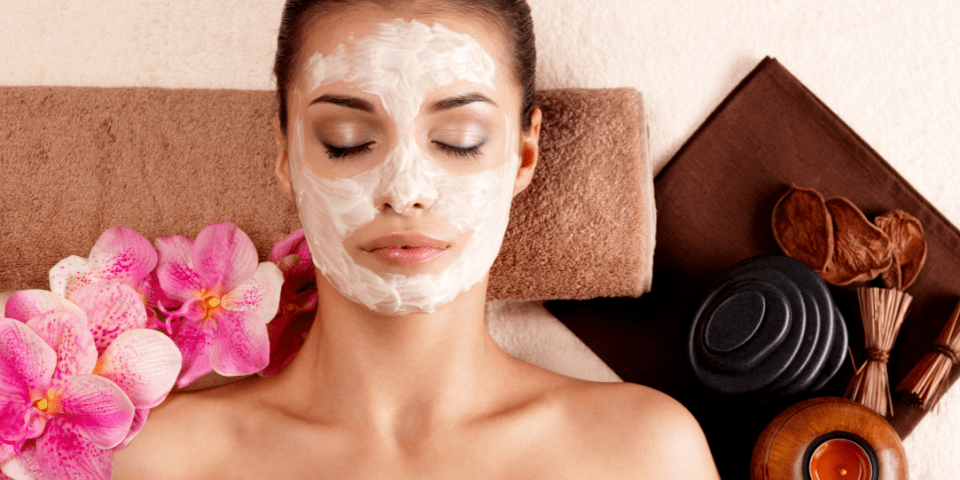
02Aug
Ayurveda’s Boon To Skin And Respiratory Diseases
Ayurveda's Boon To Skin And Respiratory Diseases: The disorders rising at the onset of winter include skin diseases and other breathing problems caused by Waatadosha. Kalpataru Ayurvediya Chikitsalaya™ is poised for research and eradication of skin and allergic problems for 23 years. PSORIASIS A patient approached us by reading an article from the “Family Doctor” edition of the Daily Sakal newspaper issue. We were shocked to see this woman who was suffering from psoriasis for 10 years, dropping almost 200 grams of dandruff per day, her body covered in patches leaving not even a pinpoint on her skin. She could not even exit her house due to this dreadful disease. With the blessings of Lord Dhanwantari, accurate medicines and treatment cured her of this disease in 2 months' time. After that, we continued to give her medicines to boost immunity, keep a check on skin cell division, and the required PANCHAKARMAS. Since then her grateful family is confidently referring other acquaintances and patients to us. That woman hasn’t got the recurrence of psoriasis, a disease notorious for its comebacks, in the following 10 years and continued. Even when denied by modern medicine, Ayurveda has proved the right fact that in the absence of medication- proper care, daily exercise, and diet management can cure a person from psoriasis. The testimonials of over 6000 patients at Kalpataru Ayurvediya Chikitsalaya™ only reinforce this fact. We perform effective treatment also for psoriasis-induced arthritis which is yet another more complicated issue. RESPIRATORY PROBLEMS Asthma and other breathing-related disorders often trouble us in the winter and monsoon seasons. Modern medical science treats allergy-induced bronchoconstriction only by suppressing the allergy itself. For this, different sprays, tablets, and inhalers are used. This is often rendered ineffective when the effects of the medicine stop or there is the slightest change in the diet and lifestyle of the individual. Ayurveda is the ultimate boon for these cases. In Ayurveda, we not only hold the respiratory tract responsible for asthma but also the PRANAWAHA, ANNAWAHA, and UDAKAWAHA systems. Hence, untimely meals, and heavy-to-digest meals tend to disrupt the ANNAWAHA SROTA and hence disorient the breathing pattern. Many people fall prey to the common misconception that ‘drinking excess water is good’ and this habit disrupts the UDAKAWAHA SROTA and hence the breathing pattern too–welcoming cough, asthma, etc. Things like mental stress, tension, and anger also tend to affect our breathing patterns in a bad way. This implies that only symptomatic medicines for allergies aren’t enough. According to Ayurveda, the systems, namely respiratory and digestive, are responsible for asthma. Digestion-boosting medicines and respiratory system enhancers coupled with PRANAYAMAS, stress management, control of excess water intake, and most important RASAYAMA CHIKITSA which is performed on the disappearance of symptoms is the key to accurate treatment for asthma. When the child is caught in the cycle of asthma attacks, constant colds, and recurrent cough — antibiotics, bronchodilators, sprays, and inhalers can be cut down permanently by Ayurveda; their parents bow before Ayurveda. The doctor concerned also feels a great satisfaction.
Read More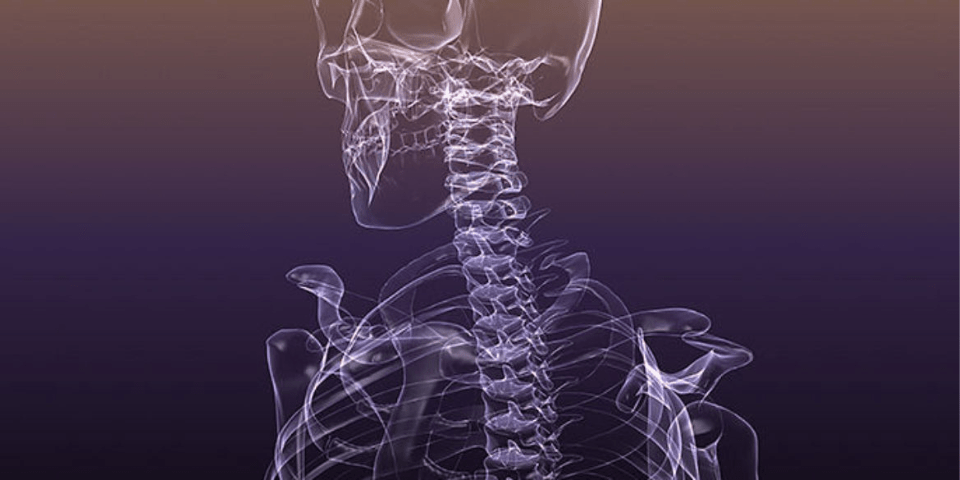
02Aug
Bones-Building Blocks of Our Body
Bones-Building Blocks of Our Body For the construction and development of nature and body also, PRITHWI, AAP, TEJ, WAAYU, and AAKASH are the five fundamental elements that are obligatory. Of these, PRITHWI, AAP, and TEJ contribute to the development of ASTHI (bones). On digestion of food, seven basic constituents like RASA, RAKTA, MANSA, MEDA, ASTHI, MAJJA, and SHUKRA emerge sequentially. Hence, MANSA and MEDA have a relation with the process of ASTHINIRMITI, i.e. bone formation. Unctuous, firm, and stiff attributes of MANSA and MEDA attain a solid and strong form to make a bone. Bones have the function of supporting the body. They form the skeleton and framework of the body. All the other basic and fundamental quantities are rested upon this framework. When the ASTHI (bones) suffer wear and tear, problems like joint aches, and the fragility of teeth, hair, and nails arise. AYURVEDIC VIEW IN ORTHOPEDIC DISORDER TREATMEMT As a result of wear and tear of bones, whenever one experiences backache, pain in the neck region, lower back pain, knee joint pains, and other aches, many medicines are administered to enhance the strength and solidify the bones, but it is as equally necessary that in relation with the absorption of medicines and the diet, one should have good digestive state. This is seldom taken seriously, resulting in more wearing of bones even though we take a lot of supplementary calcium, vitamins, etc. In ayurvedic treatment, DEEPAN-PAACHAN-SNEHAN-SWEDAN-VIRECHAN-BASTI and other procedures enhance the digestive system, consequently increasing the rate and efficiency of the digested food being converted into bones. PANCHAKARMAS IN TREATMENT OF ORTHOPEDIC DISORDERS Virechana:- when done in the scientific procedure, virechana is a purgatory treatment by means of which the excess PITTADOSH (biliary problem-causing agents) are expelled out of the body. Basti:- a decoction of certain bitter herbs in milk along with clarified butter is administered in the rectum. This is called as TIKTAKHSEERA BASTI. This procedure halts bone degeneration. Surgical procedures of knee replacement, and spine surgeries can be avoided with this treatment. Katibasti, Manyabasti, Jaanubasti:- dough of wheat and black gram flour is encircled around the painful parts like the lumbar and cervical region, and painful joints like the knee joint. Warm-medicated oil is poured on that painful part. This procedure nourishes the bones, joints, ligaments, and tendons. Thus, bone degeneration and pain are halted. Snehana:- use of oil and ghee by means of external and internally ways is called snehana. WAAYU responsible for bone degeneration is pacified and pain relief is established. Swedana:- the process of induced medicinal perspiration is called swedana. Joint stiffness and pain are immediately suppressed with swedana. Pathya:- wholesome dietary advice- dried dates, milk, meat, eggs, fish oil, dates, ghee, sunlight exposure, etc. Apathya(not to do):- stale food, untimely meals, heavy physical work, inadequate sleep, fad diet, frequent fasting, bakery items, junk and fast food, sedentary lifestyle, lack of sunlight exposure, smoking, and alcohol intake, overall VAATADOSHA boosting lifestyle.
Read More
02Aug
Diabetes-Ayurvedic Perspective
IMPORTANT TIPS FOR DIABETES PATIENTS Early diagnosis of diabetes prevents further complications. The possibility of diabetes shouldn’t be ignored if there is a history of diabetes in blood relation, obesity, pregnancy, long-term use of steroidal medicines, excess feelings of hunger and thirst, increased frequency of urination, increased duration of wound healing, recurrent abscess formation, undue fatigue, unexplained weight loss, etc. It is very important for a diabetic patient to keep his weight in check. Reducing excess weight coupled with an appropriate diet many times doesn’t require you to take medications for diabetes. Also, the medicines taken for diabetes render ineffective if weight keeps increasing constantly. Small and simple things like walking to nearby places instead of taking vehicles, doing yoga procedures, and aasanas like Surya namaskar, Shalabhasana, Ardhamatsyendrasana, Bhujangasana, Paschimottanasana, Shawaasana, Dhyana, etc. enhance the pancreatic capacity to keep diabetes in control. Have small meals instead of eating to your fullest at a time. Prevent alcoholic drinks. Take special care of your legs. All footwear should be of appropriate size. Regularly check your eyes. Try to keep your blood sugar under control. Always carry with you a card mentioning you are a diabetic person. This may come to a great help in emergency cases. We should prefer unsaturated fatty acids instead of saturated fatty acids. We should carry with us sweet edibles like biscuits, chocolates, sugar etc. This should be handy if blood sugar level drops down suddenly. We should avoid untimely meals, uncontrolled lifestyle, fast food, cold drinks, fruits having more sugar, sweets items, curd, ghee, butter, refrigerated food, consumption of excess water, Idli and Dosa prepared from overfermented dough , constipation causing maida foods like bakery products, excessive use of air cooler, neglecting the frequency of urination and defecation, drinking lot of water just after a meal, long afternoon naps, mental stress, the tension in order to prevent or keep diabetes at bay. Dr. Manoj M Deshpande, Dr. Aparna M Deshpande Kalpataru Ayurvediya Chikitsalaya™, Pune-411030(M S)-India
Read More